HIKE PICNIC cAMP WATERPLAY CANOE bEACH & dISCOVERY wALKS BABIES
FamilY Adventures
With kids under 3
Outdoor Adventures with Baby- Hike, Camp, Canoe
Being in the great outdoors is beneficial for all of us. Being in touch with nature can be refreshing for our bodies and souls. Many new parents may take a step back, afraid to enjoy their usual outdoor adventures with baby. But sharing this enthusiasm for the outdoors is gives them a taste of nature that maybe they’ll take with them for the rest of their lives.Traditional outdoor adventures don’t have to wait until your baby is old enough to walk and talk on their own! The things you loved before like hiking, camping, and canoeing, can still be fun and safe with a baby or toddler in tow.
♥
Our Series for Babies And Tots
Exploring The World
Exploring The World
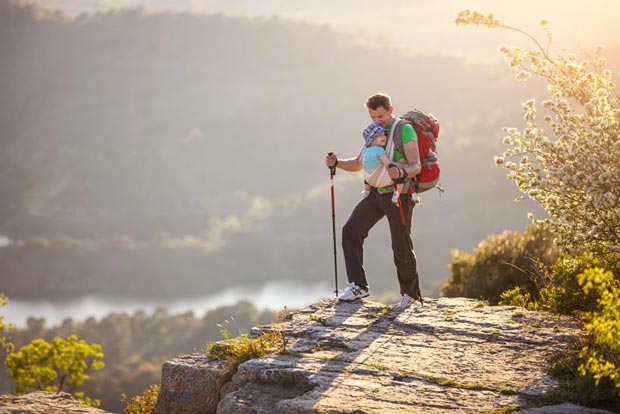
Go out early
Actually starting as young as possible is a good idea as small children absorb external, especially parental, influences. The younger they are and more frequent you take them into nature, the more they will feel comfortable and desire to go.Being in nature is a learning experience too. It teaches children a variety of sights and sounds, they don’t experience at home. New colors, different trees and rocks means new words and new understanding of the world around them.As they start moving on their own, being outside will also help them get to know their bodies like learning better balance.
Get planning
If you are an experienced outdoors person, with your know how and a little research and planning you can go out into your wild outdoor adventures with baby with some adapting. For instance, whereas you have been fine if a rain shower snuck up on you while hiking in the past, now you need to check the weather. And make contingency plans in case the weather doesn’t do as expected.
Since you’ll be carrying your baby you’ll need to account for their weight and maybe plan shorter trips until you get used to it. Or if you are canoeing with a toddler, you’ll need to adapt to an extra body and gear in the canoe.You’ll also have to account for your child’s temperament. Maybe you love four-day camping trips but baby will only put up with two days before he decides he’s done and gets fussy. Pick activities the whole family can enjoy and work your way up if you prefer to do more.
Here are some more specific tips for having a good time this summer in your outdoor adventures with baby.
Hiking:
1. When you’re hiking, it’s vital to keep the diaper bag even better stocked than usual. It’s one thing to run out of diapers when you’re already at a grocery store or a friend’s house; it’s another thing to run out of diapers when you’re a full mile away from your car – and an even longer drive back home.
2. Choose a comfortable baby carrier. A crying baby or an aching back can ruin the whole event. If your baby is young enough, the repetitive motion of being worn during a hike might put them to sleep. Going close to a regularly scheduled naptime might help keep their sleep schedule on track – but you know your baby best.
3. Check that weather before you go. Even if you’re okay hiking in the rain, a little one won’t be. Keep your eye on the forecast for the days leading up to your hike and while you’re out on the trails. The weather can change on a dime, and you don’t want to get caught away from your car during a sudden downpour.
4. For toddlers, encourage them to stay hydrated with a fun water bottle of their favorite character. Maybe having a brand new bottle just for the trip can make them excited even if they’re not totally sure about the idea.
5. Choose easy trails at first. If you’re carrying a little one, you’ll need to get used to the added weight during hikes; if your toddler is walking (probably part of) the way on their own, they’ll need a trail that won’t do more harm than good.Sign up for this newsletter for car seat safety and other driving safety updates.
Camping:
1. Choose a tent that’s the right size, even if it means upgrading a recently purchased one. You’ll need room for yourself, your partner, and your child’s gear. If you’re bringing along a portable crib, you’ll have to keep that in mind when you’re looking at the square footage of a tent.
2. Choose a camping location that gives you easy access to clean, fresh water, especially if your baby is drinking from a bottle. If your baby is a little older, or if you have a toddler, bring foods you know they’ll enjoy. Don’t introduce new foods this weekend; things are already different enough. Bring what you already know baby/toddler loves.
3. Bring little layers to keep them warm or cool, depending on how the weather turns.
4. Bug repellent and sunscreen aren’t recommended for babies under the age of six months, so it’s essential to rely on other methods to keep them safe from the sun and insects. Setting up your tent in a shady spot and bringing along mosquito nets are good places to start to keep them safe and comfortable.
5. Especially if this is your first time camping with a young child, choose a location that’s close to home, so your trip there and back isn’t an added layer of stress. Even a site at the campground that’s near the parking lot can help (and so can a nearby bathroom).
6. Don’t forget the first aid kit with age-appropriate medications! If you have a regular kit you used to take with you everywhere, it’s time to upgrade it to include the medicines you might need to help an infant or a toddler feel better if an accident does happen.
Canoeing:
1. Invest in good age- and size-appropriate personal flotation devices for the little ones. Even if you don’t intend for them to get wet, it’s important to prepare for accidents just in case.
2. Allow yourself more time than it used to take. Although this is true with almost everything, it’s extra important here. Getting from A to B with a little one in tow isn’t as simple as it used to be, so give yourself more time than you think you need to avoid getting stressed and anxious.
3. Put essentials in an easy-to-reach spot that’s separate from most of your supplies. Canoes are small and they’re even smaller with a baby. Don’t waste time struggling to get into drybags when the baby needs something right now.
4. Don’t forget the playthings. You might enjoy spending hours out on the water without any other form of entertainment, but a baby or a toddler won’t be as easily soothed. Packing safe toys that they won’t lose over the edge of the canoe can save your trip – and a headache.
5. Don’t forget the sun protection! Young babies shouldn’t wear sunscreen, so it’s important to plan ahead to provide shade for the little ones. This will keep them from overheating and from burning.
No matter what activity you choose for your outdoor adventure with baby, remember that it’s okay to turn back around and go home if things aren’t working out. Sometimes your little one is just in a bad mood; sometimes accidents happen. It’s always better to try that hike or camping weekend again when everyone’s feeling their best.
And when things go well, you and your children can benefit greatly while instilling wonderful outdoor habits from an early age. Thus you’ll be budding an adventurous outlook and independence that can have a lasting effect on their lives.
Our Series for Babies And Tots Exploring The World
Start small in a familiar setting - Your backyard or woodlands
Make Your Backyard More Fun:
8 Outdoor Activities for Infants
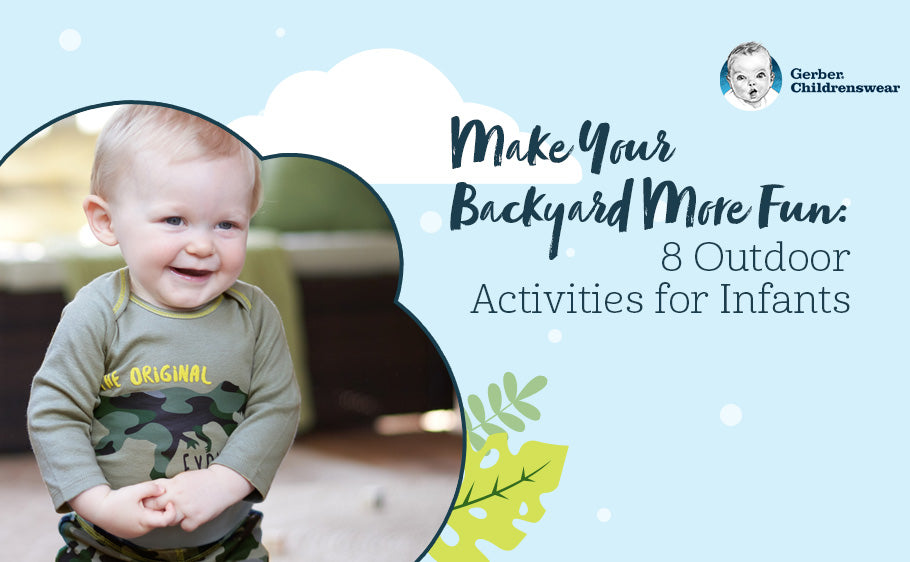
During the infant stage, babies are learning at a rapid pace. According to the Centers for Disease Control and Prevention (CDC), some of the most important developmental milestones in the first year include establishing clearer vision and developing an ability to explore. This is what makes outdoor activities so valuable during infancy. When you and your baby spend time in the backyard, you are helping grow their thinking and reasoning skills. You will also help them engage in social and emotional bonding. New moms or dads also benefit from the outings. Backyard adventures will give you your daily requirement of vitamin D, as well as plenty of fresh air.
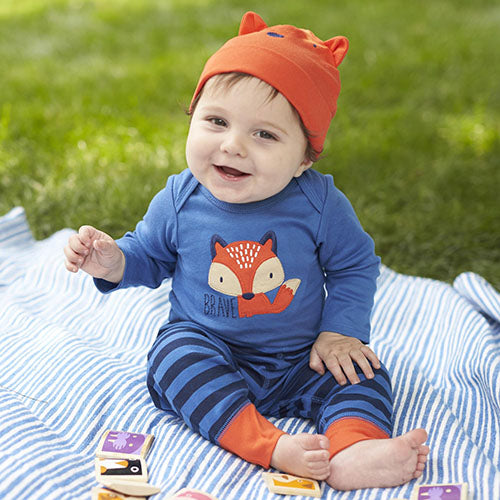
The following ideas are perfect for spending time at home. This list of outdoor activities for infants provides ideas for every time of year, so you can take advantage of engaging play during different types of weather. Once you find a few favorites, you will gain a better appreciation for where you live.
1. Outdoor Tummy Time
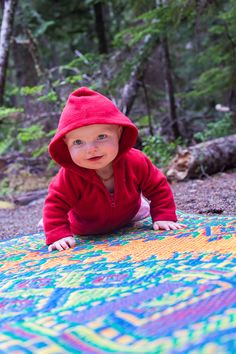
When you first visit your pediatrician, they will tell you the importance of tummy time. By placing your baby on their stomach to play, they will strengthen their neck and back muscles. They will also develop motor skills. All of this is essential for learning how to sit up, crawl and walk. Infants will do most of their tummy time on a blanket or pad in their nursery or living room. You can also do the activity outside when you want to enjoy fresh air.
Outdoor tummy time is a perfect activity for warm spring days, mild autumn afternoons and summer mornings in the shade. Bring a comfortable blanket outdoors and put it on the ground in a safe place. The best spots have plenty of thick grass free of bugs and debris. Other ideas include your back patio or deck.
Feel free to take toys with you. This may make things more fun and intriguing for the baby. Just be sure you choose items that can handle moisture, heat and humidity. If it is warm or sunny outside, dress your baby in a hat and protective clothing. If you feel a chill in the air, you can layer a jacket or hoodie over a bodysuit and pants. Our Onesies® Brand bodysuits are the perfect choice for layering during all seasons. Cotton material will keep your little one comfortable and cute all day long.
2. Backyard Lunch
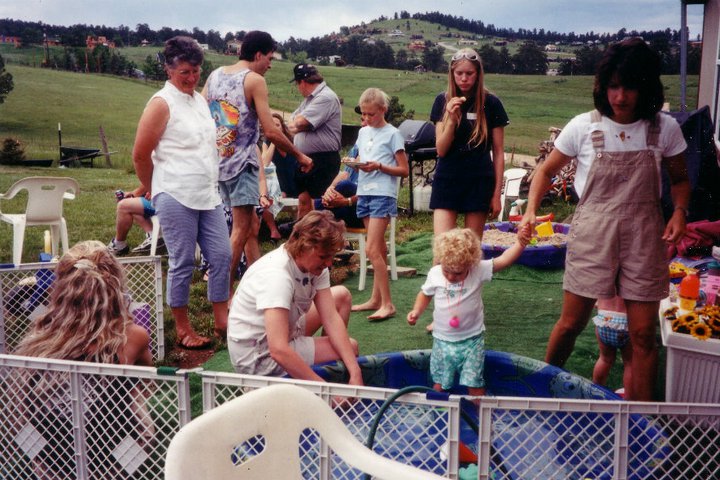
In the first several months of your baby’s life, they will drink only breast milk or formula. Your pediatrician will guide you on when you should introduce solids while your child still nurses or drinks bottles. According to the Mayo Clinic, most infants start solid foods between four and six months of age. The right time to start will depend on your baby’s readiness, as well as your healthcare provider’s recommendations. No matter what feeding phase you are in, you and your child can enjoy a peaceful lunch outside. All you need is a comfortable seat or a high chair.
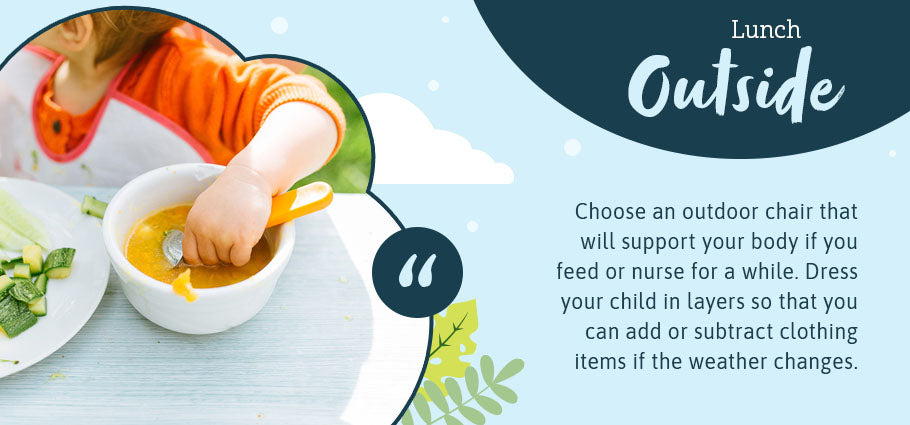
Newborns and young babies will sit with mom during lunch. Choose an outdoor chair that will support your body if you feed or nurse for a while. No matter what time of year you are having lunch outdoors, make sure you are in the shade. Protecting yourself from the sun with an umbrella or a large tree will prevent sunburn and overheating. Dress your child in layers so that you can add or subtract clothing items if the weather changes. Make sure you also wear comfortable clothing and UV-blocking accessories like a hat or sunglasses.
When the baby is ready for a high chair, feel free to take it outside. Choose a chair that is easy to wipe down afterward so it is clean when it goes back indoors. Some families even have an extra chair for their deck or patio. Bring their lunch in portable containers with matching tops. Airtight vessels will keep snacks fresh while protecting them from bugs. It will also be easier to transport different types of food. Remember to pack something for yourself, too. New parents also need to stay nourished.
3. Nature Naps
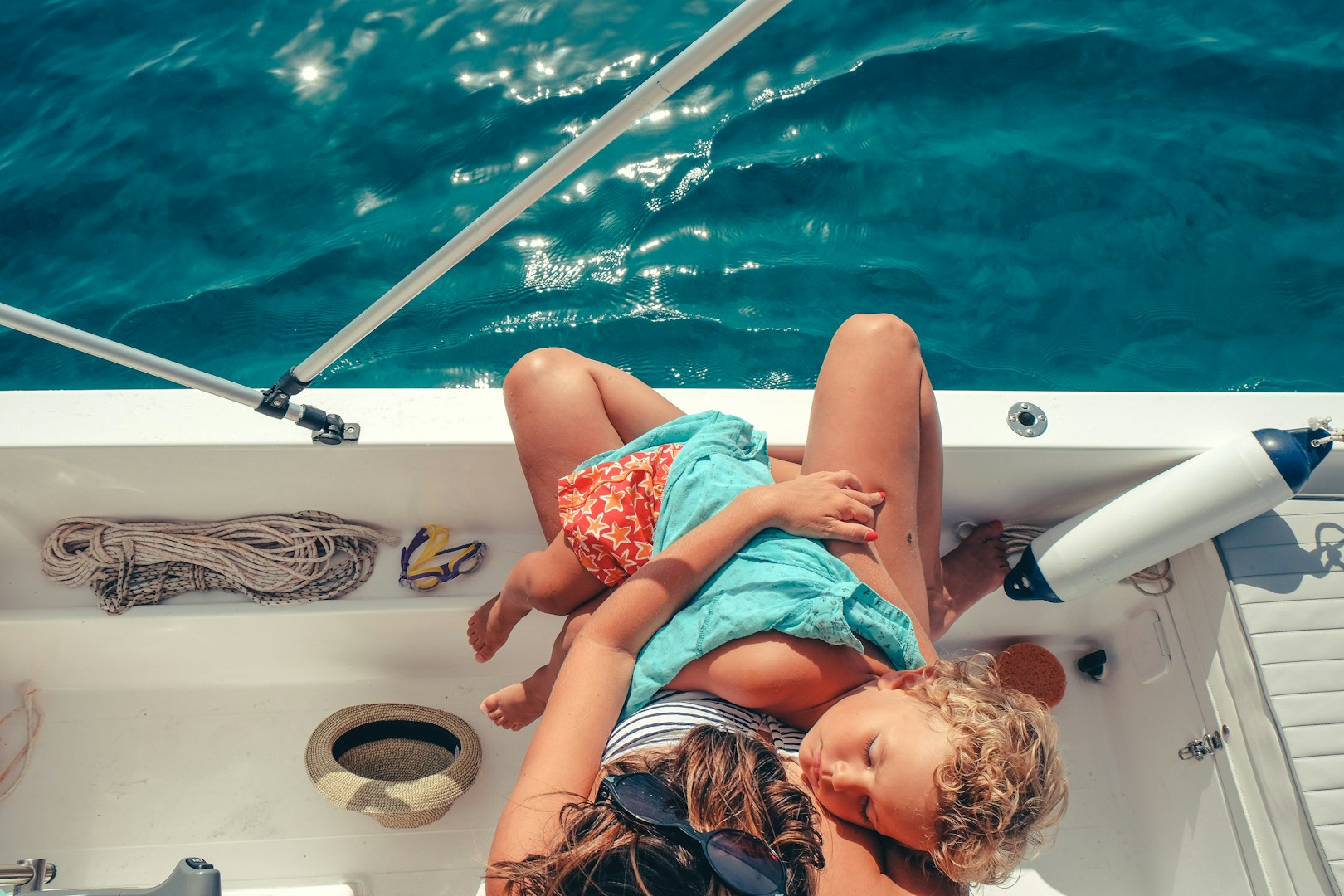
If your backyard features a patio or enclosed porch, take advantage of it during the warmer times of year. Taking naps in the sunlight can be relaxing and provide you and your baby with plenty of vitamin D. A portable bassinet or crib is a great choice for this space.
Some babies don't sleep when it is too bright. Blackout shades or solar screens can make the environment darker and more comfortable. No matter how you adjust the room, you and baby will still enjoy the change of scenery. Nap nearby on a cot, hammock or futon. You can even sit in a chair and take in the natural scenery.
The quiet sound of birds or a babbling brook can also be soothing to baby. As long as you have an electrical outlet nearby, you can even bring your infant sound machine outdoors. Create a sleep playlist with your smartphone to relax your child anywhere.
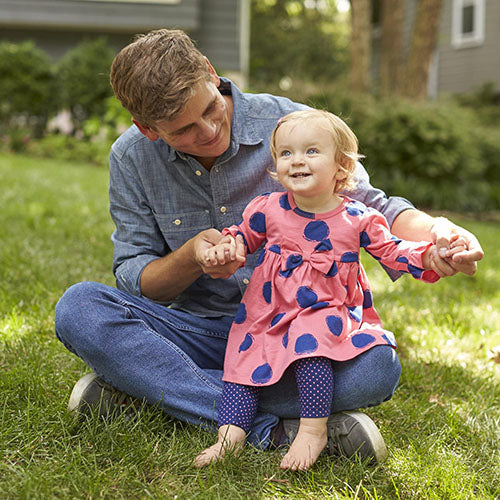
4. Swimming and Water Play
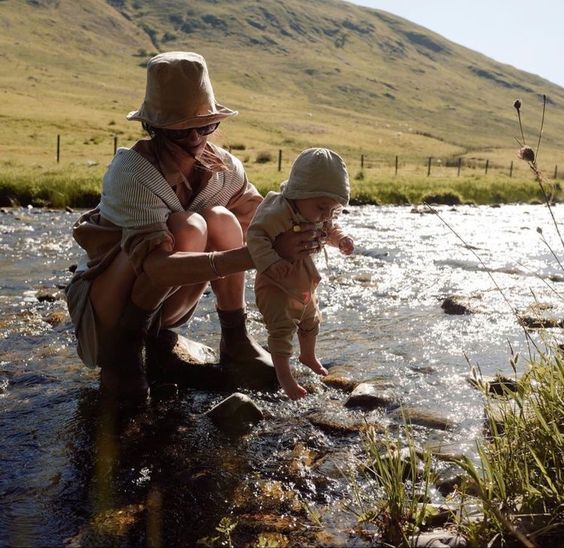
If your family has a pool in their backyard, you can start taking baby in the water when they are a few months old. At first, you will need to hold them in a shallow part of the pool. Eventually, you can place them in a special seat or float. Other water play ideas include splashing in a bucket of water or letting baby feel the sensations of a gentle water sprinkler. Some parents like to take a newborn tub outdoors on the grass, sand or another soft foundation. Your baby can play in cool water with their favorite bath toys while you enjoy the weather. Adult supervision is always required when your baby is near the pool to guarantee their safety.
Since your child is unable to regulate their body temperature until their first birthday, it is important to keep them comfortable. Avoid water that is too cold. Dress them in the right baby girl or baby boy swimwear, such as a rashguard set with swim bottoms or trunks. Having a plush towel nearby will also help to keep them cozy as soon as they are done swimming or playing.
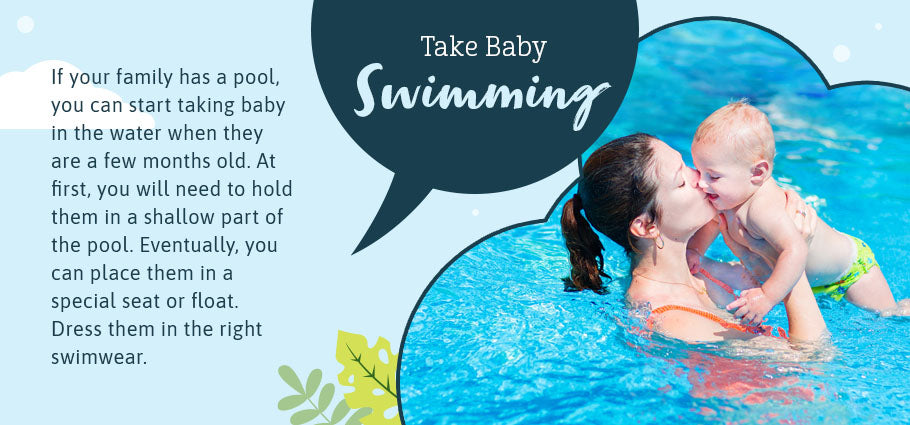
5. Short Walks in the Community

I was raised in Springwater, New York near the smaller Finger Lakes. So there was always something to do locally.
If you want to stay in the backyard for the afternoon, you can still take a walk. Your baby will love taking in the different sights from different angles or perspective.
Stroll around the perimeter of the yard or explore near the fence. Exciting points of exploration include birds, tree leaves and wind chimes. If you have a garden, show them the different plants.
You can also walk the driveway, roam around the exterior of your home or travel the sidewalk in your neighborhood.
While you may only be out for a few moments at a time, it is important to protect your baby’s delicate skin. If they are too young to wear infant sunscreen, dress them in an outfit that will prevent them from getting a sunburn. A lightweight cotton shirt can help to block some sunlight while still keeping the baby comfortable. Bodysuits can be worn with or without pants and are perfect for warmer weather. Hats are a good idea for infants of any age. For parents who like using baby carriers, use a free hand to carry a small umbrella. It is also a good idea to stay under a covered area or in the shade. When it is chilly outside, skip the outdoor walk. Instead, roam around your sunroom or enclosed patio.
6. Exploring with Bubbles
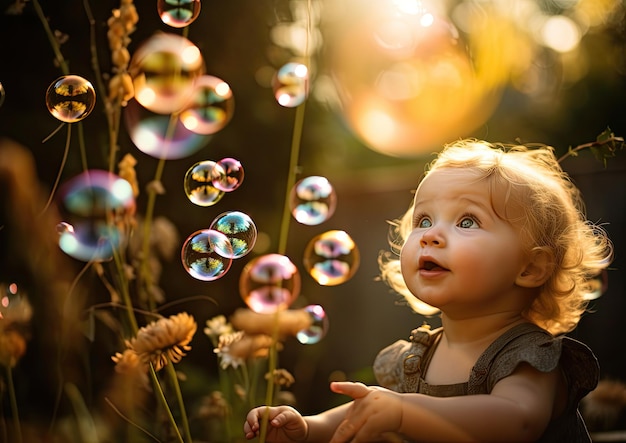
Bubbles are fascinating for infants. While they are exciting enough to watch in the early months of your baby’s life, they will also be fun for them to pop once they start sitting, standing or walking. This outdoor activity will help your baby strengthen their vision. They will also begin to learn more about the world around them.
The best thing about bubbles is they are affordable and can be found at almost any store. Buy a small bottle of bubbles with a matching wand or purchase a large jug and a set of tools. When it is a nice day for playing outdoors, you can take it in the backyard with you. You can also do it in your garage, driveway or on your back deck. First, demonstrate for baby how to blow bubbles with the wand. Watch your child delight in the way they float and disintegrate. The activity can even be stress-relieving for parents.
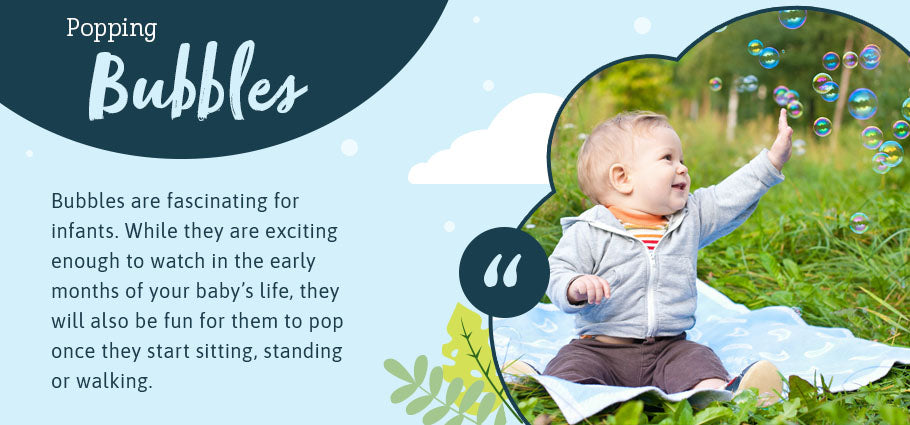
7. Backyard Story Time
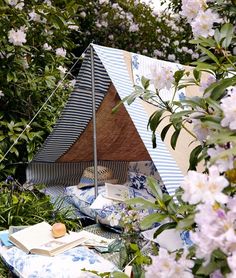
It is always a good time to read a book. Take a few of your favorites outside for backyard story time. You will need only a few more supplies to enjoy a peaceful and relaxing reading session. Pack up a couple of bigger baby blankets, along with a hat and some toys. If your child uses a pacifier, it may also be a good idea to take one with you. Moms should also take a water bottle and hat or pair of sunglasses to keep them comfortable.
When you have everything you need, find a shady spot. Lay a blanket down on a soft patch of grass free of insects or mulch. The other blanket can be used for keeping the baby warm or adding extra padding to your first blanket. Read a couple of short books about animals, nature or the great outdoors. Your child may also have a few favorites from bedtime. Whatever you choose, make the activity vibrant and educational. Finger puppets and toy props can add to the fun. Once you are finished, you may even choose to have a snack or take a short rest.
8. Patio Play
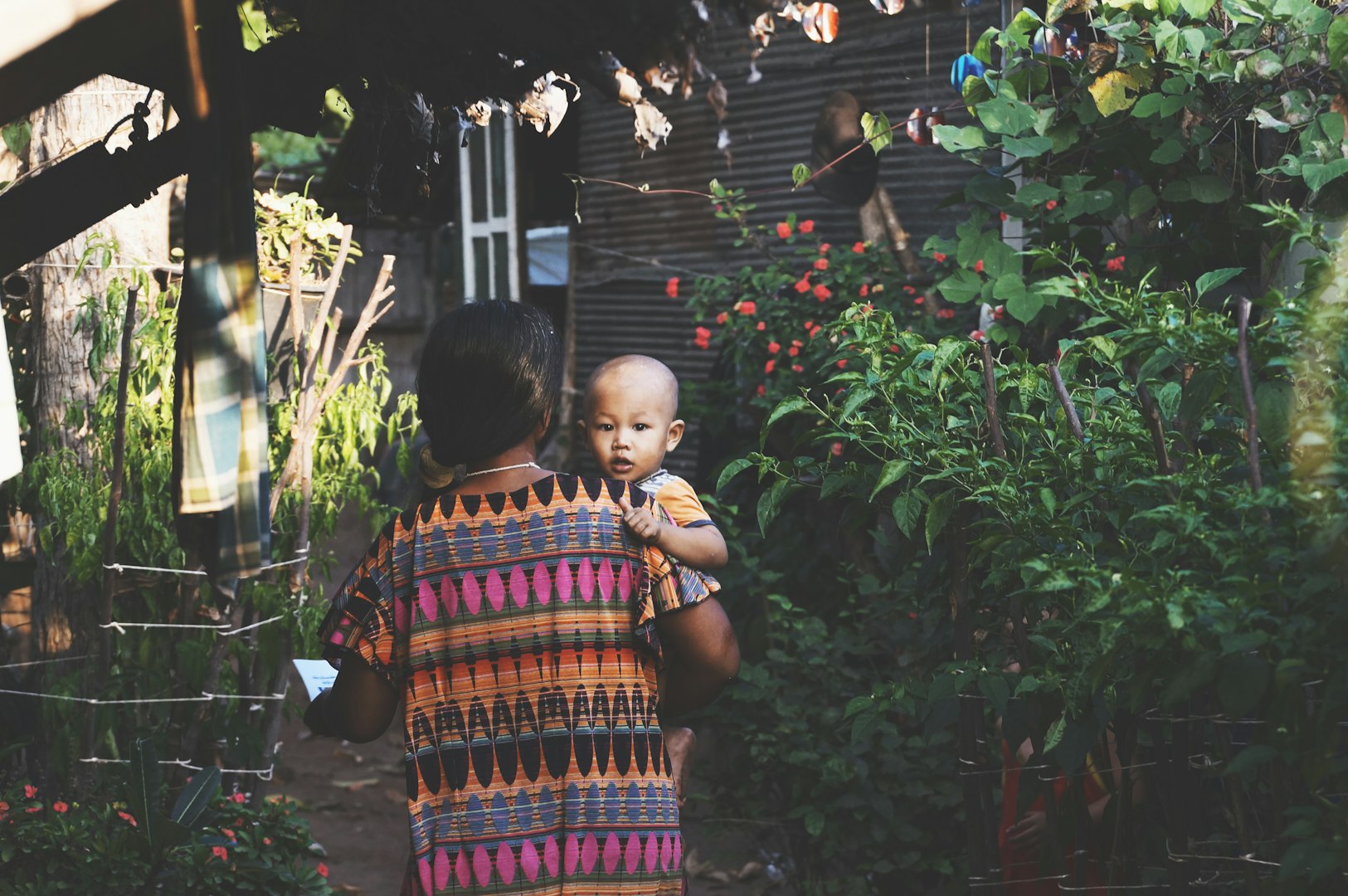
Do you or your baby have another favorite activity? Take it out on the patio! Enclosed patios, sunrooms and porches are the perfect place for relaxing in a rocking chair, stacking blocks or playing with a doll. Other ideas include dancing to music, exploring in a playpen or learning with an activity table.
Since patios have plenty of natural light, they are also an ideal spot for learning to crawl or walk. Just make sure your little one has a carpet or padded area in which to move around. Concrete, wood and tile can be uncomfortable for little knees and feet. Sunrooms can be a good place to play with rattles or learn to use a ball, while their large windows also make for a safe and exciting place to learn more about the world around them.
Wet & Wild Water Play
EXPERIENCES WITH WILD WATER PLAY
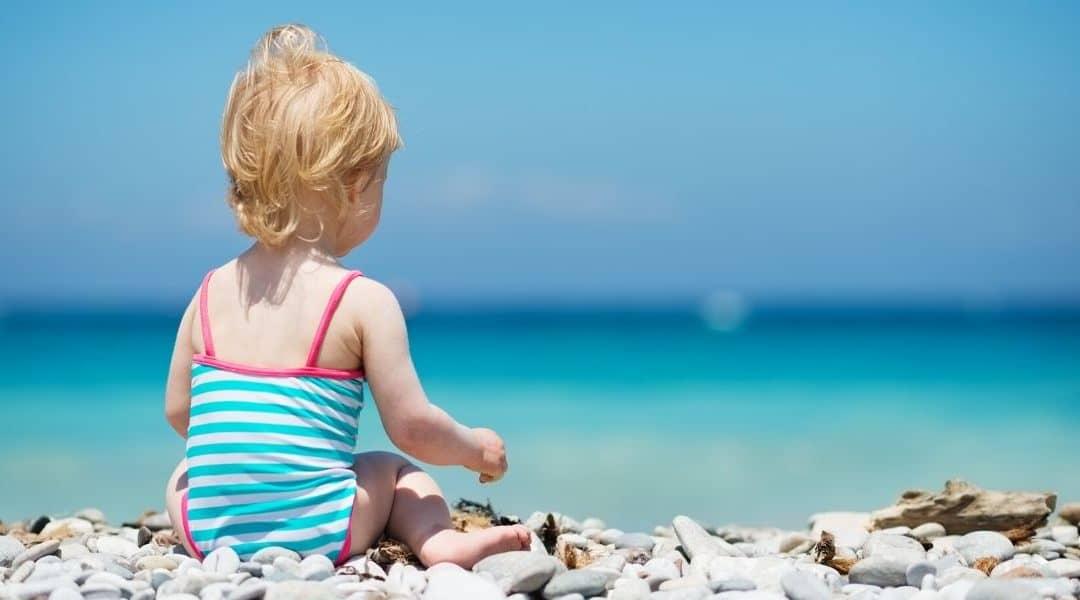
Did you know?
Playing in puddles and creeks helps children understand their natural environment.
Floating sticks and pinecones, watching tadpoles and fireflies ...engaging with anytype nature increases children’s awareness of and concern for their environment.
Supervision is essential at all times in and around water.
Add language
During water play you can talk about concepts such as volume and size e.g. shorter, taller or big, bigger, biggest.
You could also discuss early science concepts such as water state and temperature e.g. ice, cold, hot, steam and evaporation.
Variations
Puddle stomping is a fun way to get out and blow off steam with young children after being stuck in doors during the rain.
Safety
Supervision is essential at all times. Remember to empty out water at the end of the activity.
Across the ages
All the activities listed on this “Play Ideas” page can be applied across different age groups. See how water play can be fun for babies, toddlers and playgroups.
Benefits of Water Play
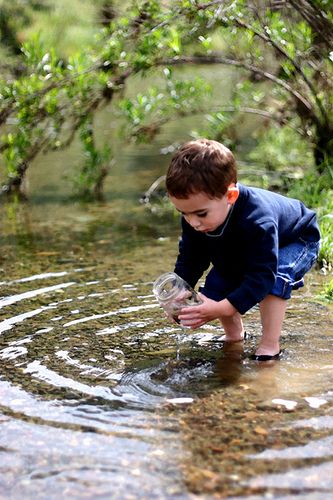
Want to dive into some water play with your child? Here’s what this term means exactly, a few ways to encourage it, as well as some important safety tips. Grab a few towels and your bathing suit and get ready for some wet and wild fun!

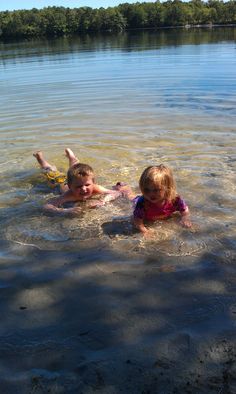

Water play is a sensory extravaganza as children feel the wetness, hear the splashes, see the bubbles and waves, and maybe even taste a few droplets.
It's also a great learning experience: As your budding scientist pours, splashes and laughs, she is observing cause and effect, experimenting with water's fascinatingly fluid properties and being introduced to basic physics (what floats and what sinks).
Water play is exactly what it sounds like — H2O plus any appropriate items that can be used to scoop, pour, sprinkle and more. All you need are a few plastic cups (no glass, please!), buckets, sponges and lightweight toys to float on the water’s surface. Older kids could use large spoons, plastic eye droppers, mini watering cans and other containers that require more dexterity.
To make water play happen, set your baby or toddler up out on the lawn or patio or inside in a spot that you don’t mind getting wet (the laundry room or basement is ideal for this). Line the area with old towels, pop a hat on your tot if she’s outside, and then let her go to town.
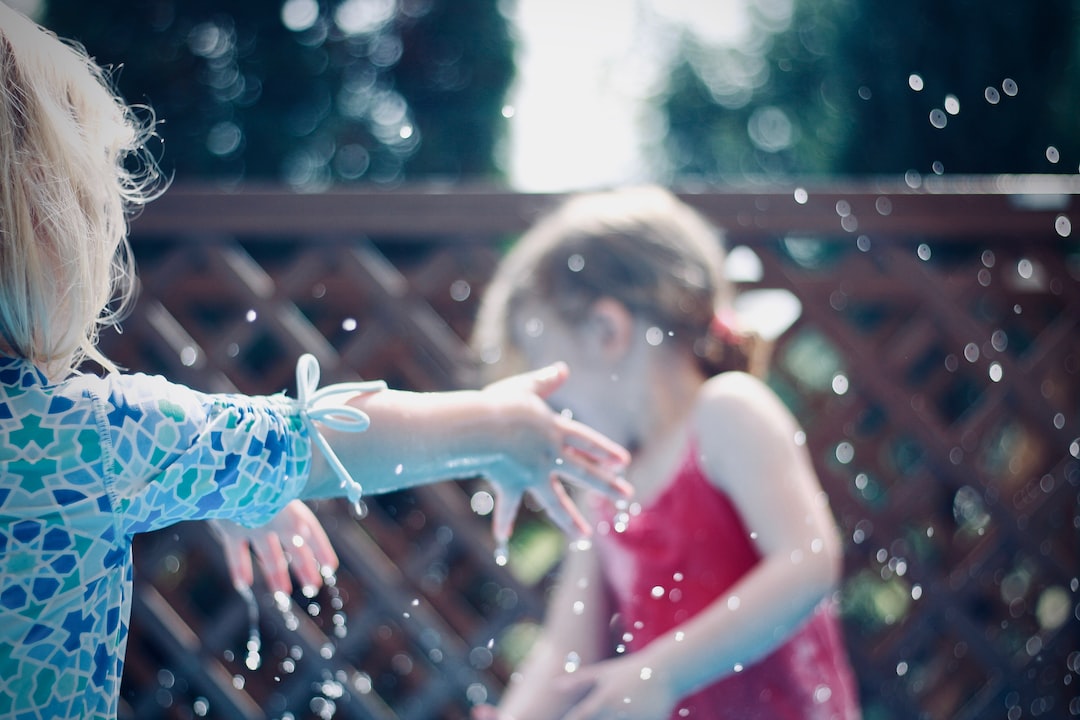
Is water play sensory play?
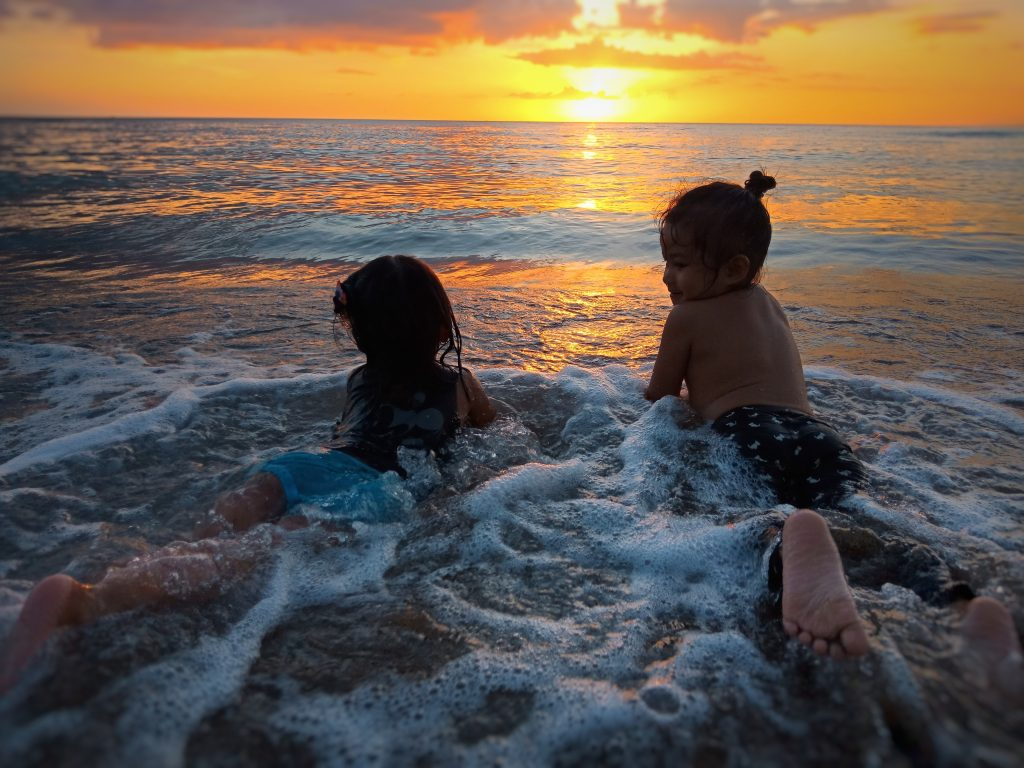
Yes. When a child is in water, or playing with water, they are surrounded by lots of different stimuli.
Touch: They can feel the temperature and have direct contact with it when getting wet or pouring water on themselves. They can also feel how water changes other objects, such as a sponge – going from dry to soaked. Sometimes they can feel that the water changes from warm to cold.
Sound: There is sound from splashing water and the sound of water dripping or falling onto other surfaces. The sound of a spray bottle squirting, peers around them talking, squealing or laughing in delight, as well as the sound of water coming out of a hose or a tap.
Visual: They can observe how their own movements create ripples in water, and observe as water will fill a container or pour out of it. They can observe how particular items may sink or float in water, exploring the scientific properties of these objects, and hypothesising what will happen to other objects when in water, as well as watch how water changes the look of our clothes, our hair, and sand, or how it may change from clear to cloudy. They may also notice reflections in a pool of water.
Smell: Have you ever smelled rain? Or water coming out of a hose? There are definite smells I associate with certain types of water play.
Taste: While taste is not something you would usually associate with water play, most kids at some stage would have tried tasting or drinking the water they are playing with. Having said that, have you ever compared the taste of tap water to bottled water? Might be worth exploring with older children.
There are many educational approaches that advocate for sensorial learning such as Montessori and Reggio Emilia inspired learning programs, most of which would include water play as a key feature of sensory exploration play.
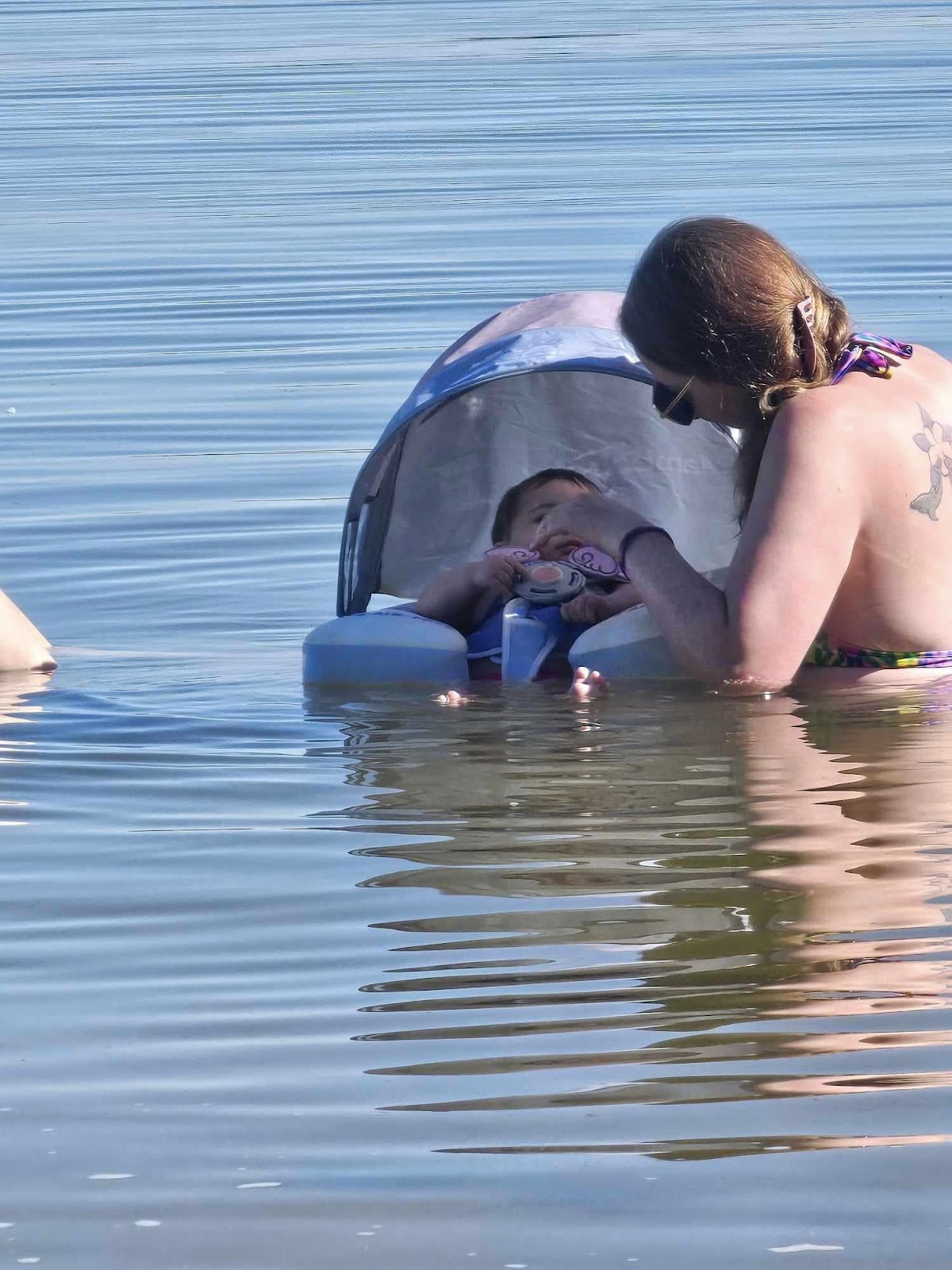
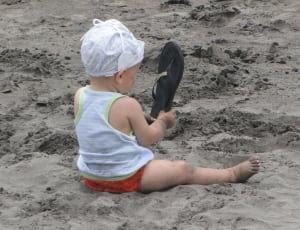

Exploring on The Beach And Shorelines
Wild Waters and Wetlands
Blue water, sun, and sand are but a few of the interesting elements this theme will make sharing with babies and toddlers possible. A beach is a magical place, especially to kids. The glorious sound of waves washing up and whooshing back, the feeling of sand squishing between toes, and sun-kissed skin after spending a day outside exploring are the simple yet beautiful things that can make for the sweetest childhood memories. That’s why I try to get my kids as young as babies to fall as madly in love with the beach as I am.
Before you even leave your house, it is wise to prepare for safety and fun. The more comfortable you and your child are, the more fun you’ll be able to have. If you have a sensory sensitive child, build a mini beach for them to get used to the elements. Then be sure to pack plenty of drinking water, snacks, and sunscreen as well as beach toys, towels, sunglasses, aloe, beach blankets, wide-brimmed hats, and tons of toys. Did we mention the toys? Buckets, shovels, sifters, and even blowing bubbles.
SENSORY PLAY
Babies absolutely love to touch everything – that’s how they experience the world. Be sure to point out all the amazing sensory opportunities for your little one – like digging in the sand, dipping toes in the water, collecting shells and cool rocks and smelling the salty air.
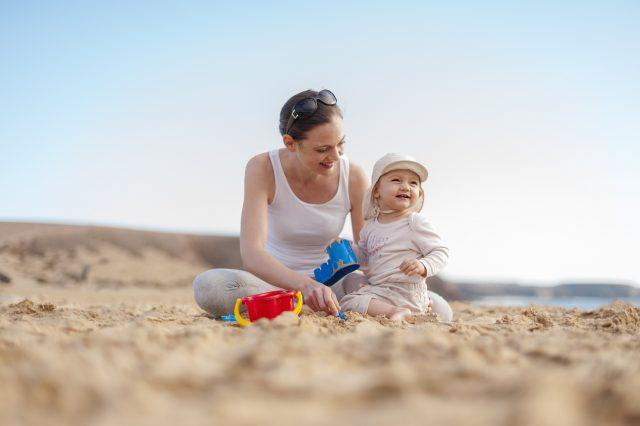
TEACH
The best part about all of that sensory play is the golden opportunity to take advantage your child’s natural curiosity and to teach them things like how the water moves, the nature of the tide and all about ocean life and the cool creatures you’ll find there. Without the distractions of screens and the daily grind to get in the way of your focus, you and your baby will enjoy this special bonding time.
MOVE AT YOUR KID’S PACE
Kids have a natural pace and to really allow them to fall in the love with the beach it is wise to let them lead you through the hours of the day as much as a parent is able to. If your little one just wants to grab the sticky beach sand and watch it fall on his lap then by all means, do that. Treat your child’s focus on nature as the most important thing about that day.
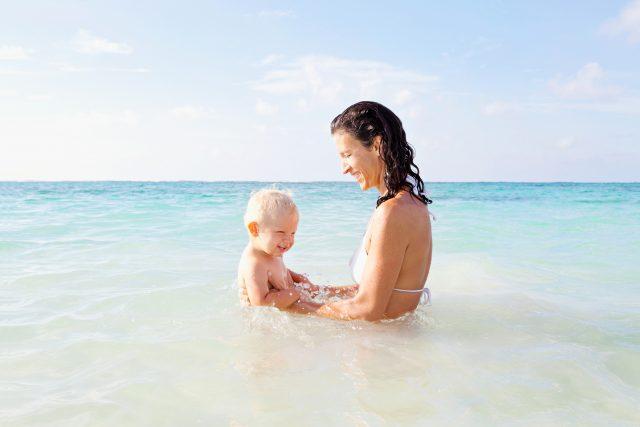
MOVE YOUR BODY
Find ways to move your body and stretch, walk, crawl, swim, float, do whatever you can to make your beach day a physical day too. There is wisdom in getting your blood pumping and your lungs working hard and teaching your child to enjoy the beach as a way to get some movement in is especially wonderful.
MAKE IT SPECIAL
Take pictures, laugh a lot, be slow and playful, do whatever it takes to make you and your baby super happy during beach time. It won’t take much for your little one to fall in love with the truly remarkable beauty of spending a day with family at the beach.
Follow your child’s interest in exploring the lay of the land, and by being open to their natural curiosity, you can definitely help your child to develop a healthy love of not just the beach but of the great outdoors. For more information on water and beach safety, check out these safety tips from The American Red Cross. Be sure to visit your state tourism board website to find the best family friendly beaches near you.
More Beach Fun:
When can babies explore
oceans, lakes, and rivers?
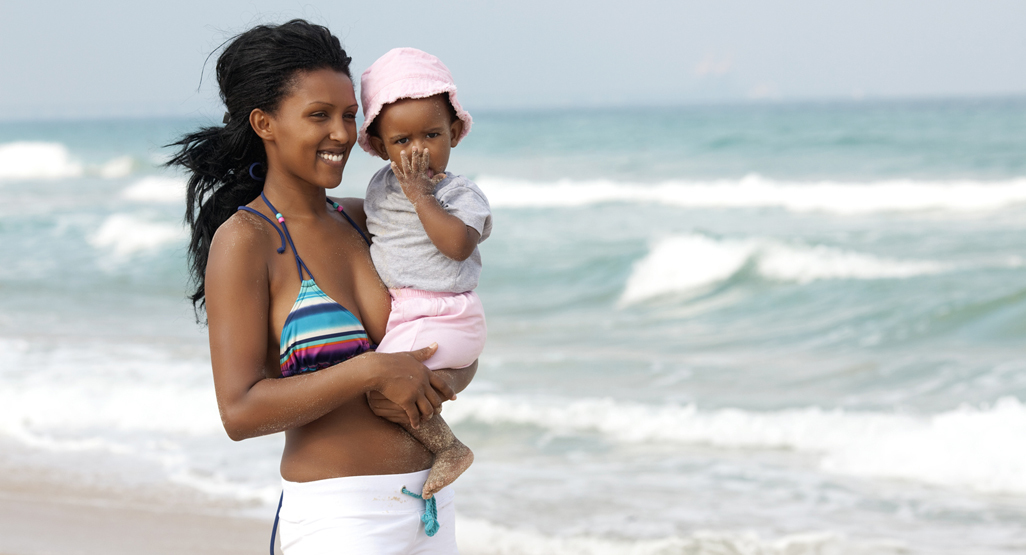
Photo credit: iStock / RuslanDashinsky
The American Academy of Pediatrics (AAP) doesn't have an official age recommendation for when babies can go in bodies of water like oceans, lakes, and rivers, but most pediatricians recommend waiting until your baby is about 6 months old or can hold their head up well on their own (around 4 to 5 months).
When your baby is ready to go in a lake, river, or the ocean, choose a shallow spot that's calm, clean, and, ideally, protected by on-duty lifeguards. Oceans, lakes, and rivers can all have currents and waves that could make it difficult for you to hold onto your baby.
Follow these safety tips whenever you're in or around water:
Always hold your baby when you're in the water and stay where it's shallow enough for you to keep firm footing.
When in the water with your baby, keep their head above the water so they don't swallow too much. Swallowing too much water can lead to a recreational water illness (more on that below), and if your baby is very young, it can lead to electrolyte imbalances, vomiting, and diarrhea.
Practice "touch supervision." This means having an adult stay within arm's reach of children at all times when near water.
If there's a swift current or undertow, don't let your child go near the water and don't get in the water while holding them.
The American Red Cross advises that children wear a properly fitting personal flotation that's approved by the U.S. Coast Guard whenever they're near water, including in a boat.
Young babies are at a higher risk of catching a recreational water illness because their immune systems haven't matured well enough to fight off some of the bacteria they may encounter in a body of water. Recreational water illness is caused by ingesting chemicals in the water or bacteria from human or animal feces, and is a risk in swimming pools as well as natural bodies of water. The most common symptoms of recreational water illness are diarrhea, ear pain, skin rashes, coughing, congestion, and eye pain. If you think your baby has contracted a recreational water illness, talk to their doctor.
Sensory Play in our Natural World
SENSORY Play IN OUR NATURAL WORLD
If you are looking for sensory experiences for toddlers in Natural world, this article is for you.
“Children deserve to grow and learn in a place and alongside a force that is as wild and alive as they are” – Nicolette Sowder
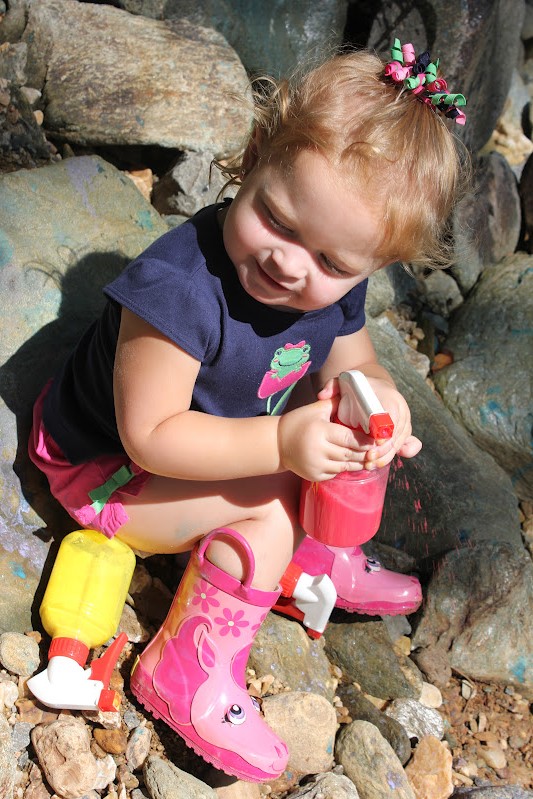

Scrunching gray pebble stones at every step of the narrow footpath, we strolled further and further into the bushland. It was our bush- walk day with the kids.
For me, nature is a small laboratory to experience all kinds of visual treats, exotic smells, vibrant textures, enchanting sounds and peculiar tastes.
Read about how to build connection between kids and nature
This is how I make sure our bush walk is appealing to all their faculties of sight, sound, taste, smell, touch PLUS balance and body awareness.
Following sensory experiences are not necessarily to be experienced in one outing. On the contrary, children need to get closer and closer a little bit every day as they grow up.
Sensory experiences for toddlers - SIGHT
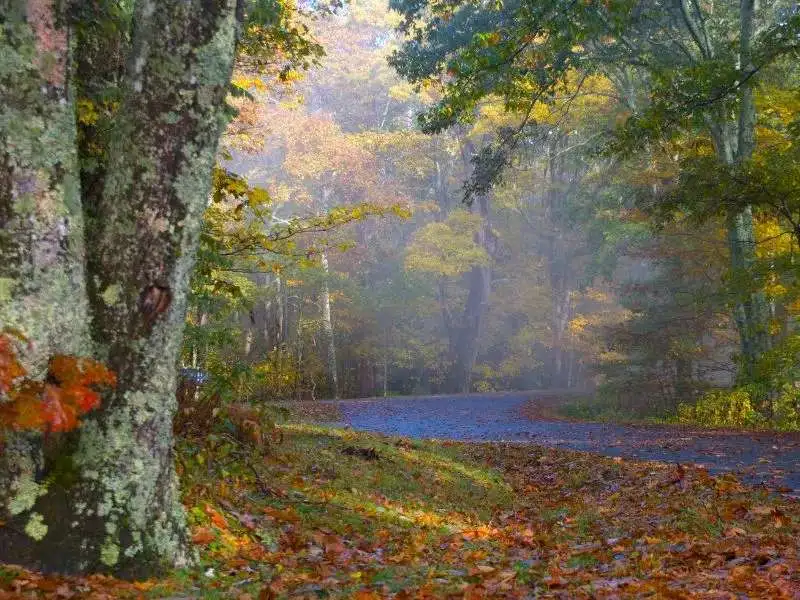
“Blessed are they who see beautiful things in humble places where other people see nothing” -Camille Pissarro
If we open our eyes to the little miracles around us, there’s a myriad of them offered to us by Nature. Something as little as a spider’s web can spark our wonder and curiosity as to how a small spider managed to make this thing of beauty.
These little wonders compel us to slow down from our endless rat race and pay attention to minute details in Nature.
When children are encouraged to admire these little beauties that an ordinary person may fail to notice, they will look at life from a different angle.
In addition, what they see and admire today, can be the reason why they become a scientist, Nature poet, Environmental conservationist or best of all, a happier human being. Because Nature inspires us in so many ways while giving us a feeling of security and freedom.
Letting my kids bond with Nature and encouraging them to make unforgettable memories is something I am aspiring to do with my kids. Age appropriate discussion is always what I aim for.
For example color, shapes, patterns, wildlife, plants and minerals are topics they can soak up at this age. And we can always go from there as they grow up.
Don’t fail to notice these little miracles in Nature.
Let your kids relish them and in the long run it will help our little ones find THEMSELVES!
Blue sky
Birds flying in the sky
Colorful flowers
Green meadows
Mountain ranges
Mossy rocks
Brambles
Frothy bubbles in the creek
Tadpoles
Algae
Watching how a seed Explorers
Fallen trees/tree logs
Beehives
Ant hills
Dewy plants
Sun- drenched tree tops
Bird nests
Flocks of native birds
Shapes made by clouds
Thick green forest
Amber-red maple leaves
Dull yellow leaves
Worms under a rock
Rainbow
Sensory experiences for toddlers - SOUND
“The earth has music for those who listen” W. Shakespeare
Getting familiar with the varied sounds that nature has to offer not only relaxes you, but also revives your connection to the natural world.
The innate desire of man to live in harmony with Nature, makes us deeply bonded with sounds like chattering water, wind whistling, rain splattering so on and so forth.
These sweet sounds can be a way of signaling our brain “You are home and you are safe”.
To indulge in these melodious sounds with children, all you have to do is pay attention with your ears open. Your child will find Nature an orchestra itself.
Chirping of birds
Rustling of leaves
Creaking branches of trees
Hooting of owls
Insects humming
Animals munching and chomping their food
Rain splattering on leaves
Thundering
Sound of waterfalls pounding the rocks
Quacking of ducks
Huffing and puffing sounds of wild animals
Buzzing of bees
Wind whistling
Grunts and clicks of frogs
Cooing of doves
Chattering of creeks
Sensory experiences for toddlers - SMELL
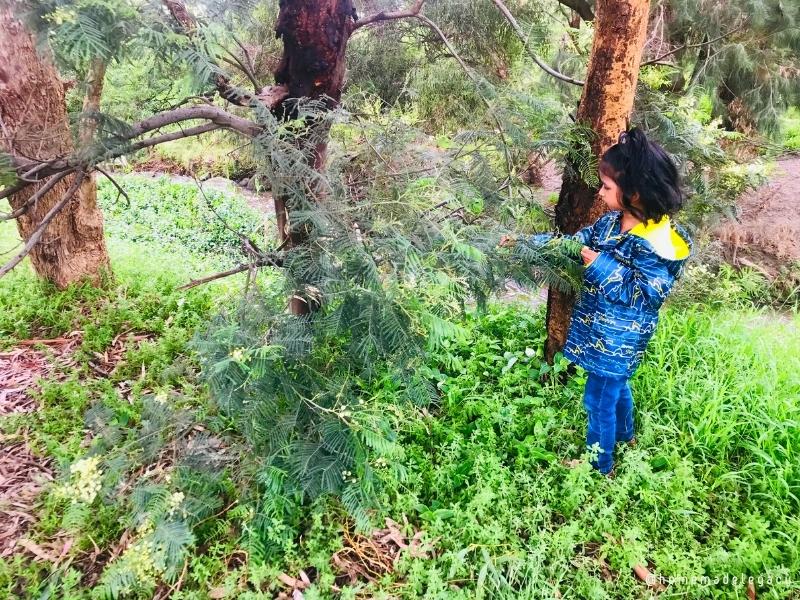
Very little encouragement is enough to help children bond with nature
“Odors have a power of persuasion stronger than that of words, appearances, emotions or will- Patrick Suskind
I cannot stress enough how underrated our power of smell is. Just as people have their own unique smell, the natural world is also enriched with subtle variations of fragrance and aroma.
If our little ones take in this assortment of stimuli, they will see how much Nature is ALIVE in her own peculiar way.
Even the musty smell of rotting wood is an indication that Nature is alive. Though the wood is living her last days , it has given life to another living organism, the fungi.
Our Natural world is filled with the smell of LIFE itself, Let’s teach our kids to cherish it.
May be they will one day look back on these special moments spent in natural world with hearts filled with warmth and nostalgia.
Fragrance of flowers
Smell of rain on parched earth
Rotting wood
Musty smell of moss, damp wood and rain-sodden leaves.
Earthy smell of mud
Smell of mushrooms
Pungent smell of pine sap
Lemony smells of citrus trees
Scratch and sniff leaves and smell their distinct aroma like mint, wild ginger, wild onion
Deer dung
The earthy moist smell when you lift up a rock to see worms
Dusty smell of hot summer breeze
Sensory experiences for toddlers - TASTE
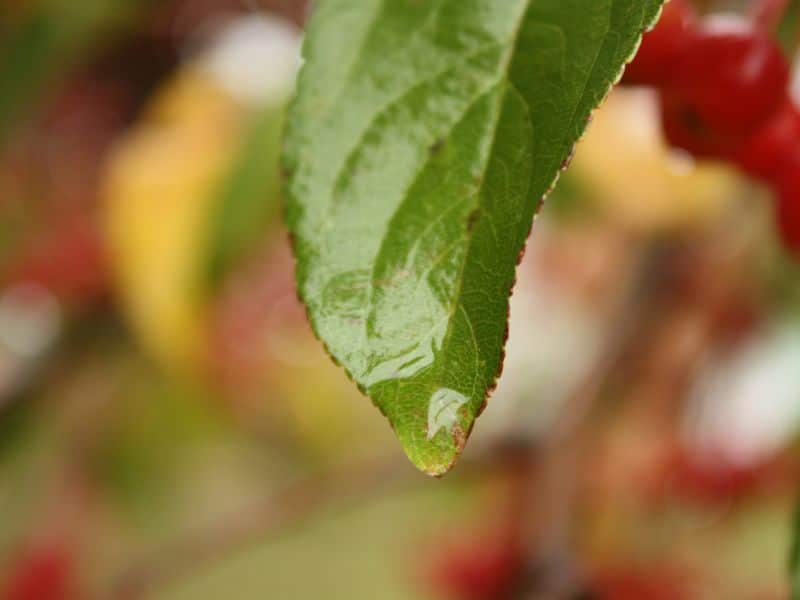
My daughter says these water drops taste better. May be she's right 🙂
“We could have never loved the earth so well if we had had no childhood in it” George Elliot
Nature is full of flavor. Since the first primitive cell of life on earth, Nature has always been our lifeline.
Man is biologically dependent on flavors Nature offers to us and no wonder why our kids JUST LOVE to eat wild berries, drink flower nectar or even rain water.
With little to no encouragement, they are going to explore these because they are part of Natural World.
Children and Nature have a strong bond and they share similar qualities. Both admirable, yet unpredictable 🙂
Taste of rain water
Sour wild berries
Sweet wild fruits
Sweet flower nectar
Spicy cinnamon, pepper
Salty water from sea
Earthy spicy taste of wild onion and wild ginger.
Edible plants like dandelion
Mint flavor
Sensory experiences for toddlers - TOUCH
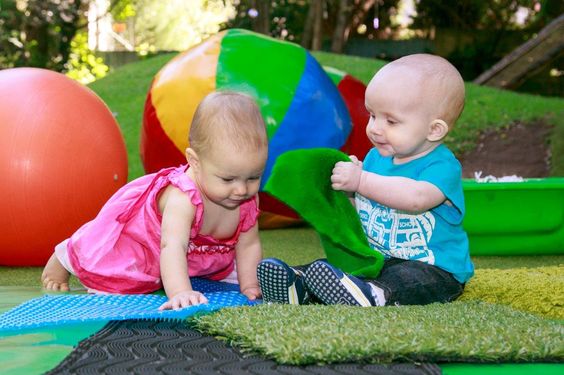
Encourage your child to have muddy, grassy or sandy feet at the end of each day. That’s the childhood they deserve”- Penny Whitehouse
Children’s hands and bare feet can absorb so many stimuli of different textures, temperatures and contacts with Nature, building a strong nerves connection.
Let them explore, get dirty and get connected with these vital sources of stimuli Nature has in abundance.
Damp. mossy rocks
Rough tree barks
Spiky wild bushes
Silky smooth bird feathers
Sticky sap of trees
Fruit flies hovering around the face
Spider web strands on face
Dewy grass cooling feet
Silky soft sand in riverbanks
Scorching sun burning the skin
Soft, slimy mud
Cold/warm water from creeks
Tickle of falling leaves
Smooth pebble stones in creeks
Ants and termites running on skin
BALANCE and BODY AWARENESS
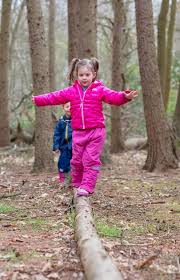
Nature has ample of opportunities to help children improve their balance and coordination skills
“Nature is a tool to get children to experience not just the wider world, but themselves” Stephen Moss
Balance or in other words vestibular sense is a skill of understanding where your body is in space.
It helps movement and balance. Body awareness or spatial awareness helps children understand where their bodies are in space. Nature has multitude of opportunities for little ones to improve these skills.
Walking
Stepping stones
Climbing trees or rocks
Swinging on vines, low branches
Walking on uneven ground
Balancing on fallen tree logs
Hiking
Our Experience ...
The stillness of giant trees and the indistinct patterns of shadows retained an aura of mystery. An occasional puff of wind would sweep through our face leaving fragrance from wild flowers.
It was the season of autumn. Different hues of yellow and orange veiled over the woodland like a dome.
The kids collected amber-red maple leaves for their artwork. Their pockets were full of wild blackcurrants that they kept chomping, making their lips scarlet red.
The day is a bit overcast, with some rain clouds looming in the distance, but we just did not have the heart tun back. We carefully made our way down a fairly steep, muddy bank to the edge of a small creek.
The glass shine of the surface and the dull murmuring of the water flow had the lullaby effect on us. We sat on a mossy stone and looked around that amazing natural habitat that gives life to millions of plants and wildlife with awe.
We got carried away admiring the beauty and failed to notice the rain at hand. As the soft drizzle turned into swollen, ploppy raindrops, we hurried our steps to take shelter under what seemed like a Centuries-old Oak tree.
Though it was autumn, it still had leaves survived from rain and wind. We felt grateful for that ancient leafy canopy for everything she has provided for us for hundreds of years and counting.
Bush walk day is a special day for our family for so many reasons. But my favorite reason is, it gives so many opportunities for children to find their connection with nature.
Furthermore, children and Nature have their own special bond where they give so much to each other. If you think about it, it really makes sense. Man is biologically bonded with nature.
One glance at my children, playing with rain water dripping down the tree branches is enough to prove that. Their curiosity to see how bird eggs hatch, excitement to see how a caterpillar becomes a butterfly, interest in sweet-smelling flowers remind me that nature is their HOME, nowhere else.
Summary
In order to whip up my point, let me add that there’s short term benefits of sensory experience too associated with cognitive skills which eventually will help children get better grades at school.
Having said that, I strongly believe, long term benefits are the ones we, as parents should be aiming for. A child who grows up to be an independent thinker and a believer in the power of Mother Nature.
Sharing Your love of nature
Sharing your love of nature in the backyard and beyond
The natural world, brimming with rich sensory inputs and delicate details, creates a powerful learning environment for even the youngest children. Picture the first time a baby feels the lush carpet of grass, or the startled and alert look of an infant after hearing the loud call of a blue jay. The combination of a child’s "wonder-filled firsts" and the natural world create a magical place for connecting and learning.
Those of us who work with this age group know that babies plus nature equals joyful learning. However, we tend to keep this age group indoors all too often. We worry that the weather isn’t quite right or the infant is too hungry or tired. We wonder if the time it takes to get ready to go outside really is worth it. The answer is “yes,” it is absolutely worth it. There are lasting benefits for both teachers and children.
Babies are natural investigators. Fueled by curiosity, they use their senses to learn about the world. With brains wired to notice and categorize details, they want to see, hear, feel, and taste—firsthand. Allison Gopnik (1998) refers to this as “lantern consciousness, a vivid panoramic illumination of what is everyday.” Take a group of infants outdoors and you can almost see the metaphorical “lights go on”. They become focused, yet calm, primed for learning and connection.
Some might wonder, what these babies are doing to develop such skills? Here are a few examples, as seen and recorded in programs across the country.
Eat and Sleep Alfresco
Fresh air and the rhythmic sounds of nature are relaxing. Nature’s role as a soother is time-tested; for generations, caregivers have been taking young ones outdoors to help them calm down and settle to sleep.
Take children outdoors. Do it every day if possible. This doesn’t have to be an elaborate field trip; simply escape into the backyard, nearby park, or garden.
Observe how a baby relaxes with nature. Try bottle-feeding or napping outdoors.
Include edible herbs in your gardens. Allow the children to smell, taste, and feel their unique qualities.

Infants explore and discover the world with all their senses.
Nature is a natural provocateur. With its ever-changing qualities and gentle details, conversations come easier.
There is more to observe and discuss.
Talk to your babies about what you see, hear, and notice in nature.
Build a nature-rich vocabulary and a foundation for social exchange. Incorporate seasonal natural materials—gourds, sturdy wood or shells, edible plants, varied ground cover—into your play with babies.
Let children experience all types of weather. Be prepared with appropriate clothing for both children and adults.
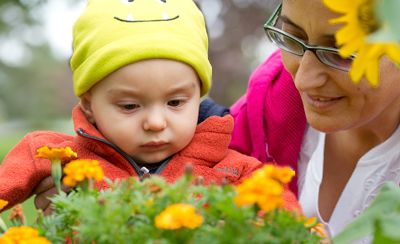
Being out in nature brings wonderful opportunities to connect with individual children
Remember What It Is Like To Be Amazed
Make a choice to get outside with infants and toddlers. Give them the gift of time; time to investigate and to explore. Perhaps a baby will look to the sky, mouth open, and for the first time tastes the tingle of a new snowflake on his tongue. Then you can whisper the word “snow” and know that they are learning from this glorious natural world.
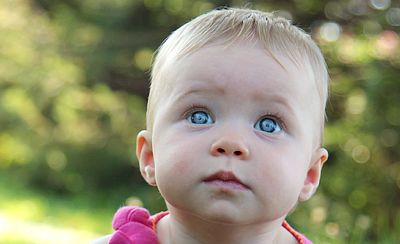
Babies love being outdoors and in nature, and it's so good for them! Want to get your baby into nature play, but not sure where to start? Check our list of simple and fun ideas!
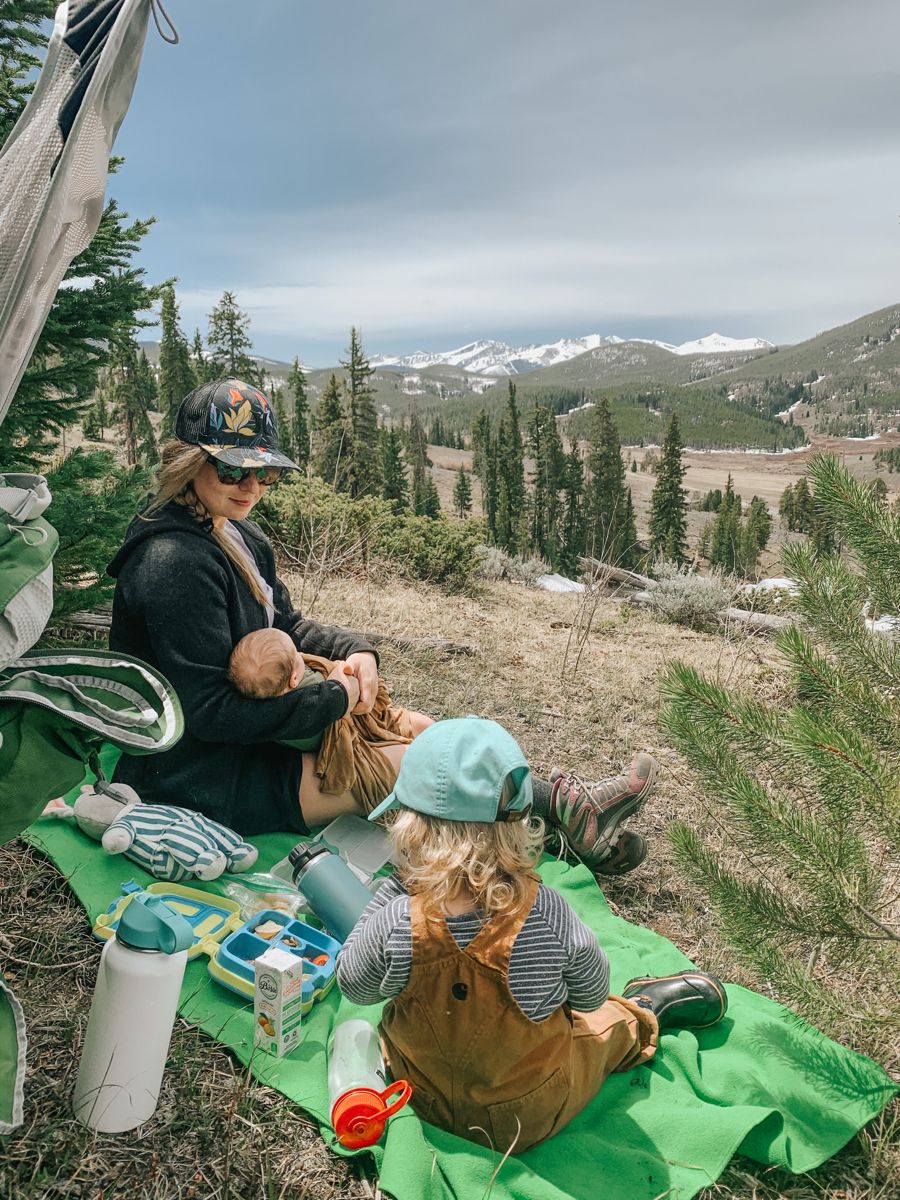
Get up close to plants or point them out while walking in nature.
Talk about and touch the seeds, nuts, berries and flowers. Let babies and toddlers feel different textures with their bare hands and feet.
Stroke leaves or flowers on arms, legs and cheeks. Give babies and toddlers time to explore and focus on nature.
Look at and talk about the colours, textures, shapes and sizes.
Sit with babies to use their senses with nature; you will be close so they don’t swallow anything. Let them touch, smell and even taste sticks, grass and leaves.
Roll gumnuts or bigger seeds. Bury them in the sand to dig up again.
Float flowers, leaves and feathers in puddles or shallow water.
Use seeds, grass and leaves to mix into mud with a stick.
Point out small creatures: spider webs, dragonflies, ants, butterflies, bees. Hold some on your hand or a stick: ladybugs, caterpillars or a praying mantis.
Be brave when discovering small creatures so you can encourage curiosity and interest – not fear! Catching and releasing minibeasts shows respect and concern for nature.
Use a long stick to lift and explore underneath sticks or bark.
Let babies try nature experiences several times to get used to different textures e.g. sand, bark and sticks.
Watch and listen to the birds. Bigger birds like swans or ducks can be easier to see. Visit different waterways, like rivers, creeks and beaches. Talk about and compare what you find.

Make a birdbath for your garden to encourage the birds. Keep it simple and cheap: place a shallow terracotta plant base on a tree stump.
Let young children dry out seeds from fruit and vegetables. Plant, water them and watch them grow.
Dress in waterproof clothing and have short visits in gentle rain. Let the rain drop on hands and faces.
Hold your baby while they paddle hands and feet in muddy puddles or shallow water – good for senses and gross motor skills for strength with walking and standing.
Be fascinated and explore the reflections and shadows in water – go for a walk near a lake or creek or find some clear, shallow puddles.
Let young children wear gumboots and splash and stomp in puddles.
Ride little bikes through puddles.
Run through sprinklers (on your watering day).
Plant an edible herb and flower garden to touch, taste, look at and smell.
Watch the clouds or the shadow of the sunlight in the trees. Let toddlers chase their own shadow and compare their shadow with yours.

Feel the wind and breeze on their face to express feelings.
Let babies and young children mix and poke their fingers in mud and clay.
‘Paint’ mud on things outside with brushes or branches.
Make mobiles out of found objects – feathers, leaves, sticks, to move in the breeze.
Attach material, ribbon to trees and bushes to watch fluttering in the breeze.
Watch and chase the leaves on a windy day - watch what the wind does to light things: hair, feathers.
Superscript
Exploring
Micro-Nature
with Baby
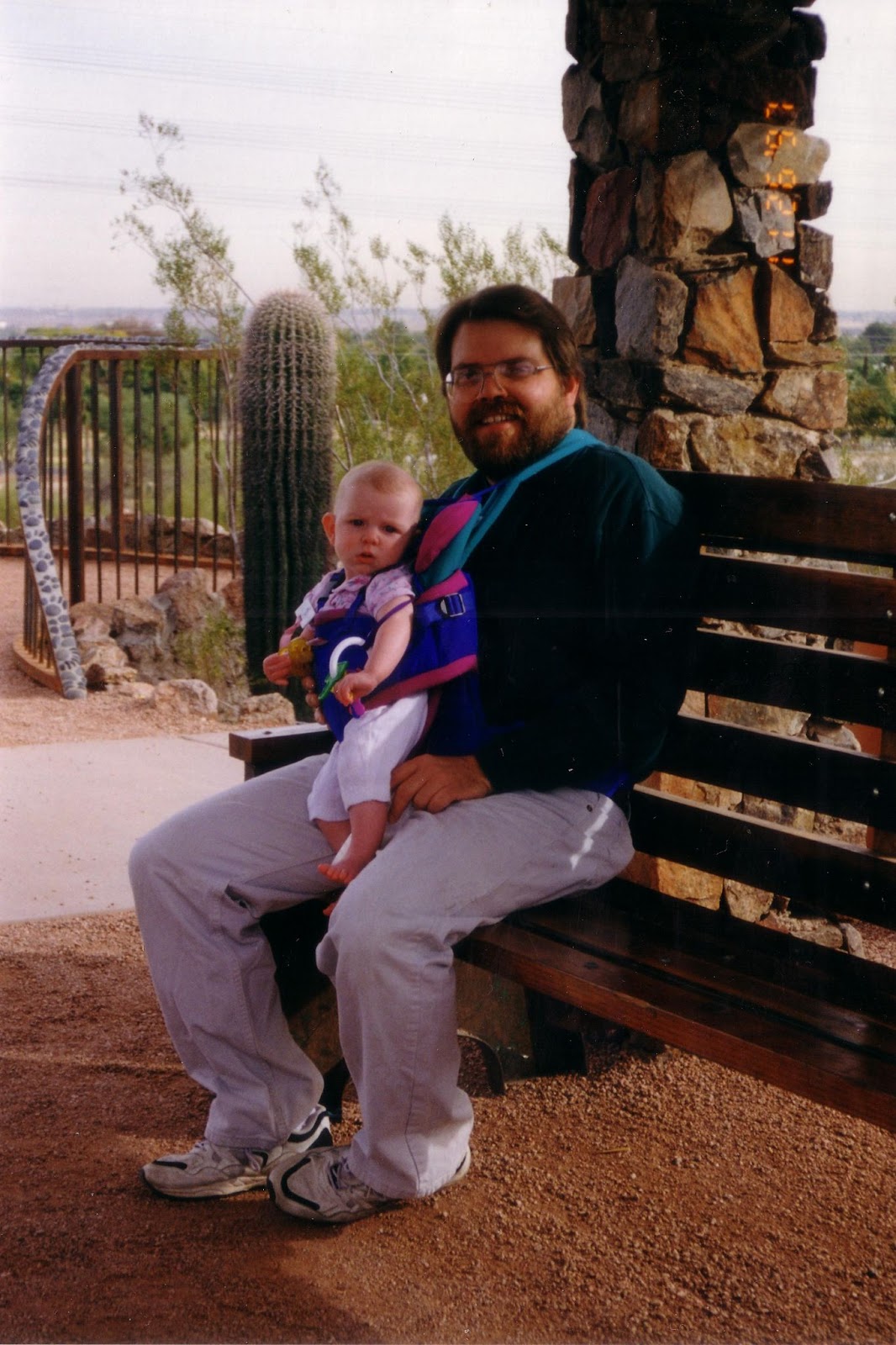
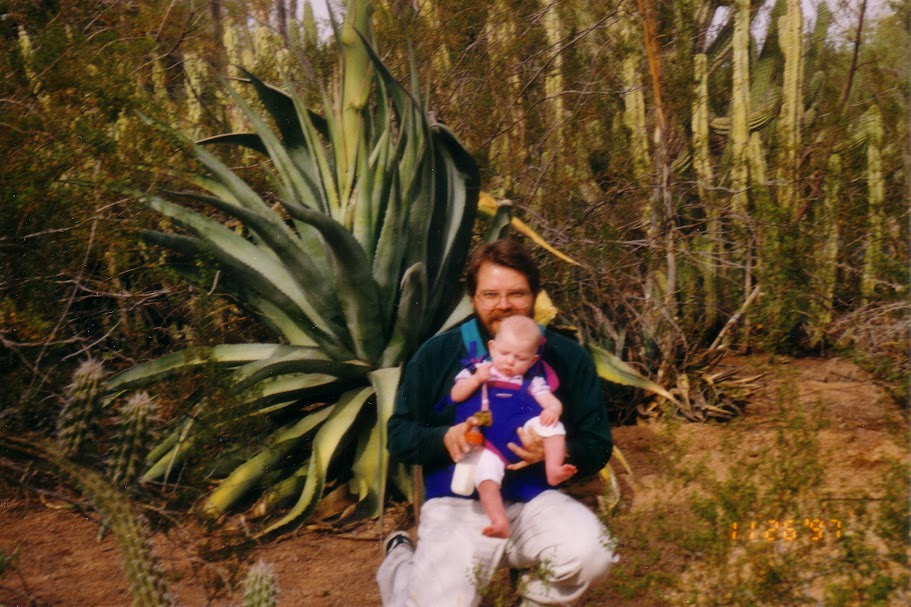
Trust me, you want to maximize fun for your baby and for yourself! Why go into this experience blindly, or by spending countless hours researching when you can take it from someone who has done this numerous times with and without baby.
I got choo, boo .. I got you.
Here is the way we plan our trips with babies and toddlers.
Ten simple steps for preparing a micro-nature exploration on land and in water, coming right up!
The example is for planning a desert camping trip but you can follow the same steps for day or overnight trip.
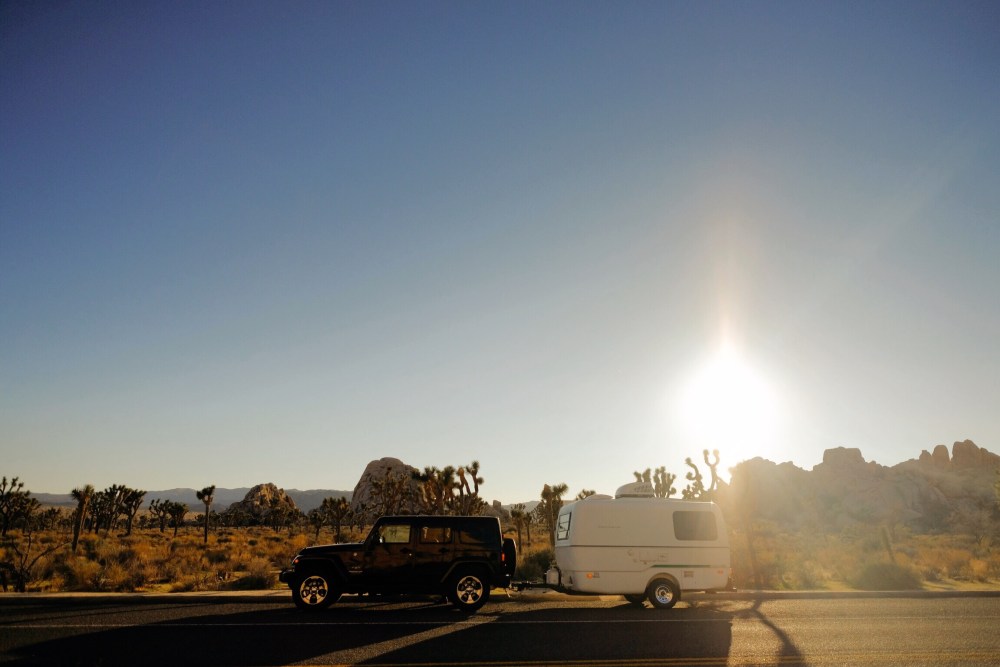
Our JEEP hauling a cute Trillium trailer
1. Choose your destination
***Deserts can be brutal and dangerous if its your first time out. However, my daughters first time in a desert was the first time that she was really into the natural flowers while we explored rather than the wildlife.
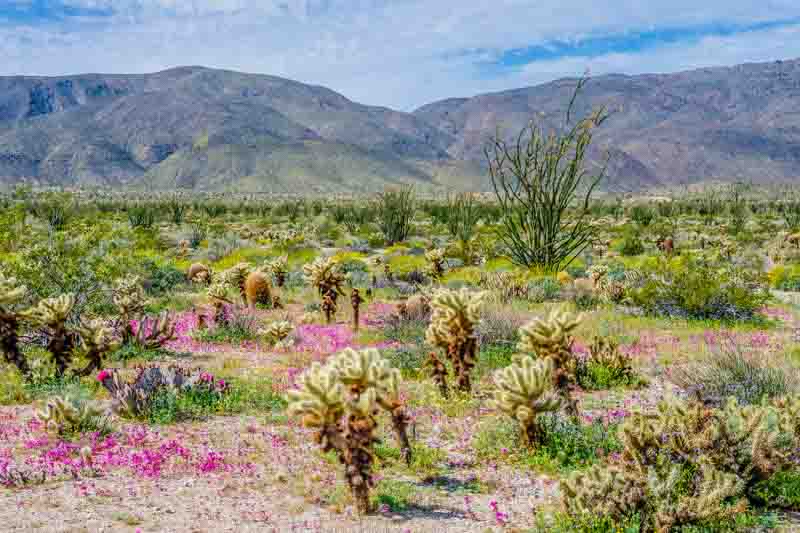
My advice -Choose a park with a ranger to:
Talk about the areas to avoid in the park
Popular nature explorations for family
Viewable desert flowers and wildlife
How to handle waste and trash
Handling a medical emergency (Record phone numbers)
Handling a injured animal
Handling protocols for unwanted or dangerous animals
We Chose Joshua Tree-Where to Camp in Joshua Tree?
Why, Jumbo Rocks of Course!!!
There’s so many public, private and free places to camp in Joshua Tree. One of my favorite spots is Jumbo Rocks. The boulder landscape here is gorgeous. It’s kid-friendly with so many places to explore. Hike to Skull Rock (1 mile round trip) or just explore the many rock formations around your site.
There’s vault toilets, fire pits, fire rings, grills and picnic tables. There’s even a small amphitheater at the Jumbo Rocks campground. Various ranger programs are held there which are great for the kids.
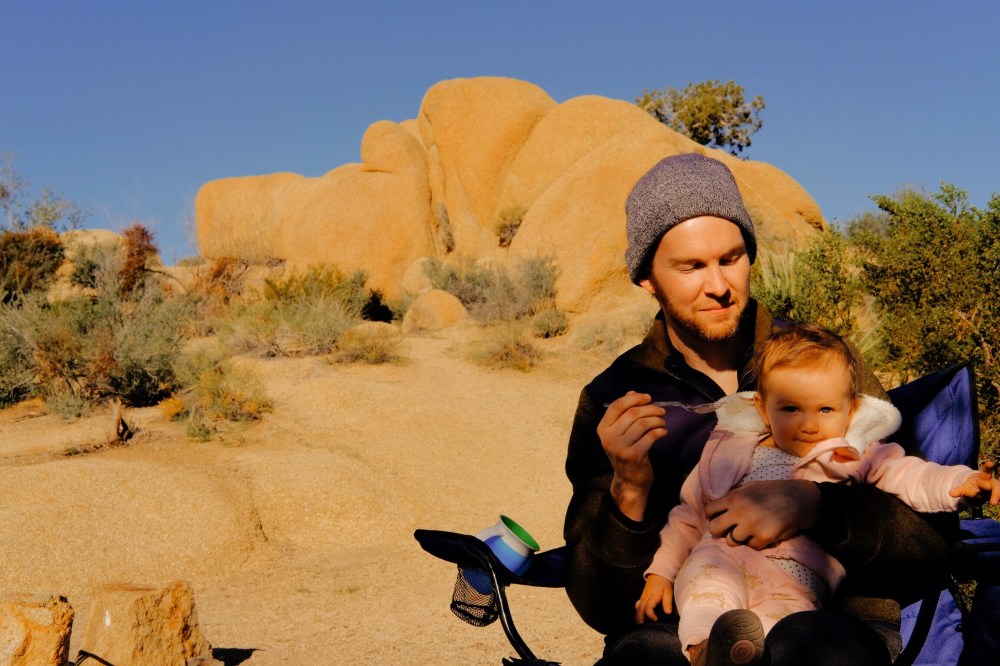
Daddy feeding a yummy oatmeal breakfast for baby
2. Take a Hike!
You can’t fully enjoy the magic of Joshua Tree without a hike. If you’re hiking with a baby or toddler, I highly recommend a baby carrier. This way your baby is safe from wobbling into cactus or chola trees. Pictured here is my favorite hiking baby carrier. This thing is a must for outdoor families who love to explore hours on foot. I also love the Tula baby carrier. It’s my every day use option, and they have the cutest prints!
We had planned to do a longer hike, but the desert winds were quite strong. If you’re looking for a short but beautiful hike, you gotta visit the Chola Cactus Garden. It was about a 20-minute drive from our campsite at Jumbo Rocks.
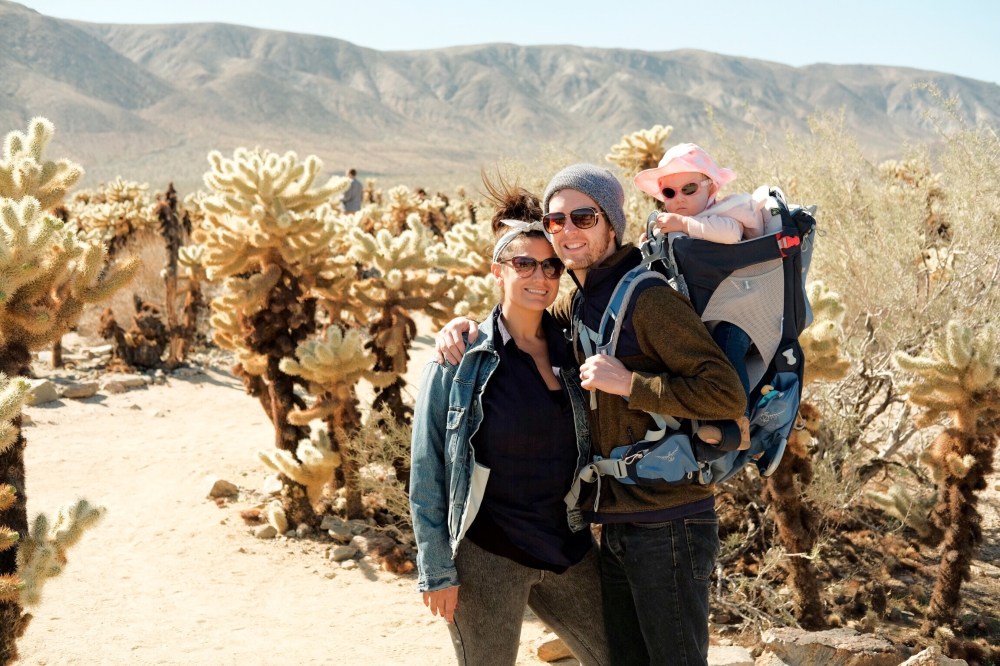
Exploring the Chola Cactus Garden
3. Bring a Tripod
It’s hard enough to get a family photos using your arm for a selfie! Heck, it’s hard enough to get your kid to look at the camera (and I’m not even asking for a smile). One of the best things we invested in for all of our travels is this nifty tripod. Super easy to use and ultra compact. We had originally purchased it for our backpacking trip to Havasupai Falls, prior to having Victoria, but now we take it on all of our family camping trips and travels.
Our other favorite travel tripod is the JOBY GorillaPod. This thing is great for attaching to trees, signs, rocks — you name it.
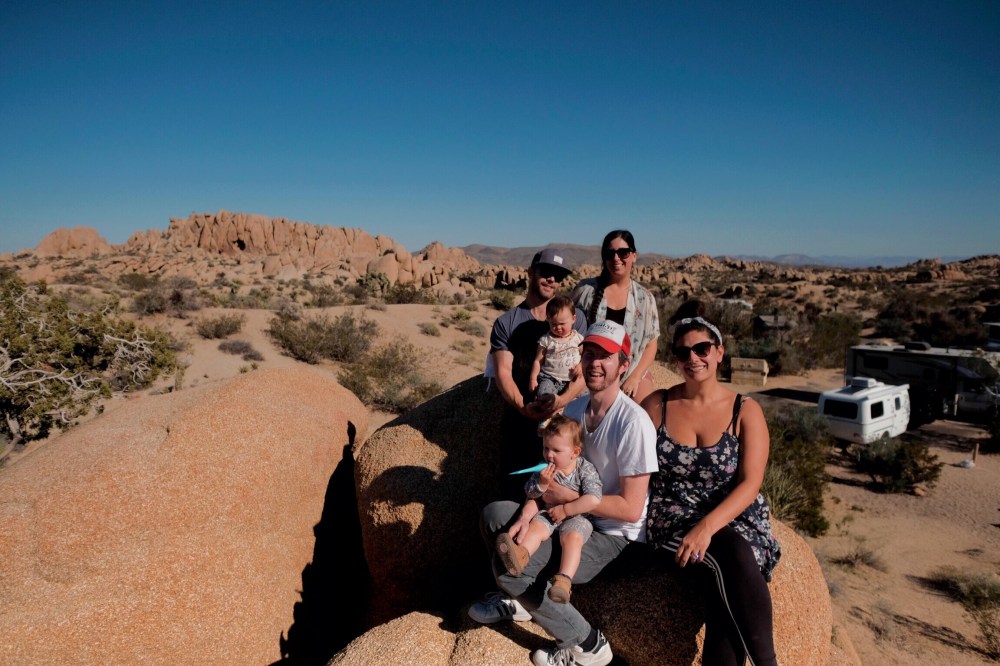
EVERYONE in the camping photo
4. Bring Instruments and Make Music
My daughter loves music. She also loves making music. Yes, we are a musical family with lots of talented musical friends, but even if you don’t know how to play an instrument, nothing beats strumming a few chords or beating some drums around a campfire. It’s one of our favorite sensory activities for Victoria.
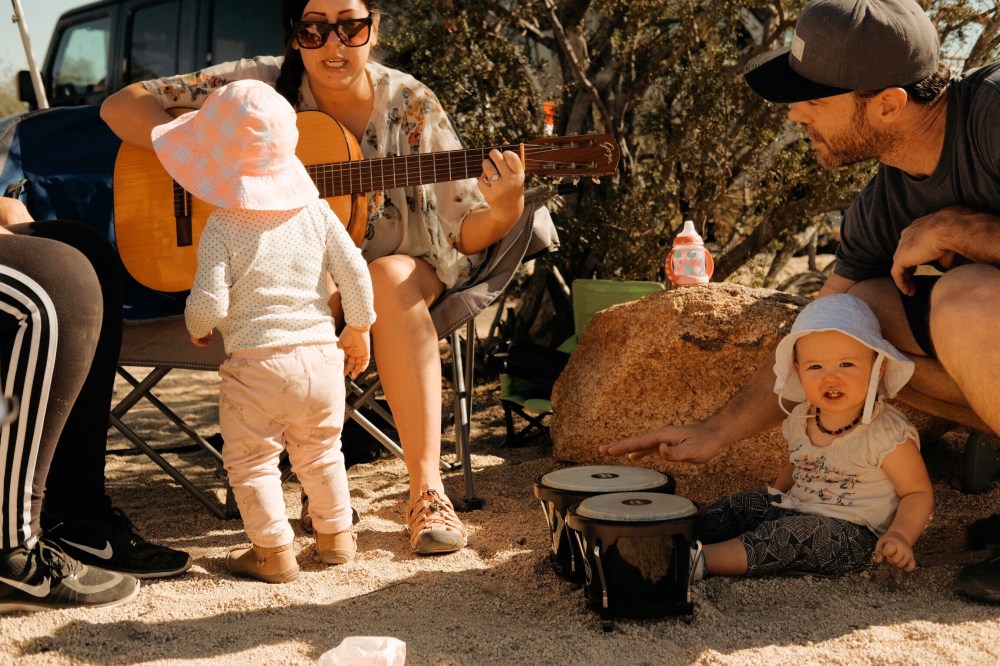
5. Self-Care Yo’ Self with a Foot Stool aka Toddler Activity Table
Do you know the magic or a foot stool while camping? I had originally purchased this lightweight camping foot stool for our backpacking trip to Havasupai Falls. I was hiking with a torn meniscus and needed an option to elevate my feet. Even my husband used it to relieve his sore feet. Now, I never hit a campground without it. Mostly because it’s a wonderful self-care amenity after hiking all day and running after a toddler, but also because my daughter loves to use it as a play table.
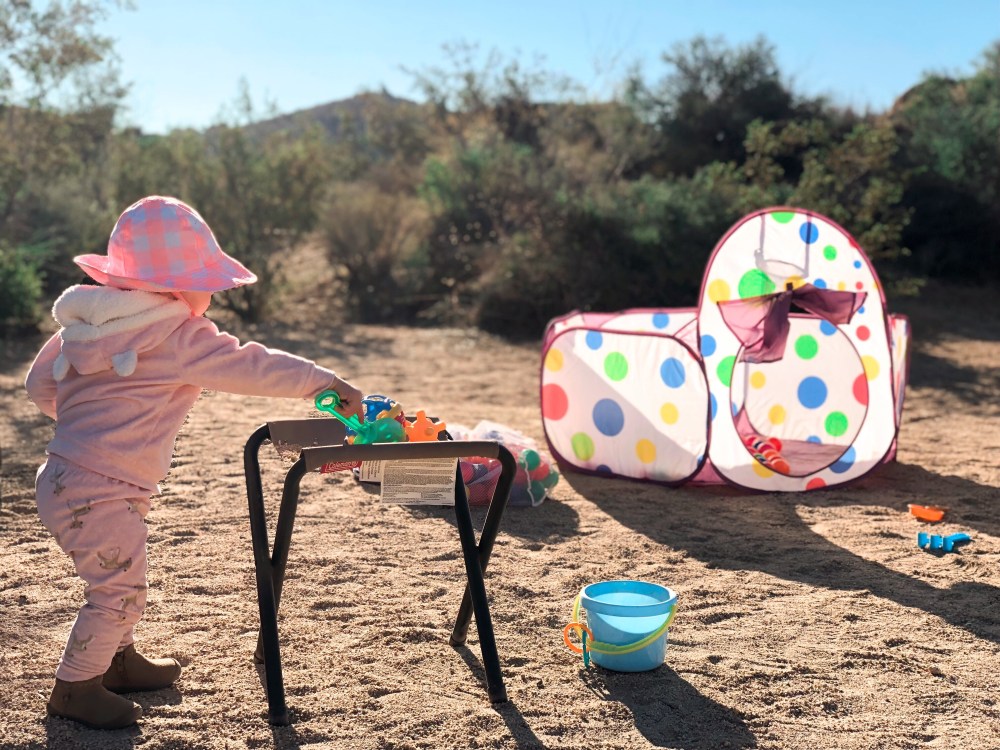
6. Trailer Camping
While we absolutely love tent camping, especially in our new tent (that I can actually stand up in), we also like to trailer camp, especially in the desert. The Joshua Tree desert can get very windy. I’ve seen numerous tents blow away that were not properly staked for winds. The desert can also get very cold at night. This time around we opted for trailer camping. We rented a Trillium trailer that kept us warm at night thanks to its built-in heater. We usually use this heater when we tent camp. The winds got crazy strong the following night. We were thankful to have had a trailer. It makes sleeping easier. The last time we tent camped in the desert, our toddler woke up every hour due to the wild desert winds.
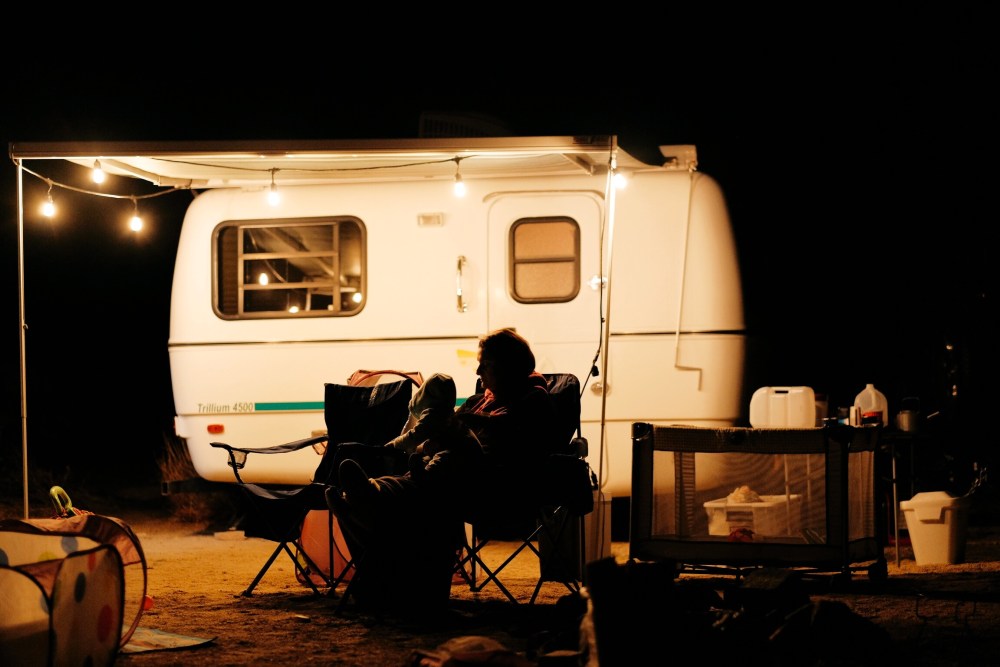
7. Create a Safe Play Area for Kids
Whenever we go camping, we always bring this super lightweight and compact pop up playground. It has a mini tent, crawl tunnel and ball pit. Our daughter and her buddy loved it. We also bring plenty of sand toys for digging. Victoria thinks she is an archeologist whenever there is dirt or sand nearby. If you have little ones that don’t walk just yet or are learning, you should definitely bring a pack and play or a portable play-yard. This allows for mom and dad to crack a cold brew or glass of wine and sit in a cozy camping chair while the kids play.
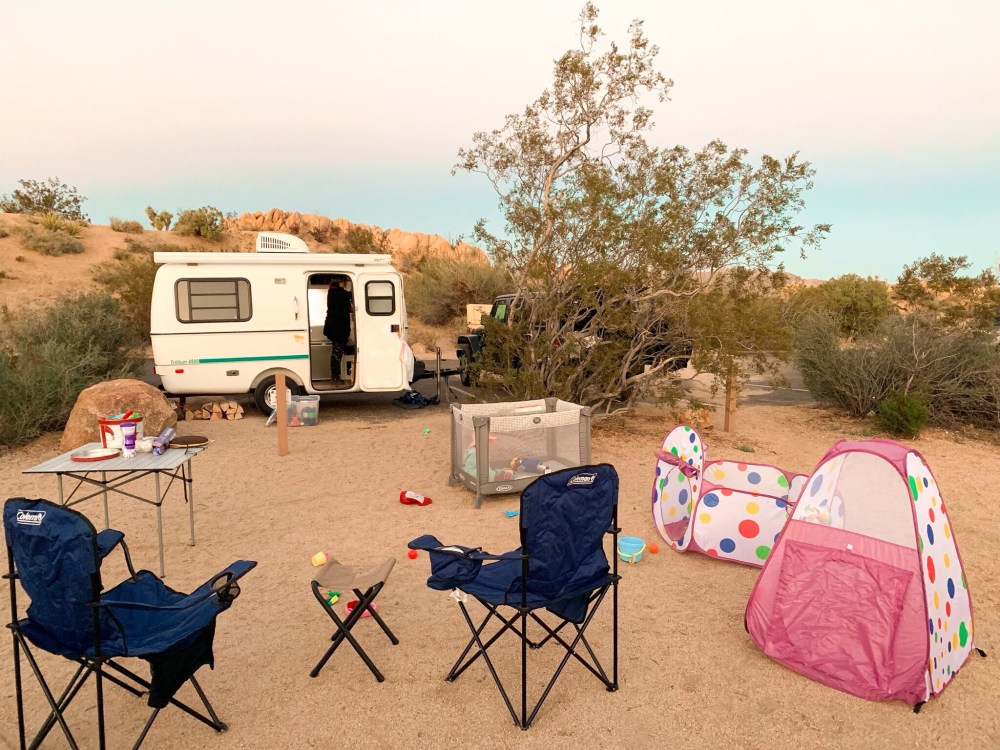
8. Smoothie Pouches
Can’t tell you how many times fruit and veggie smoothie packs have saved us. They saved us in Italy countless times, and they came in handy on our camping trip. They are a quick and easy snack for baby while hiking or on the road. This is out go-to smoothie squeeze pouch, but our daughter also loves these ones which tend to be a bit more hearty.
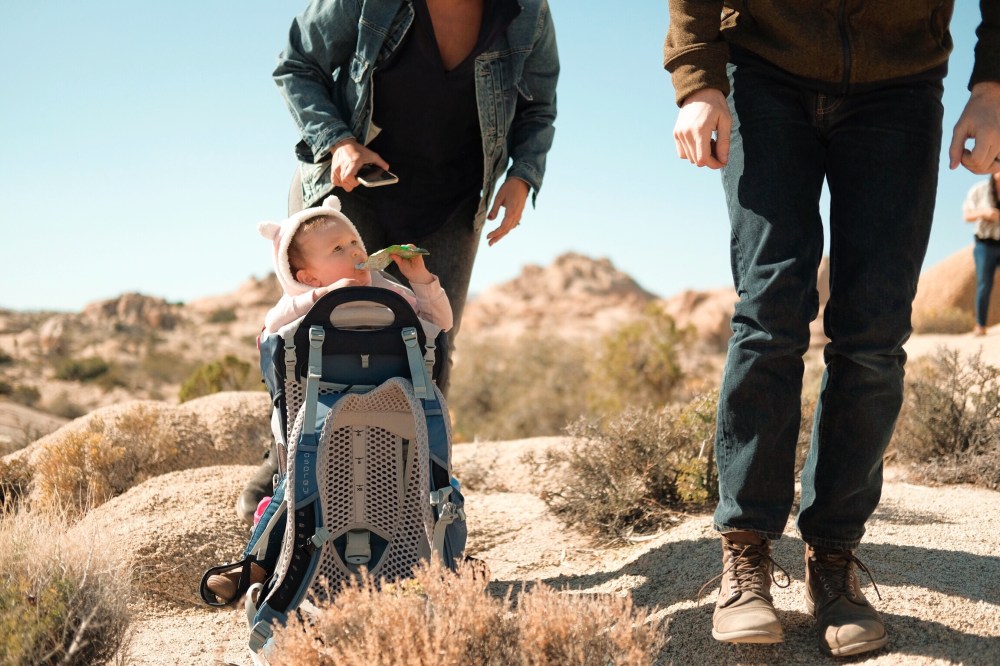
9. Layers, Boots, Layers
Desert camping calls for boots and plenty of clothing layers. Not just for you, but for your baby too! You don’t want to get those pesky sand pebbles in your shoes, nor do you want them in your babies shoes. We always rock our boots when in Joshua Tree.
These are my go-to boots for camping. They’re comfy and stylish. I also have a pair of these for cold, wet weather. My husband swear by his oldest pair of Red Wings and for baby we had her in these. But these rain boots also do a great job of keeping sand and pebbles out.
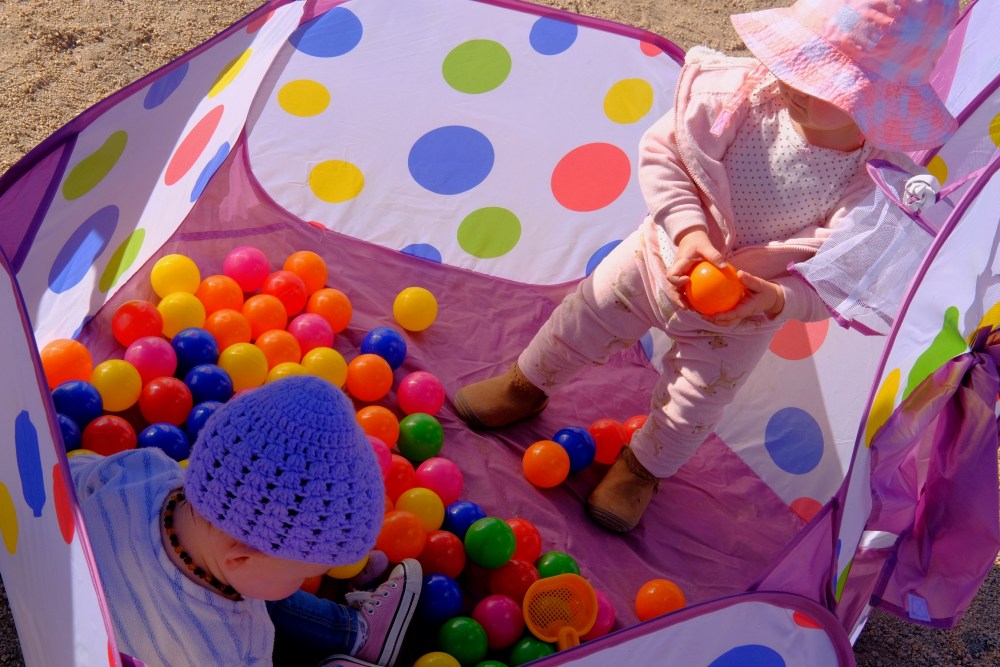
As for clothing layers. I always wear jeans or work out legging and pair them with a tank top, followed by a button up long sleeve, hoodie, and jean jacket. You’ll add or peel these layers as the chaotic desert weather changes.
Baby layers! During the day Victoria were a long sleeve onesie with a zip fleece hoodie and matching fleece pants. And we can’t forget the sunhat! Be sure to have a beanie for your baby in the evening. She loved this one. Once the sun set, we had Victoria in a long sleeve shirt and pants (these ones are perfect) with a fleece onesie over them. We also had her rain coat over all of it at one point when it got really cold. One thing we did not have and I wish we did, was mittens! Her little hands were so cold! We now have these.

10. Take Time for Yourself
This is YOUR trip too. If you want to have a successful camping trip with your baby, I urge you to take time for yourself. Have your partner watch the baby and go for a solo walk through the many magical rock formations. Find your perfect spot and read a book or meditate. Whatever you do, just be with YOU!
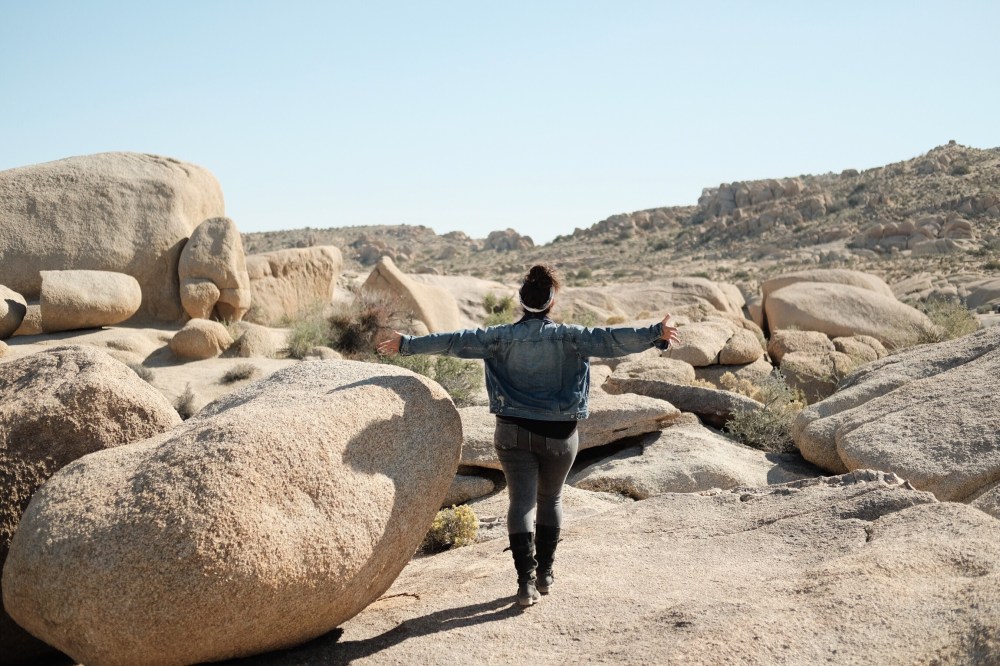
I’m free (even for just a few minutes) #MomLife
Music Festival Camping with Baby!
When using a stroller in the desert, it's crucial to choose an "all-terrain" stroller with large, durable wheels designed for uneven surfaces, a large sun canopy to protect your baby from intense UV rays, and breathable fabrics to combat heat; features like a good ventilation system and a reclining seat are also important for your child's comfort in the desert environment.
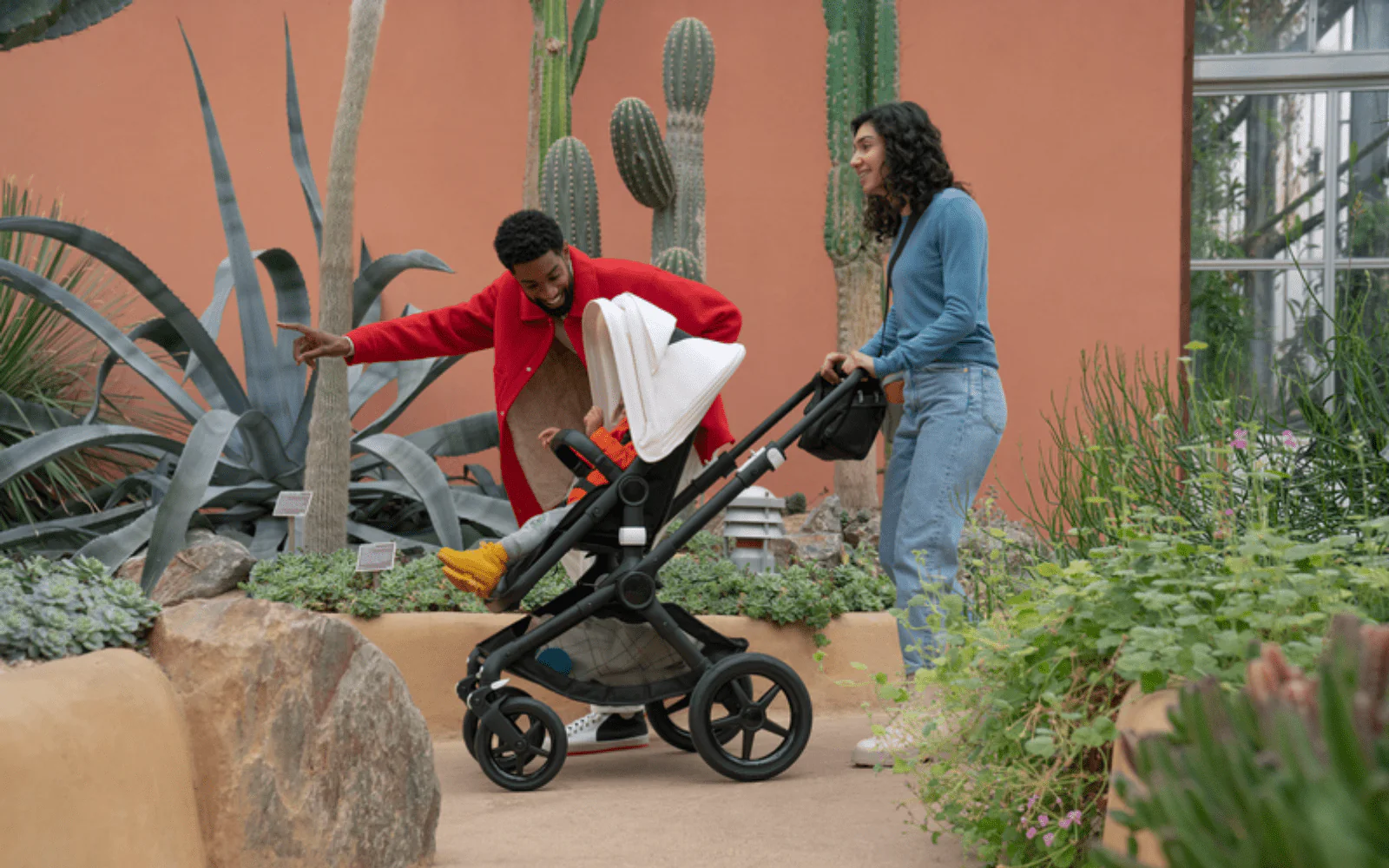
Check the terrain:
Be mindful of the specific desert terrain you'll be navigating and choose a stroller suitable for that condition.
Note: Desert animals are very different than other species in other habitats. They have developed special adaptations to help them survive in the hot and dry conditions of the desert. We wanted to be explore the different types of plant and animals that live here and some of the really cool features they have.
Exploring Desert Camping
Desert Hiking with Babies
After 25 years as Floridians, I never thought we’d become desert rats, but the moment we arrived in Arizona, we fell in love. When our son was born, our adventures centered around our high desert home meaning he spent a ton of time early on exploring the desert.
Below, I have compiled what we have learned along the way to safely enjoy our hottest, driest adventures with the hopes that it will help others to enjoy the desert as well.
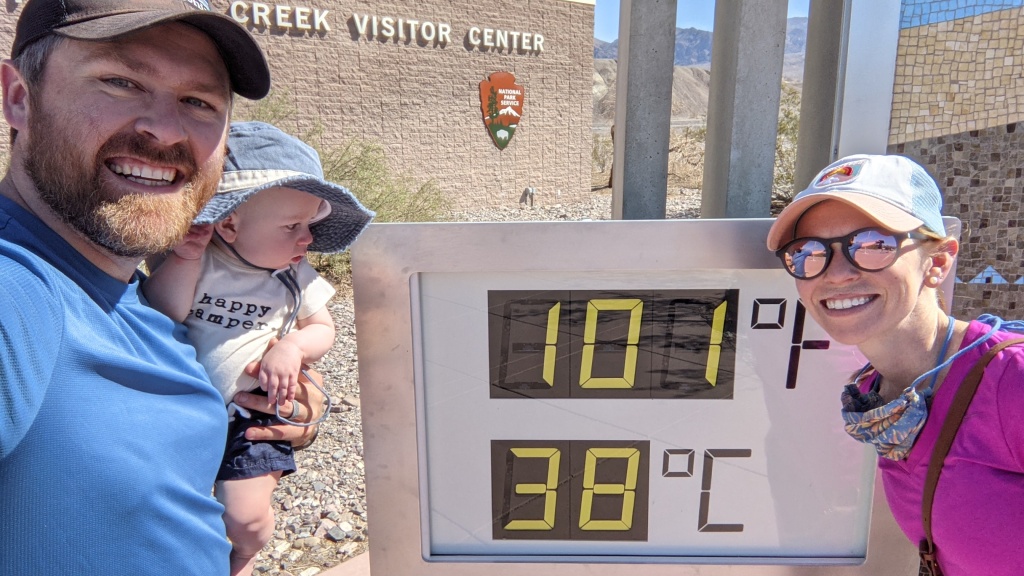
If you ever have questions or concerns about sun exposure, overheating, your plans to hike, camp, or do whatever else with your child in the desert, please consult with your child’s pediatrician.
Babies & Thermoregulation
Babies are at a greater risk for heat and sun exposure related conditions. This is caused by a few things: their greater surface area/volume ratio which allows their body temperature to fluctuate more easily, their under developed sweat glands, their thinner skin that produces less melanin, and their increased risk of SIDS due to overheating.
Because of these things, it is imperative that parents and care givers take extra precautions to protect their children while enjoying hot desert climates.
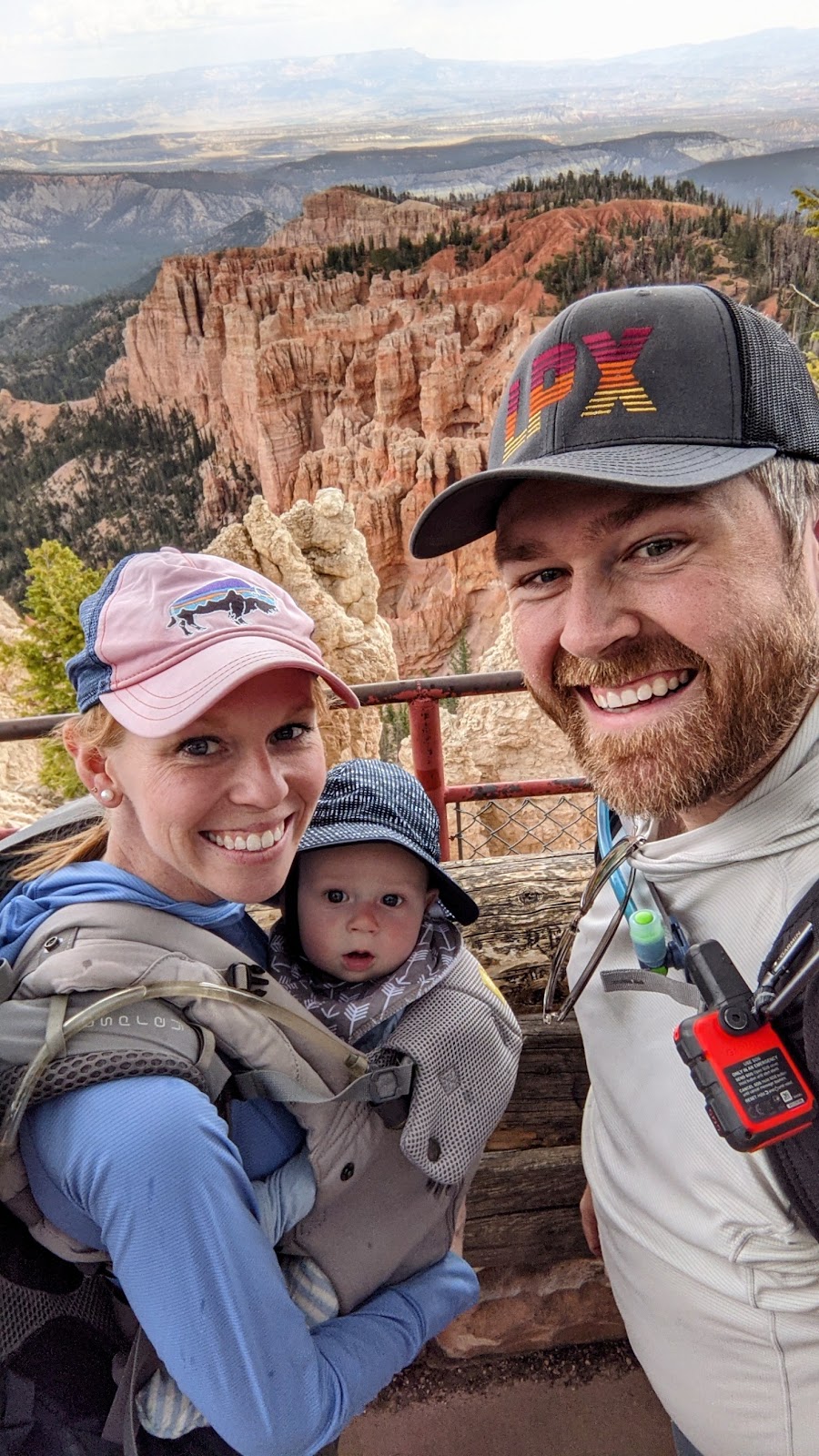
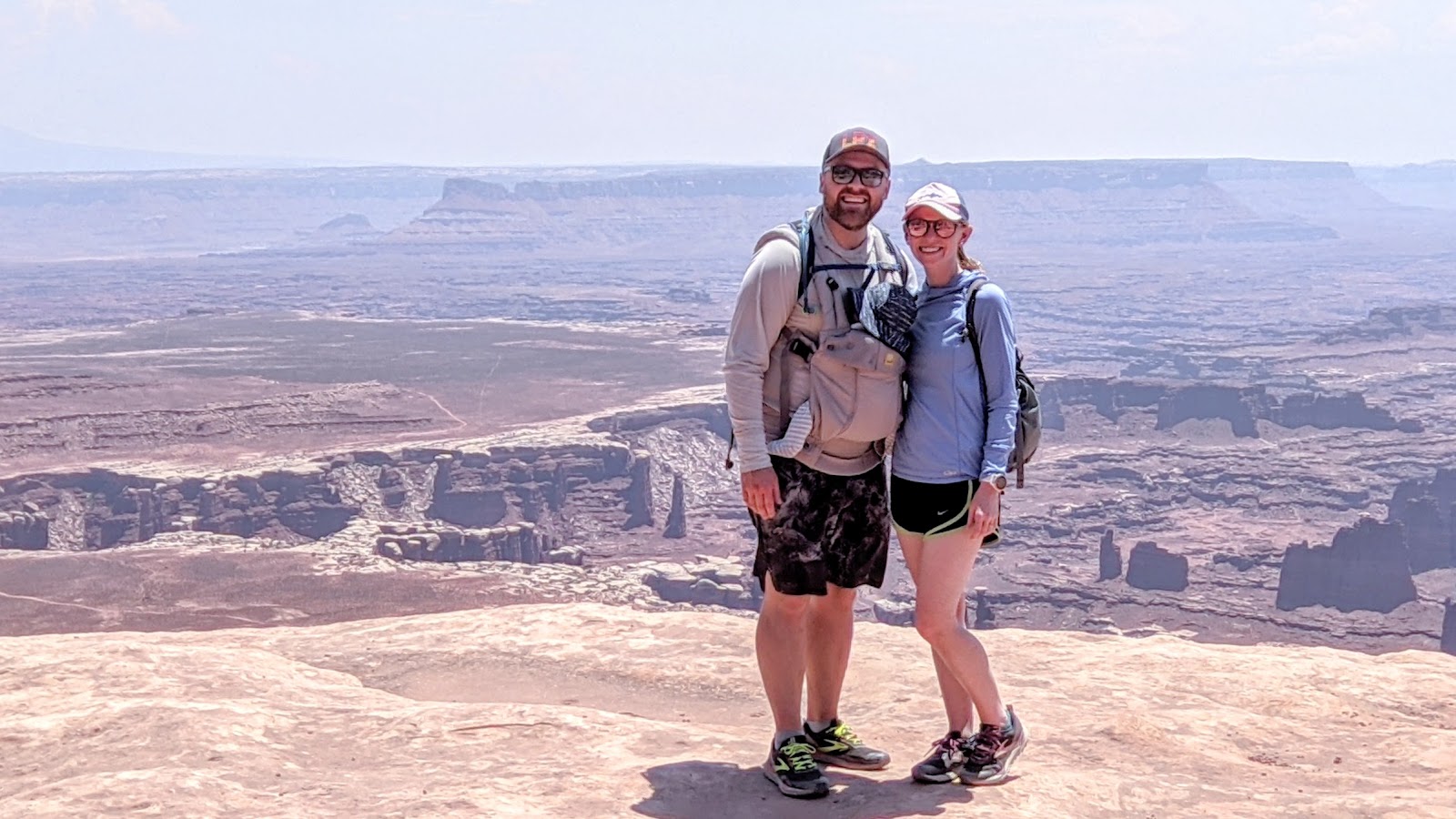
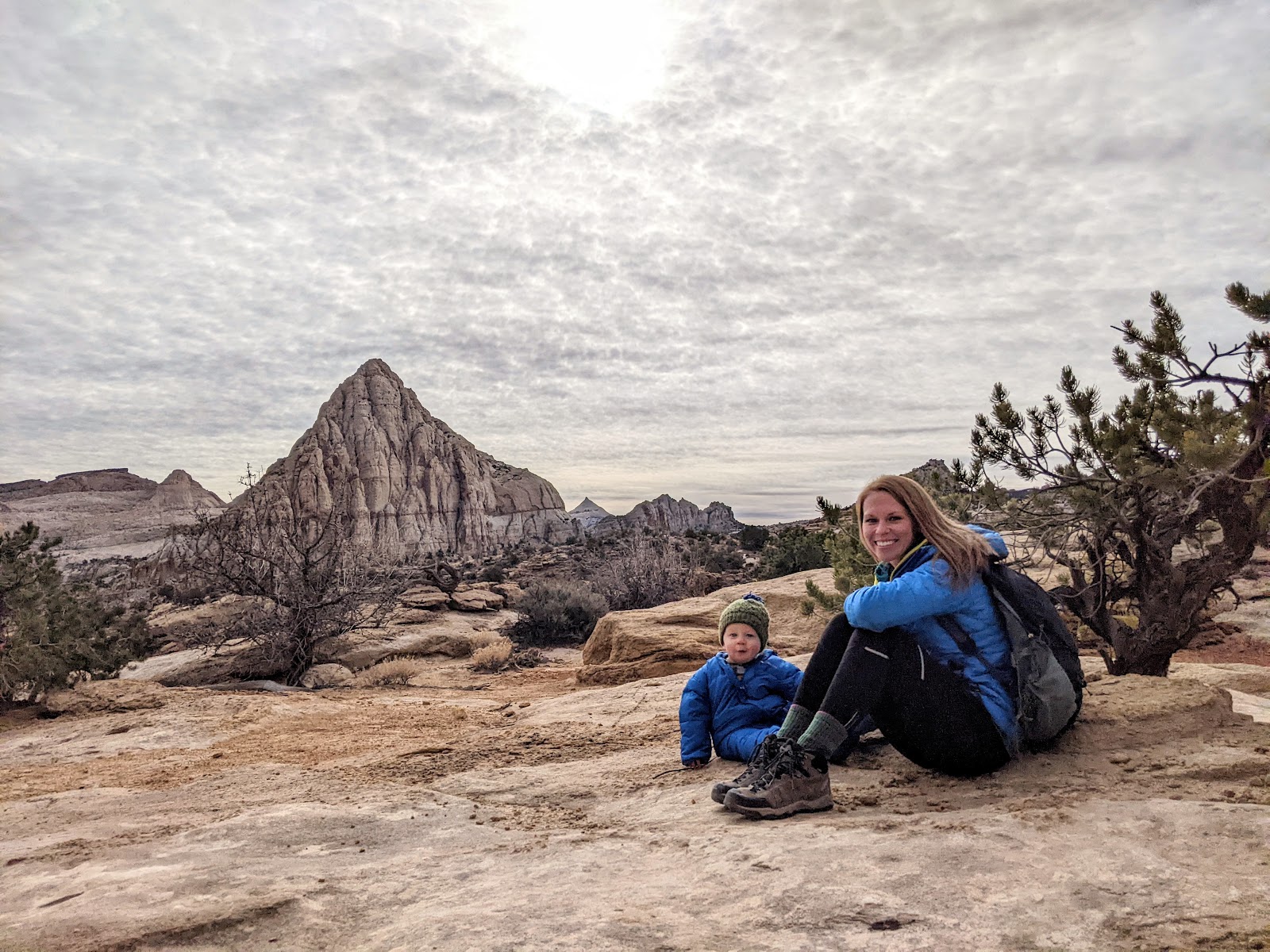
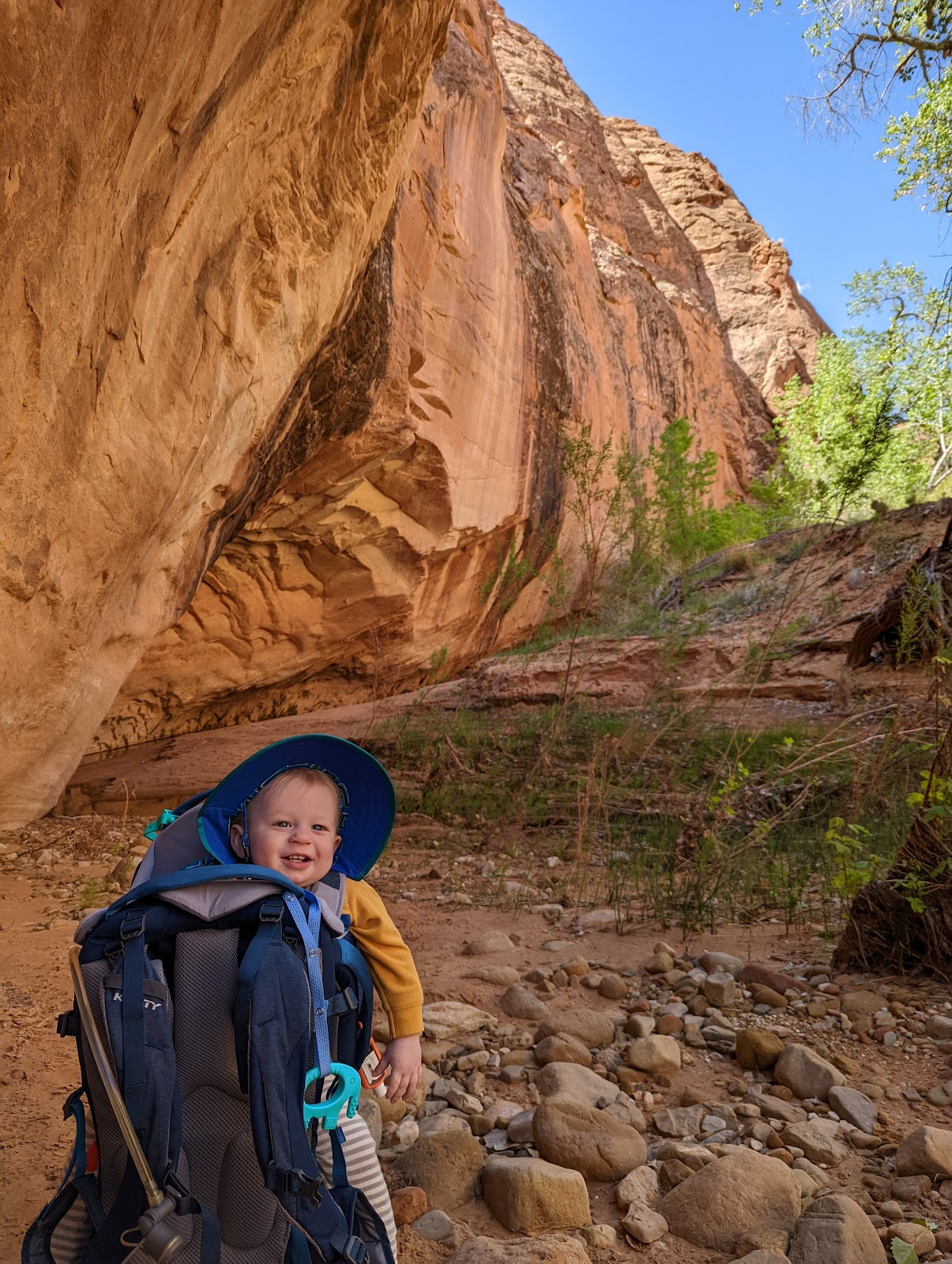
Best Practices
Ironically, most suggestions for hiking in a hot desert are some form of “avoid doing it:”
Avoid hiking in the middle of the day, generally between 10am and 4pm.
Avoid the sun and find as much shade as possible. Find the shadiest hikes if possible and always keep track of the nearest shade to take good breaks.
Avoid the dryness and stay wet. When it’s dry and hot, your sweat evaporates before it can absorb your body heat to keep you cool, so dipping a towel or shirt in water will do what your sweat wishes it could do.
Keep your hike short. Obviously, too much sun and too much heat can be dangerous, so don’t be too ambitious with your plans.
Know when to call it quits. While you should definitely be aware of the signs of dehydration, heat exhaustion, sun burn/poisoning, etc., you should also try to call it quits before any of these symptoms present themselves. If it gets hotter faster than you planned, turn around. If you are drinking water faster than expected, turn around. If everyone is grumpy and irritable, turn around. Turn around before there is a problem.
Go somewhere less hot! Much of the American Southwest is dotted with high elevation mountains/plateaus and great swimming holes. For instance, if you are enjoying Northern Arizona/Southern Utah, you might consider cooler options like:
The North or South Rim of the Grand Canyon
Bryce Canyon National Park
Lake Powell (Glen Canyon National Recreation Area)
Slide Rock State Park in Sedona, AZ
(see slideshow below for some examples)
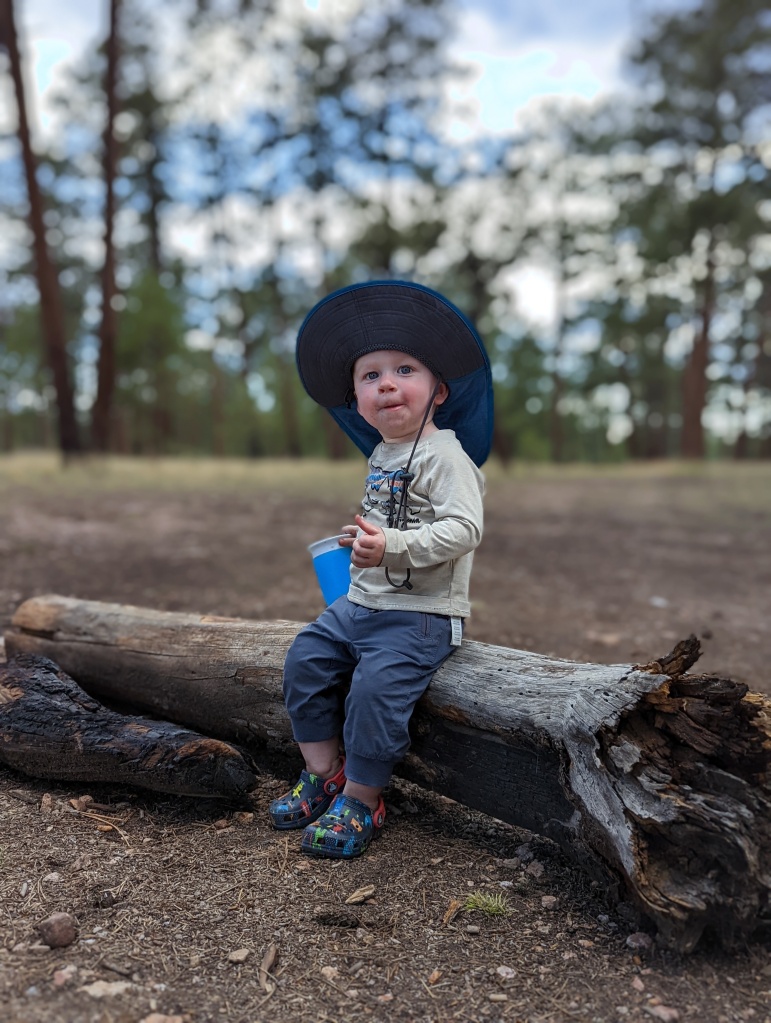
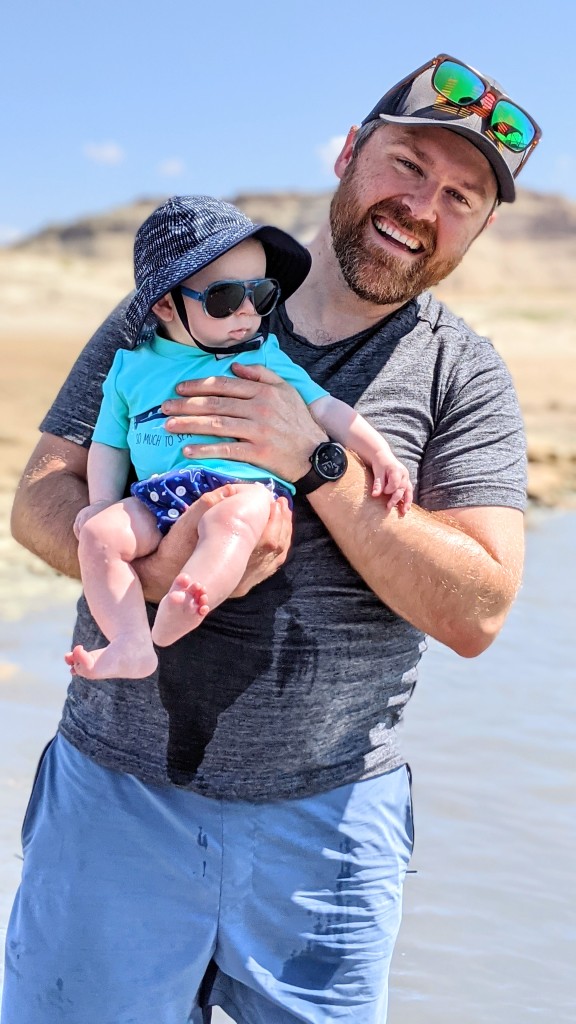
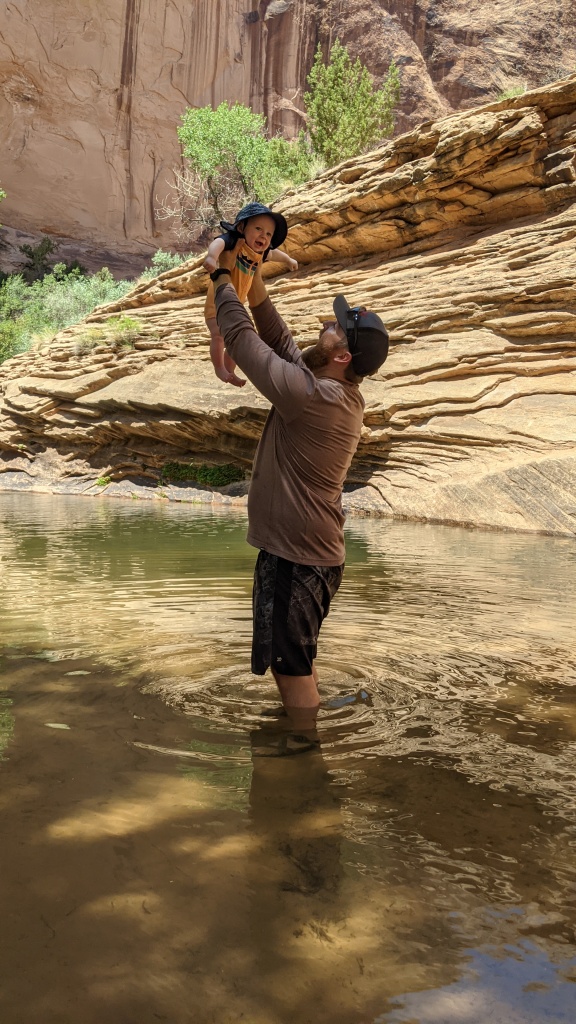
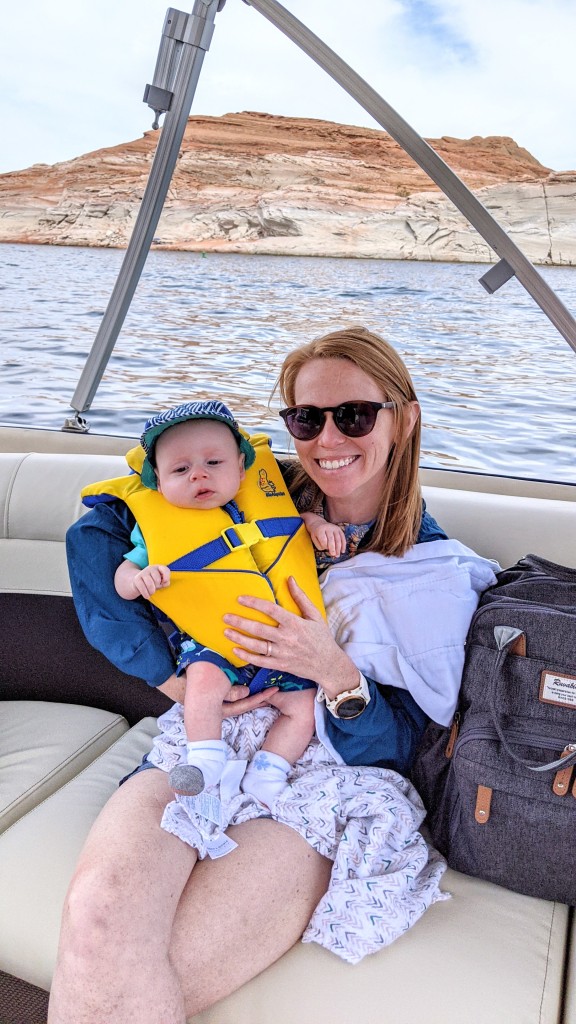
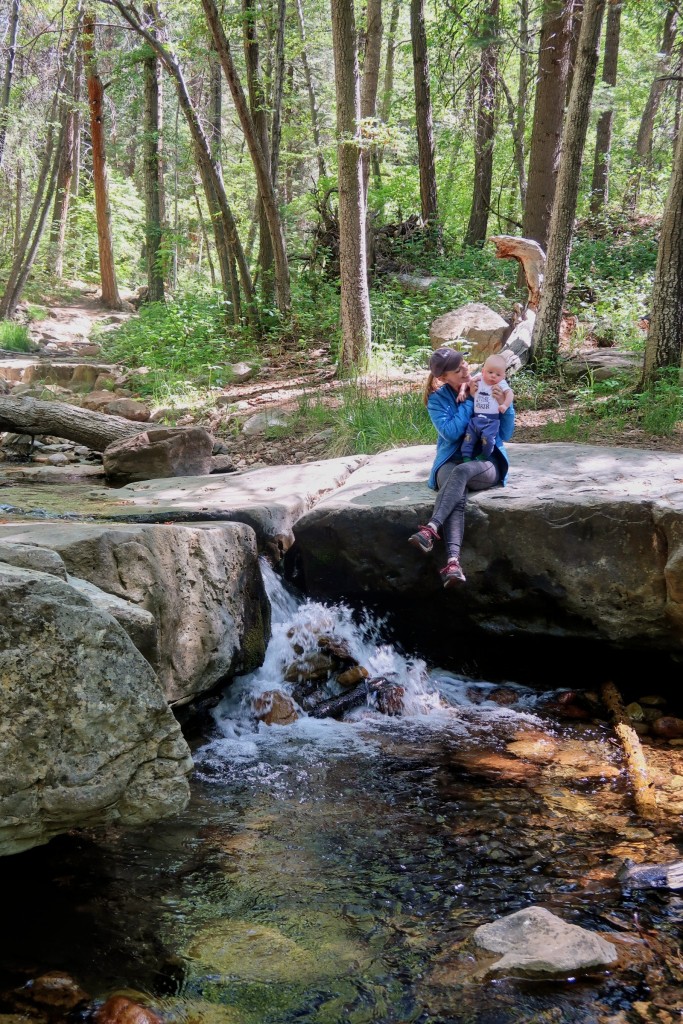
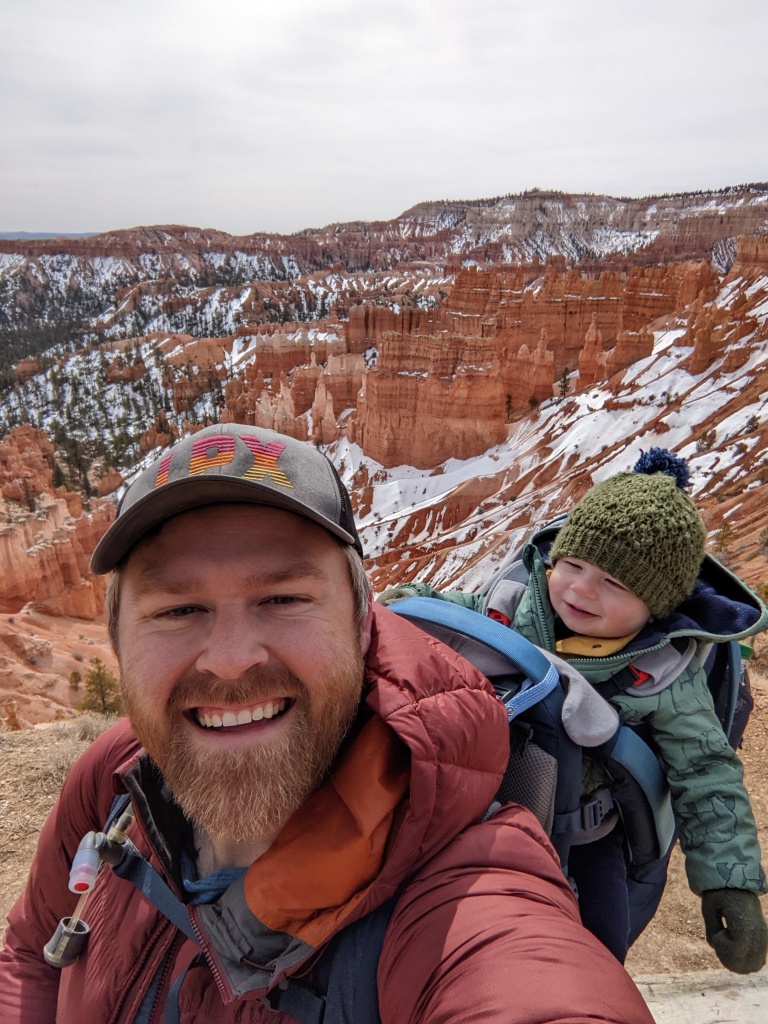
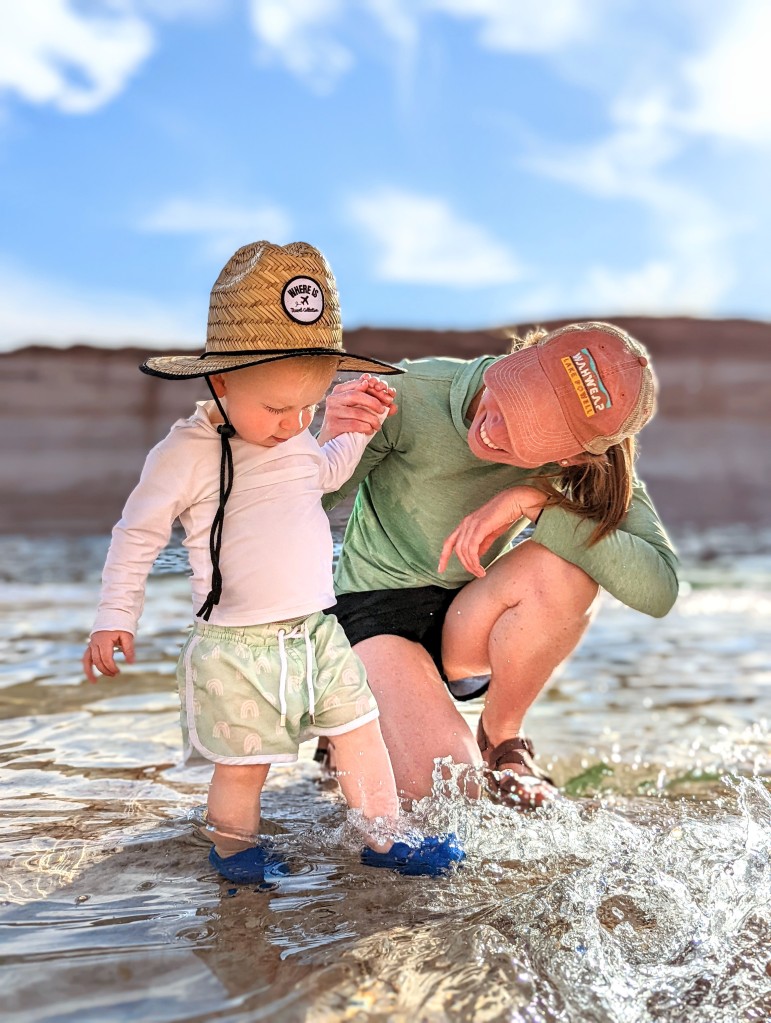
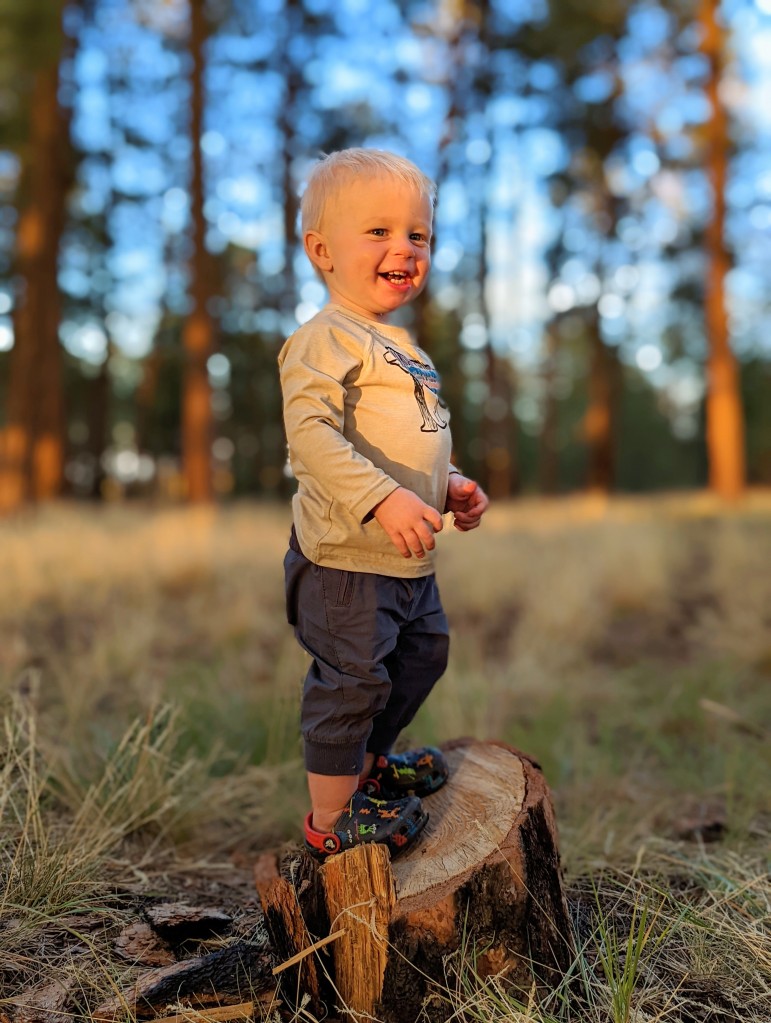
Beyond “avoiding the sun” and “avoiding the heat,” the most important consideration is to STAY HYDRATED.
As a general rule of thumb, plan on a gallon of water per person, per day.
Replenish your lost electrolytes to avoid Hyponatremia caused by excessive sweating/fluid loss. Drink sports drinks, coconut water, or electrolyte powders added to your water.
Breast feeding moms are at an increased risk of dehydration, so be sure to drink even more than expected if this is you!
Just as you need to drink more, so will your baby. Be sure to offer milk/formula to your baby more frequently…and remember, increased breast feeding means increased fluid loss for mommas!
Generally, babies are to wait until 6 months to consume water, but as always, consult with your child’s pediatrician on what’s best for your child.
Finally, you should be prepared to identify and treat symptoms of heat or sun exposure related issues. According to the AADA: “If your baby is fussy, crying excessively or has redness on any exposed skin, take him or her indoors immediately.”
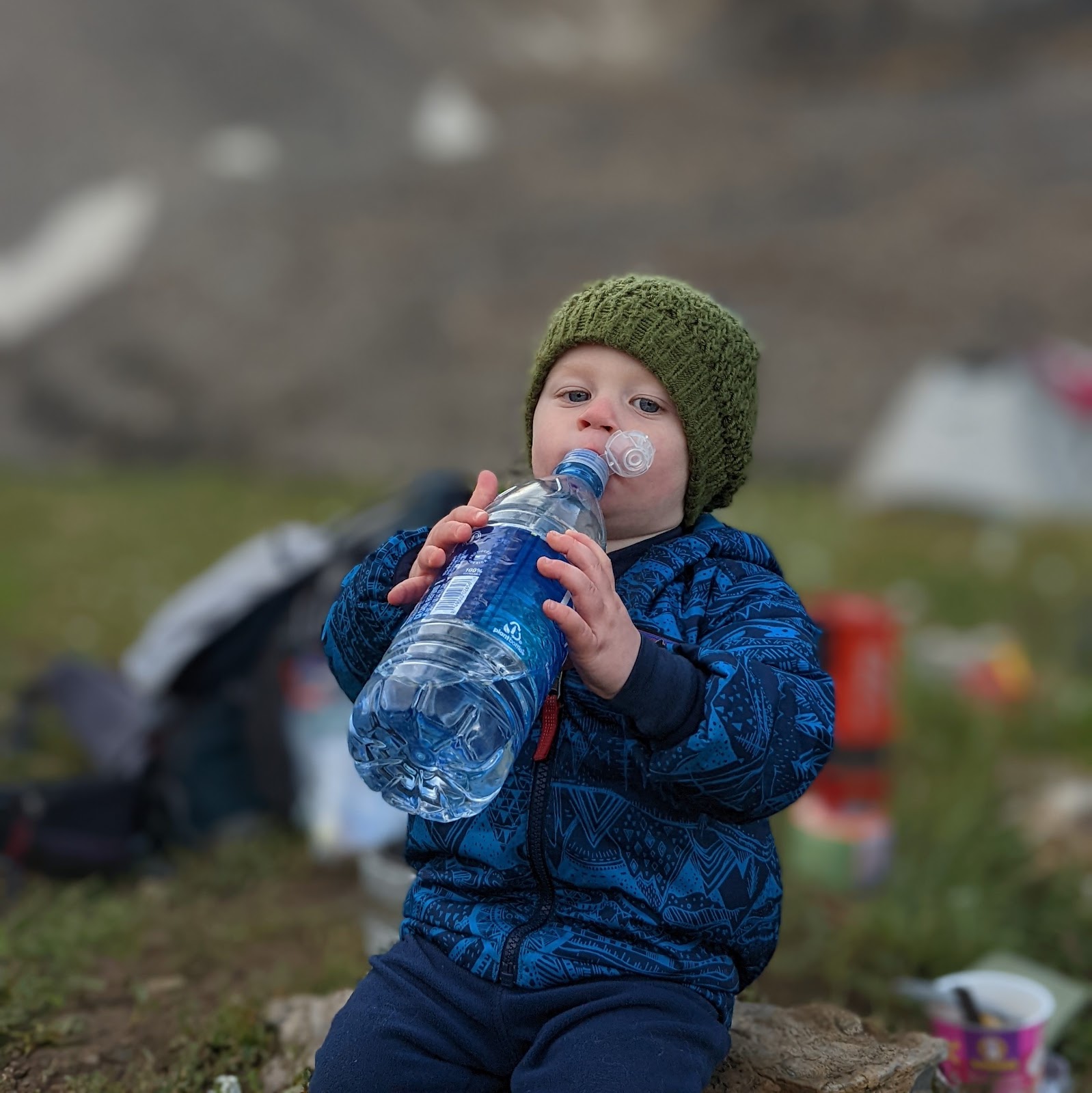
In general, if your child is turning red, is hot to the touch, is lethargic or vomiting, has a fever or elevated heart beat, or if you just suspect something is off with your child, get them where it is shaded and cool as quickly as possible. Consider a cool cloth or a luke warm bath to cool them down.
See below for a few of Seattle Children’s Hospital notes and recommendations for when things get more serious:
Call 911 now if your child is hard to wake up, is having seizures, or has a fever over 105ºF (40.5°C).
Call a doctor if your child is acting unusually, has a fever and is less than 12 weeks old, is vomiting from drinking fluids, appear dizzy or sick, has a dry mouth or no tears, or hasn’t urinated in 8 hours or the urine is very dark.
What to Bring
Sunscreen
According to the FDA and the AADA, you should wait to use sunscreen on your child until after 6 months if possible. However, if shade and appropriate clothing are not available, the AADA also advises to use “a minimal amount of broad-spectrum, water-resistant sunscreen with an SPF of at least 30…Sunscreens containing titanium dioxide or zinc oxide are less likely to irritate a baby’s sensitive skin.” If you are unsure how to best protect your infant’s skin, please speak with your child’s pediatrician.
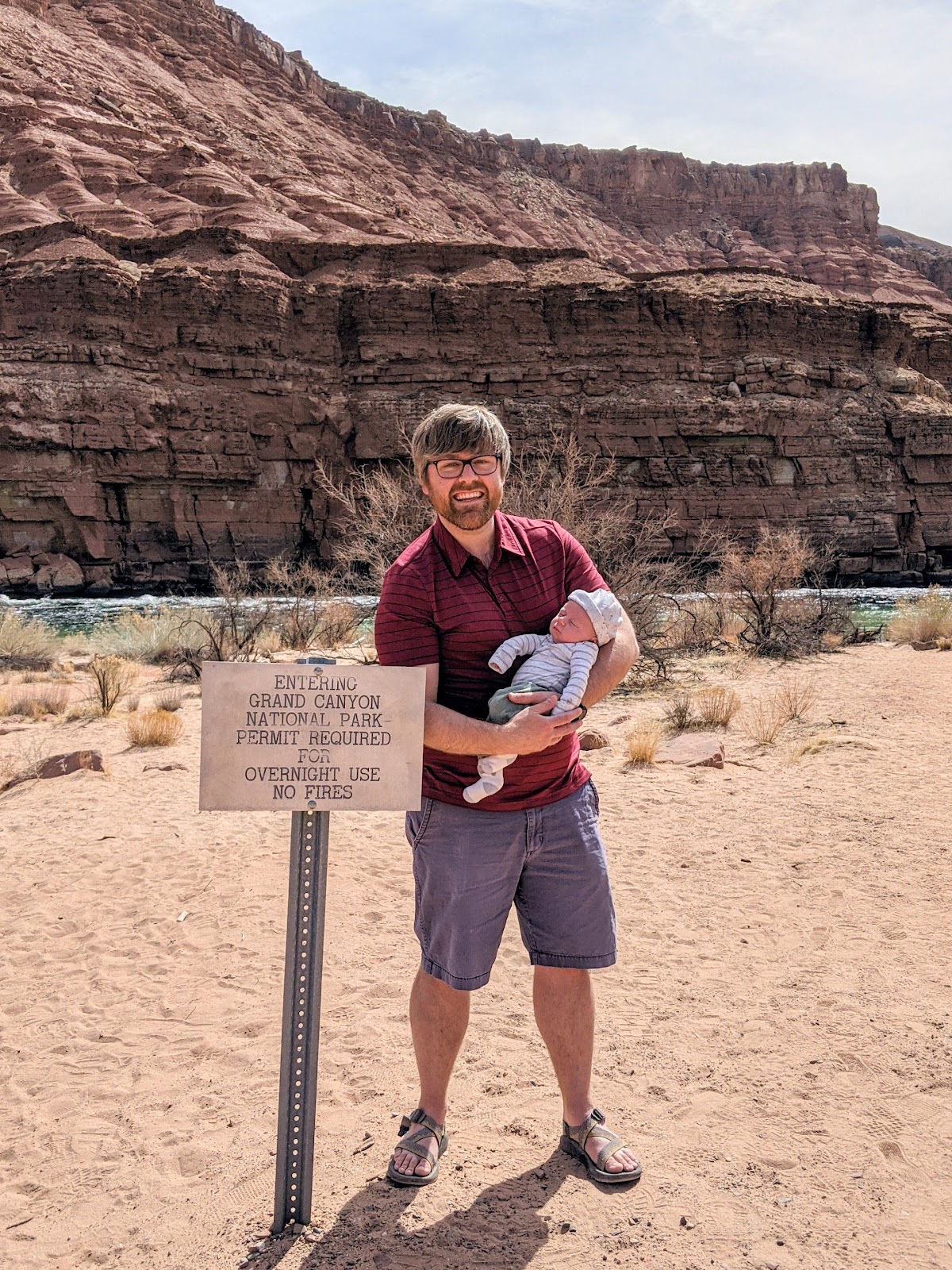
We love Tubby Todd’s mineral sunscreen, sunstick, and chapstick (affiliate link). Our son has sensitive skin that irritates easily and Tubby Todd products have been the best at keeping his rashes under control. The stick is especially great to throw into our hip pouch to easily reapply on the go.
Mineral sunscreen is great because it is effective immediately upon application rather than 15-30 minutes after application of chemical sunscreen…meaning we can apply it and get going right away and not worry about sun exposure. While chemical sunscreen is water resistant, it’s not really needed in the dry air or on a child’s mostly sweatless skin.
When applying, don’t forget to apply to EVERY little bit of exposed skin. This includes the tops of their hands, face, lips (with SPF chapstick), and even the bit of skin that often peeks through above their socks when their pants ride up.
Finally, according to Nemours Children’s health, avoid sunscreens with PABA or oxybenzone. For more information about children’s sunscreen, Nemours Children’s Health has a a wonderfully detailed article about effectively protecting young skin from he sun.
Clothing
Cover as much skin as possible with long sleeves and long pants. These layers should be light colored, light weight, and loose fitting.
Many are familiar with the saying, “Cotton Kills” which is true in many outdoor situations because it retains moisture so well. However, in hot, dry climates, you want your clothing to retain moisture. Moisture conducts heat better meaning it will absorb the heat from your body better. A shirt that wicks away your sweat quickly means the moisture will evaporate before it has a chance to absorb your body heat. The downside to cotton is that it has a UPF rating of about 5 which puts your skin at risk.
Synthetics like polyester are popular among outdoor enthusiasts because it typically has the highest UPF ratings and because they wick away moisture so well. Many parents also love rash guards for their your children because of their UPF ratings and full body coverage. For reasons discussed above, these wicking qualities are great for hot, humid climates, but not necessarily in dry climates.
Finally, what about wool? Isn’t wool for winter? We definitely prefer wool in the winter but we also prefer lightweight wool in the summer as well…and here’s why: Wool retains about the same amount of moisture as cotton or possibly more. While cotton does retain moisture longer, wool holds moisture longer than polyester. What’s neat about wool, though, is that the moisture in it is chemically bonded with the fibers and therefore doesn’t feel wet like cotton! Finally, wool typically has a natural UPF rating up to 50! Our son has worn wool for every backpacking trip and nearly every hike.
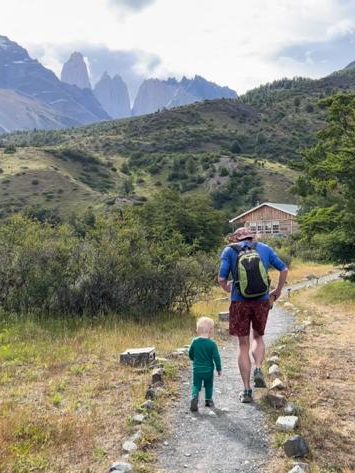
In summary: cotton keeps you cool in hot dry climates, most polyesters protect well from the sun, and lightweight wool does both extremely well!
Our son’s favorite wool is from Iksplor (affiliate link). Not only does it have a UPF rating of 50 and regulate his body temperature well, it’s incredibly comfortable and doesn’t get stinky! He’s worn these layers all over the desert and even abroad on the Tour du Mont Blanc and the W Trek in Chile.
Get a wide brimmed sun hat with a chin strap to ensure it always stays on their head! We do have sunglasses and use them from time to time, but we are still practicing with our little one…they are definitely valuable and worth using while walking on highly reflective sand and rocks. If your child walks, get them shoes. Sand gets incredibly hot and can seriously burn the skin of a barefoot child. We never thought it would happen, but we’ve become a Croc family. He just looks so stinking cute in ’em and they are perfect for the desert!
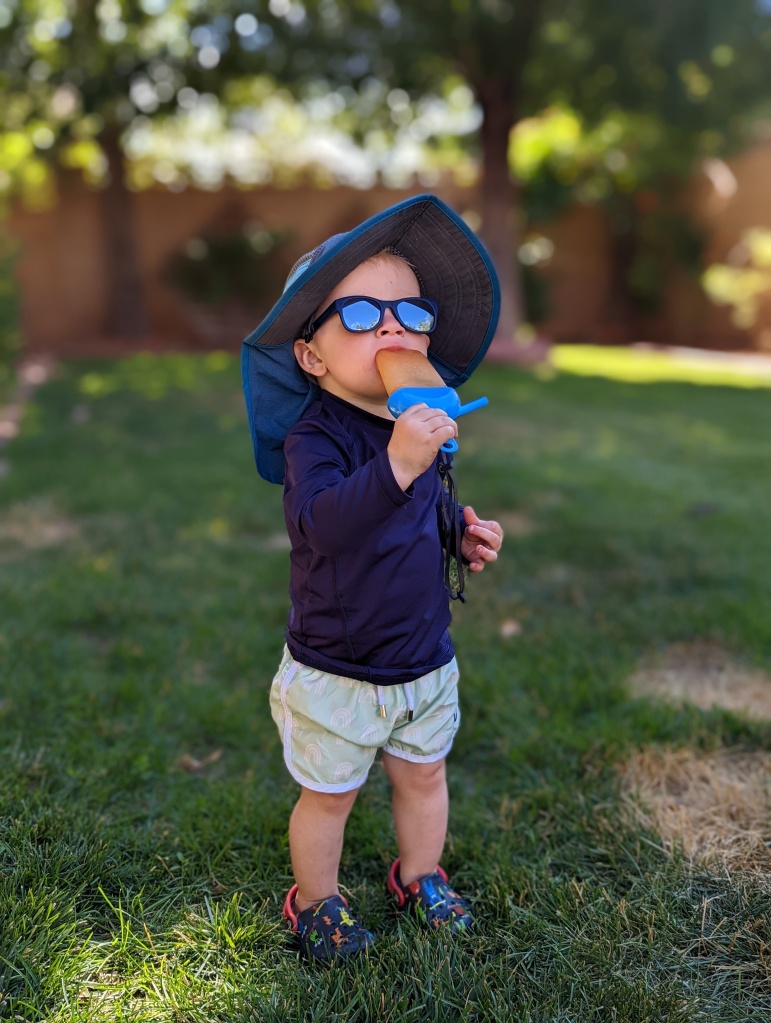
Carriers
If you’re using a soft side carrier, look for an all season carrier that has extra vents or mesh panels. If you’re using a structured carrier, find one with a sunshade.
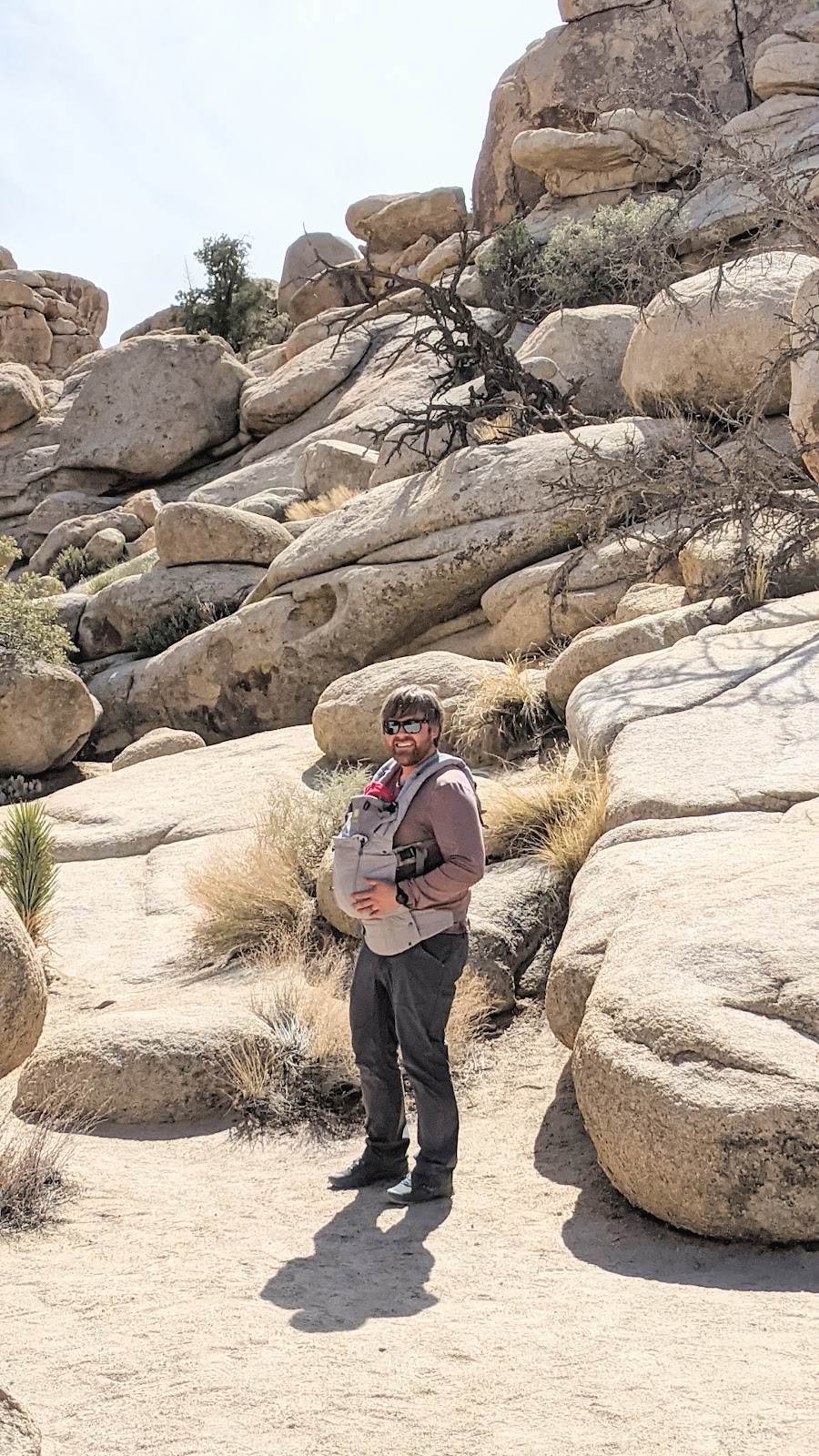
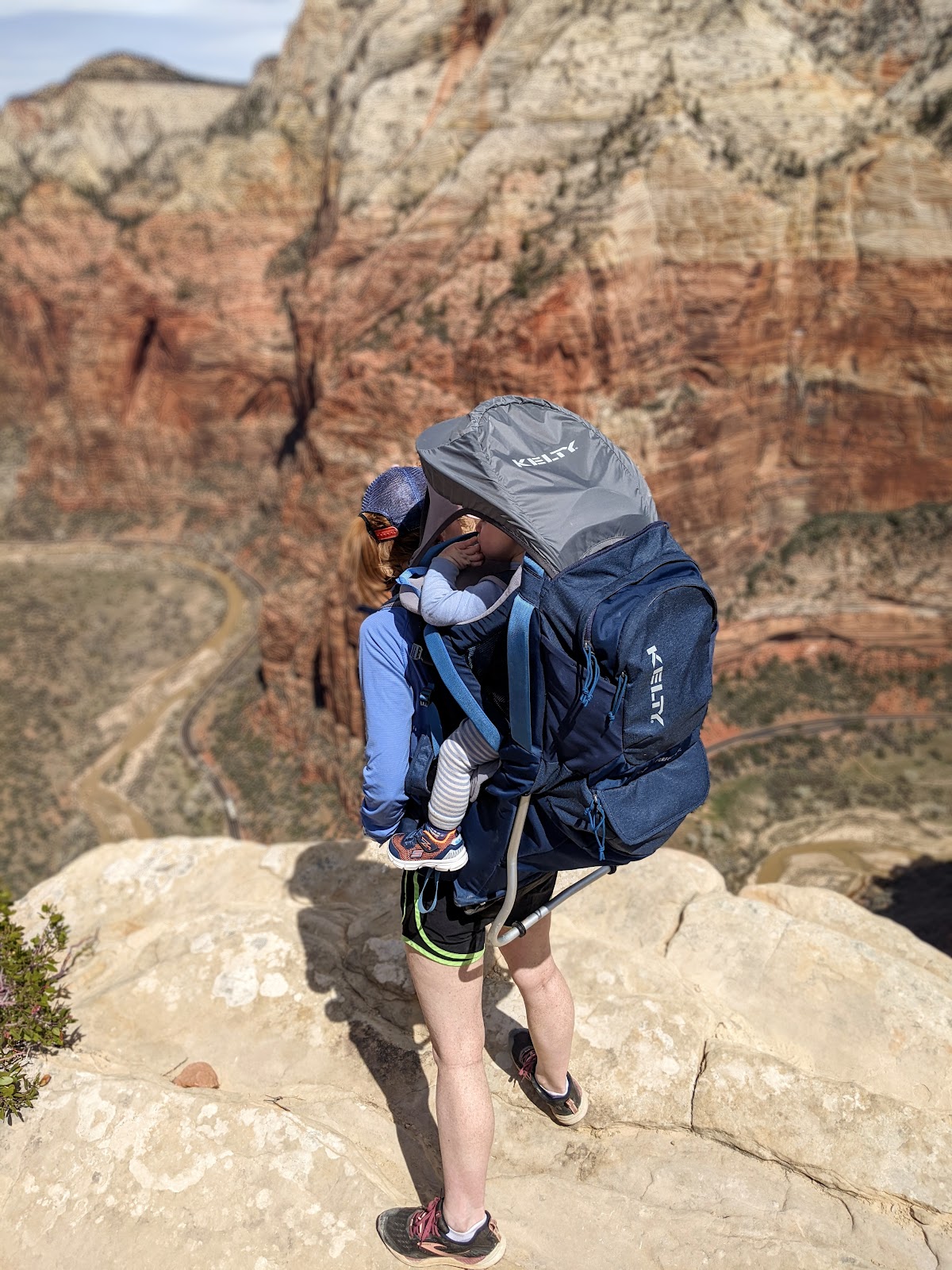
Shade
Sun Umbrella – We don’t use or have a sun umbrella, but many parents online swear by these. Give it a try and maybe you’ll become a fan too!
KidCo PeaPod Tent – We’ve only really used this when sitting on the beach along Lake Powell or the Colorado River or when backpacking.
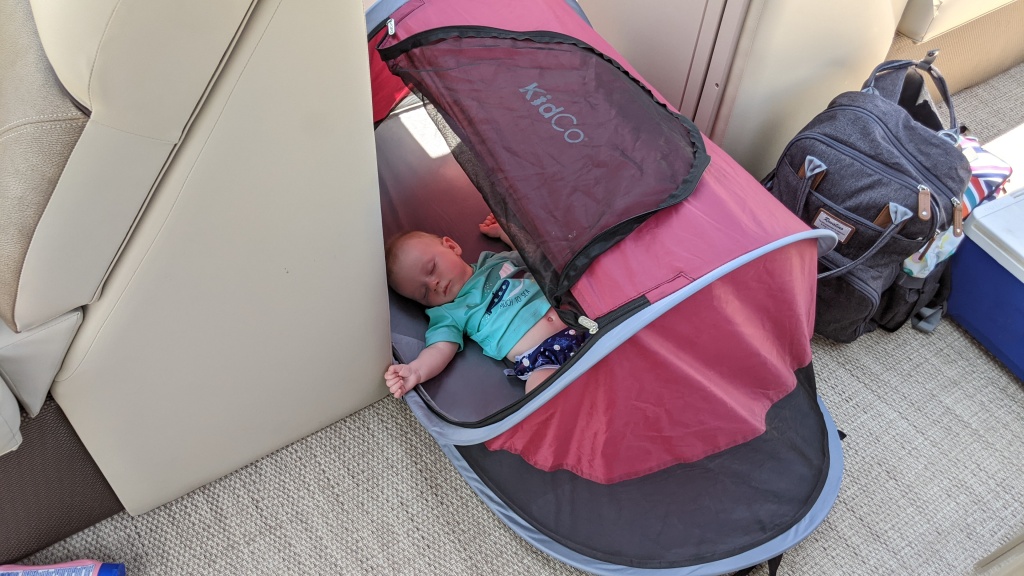
A note about the PeaPod and tents in general. During the day, tents easily become ovens. Do not think setting it up quickly will create a cool place to relax in and beat the heat. It just doesn’t work that way. Find some other shade that’s not enclosed and find the breeze. If your child must be in the tent or PeaPod, open all the flaps and create as much air flow as possible. Possibly also consider a fan. Finally, for the same reasons, do NOT cover a child in a stroller with a blanket to shield them from the sun. Again, this will turn the stroller into an oven and can be very dangerous.
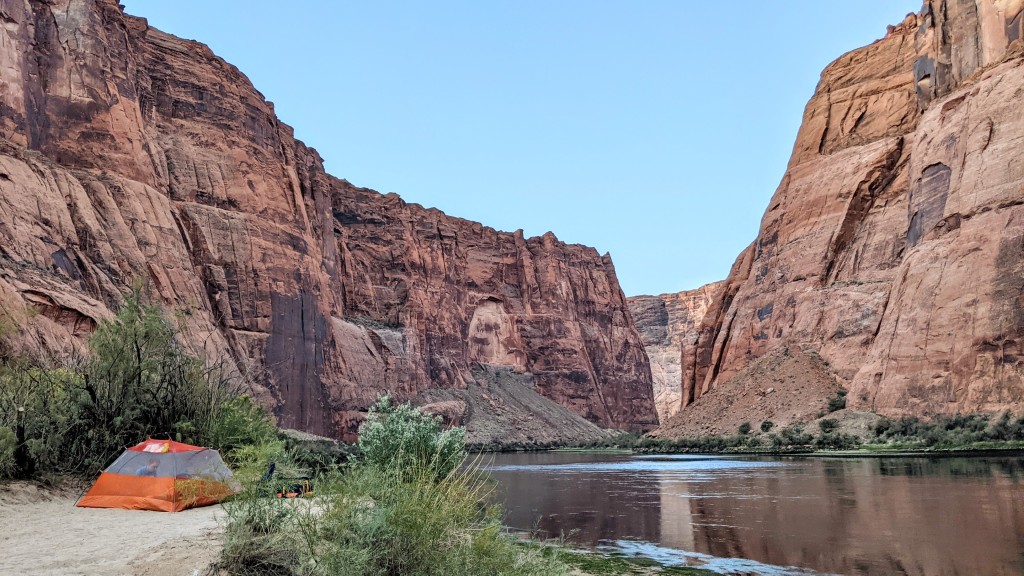
Extras
Sit Pad, Changing Pad, or Sleeping Pad – Sand is hot and babies need diaper changes. Be sure you have something to cover the ground for your child.
Good Lotion and Aquaphor for afterwards. Your child’s skin will dry out and may easily become irritated. Be sure to lotion multiple times a day and use ointment for rashes. Again, we love Tubby Todd’s lotions (affiliate link) for our son.
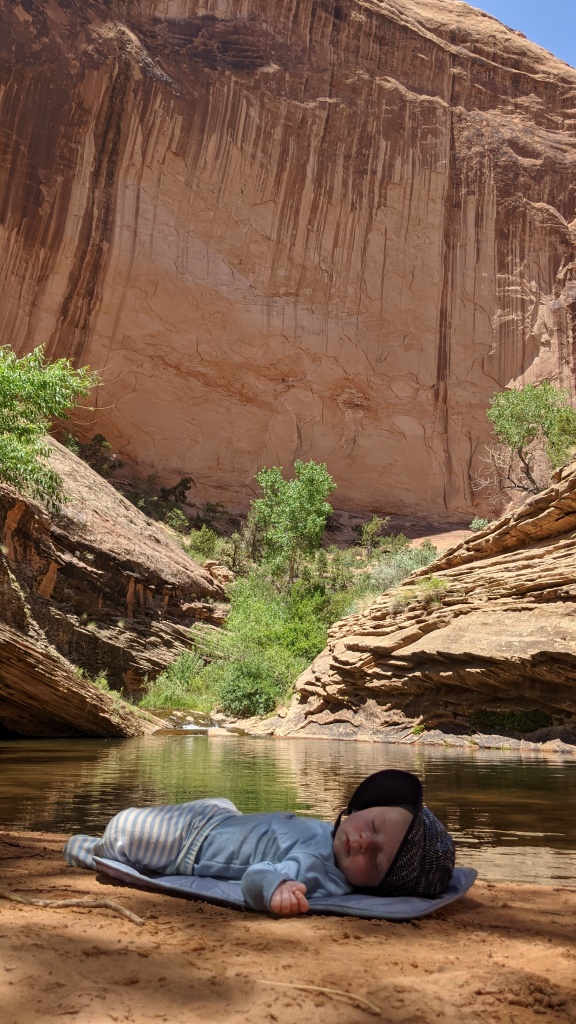
Cooling Towel‘s are great to help your child cool off quickly or stay cool if you’re hiking in areas with less shade.
Stroller Fan‘s are great for on the go. We don’t carry this when hiking backpacking but always have one handy for the car after a hot hike and in the stroller for more casual stroller friendly hikes.
Garmin InReach Mini – Ever since my parents and in-laws put their own minds at ease by getting us an emergency GPS, we have taken it on every single adventure. It’s just an extra bit of comfort knowing we can get help if need be, especially now with a small child in tow.
Other Desert Weather
When It’s Actually Cold
3 times to consider when temperatures will drop:
seasons
nights
canyons
Obviously, winter is cold. However, many people forget that the desert isn’t always hot. So far, this winter (’22-’23), my home has received maybe 6 or 7 inches of snow. It’s not a ton, but it’s still shocking to many.
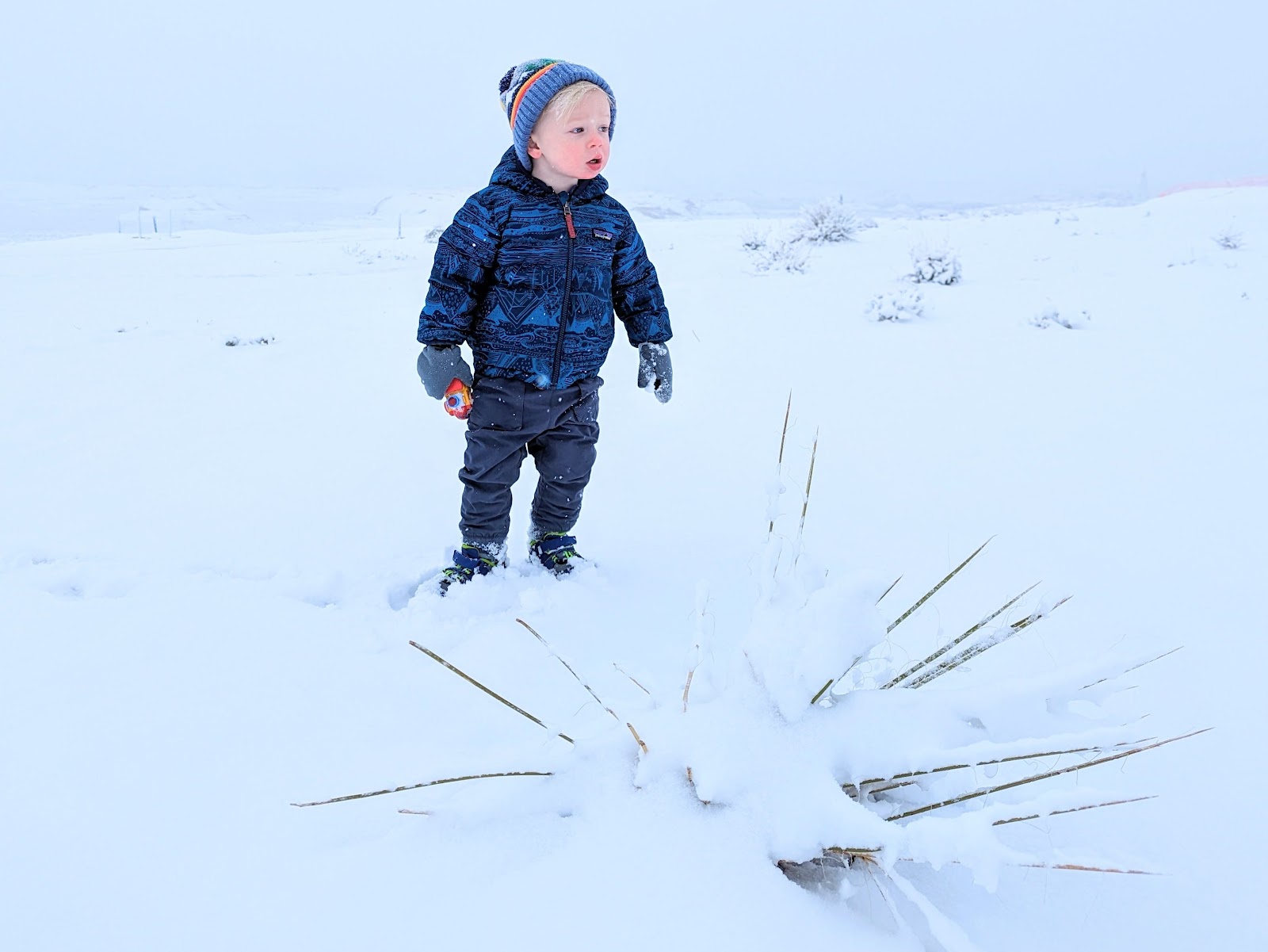
Our desert home this winter
For those spending a night out in the desert, know that sand and dry air do not retain heat well. Because of this, nights can get cool, even in the summer. Be sure to bring a good insulating sleeping pad and a couple layers to wear in the evening.
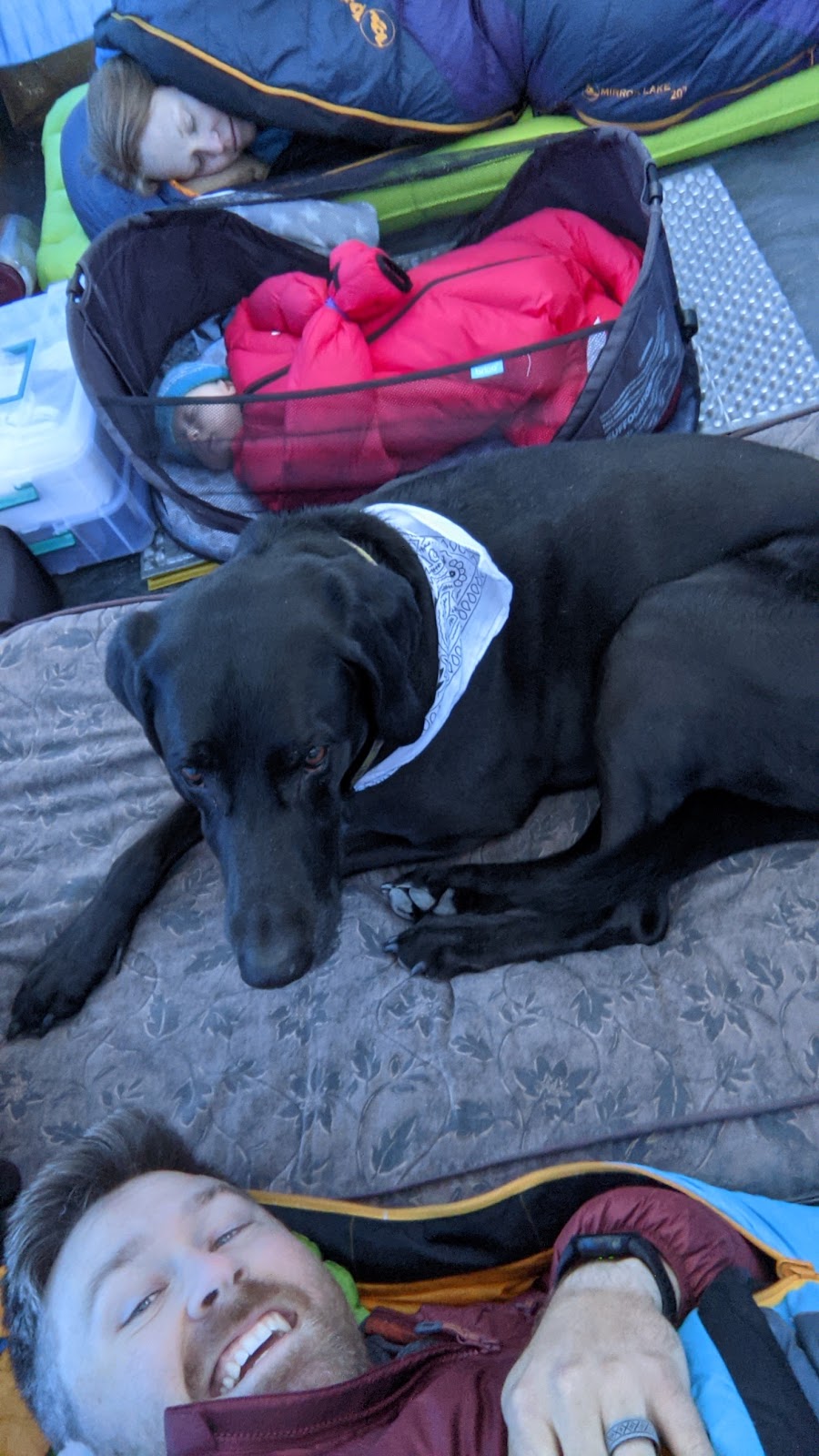
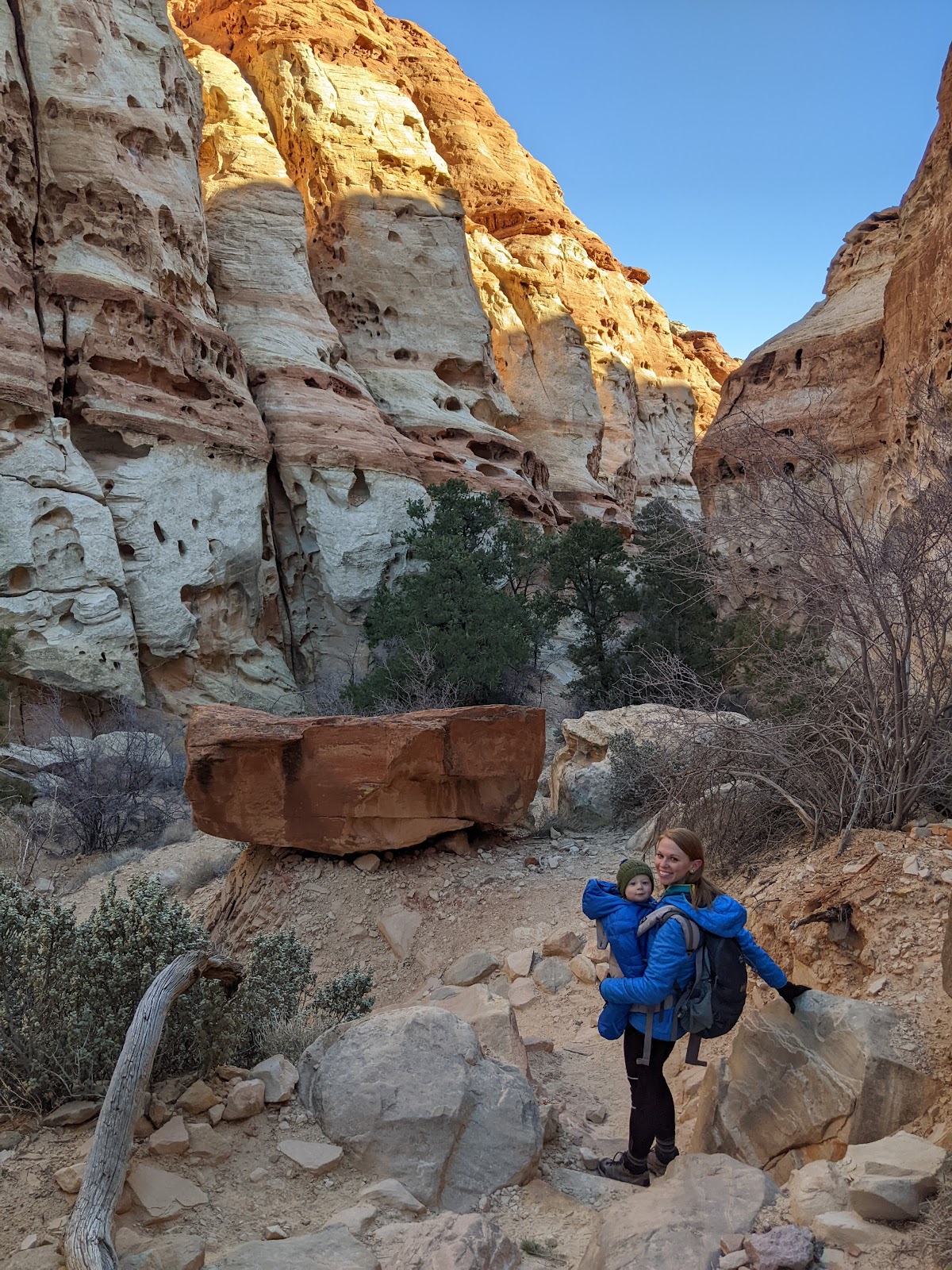
Finally, slot canyons are often way cooler than their surrounding areas. Because they receive less sunlight throughout the day, they become a bit of an oasis from the sweltering heat just above. Definitely consider bringing an extra light layer or wind breaker for your little one (and yourself) if you plan to play in the canyons!
Flash Floods
If you are entering a canyon, especially a slot canyon, pay close attention to the weather…but not necessarily where you are. Watch for rain up canyon from you. Rain many, many miles away can drain into your canyon and put you in danger of a flash flood. While in the canyon, pay close attention to the closest high grounds or places to exit the canyon. If you are not in a canyon but come upon a wash that is flashing, do not attempt to cross, either by foot or by car. Canyons and washes flash most often during the summer monsoon season, so always pay close attention to the weather, speak to rangers about current risks, and heed any warnings you receive.
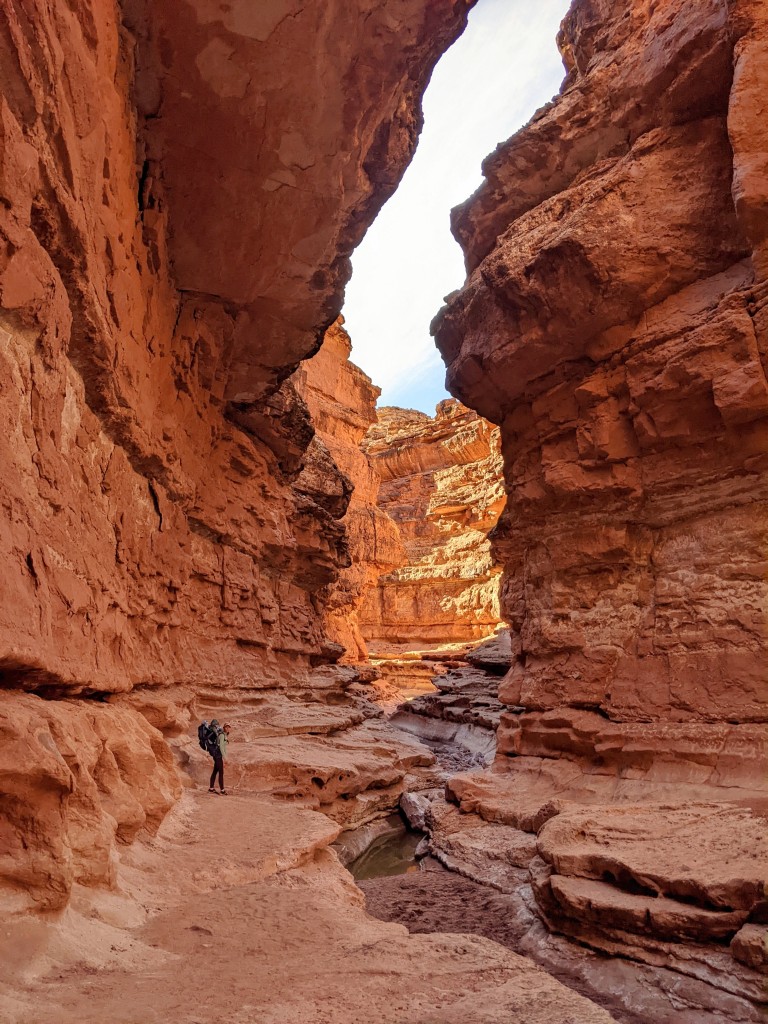
Wind
You don’t want your baby breathing in anything extra besides clean air. That being said, when it gets windy in the desert, sand and dust are picked up and tossed about. Besides breathing in these particles, you and your child can easily get sand in your eyes which can be very irritating. Also, during summer when forest fires in places like California are more prevalent, the smoke and ash are oftentimes brought all the way to the desert by the wind. If the air is too polluted by sand, dust, smoke, or ash, consider an indoor activity that day and hope the wind dies down tomorrow.
Visiting Rivers and Creeks
This is a FAQ description. Add more detail about this service, such as benefits, appearance, components and value
Exploring The beach
-All Kinds of Fun on the Beach
“If a child is to keep his inborn sense of wonder, he needs the companionship of at least one adult who can share it, rediscovering with him the joy, excitement and mystery of the world we live in.”
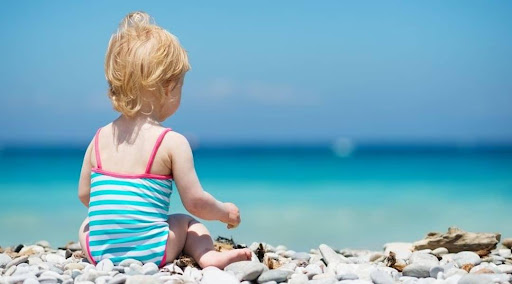
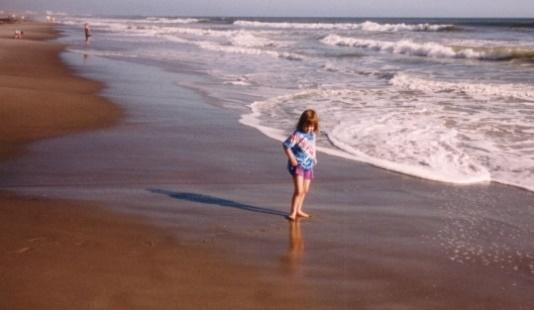
Blue water, sun, and sand are but a few of the interesting elements this theme will make sharing with babies and toddlers possible.
A beach is a magical place, especially to kids. The glorious sound of waves washing up and whooshing back, the feeling of sand squishing between toes, and sun-kissed skin after spending a day outside exploring are the simple yet beautiful things that can make for the sweetest childhood memories. That’s why I try to get my kids as young as babies to fall as madly in love with the beach as I am.
Before you even leave your house, it is wise to prepare for safety and fun. The more comfortable you and your child are, the more fun you’ll be able to have. If you have a sensory sensitive child, build a mini beach for them to get used to the elements. Then be sure to pack plenty of drinking water, snacks, and sunscreen as well as beach toys, towels, sunglasses, aloe, beach blankets, wide-brimmed hats, and tons of toys. Did we mention the toys? Buckets, shovels, sifters, and even blowing bubbles.
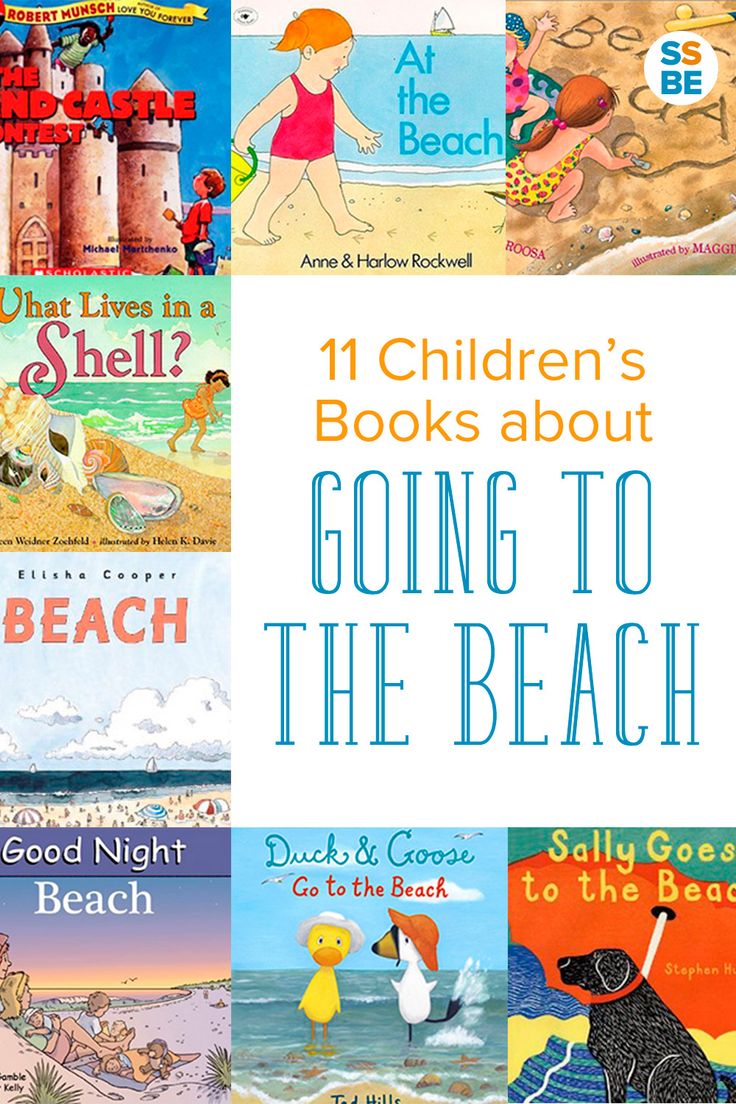
Children's Books About the Beach
These children's books about the beach are perfect to get kids excited about an upcoming visit, calm anxieties, and learn about our shores.
Explore the Seashore
Hope and Sarah always look for shells and sand crabs on the beach...It is often why many children beg to go to the beach.
Hope was four when we moved to Florida and it offered so many new ways to explore nature. We celebrated having new habitats to explore and have fun in.
However, we explored as she became fascinated in something new at the beach. And did what she became interested in what she saw other children doing. I packed options for what I thought she might like doing but the day unfolded at her pace and following her interests.
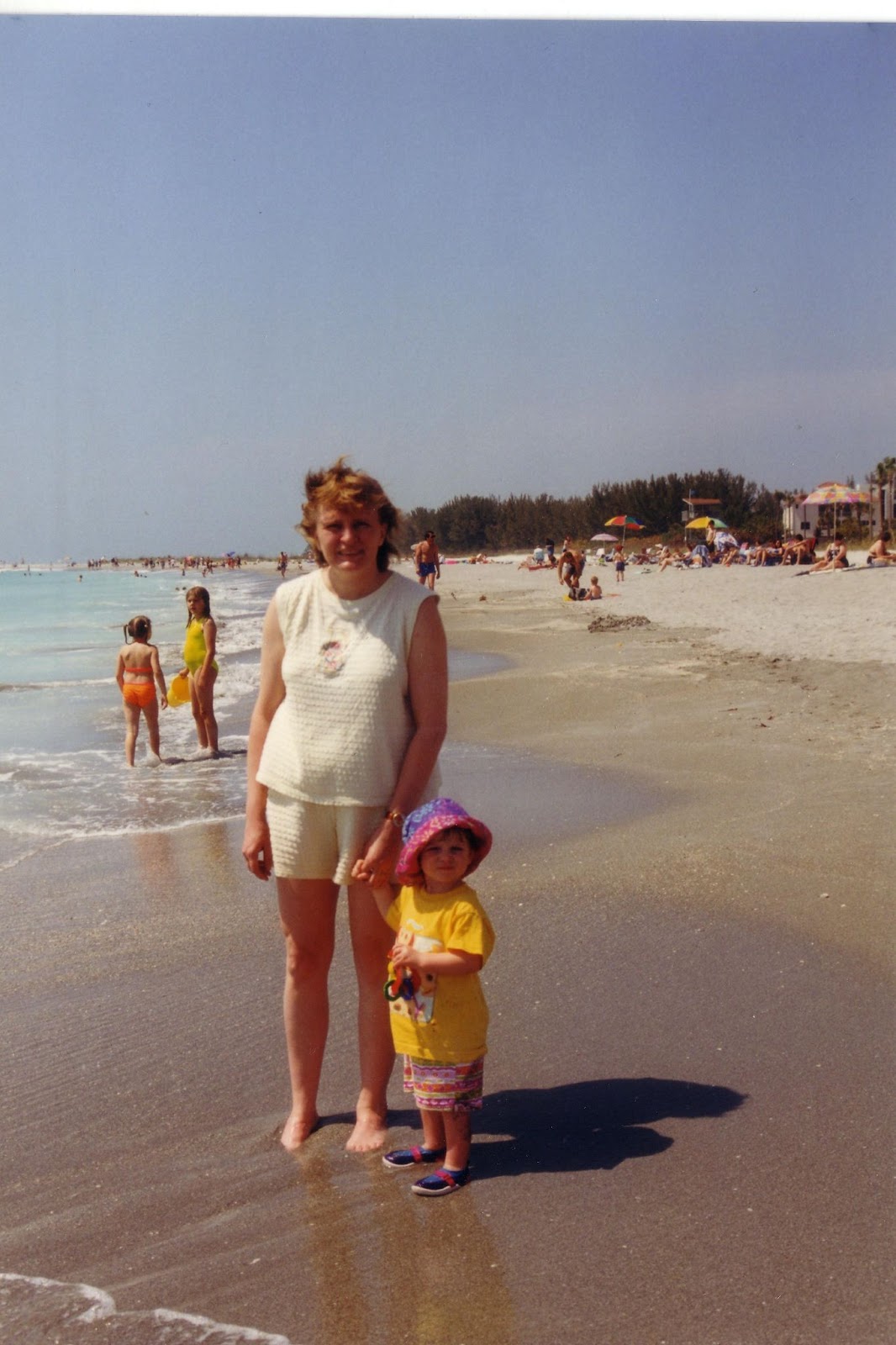
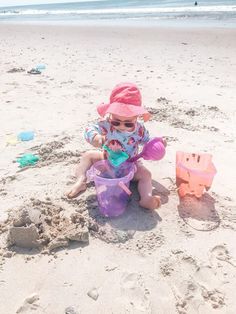
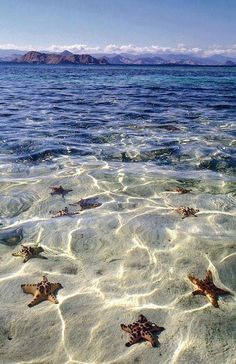
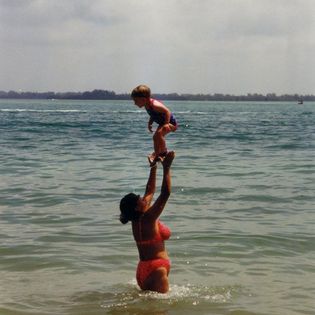
Shores are an important place for us as a family, and we feel fortunate that we explored so many of Americas eastern shores of them with our daughter.
The shore is endless family fun at your fingertips, and for those of us who don’t get to the beach but once a year, there’s so much exploring to do, that it’s nuts. The beach is an ideal place to really focus on raising curious kids–kids who observe, who question, who wonder, and who want to learn more.
The beach was so new to Hope at 2. Her only reference that she had about the beach was Disney movies- because we lived ib Denver.
So, I packed some things from home for exploring and playing in the new environment. I also wanted her feel free to collect some things that intrigued her at the beach in her bucket for her playtime explorations and art supplies at home.
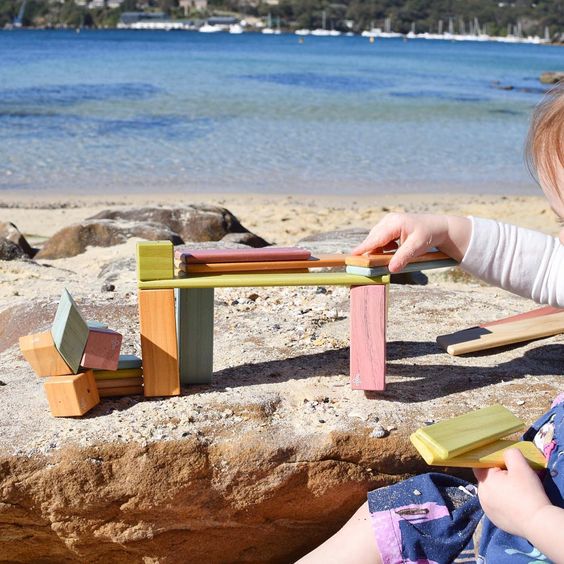
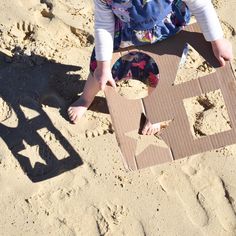
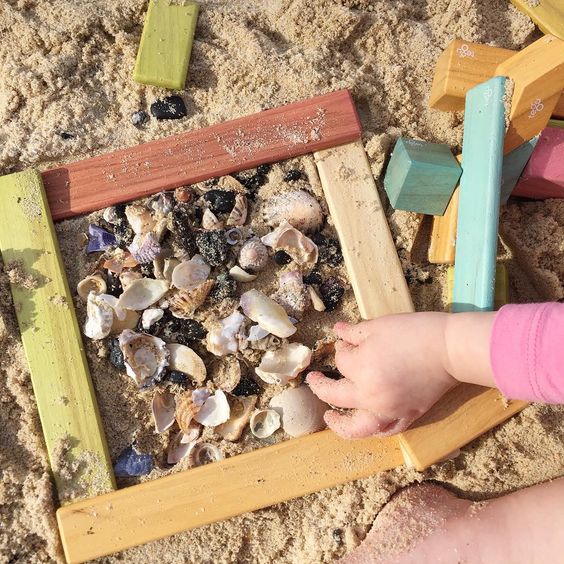
10 Steps To Beach Baby Bliss
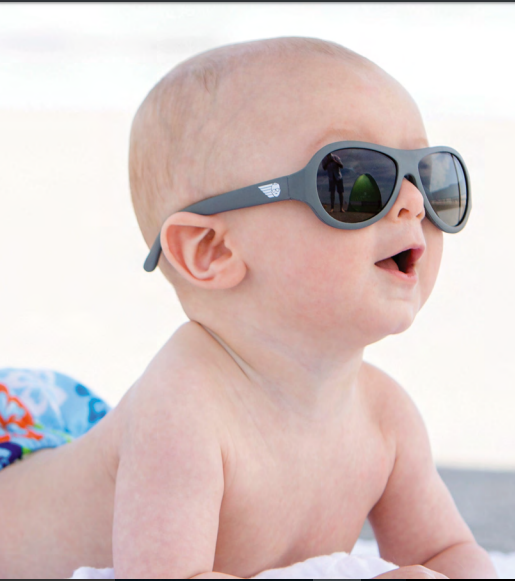
Seagulls, crabs, gentle lapping waves — there’s a lot going on at the beach to keep your baby entertained for hours. But what about sand, sun and big, scary waves? With a few precautions, a bit of know-how and some smart planning, heading to the beach is a fantastic way to bond with your baby.
After all, those gently lapping waves can remind them of being in the womb, so you may see your baby return to a state of fetal bliss. For a three-month-old, the perpetual motion machine of ocean waves is perhaps the only sight more entertaining than a ceiling fan. Plus, you’ll give them early exposure to nature, building an appreciation for being outdoors that can help them develop a healthy lifestyle as they mature.
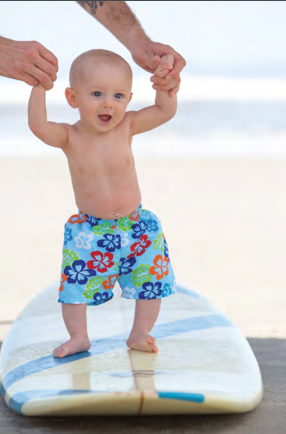
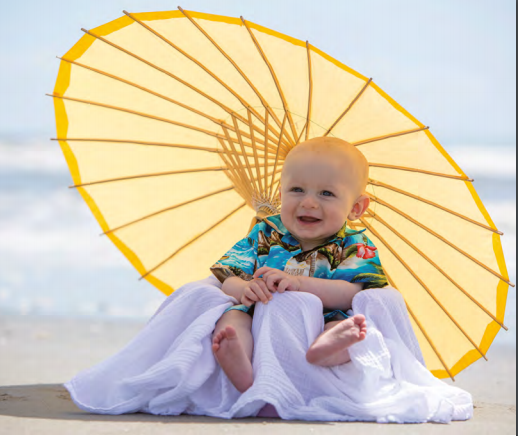
However, infants under six months old shouldn’t get direct sunlight or use sunscreen and sun exposure should be limited even with older babies. Sand is also a factor — it only takes sitting your baby down for five seconds and turning your head to spend the next quarter of an hour picking sand out of a screaming infant’s eyes and mouth.
Babies, Beaches, & Shorelines
So how do you ensure that family beach day is a pleasant experience that builds happy memories, rather than leading to a stressful “never again” drive home in traffic? We’ve got you covered with this handy 10-step guide.
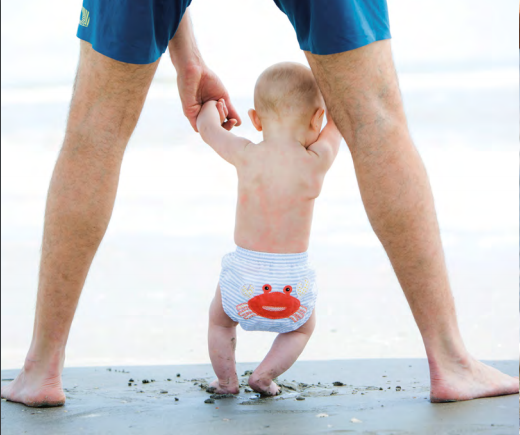
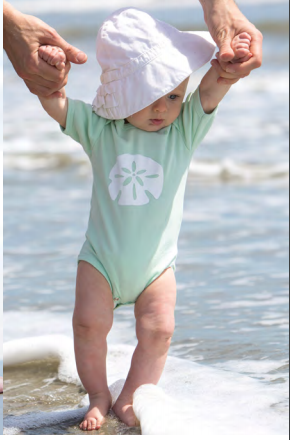
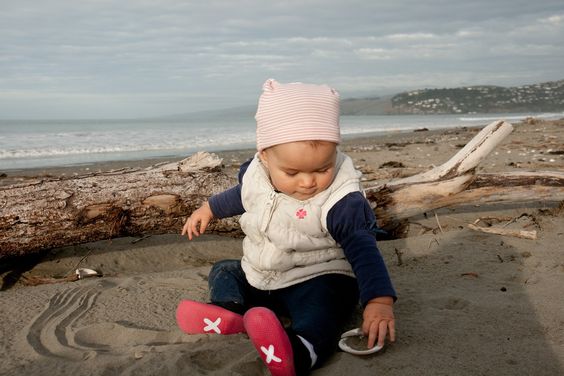
1. Schedule Your Fun
Although some parents of infants may still be able to wake up, make a leisurely brunch and ask, “Feel like going to the beach today?” we’ve yet to meet them. First, be willing to substitute the “beach day” of your past for “beach morning” or “beach evening.” Fortunately, this means you can get an early start and skip traffic going and coming. Likewise, it’s better to avoid the heat of the day with an infant in tow, so plan on heading back home or somewhere inside for lunch or waiting until late afternoon to head out to the beach.
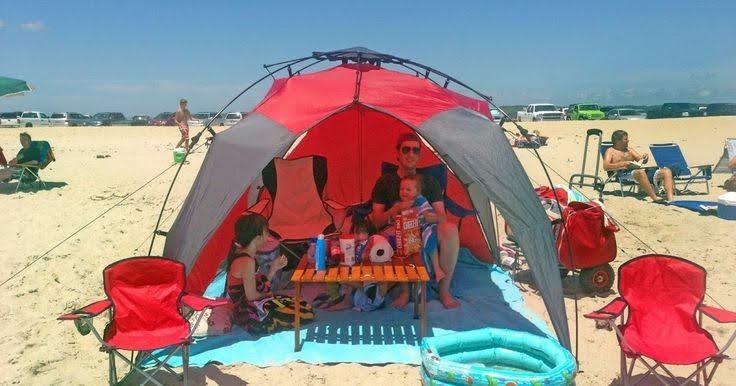
2. Create Shade
Even if you’re a lifelong sun worshipper, now that you’re a parent, it’s time to invest in a quality beach umbrella. The inexpensive ones at the grocery store are difficult to get into the sand and will likely blow away if it’s windy. Get a sturdy one, ideally made of canvas, or invest in a tent like pop-up shelter. When you get to the beach, set it up immediately. Put baby under it and make it their spot for the day. It’s your home base, but it’s their safety canopy.

Likewise, bring loose cotton clothes for your baby that cover their arms and legs, plus a wide brimmed hat, in case you decide to take a walk. You may not mind a little burn now and then, but it’s irresponsible to take that risk with a baby’s delicate skin.

3. Make a Play Pit
If your baby is old enough to play but not big enough to walk, make them a play pit by digging a shallow hole and putting a blanket over it. You’ll keep the sand off them while containing them. Obviously, build this in the shade of your umbrella.
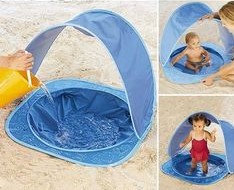
4. Pack ahead and Be Prepared
Just getting out the door as a new parent suddenly goes from “Wallet, keys, phone,” to “Diapers, wipes, bottles, pacifier, food, stroller, stroller adaptor, change of clothes … let’s just stay home.” See “Beach Baby Essentials” below for list of things you need.
5. Invest in a Beach Wagon
You’re no longer traveling light. Get a big-wheeled wagon so you can bring the kitchen sink without cursing in the process.
6. If You Have To, Pay to Park
Whether you must run back to the car or make a quick exit, it’s helpful to have your car close by. The days of driving around for 20 minutes searching for the perfect spot or parking five blocks away to save a few dollars are over. Maximize your enjoyment and park as close to where you’re setting up shop as possible.
7. Bring Adult Food
There’s a cardinal rule of parenting: Never wake a sleeping baby. Whether nap time has miraculously occurred on the beach or everyone is simply having fun, don’t let hunger cut your day unnecessarily short. While restaurants aren’t allowed to deliver onto the beach on the Isle of Palms and Sullivan’s Island, there are many within a short walk, so one of you can pop off to grab a bite to eat for the family, but packing a lunch is also a wise idea, especially if you are solo. If things are going well, that will let you stay put and enjoy it.
8. If You Stroll, Do It Right
Most strollers on the beach are a nightmare. Don’t be the parent that other people chuckle at as they schlep their kids through the sand on tiny wheels. However, a high-quality jogging stroller is worth its weight in gold on the beach. We run several miles a week pushing one through the sand — just keep to the hard-packed stuff and keep salt water off the wheels, or your next trip won’t be nearly as fun.

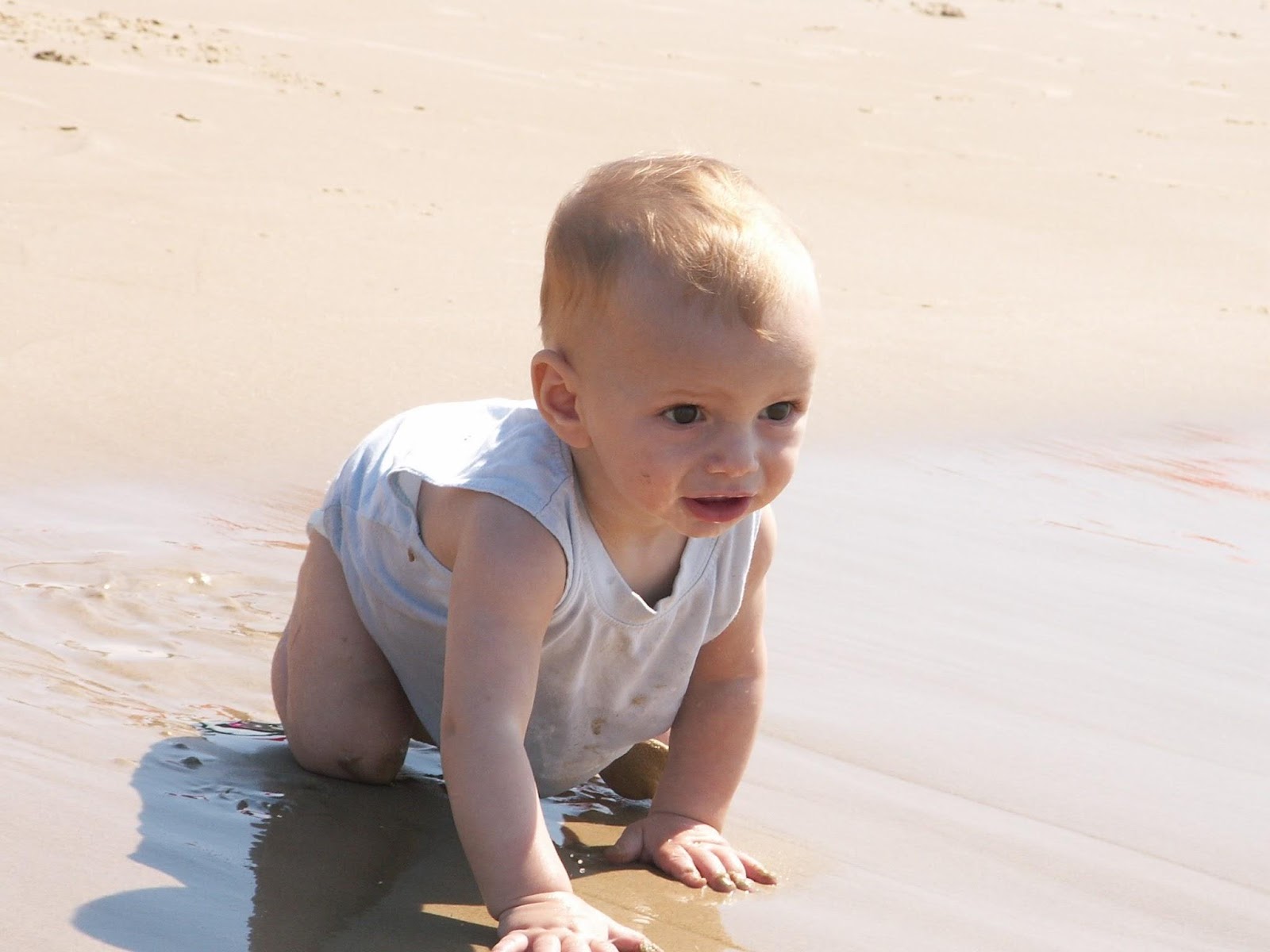
9. Introduce Salt Water, with Care
Forcing your baby to “enjoy” entering the ocean probably won’t instill a lifetime appreciation for the ocean. Let them learn to love the sea at their own pace. But wade — the salt and magnesium in ocean water can clear stuffy little noses.
10. Adjust Your Beach Day Expectations

You probably won’t get through several chapters of your Dorothea Benton Frank novel when bringing your baby to the beach. But you will get a chance to see their wonder as they experience new things. Make this about them. And “this” may be an hour instead of a day. Plan be flexible with it and enjoy the magic of your baby’s trip to the beach.
Introduce your baby to the ocean/salt water:
To introduce a baby to the beach and ocean, start by choosing a calm, shallow area, let them dip their toes in the water gradually, and provide plenty of shade and protection from the sun; ensure they are wearing appropriate clothing and a hat, and always supervise them closely, especially near the water; consider bringing baby beach toys to help them get comfortable with the environment.
Dip their toes in the water coming ashore so they get comfortable. But know that not all babies are ocean lovers.
Take turns getting in shallow water with your little one to help them enjoy the waves
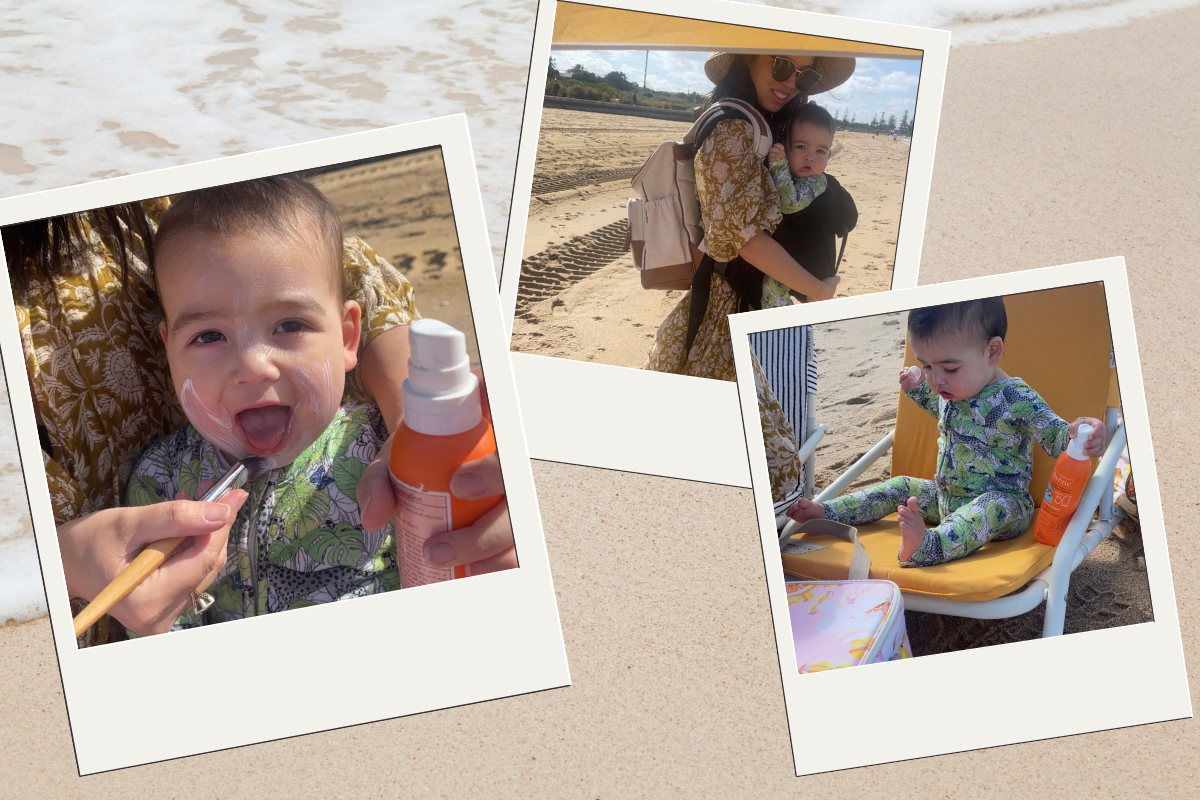
Things just got a little more complicated. And when you think of the beach, you can't help but wonder," how long can babies be in the sun?" and "at what age is it safe to take a baby to the beach?"
The best way to triumph over a beach day with your baby is always to come prepared; therefore, if you are thinking of hitting the beach with your baby. We've got you!
Find some great tips for taking your baby to the beach.
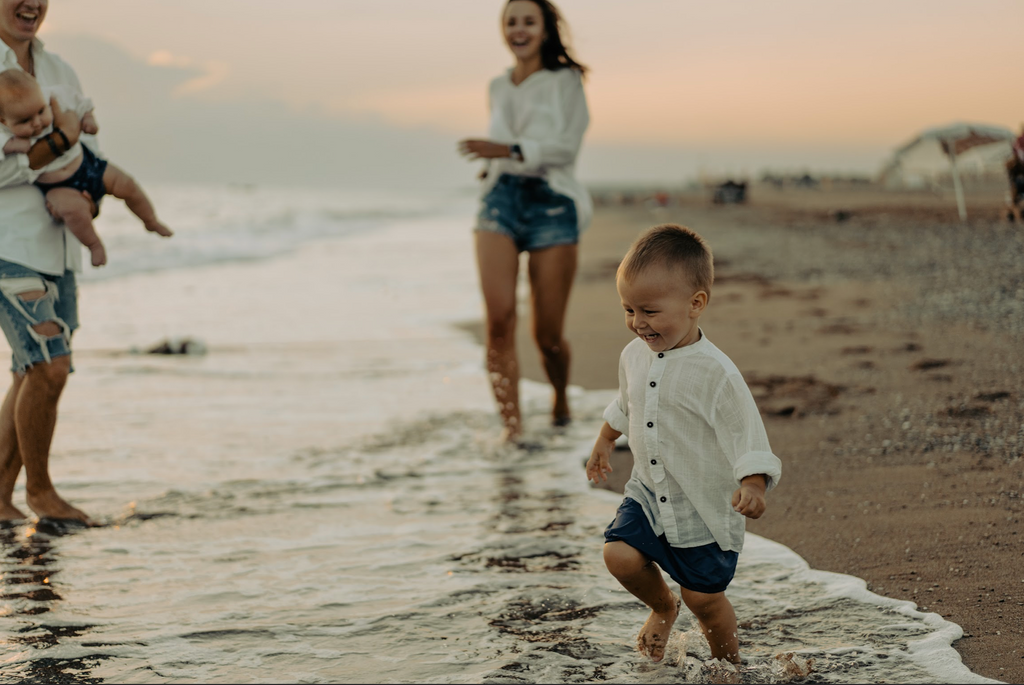
Image source: Depositphotos
What To Consider Before Going To The Beach
What age is appropriate?
What Time Of Day Is Best?
How Long Should You Stay At The Beach?
What should we bring for a comfortable safe beach day?
Children and the seaside go together like fish and chips. But how do you go about taking the baby to the beach safely?
With a little preparation, baby beach accessories, and forethought, it is possible to enjoy your baby's first beach trip.
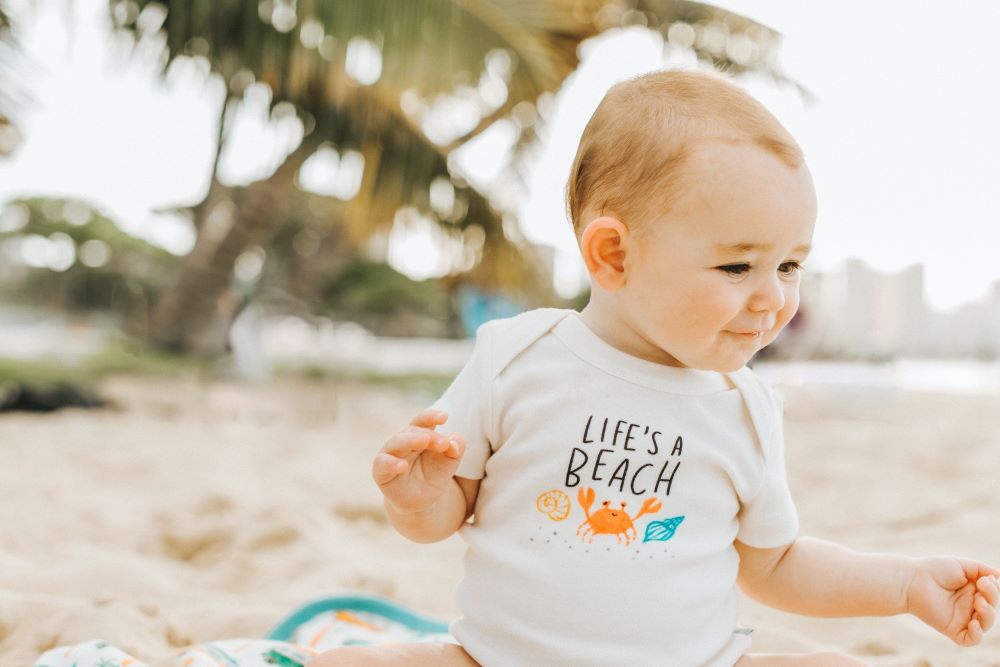
What age is appropriate?
You'll want to consider your baby's age in relation to water safety and the amount of time you will spend in the sun. Do not forget to spot out shade where you can escape the sun's glaring rays if your beach baby gets overheated.
Your baby can lose heat rapidly, nearly four times faster than you. Wait until your baby hits the two-month-old mark before going to the beach on a day that is too warm. Also, when your little one is too small, his skin is extremely delicate and still forms melanin.
In regards to hitting the waves. It is not recommended for your little one to go into the ocean until they are at least one year old, as your baby is more likely to become dehydrated, cold in the water (yes even in warm weather!) and sunburnt, among other things.

What Time Of Day Is Best?
Typically the hottest and warmest part of the day is from 11 am- 3 pm. And this is also the time your newborn at the beach is likely to overheat. Your baby's skin is far more susceptible to the effects of UV rays than you. So avoid the middle of the day.
It's best to avoid direct sun rays on your baby's skin rather than using baby sunscreen until your baby hits the six months mark. Therefore, the best time of the day is first thing in the morning ( but remember to check temperature), or head there post-nap for late afternoon seaside bonding when the sun is setting.
The point is to avoid spending a huge chunk of time at the beach when the UV rays from the sun are strongest.
How Long Should You Stay At The Beach?
When you decide to have a baby beach day, we suggest going with baby steps. Remember that your baby can not spend a full 8-hour day in the sun because of their delicate skin and the risk of overheating.
That said, you should base how long you stay at the beach on the day's weather conditions. If it is very hot, your aim should be a short morning or evening session for your baby. From the short spans, you can gradually build up. The last thing we want is a grumpy baby.
It's not just over heating you should think about. Remember to check that your baby does not get too cold in the water. Therefore be aware of the water temperature before getting your baby in for a few minutes. While submerging your little one, you should start with the tiny toes as you allow them to get used to the feeling.
Discovery Walks For Ponds
Pond Discovery Walk Trip
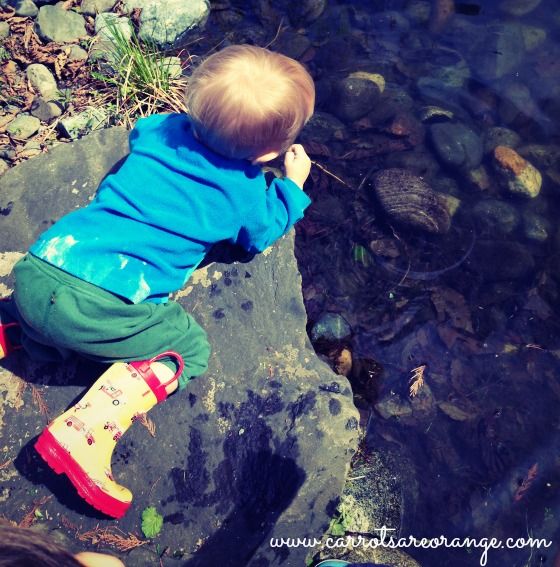
Some of our very best mornings have started with a walk to the pond.
When we lived in Mississippi there was a pond in our neighborhood and it was a frequent destination for a field trip during the week.

These walks took many forms. We would take our time. I followed their lead.
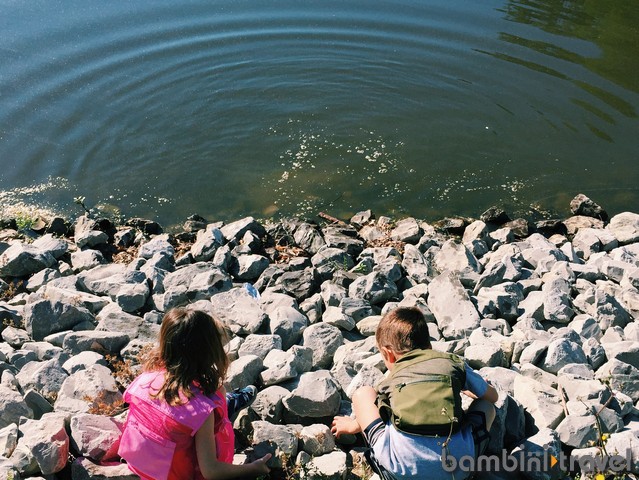
Sometimes they were interested in gross motor and we chase each other.
Sometimes they are interested in the trees or flowers so we study those.
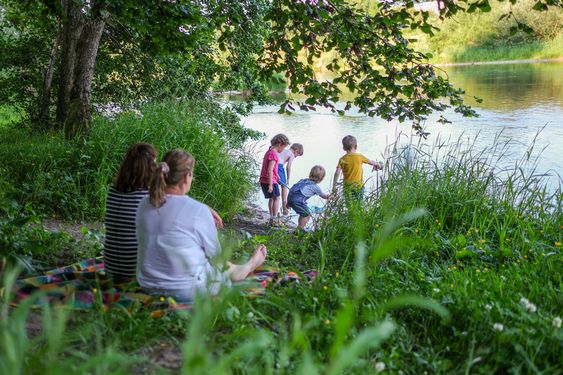
Sometimes they are lost in their imaginations and they pretend to be characters and the small pond and island become their setting.

Regardless these field trips to the pond always abounded with learning opportunities.
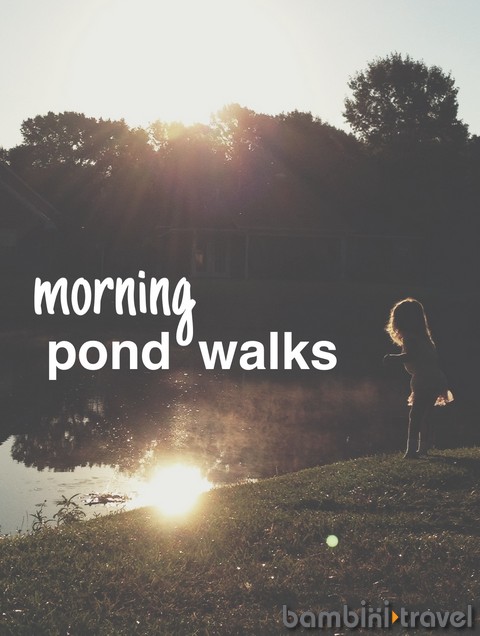
Day Trip to a Pond
Before the Trip
Often my kids were interested in the ducks, geese, and other bird life at our pond. When I noticed a particular interest, such as the birds, I would make a point of planning a book and discussion before our walk.
We had observed the birds several times when I pulled out this book to share.
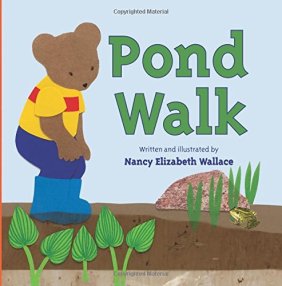
Pond Walk by Elizabeth Wallace
Before we went, we read POND WALK by Elizabeth Wallace. In the book the bear really want to see a turtle and I like how the messages of taking your time, noticing details, and being patient are described throughout the book.
During the Trip
After reading the book, our kids grabbed their bug kits and their journals, put on boots, and we headed to the pond.
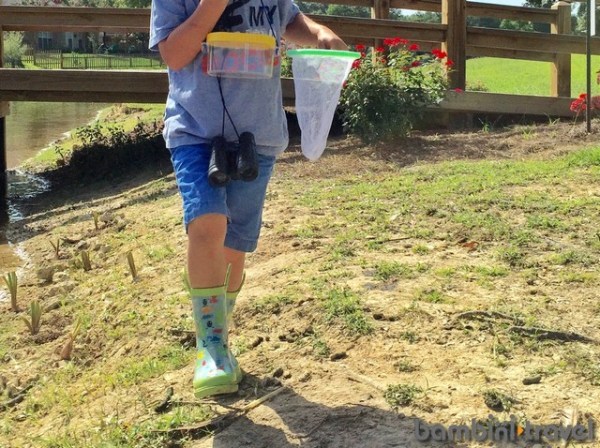
We watched the geese…and they watched us. There was a particular interest in the geese’s feet that were made more visible through the binoculars.
You May Also Like: Spider Web Hunt with FREE Printables
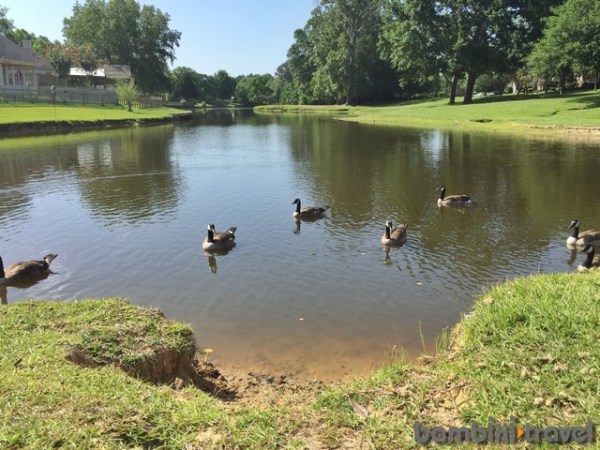
We tried to catch bugs but they are quick. At least the moths that my son really wants to get a good look at.
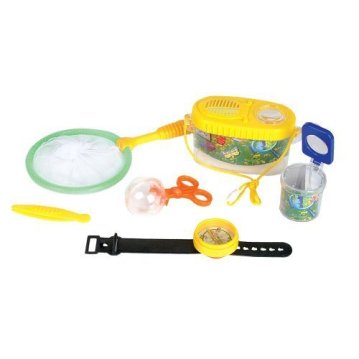
We got these Adventure Kids Bug Catcher Kits from a friend and they are a huge hit! I must admit I am a little skiddish around bugs and would not have taken them down this path on my own, but the kits sent them off chasing for bugs and especially our son is hooked. If you don’t mind a good view of a squirming insect, the magnification on the bug jars does a good job of getting you a little closer.
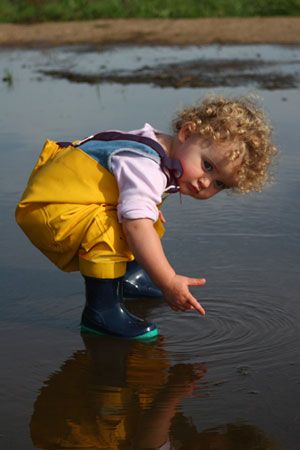
Whatever they end up exploring, they always hate to leave and they always come home brimming with ideas. All we did was walk to the pond and their world comes alive with new possibilities and wonders.
Good things to know about pond safety
Establish rules ahead of time, establish consequences and follow through. I don’t mess around with safety – especially water safety and my kids know that. I’m also not concerned with them getting a little dirty – they know that too.
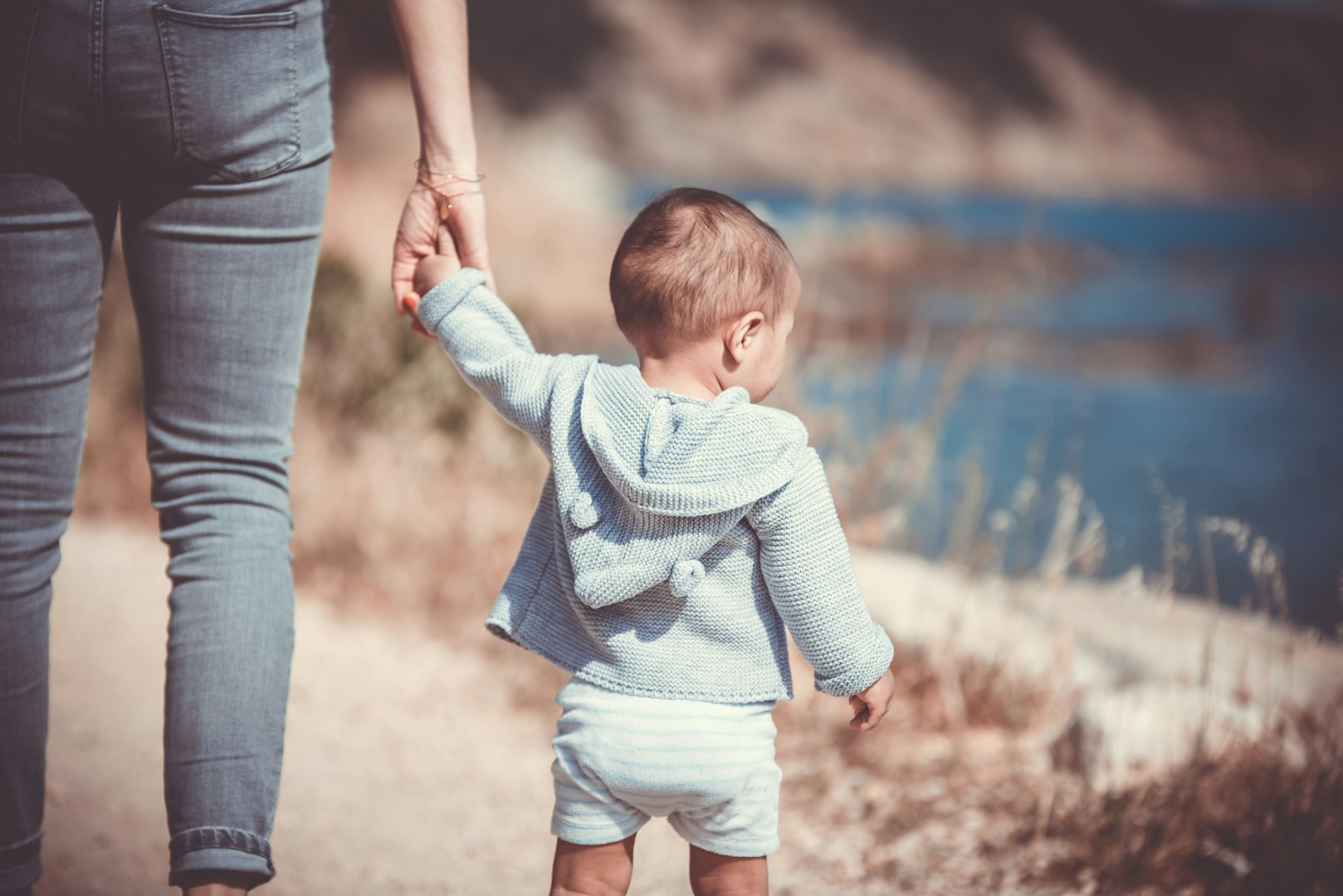
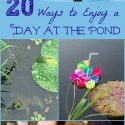
Science & Water Activities for a Day at the Pond
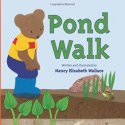
Pond Walk Field Trip – Bambini Travel
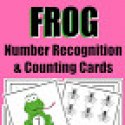
Frog Lunch {FREE} Number Recognition & Counting

All About Ponds | A Unit Study Resource Round Up
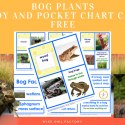
Bog Study Matching Cards and Vocabulary Free PDF
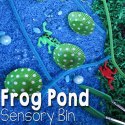
Frog & Pond Habitat Sensory Bin
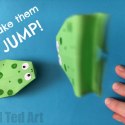
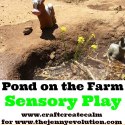
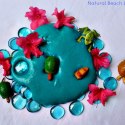
Easy Pond Inspired Homemade Slime Recipe

Simple Pond Small World Sensory Play
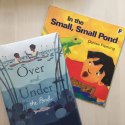
In the Small Pond Storytime - My Storytime Corner
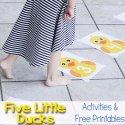
Five Little Ducks on the Pond Gross Motor Activity
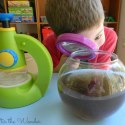
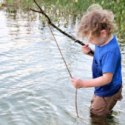
Exploring the Pond: Simple Activities
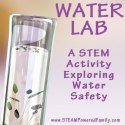
Water Lab - A STEM Experiment Exploring Safe Drink
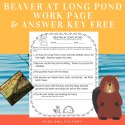
Free Printables for Beaver at Long Pond Book
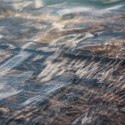
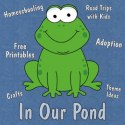
Baby and children are incredible and so in tune with their instincts. They know exactly what they need to do to learn a new “milestone” or practice an existing one.
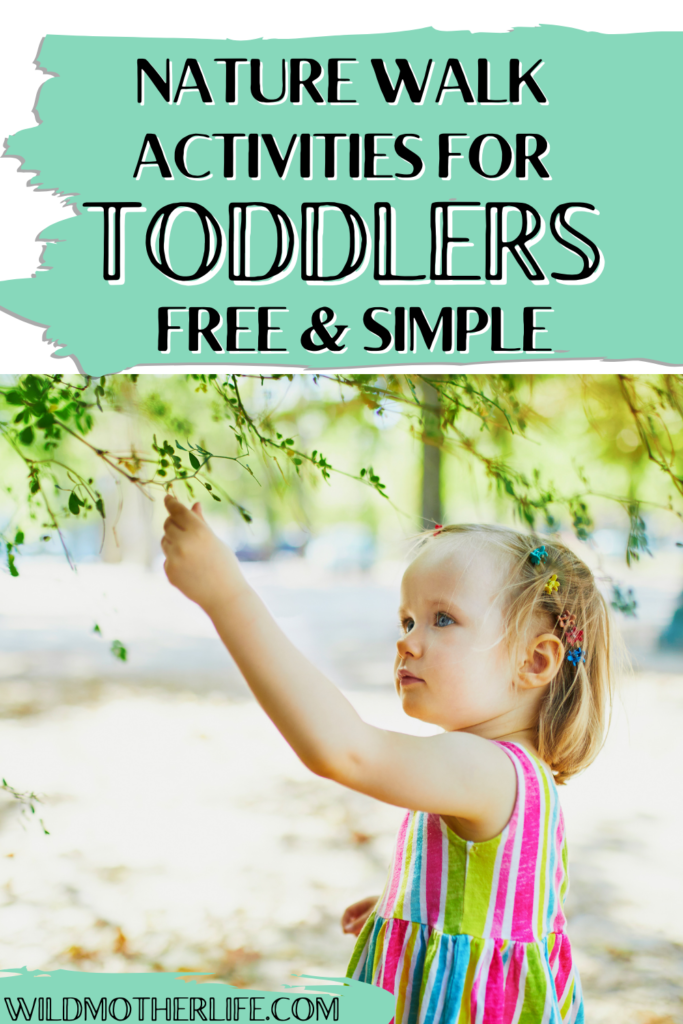
It’s simply our job as the parent to provide an intentional environment in which they can thrive and learn.
I’ve come up with a list of ten different ways to encourage your young toddler to play and learn in nature.
These ways are not invasive or too pushy. They’re natural.
And remember, there are no rights or wrongs when it comes to child play.
Maybe instead of putting pinecones in a basket, your baby decides to take all the pinecones OUT of the basket. Or maybe they just want to STEP on all the pinecones instead.
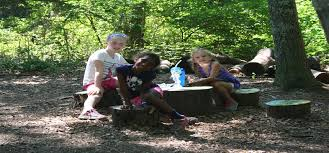
Don’t intervene. Just observe. Just watch. See how much they’re learning when they are focused – even if what they’re doing seems silly to you.
Don’t say “oh no, baby, do it THIS way.”
Provide the environment. Provide the tools. And just observe and let them learn.
Okay, so with that in mind, here are ten gentle, non invasive, nature walk activities for toddlers to explore nature.
Nature Walk Activities
Shorline Discovery Walk
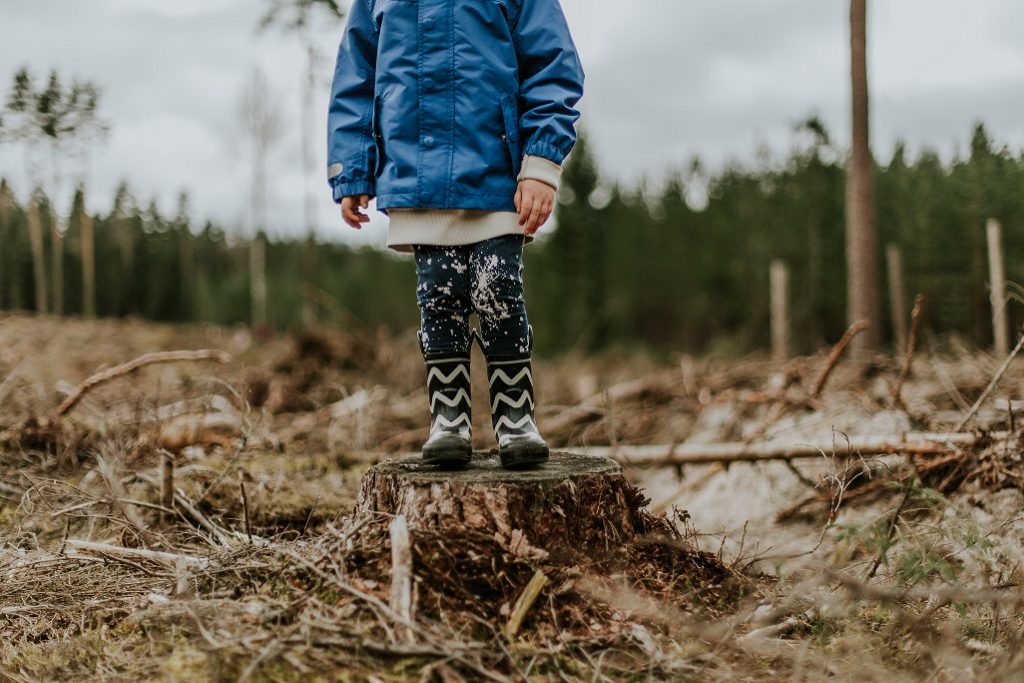
Some babies and toddlers favorite reason to go exploring is to play in the rain! I love a good summer rainshower – the weather is warm outside but the rain is cool.
My daughter absolutely loves walking around in the rain.
Since she is so little, we don’t have any specific rain gear we use, but as she gets older I’m sure we will get some rain boots and a raincoat.
But for now, she just walks around getting soaked and that means I follow her around, also getting soaked! It takes some dedication as a parent – to be willing to get soaked and have to give baths and change clothes when it’s over.
But it’s worth it! I feel so carefree in the rain. And little toddlers love it. It’s good for their skin to experience the sensory feeling of the water droplets falling on it.
So next time it rains, consider having a rain party outside. Dance. Spin. Watch the raindrops collecting on the leaves. See if you can find a frog.
Your little one is sure to love it!
Collect acorns or nuts under a tree
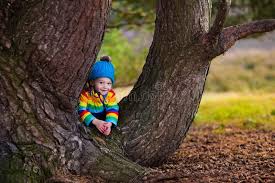
Since young toddlers are still working on perfecting their pincer grasp, this is a really natural way to help them practice.
My baby will automatically start collecting little rocks, berries, and nuts she finds on the ground, so I’ve found that I don’t even have to encourage or push her to pick up the acorns.
Remember what we talked about in the beginning of this article?
Children are incredible little beings who love to learn and will automatically practice the skills they need to learn if they’re provided the right environment. It’s our job to provide that environment.
So in this case, taking my daughter to a giant oak tree and letting her play under it IS providing the right environment for her to flourish based off of her own instincts.
Splash in a puddle and sit in the mud
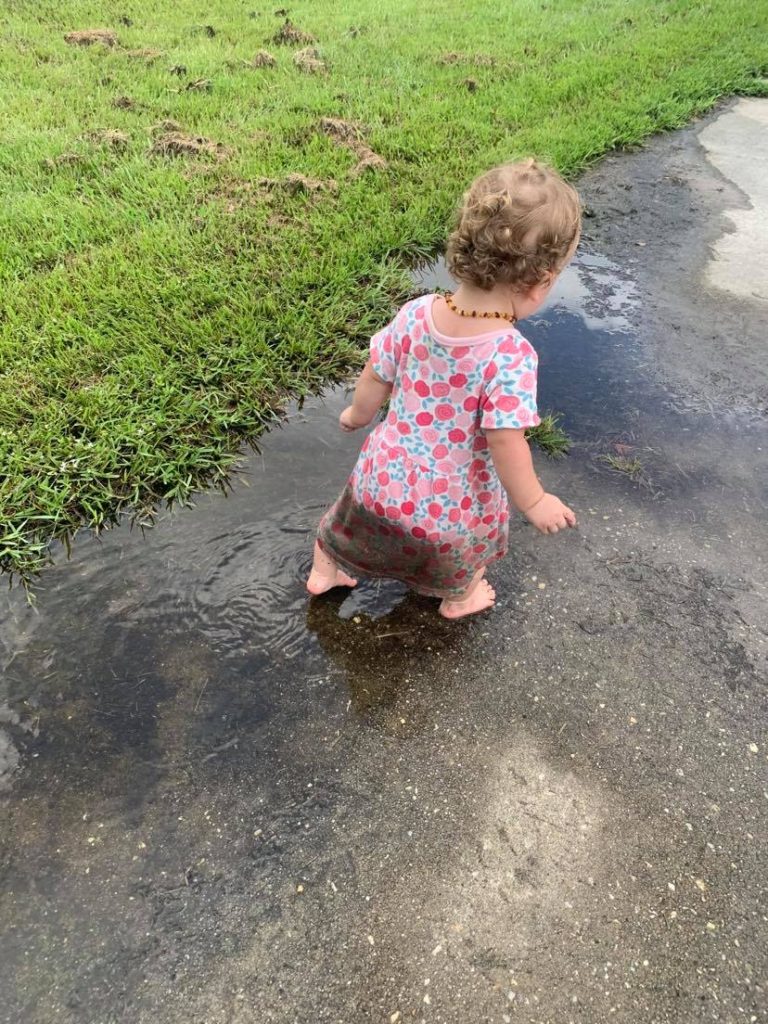
There is a certain window of time in childhood where children love to jump in puddles. And I think it’s the sweetest thing.
As young toddlers or older babies who have just learned to walk, don’t be surprised if your little one squats or sits right down in the puddle!
We have this certain spot on our driveway where rainwater always collects and makes the best puddle for my daughter to splash in. More often than not, she plops right down in the muddiest part and splashes water everywhere with her hands.
She gets muddy and wet, but after she’s done playing it’s a simple bath and change of clothes and it’s all better.
Pick up rocks and throw them in a creek or pond
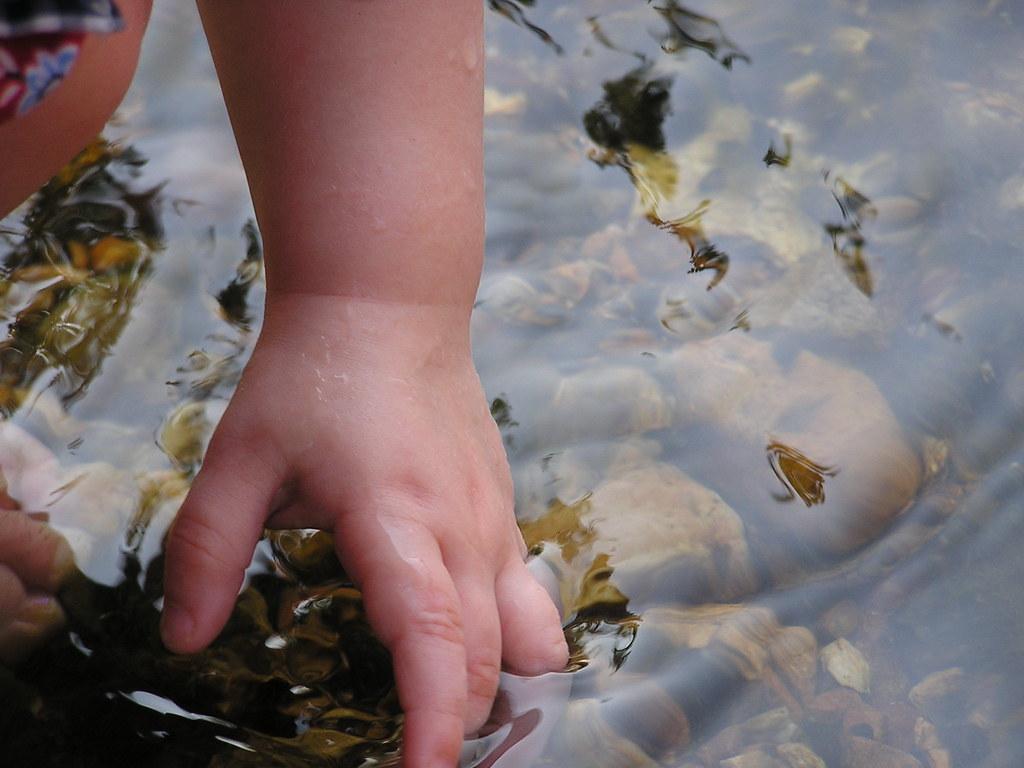
Another fun idea for a nature walk activities for toddlers is to throw rocks in a pond. Toddlers love collecting rocks! A fun environment to do this could be next to a pond, where they can also choose to throw the rocks into the water and watch the SPLASH! Or watch how the water makes rings from where the rock entered. Or they may just want to collect the rocks.
Speaking of ponds, while you’re there…
Walk around a pond with ducks and geese
Ducks and Geese are such interesting birds, and babies think so too! Spend some time observing them and talking to your little one about what they’re doing.
Plus taking a walk around a pond or lake is so fun and allows toddlers to have lots of chance to explore different environments and look at different plants and bugs.
Gather natures treasures in a basket
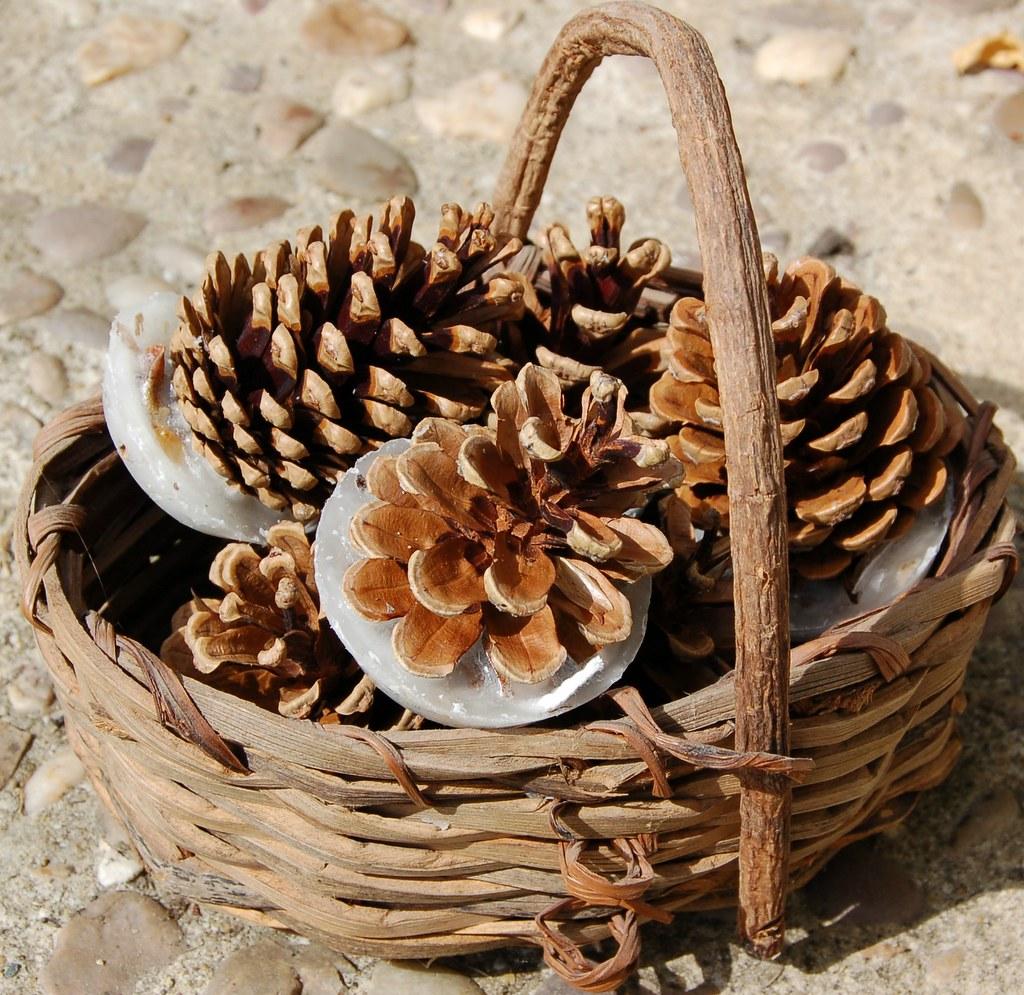
We have a lot of pine trees where I live, so it’s the perfect environment to encourage pinecone gathering!
You could set out a basket and collect some yourself for decorations, and your toddler will probably start copying you and doing the same.
Pine Cones are especially interesting for little ones to handle because of their texture- they’re firm, some varieties are pokey (be careful!), and they’re the perfect shape to hold in your hand.
If you are collecting an especially sharp variety, you may want to have your little one wear gloves, or just show them the thorns and talk about how to handle them gently so you don’t get poked!
Watch butterflies flying around a bush
It can be hard to spot butterflies, but if you have a flowering bush, odds are that a butterfly will come by to visit!
Babies and toddlers love looking at the butterflies and watching them as they fly away! Maybe you could even get a kid’s butterfly book from the library and then go outside and try to find one.
Butterflies love getting nectar from flowers, so check all your flowering plants for a little colorful friend!
Interact with new animals
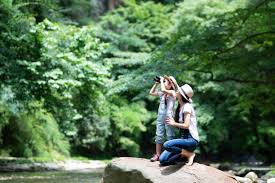
Find a family with a small backyard farm and see if you can come visit their home and pet their animals.
We house-sat for a family recently who had a flock of chickens, and our toddler loved going outside to feed them and watch them every morning.
Go on a walk down a country road and find a horse or some cows that you can watch eating grass.
Or maybe just pet your neighbor’s dog while you see them out on a walk. Anyway you can, try introducing your toddler to new animals and see how they like it.
Let them observe insects on the ground
This one needs to be done carefully, with a parent close by to make sure the child doesn’t get bit.
However, as long as you’re being careful, it can be really fun to watch ants work together to build their house or carry a bug! My daughter can easily spot a little ant crawling across the driveway, and she loves to squat down and watch them.
Children don’t have the fear of bugs that we have (typically) developed, so it’s really special to watch their fascination with them.
Pick flowers and put them in a vase
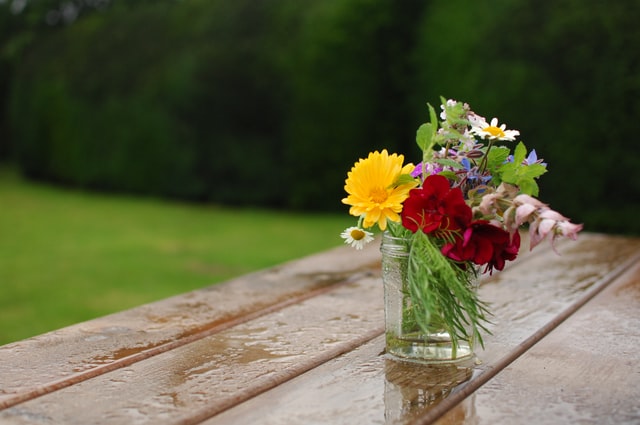
Flowers are naturally attractive to people of all ages – including toddlers! Picking them requires hand/eye coordination and a gentle hand. Placing them in a vase or jar practices hand-eye coordination and pincer grasp.
You could also fill up a small cup with some water and your toddler could practice pouring the water into the vase to water the flowers.
Plus a bouquet of wildflowers is just the best and brightens up any space!

Hiking and camping with baby in the mountains-
Family Hiking and Camping with a Baby
How to Have a Fun Trip to the Mountains with Baby


How to Have a Fun Trip to the Mountains with Baby
So, you are going to the mountains with your baby and are wondering how it will be possible to have a fun family vacation with such a young child especially if you are exclusively breastfeeding.
Well, I am here to tell you that it is possible and remember, just because you are a parent, does not mean you are not allowed to be adventurous and have fun in the mountains with your family.
My boyfriend and I just came back from our first family vacation to the Eastern Sierras with our 4-month-old daughter and I am here to give you some encouragement and tips from our experience.
Hiking with your Baby
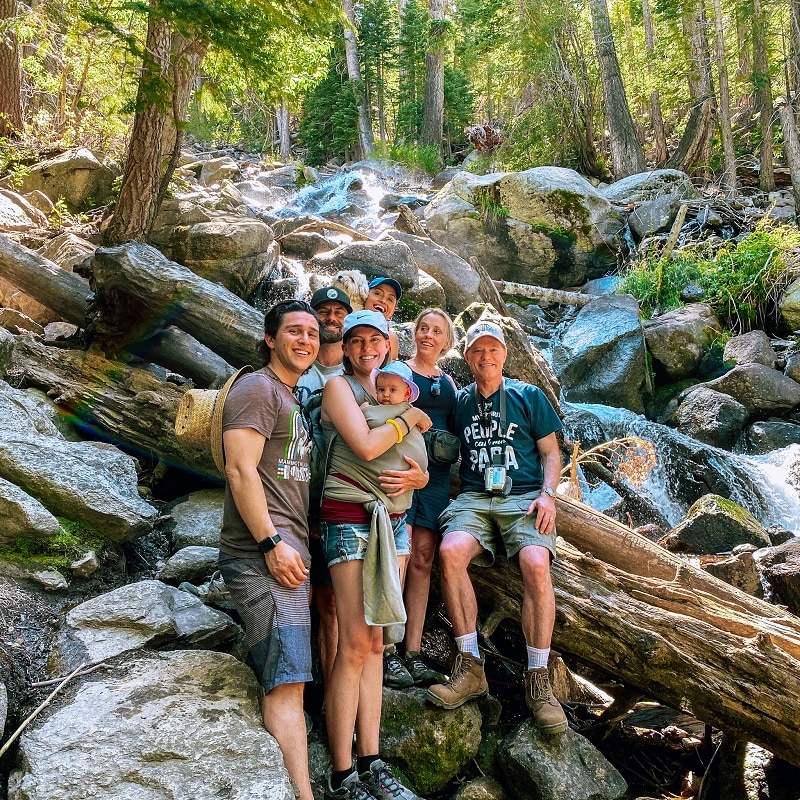
First, let us talk about hiking in the mountains with your baby; yes, I did it and so can you.
All you need is a diaper bag, baby carrier, baby sunglasses, baby hat, your baby in a long-sleeved onesie to protect their skin, and confidence.
In your diaper bag, be sure to bring all your baby essentials: changing pad, diapers, wipes, Aquaphor, muslin swaddle, burp cloths, and extra clothes for you and baby just in case of spit-up or a blowout.
You will need more items if you are bottle-feeding your baby.
There are many baby carriers out there that make hiking both possible and fun with your baby, but at our daughter’s young age and small size, we found the Boba Wrap to be the best carrier for her to feel comfortable in as well as be protected from the sun.
We were able to complete a 2-mile hike to the waterfalls at Twin Lakes and our daughter was even able to take multiple naps in the Boba Wrap on the way up and down from the falls!
Fishing, Picnic, Eye Spy, Stargazing, & Board Games with your Baby

Other then hiking, there are plenty of other fun experiences to share with your baby in the mountains even if they are too little to participate in them with you just yet.
Bring your baby along when you go fishing and show them what fish you catch.
Have a picnic and enjoy some tummy time on the side of the lake or stream together while you both enjoy the beautiful scenery around you.
Talk to your baby and let them know what you are doing and point out any animals you see in the forest.
I was able to interact with some deer and ducks with my daughter and she seemed to enjoy it.
Take your baby outside with you to stargaze at night together.
Do not forget a trip to the mountains in a cabin is not a trip without playing some good old-fashioned family games.
Talk to your baby while you play your favorite board game with your loved ones, so they feel included.
Water Sports with Your Baby
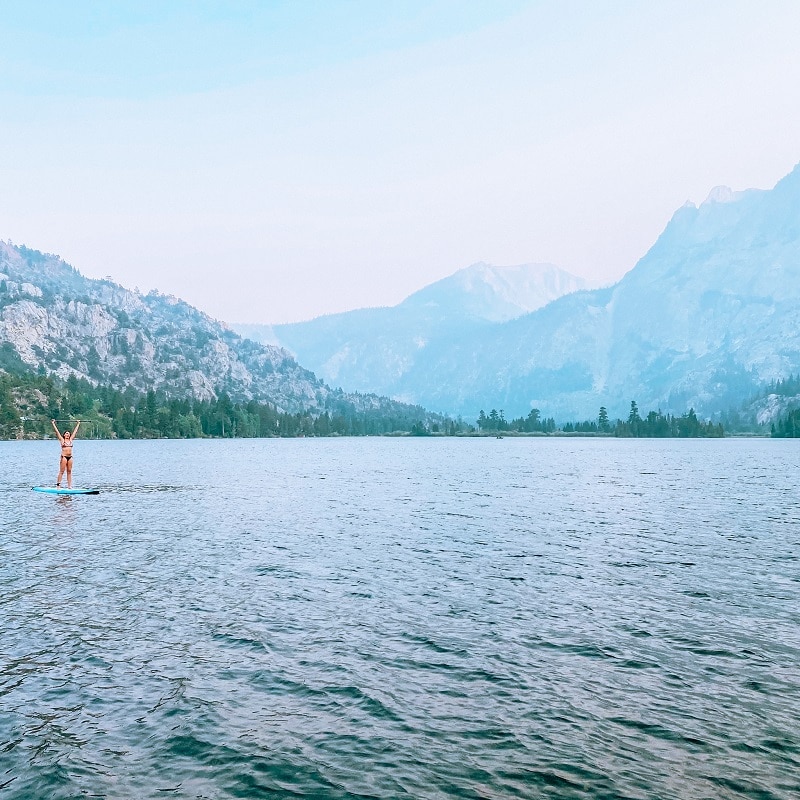
Do not forget about all the water sports you can do while in the mountains.
No, your baby will not be able to go on that paddleboard, kayak, or boat with you just yet, but that does not mean you cannot still enjoy these activities yourself.
According to the U.S. Coast Guard’s Office of Boating Safety, babies should weigh at least 18 lbs. and be able to comfortably wear a Personal Flotation Device (PFD) to be on a boat.
I would recommend having your partner, parents, and/or siblings come along with you to help take care of baby, that way you can switch off and take turns doing these activities.
When I went paddleboarding at the lake, I changed my baby girl’s diaper, made sure she was comfortable weather wise (see if she needed pants or a jacket when it was colder), and breastfed her.
That way, once I was done feeding her, I would have at least a good hour to be out on the water knowing that she was a comfortable happy baby while my boyfriend and sister watched over her.
#1 Travel Must-Have for Baby
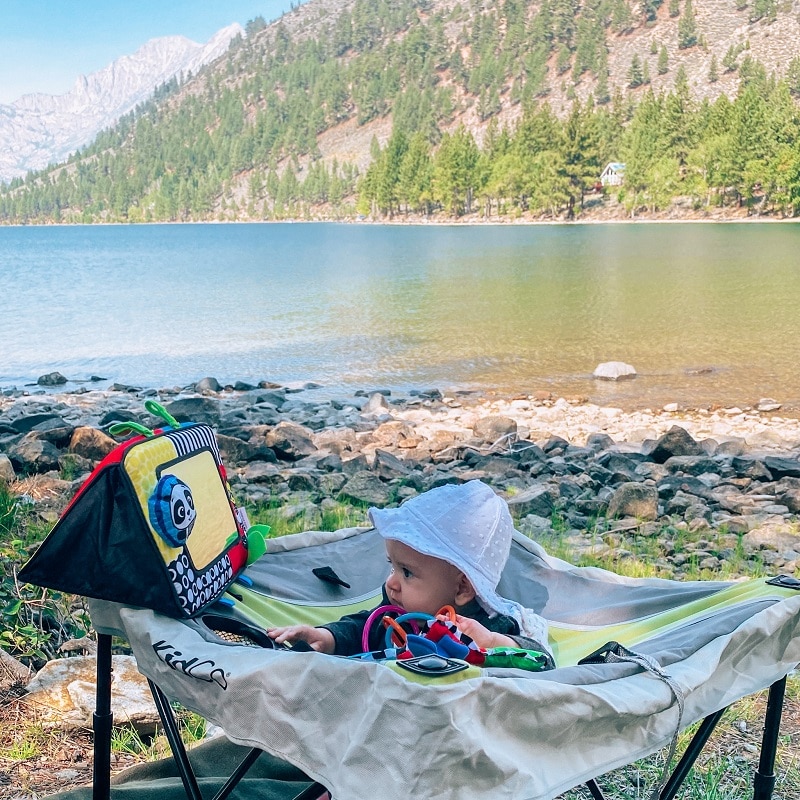
One item that made our experience even more enjoyable was bringing our KidCo GoPod.
This is such a neat portable activity seat for your baby to use while traveling. It sets up and folds up just as quickly and easily as a camping chair.
You can attach a variety of toys to the loops on the seat for your baby’s entertainment and learning development.
We love that our daughter can sit up in it making it easier for us to interact and play with her at a different level without having to worry about her falling over.
Our baby girl is on the smaller size and at 4 months old she is unable to reach the floor so we put a pillow or baby blanket underneath her so she can practice using her legs and push from her feet.
We loved being able to use this to help entertain our daughter while in the BIG OUTDOORS because it gave her a different perspective and experience.
Just make sure not to keep your baby in the KidCo GoPod for longer than 15-minute intervals because it can be harmful to their hips and joints if overused over time.
Conclusion
As you can see, you can still enjoy many adventurous activities in the mountains even when traveling with your baby.
Desert Hiking with Babies
Desert Hiking with Babies
After 25 years as Floridians, I never thought we’d become desert rats, but the moment we arrived in Arizona, we fell in love. When our son was born, our adventures centered around our high desert home meaning he spent a ton of time early on exploring the desert.
Below, I have compiled what we have learned along the way to safely enjoy our hottest, driest adventures with the hopes that it will help others to enjoy the desert as well.
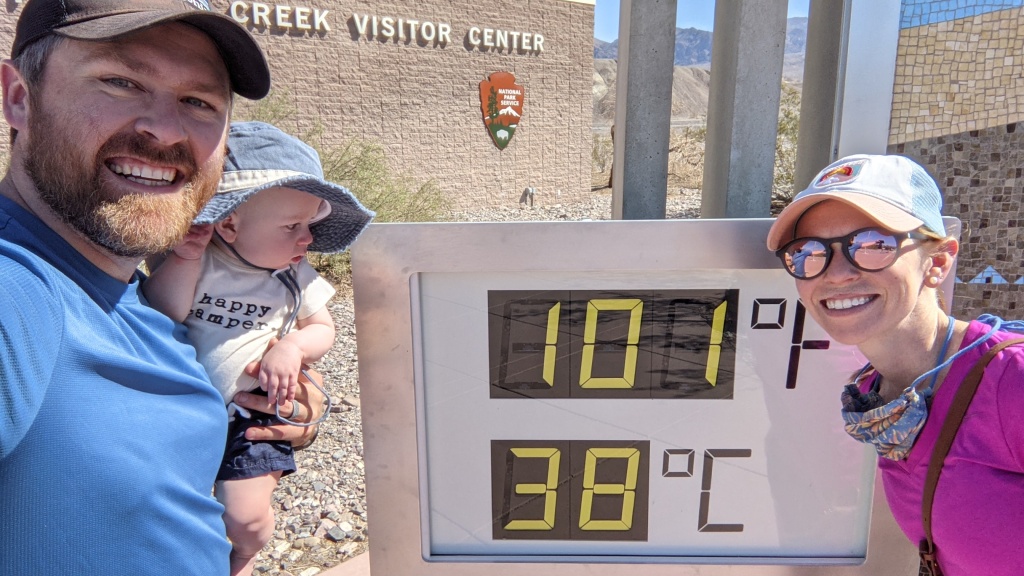
If you ever have questions or concerns about sun exposure, overheating, your plans to hike, camp, or do whatever else with your child in the desert, please consult with your child’s pediatrician.
Babies & Thermoregulation
Babies are at a greater risk for heat and sun exposure related conditions. This is caused by a few things: their greater surface area/volume ratio which allows their body temperature to fluctuate more easily, their under developed sweat glands, their thinner skin that produces less melanin, and their increased risk of SIDS due to overheating.
Because of these things, it is imperative that parents and care givers take extra precautions to protect their children while enjoying hot desert climates.
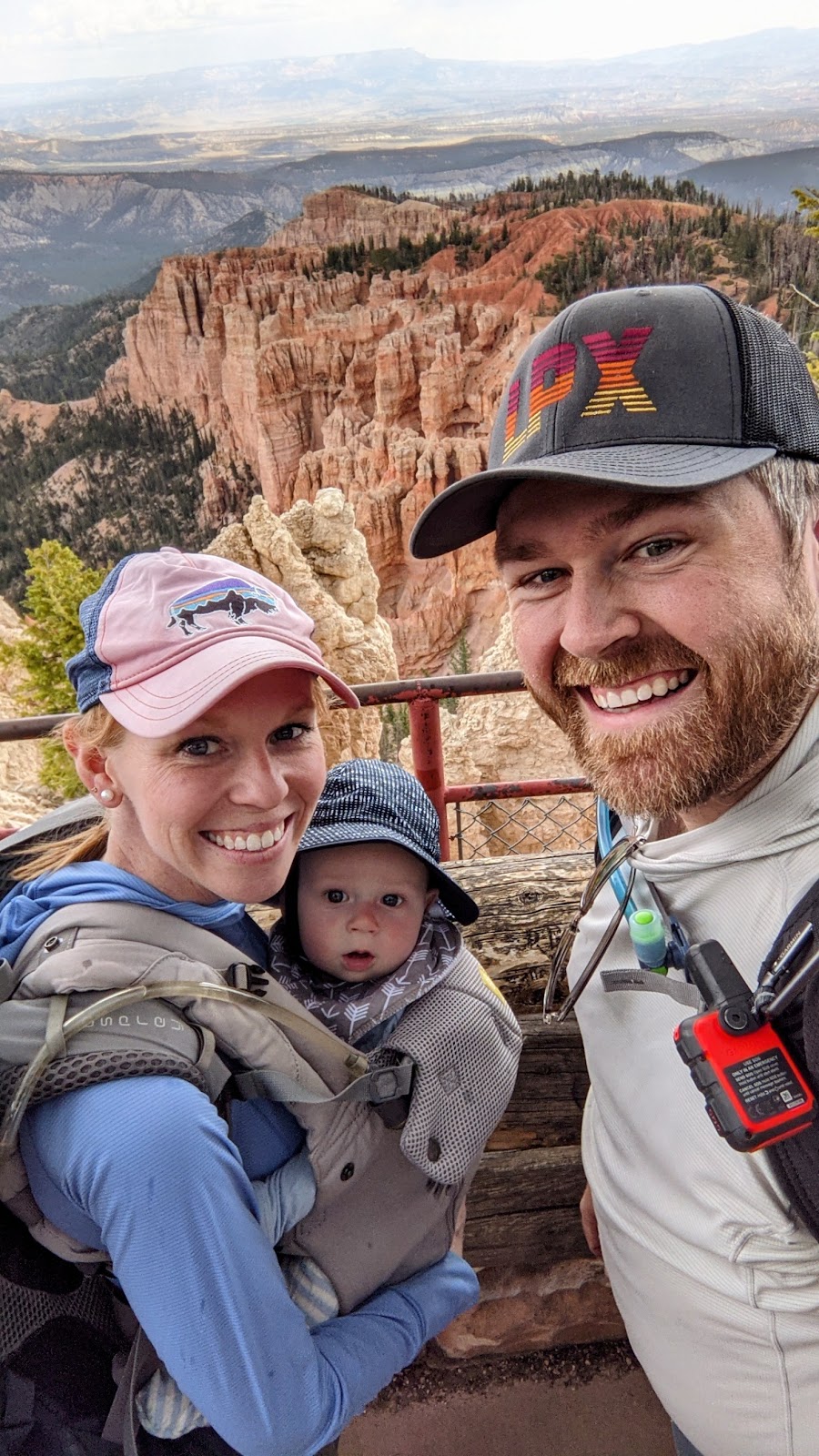
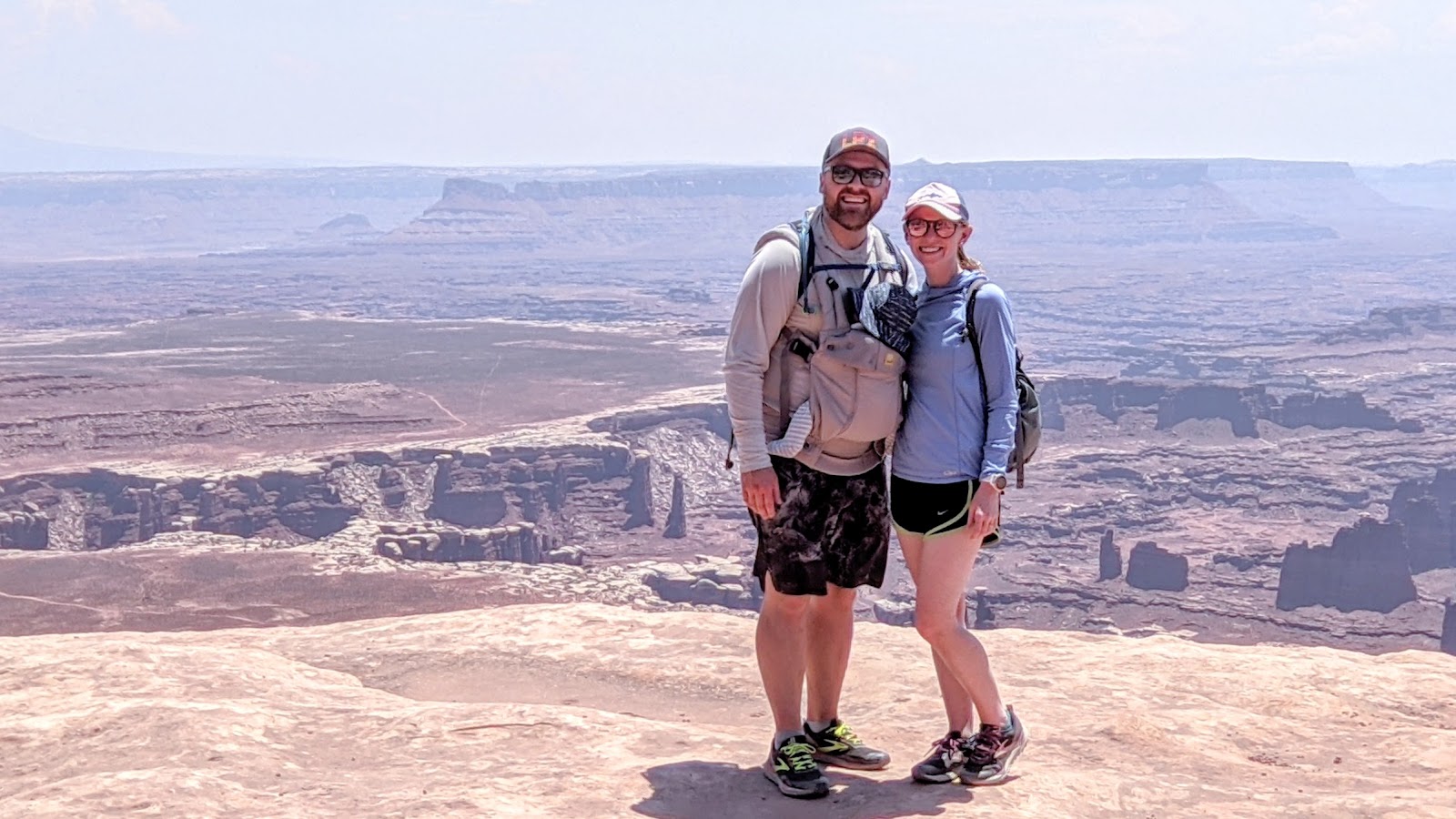
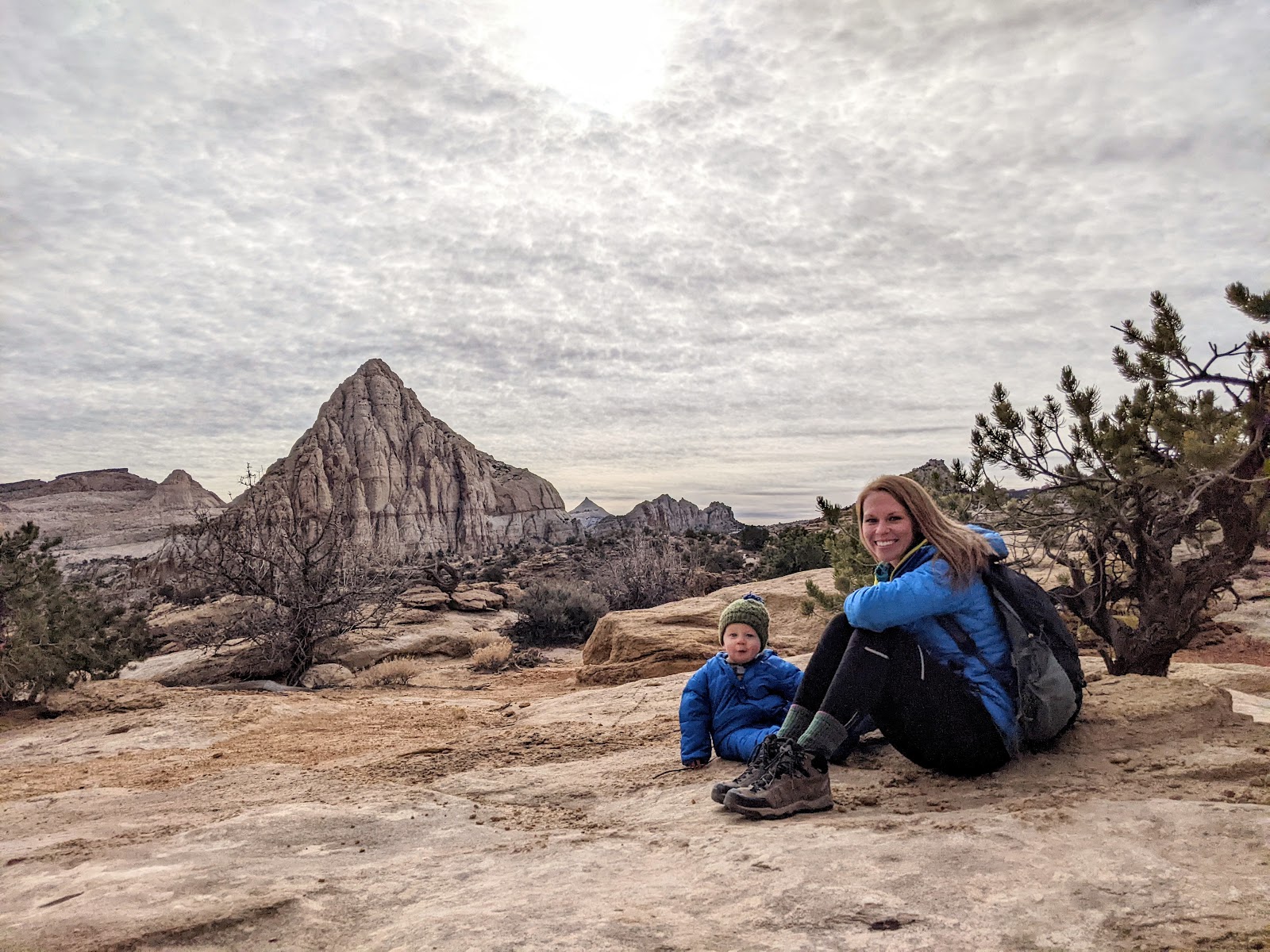
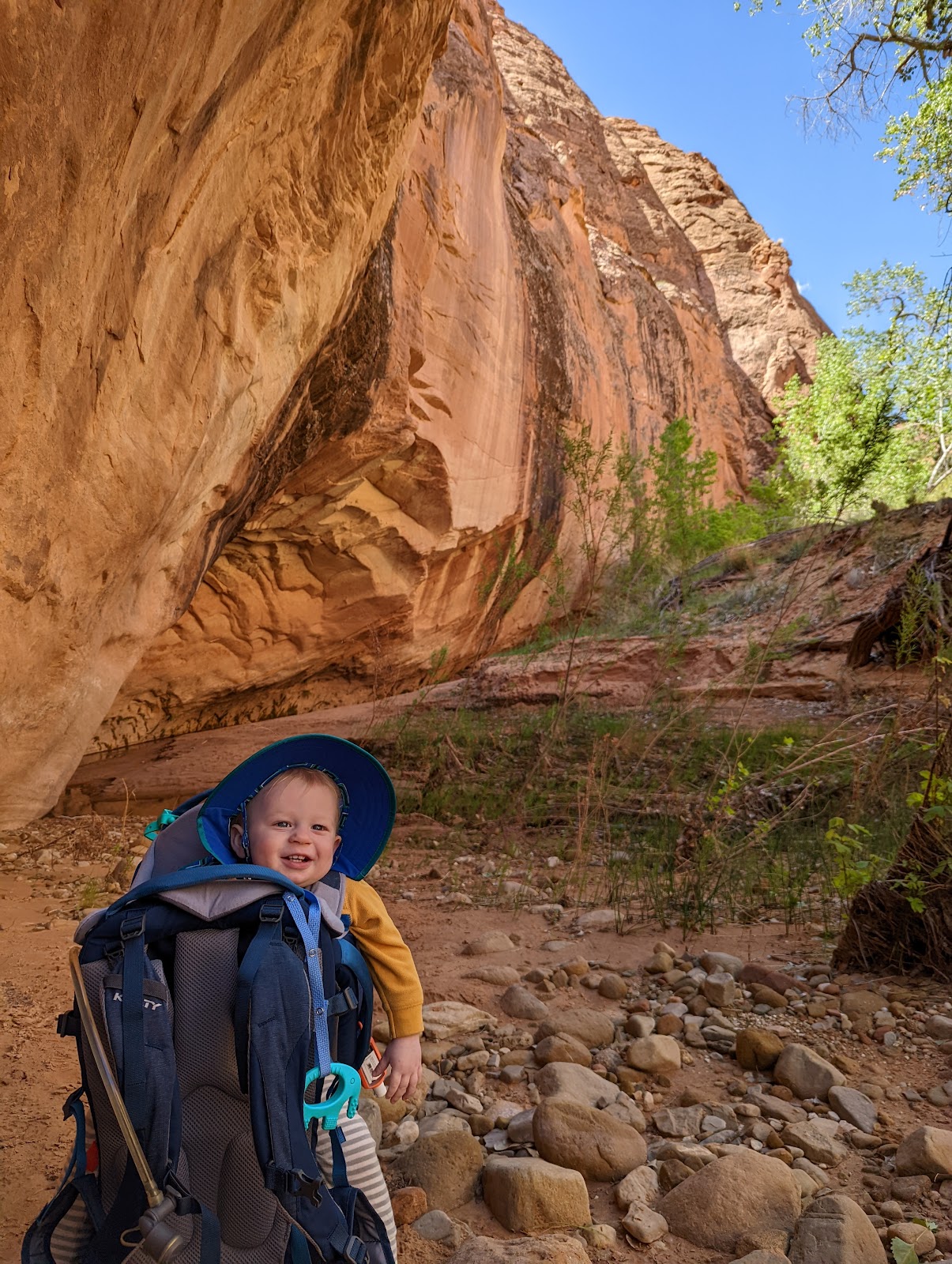
Best Practices
Ironically, most suggestions for hiking in a hot desert are some form of “avoid doing it:”
Avoid hiking in the middle of the day, generally between 10am and 4pm.
Avoid the sun and find as much shade as possible. Find the shadiest hikes if possible and always keep track of the nearest shade to take good breaks.
Avoid the dryness and stay wet. When it’s dry and hot, your sweat evaporates before it can absorb your body heat to keep you cool, so dipping a towel or shirt in water will do what your sweat wishes it could do.
Keep your hike short. Obviously, too much sun and too much heat can be dangerous, so don’t be too ambitious with your plans.
Know when to call it quits. While you should definitely be aware of the signs of dehydration, heat exhaustion, sun burn/poisoning, etc., you should also try to call it quits before any of these symptoms present themselves. If it gets hotter faster than you planned, turn around. If you are drinking water faster than expected, turn around. If everyone is grumpy and irritable, turn around. Turn around before there is a problem.
Go somewhere less hot! Much of the American Southwest is dotted with high elevation mountains/plateaus and great swimming holes. For instance, if you are enjoying Northern Arizona/Southern Utah, you might consider cooler options like:
The North or South Rim of the Grand Canyon
Bryce Canyon National Park
Lake Powell (Glen Canyon National Recreation Area)
Slide Rock State Park in Sedona, AZ
(see slideshow below for some examples)
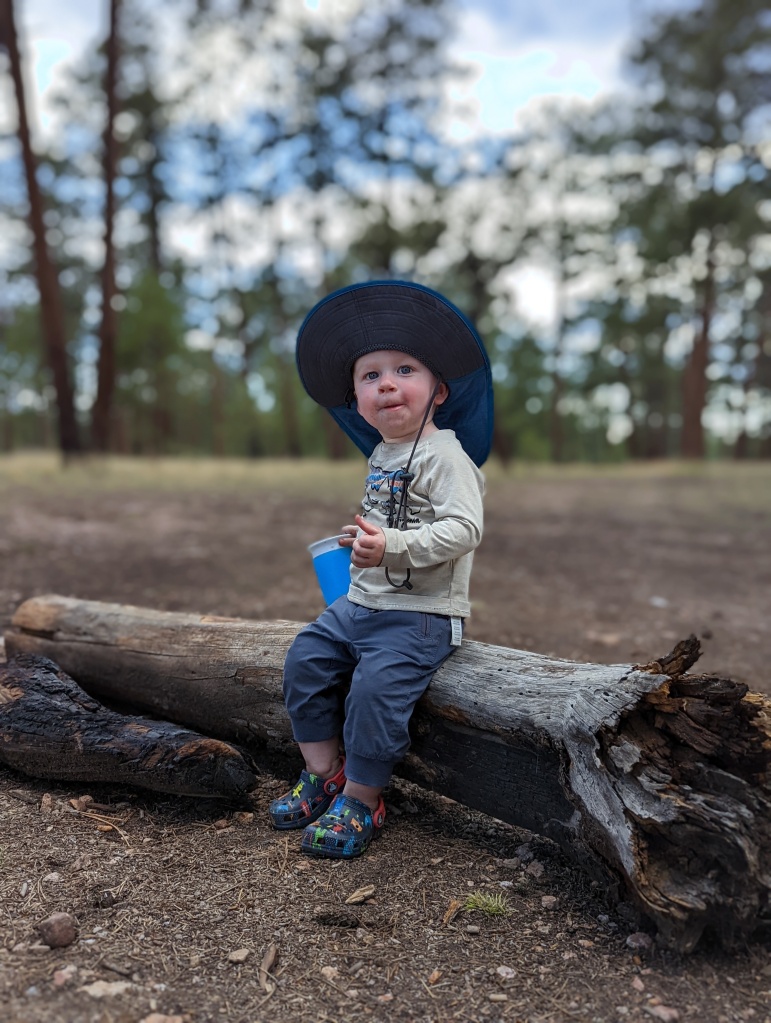
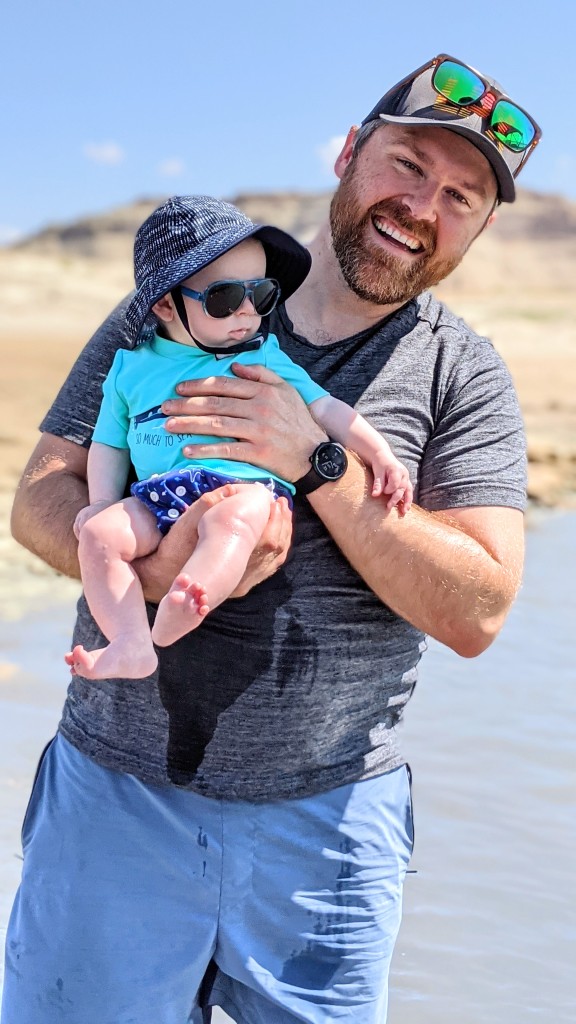
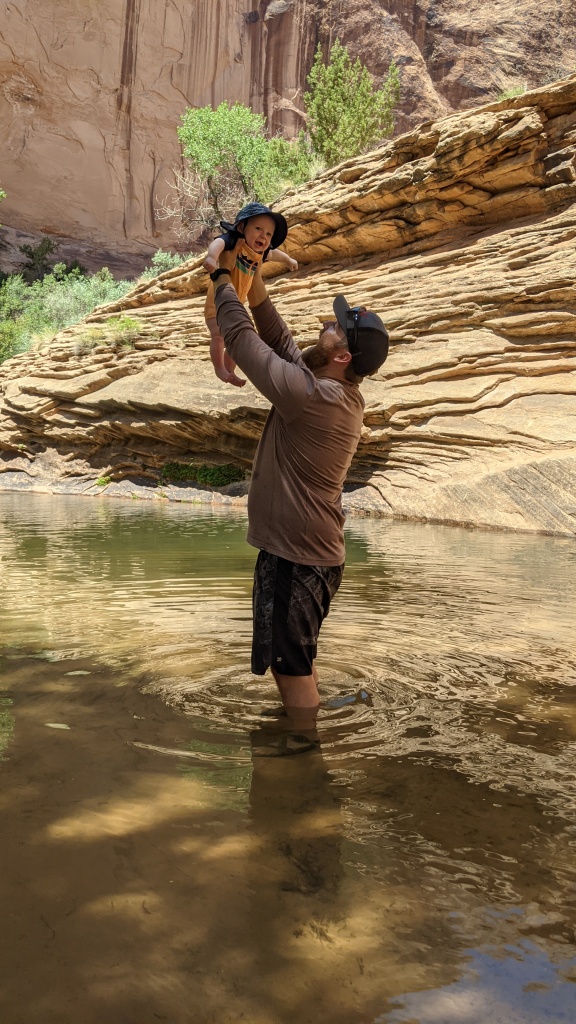
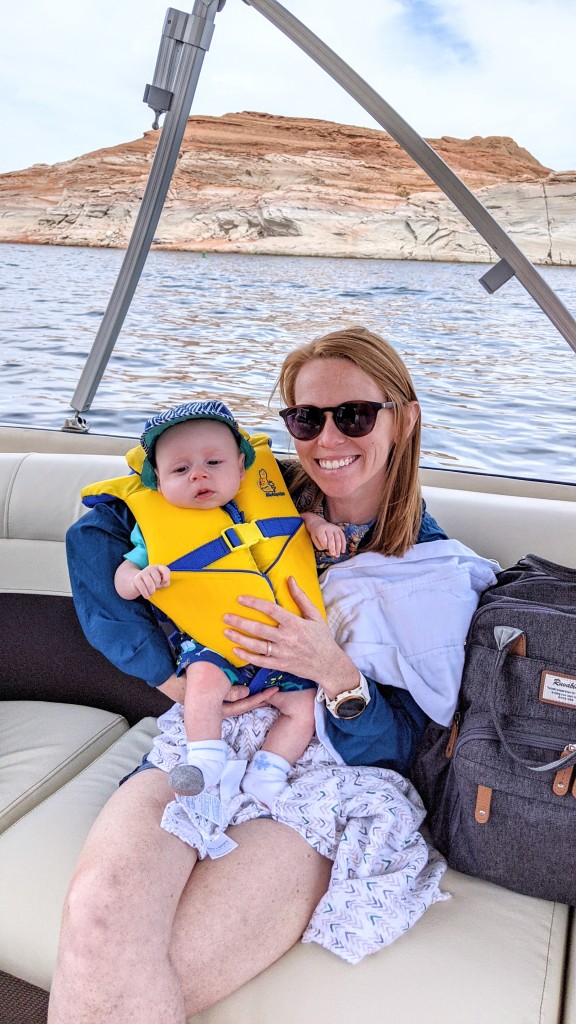
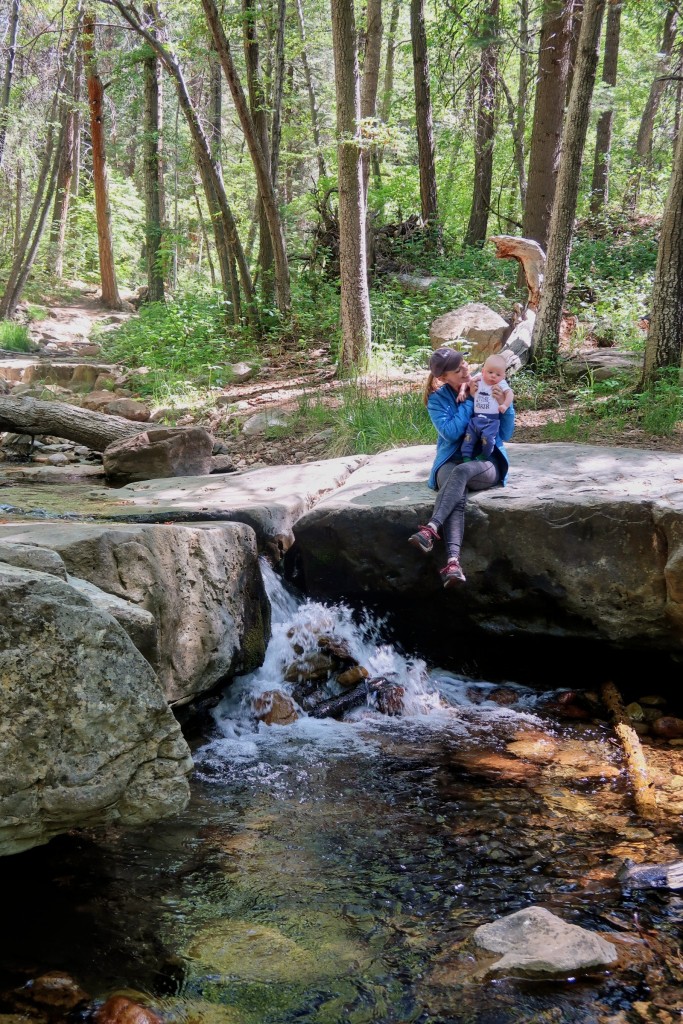
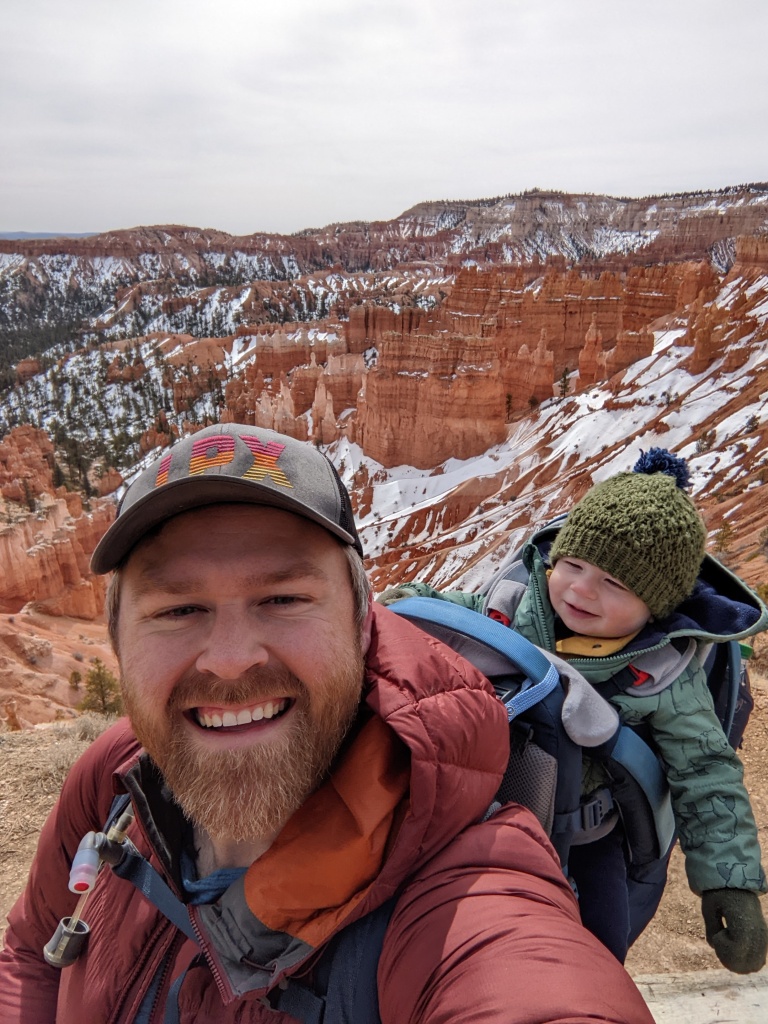
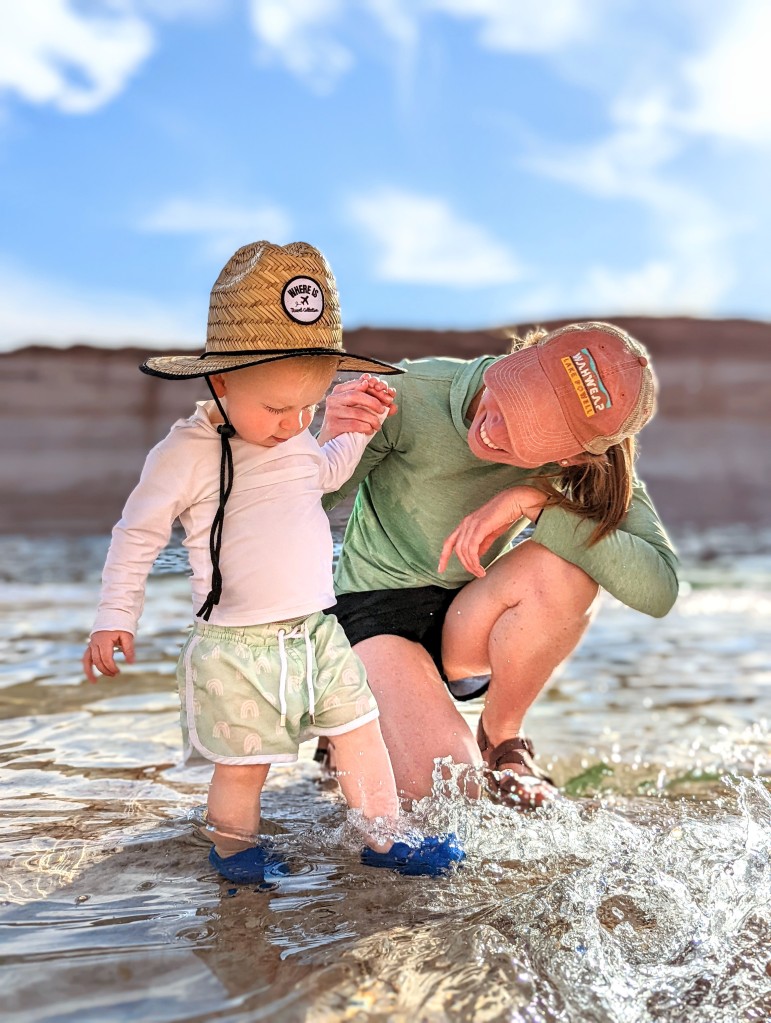
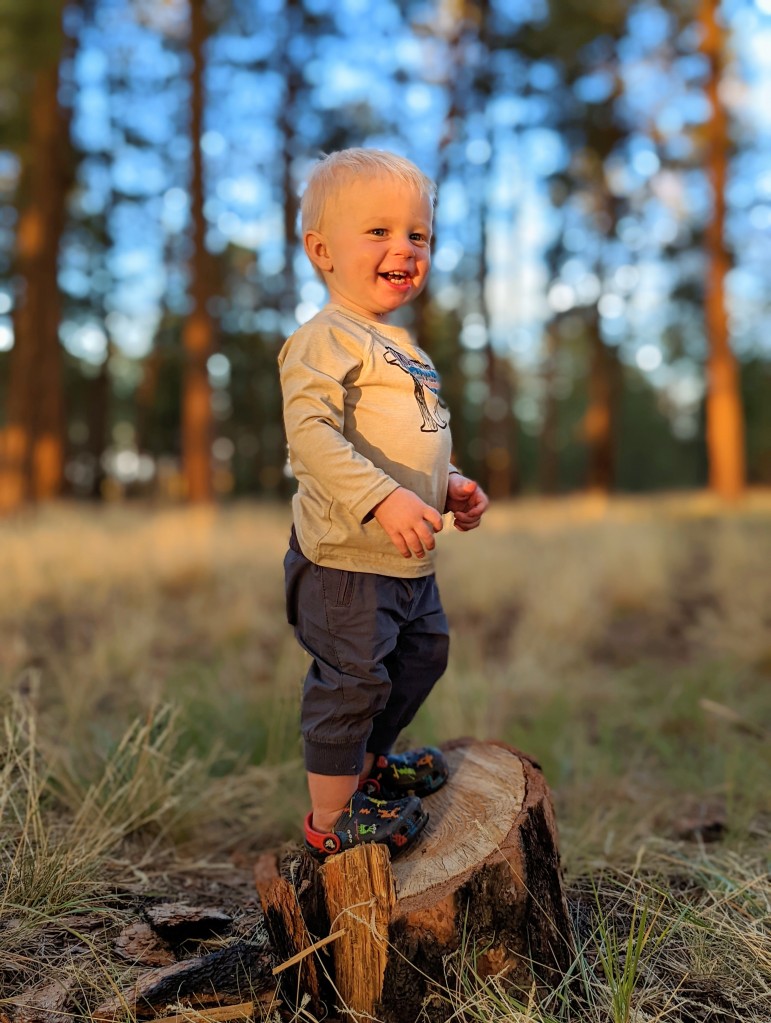
Beyond “avoiding the sun” and “avoiding the heat,” the most important consideration is to STAY HYDRATED.
As a general rule of thumb, plan on a gallon of water per person, per day.
Replenish your lost electrolytes to avoid Hyponatremia caused by excessive sweating/fluid loss. Drink sports drinks, coconut water, or electrolyte powders added to your water.
Breast feeding moms are at an increased risk of dehydration, so be sure to drink even more than expected if this is you!
Just as you need to drink more, so will your baby. Be sure to offer milk/formula to your baby more frequently…and remember, increased breast feeding means increased fluid loss for mommas!
Generally, babies are to wait until 6 months to consume water, but as always, consult with your child’s pediatrician on what’s best for your child.
Finally, you should be prepared to identify and treat symptoms of heat or sun exposure related issues. According to the AADA: “If your baby is fussy, crying excessively or has redness on any exposed skin, take him or her indoors immediately.”
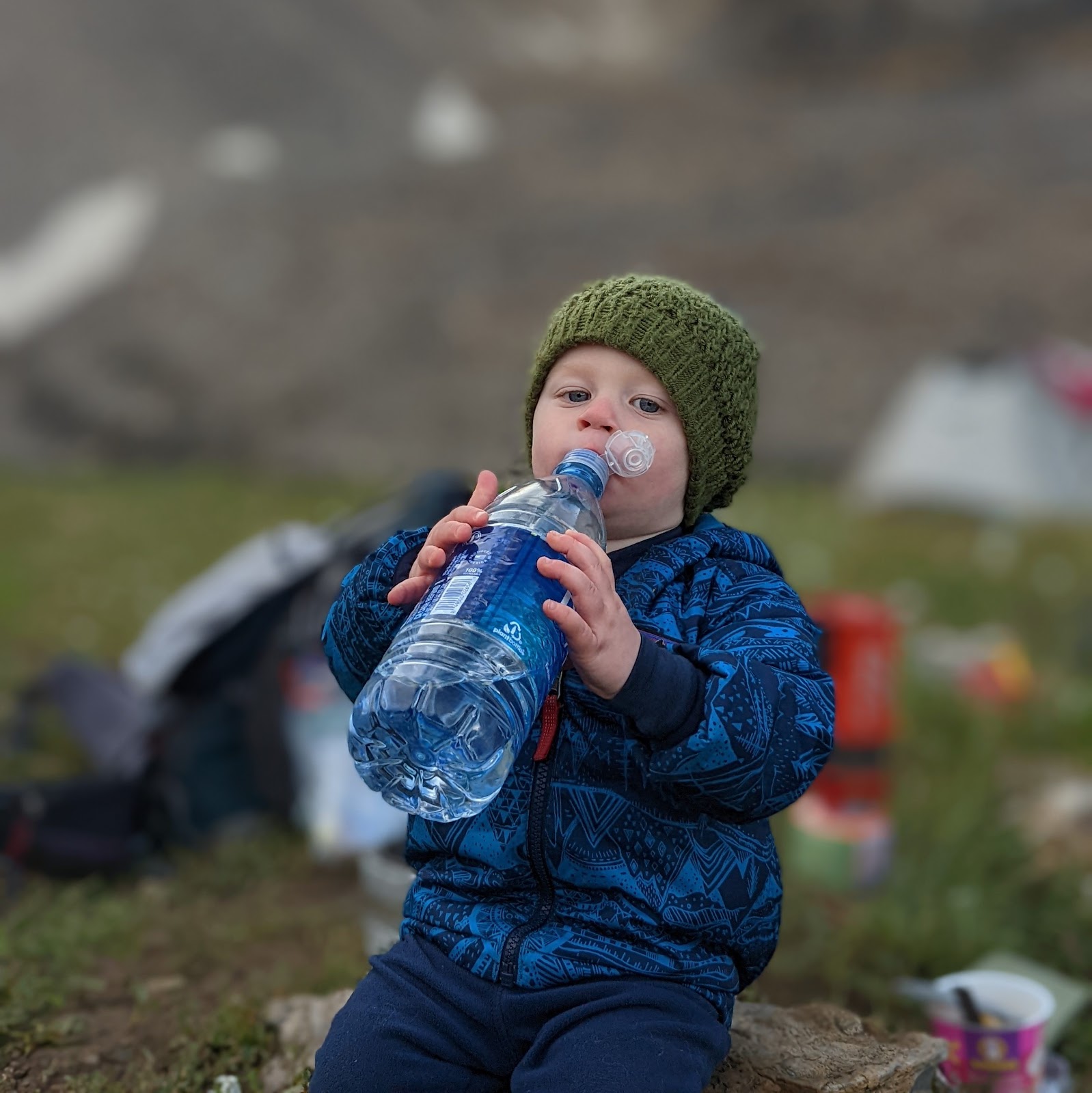
In general, if your child is turning red, is hot to the touch, is lethargic or vomiting, has a fever or elevated heart beat, or if you just suspect something is off with your child, get them where it is shaded and cool as quickly as possible. Consider a cool cloth or a luke warm bath to cool them down.
See below for a few of Seattle Children’s Hospital notes and recommendations for when things get more serious:
Call 911 now if your child is hard to wake up, is having seizures, or has a fever over 105ºF (40.5°C).
Call a doctor if your child is acting unusually, has a fever and is less than 12 weeks old, is vomiting from drinking fluids, appear dizzy or sick, has a dry mouth or no tears, or hasn’t urinated in 8 hours or the urine is very dark.
What to Bring
Sunscreen
According to the FDA and the AADA, you should wait to use sunscreen on your child until after 6 months if possible. However, if shade and appropriate clothing are not available, the AADA also advises to use “a minimal amount of broad-spectrum, water-resistant sunscreen with an SPF of at least 30…Sunscreens containing titanium dioxide or zinc oxide are less likely to irritate a baby’s sensitive skin.” If you are unsure how to best protect your infant’s skin, please speak with your child’s pediatrician.
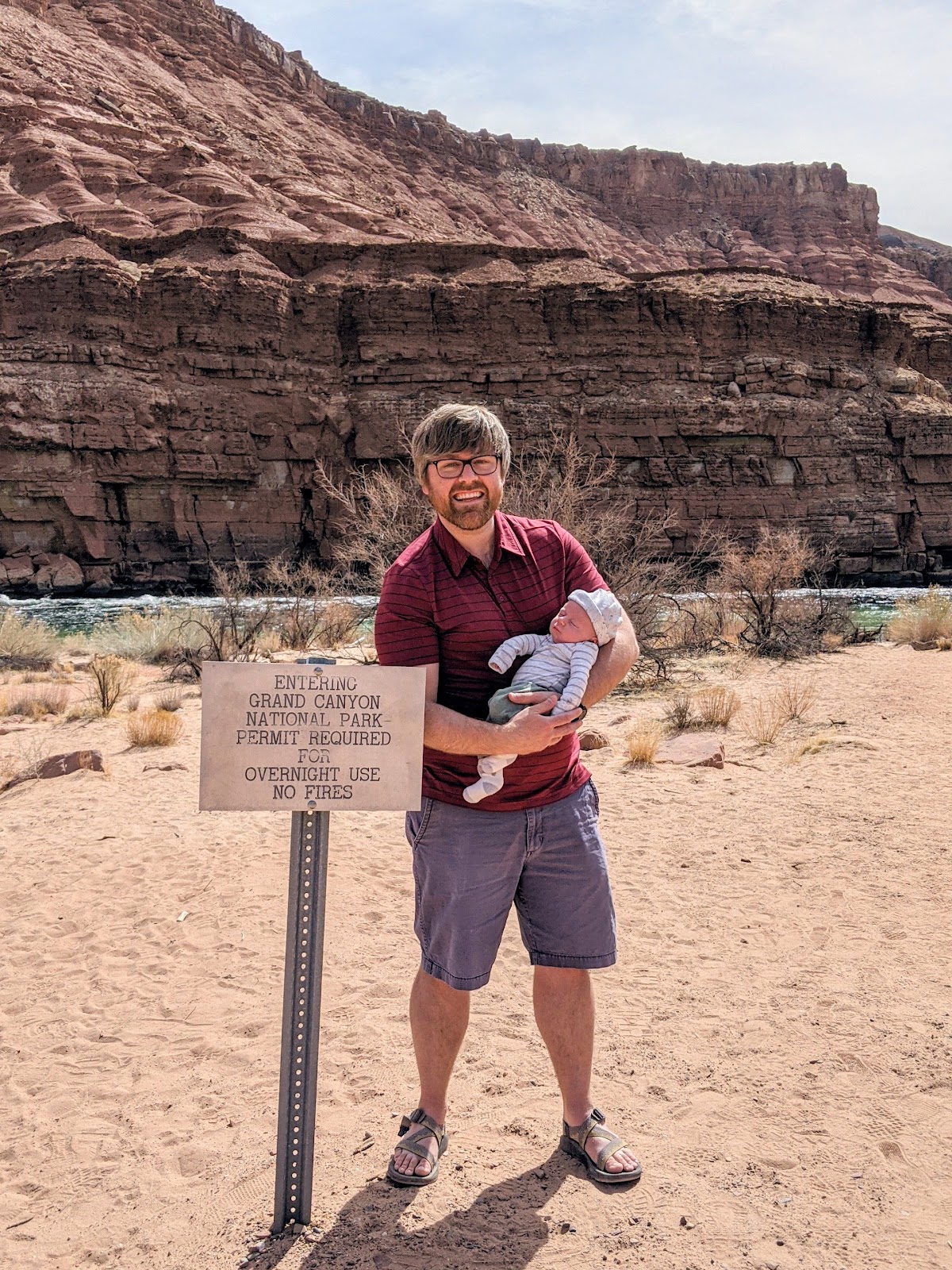
We love Tubby Todd’s mineral sunscreen, sunstick, and chapstick (affiliate link). Our son has sensitive skin that irritates easily and Tubby Todd products have been the best at keeping his rashes under control. The stick is especially great to throw into our hip pouch to easily reapply on the go.
Mineral sunscreen is great because it is effective immediately upon application rather than 15-30 minutes after application of chemical sunscreen…meaning we can apply it and get going right away and not worry about sun exposure. While chemical sunscreen is water resistant, it’s not really needed in the dry air or on a child’s mostly sweatless skin.
When applying, don’t forget to apply to EVERY little bit of exposed skin. This includes the tops of their hands, face, lips (with SPF chapstick), and even the bit of skin that often peeks through above their socks when their pants ride up.
Finally, according to Nemours Children’s health, avoid sunscreens with PABA or oxybenzone. For more information about children’s sunscreen, Nemours Children’s Health has a a wonderfully detailed article about effectively protecting young skin from he sun.
Clothing
Cover as much skin as possible with long sleeves and long pants. These layers should be light colored, light weight, and loose fitting.
Many are familiar with the saying, “Cotton Kills” which is true in many outdoor situations because it retains moisture so well. However, in hot, dry climates, you want your clothing to retain moisture. Moisture conducts heat better meaning it will absorb the heat from your body better. A shirt that wicks away your sweat quickly means the moisture will evaporate before it has a chance to absorb your body heat. The downside to cotton is that it has a UPF rating of about 5 which puts your skin at risk.
Synthetics like polyester are popular among outdoor enthusiasts because it typically has the highest UPF ratings and because they wick away moisture so well. Many parents also love rash guards for their your children because of their UPF ratings and full body coverage. For reasons discussed above, these wicking qualities are great for hot, humid climates, but not necessarily in dry climates.
Finally, what about wool? Isn’t wool for winter? We definitely prefer wool in the winter but we also prefer lightweight wool in the summer as well…and here’s why: Wool retains about the same amount of moisture as cotton or possibly more. While cotton does retain moisture longer, wool holds moisture longer than polyester. What’s neat about wool, though, is that the moisture in it is chemically bonded with the fibers and therefore doesn’t feel wet like cotton! Finally, wool typically has a natural UPF rating up to 50! Our son has worn wool for every backpacking trip and nearly every hike.

In summary: cotton keeps you cool in hot dry climates, most polyesters protect well from the sun, and lightweight wool does both extremely well!
Our son’s favorite wool is from Iksplor (affiliate link). Not only does it have a UPF rating of 50 and regulate his body temperature well, it’s incredibly comfortable and doesn’t get stinky! He’s worn these layers all over the desert and even abroad on the Tour du Mont Blanc and the W Trek in Chile.
Get a wide brimmed sun hat with a chin strap to ensure it always stays on their head! We do have sunglasses and use them from time to time, but we are still practicing with our little one…they are definitely valuable and worth using while walking on highly reflective sand and rocks. If your child walks, get them shoes. Sand gets incredibly hot and can seriously burn the skin of a barefoot child. We never thought it would happen, but we’ve become a Croc family. He just looks so stinking cute in ’em and they are perfect for the desert!
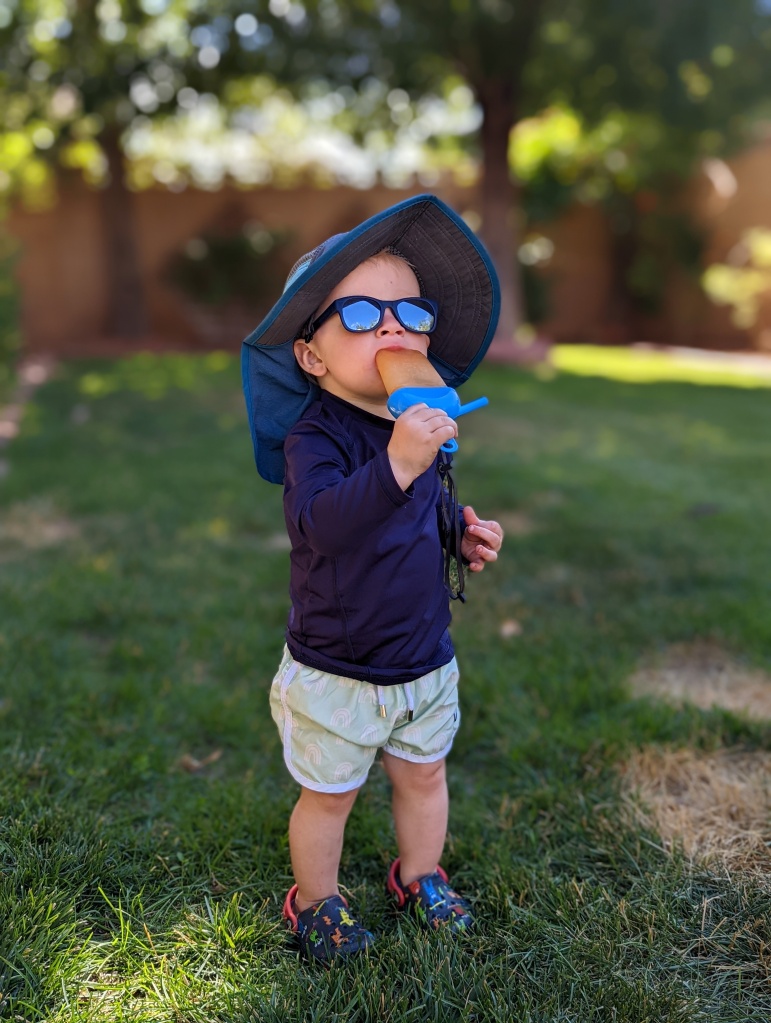
Carriers
If you’re using a soft side carrier, look for an all season carrier that has extra vents or mesh panels. If you’re using a structured carrier, find one with a sunshade.
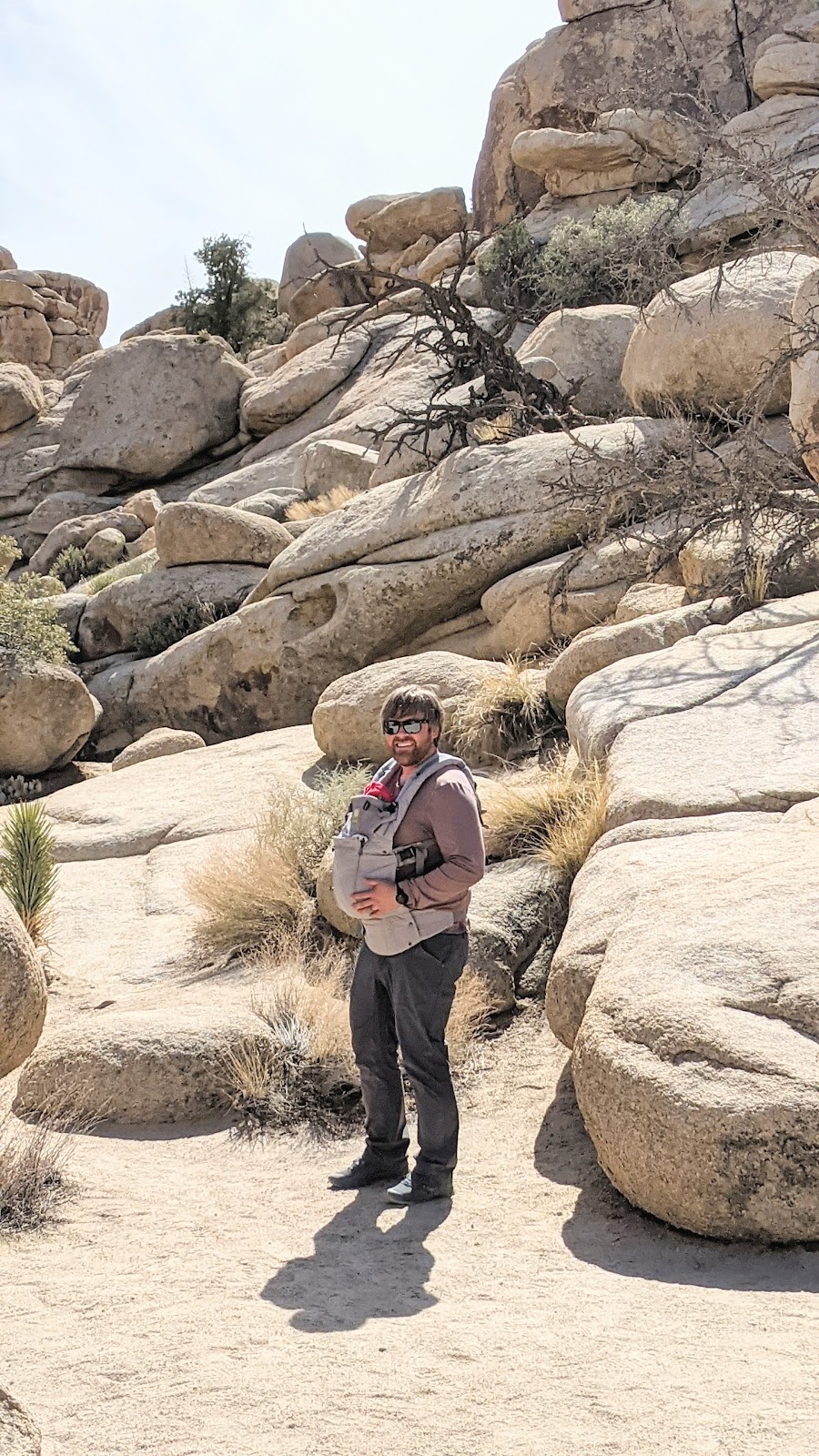
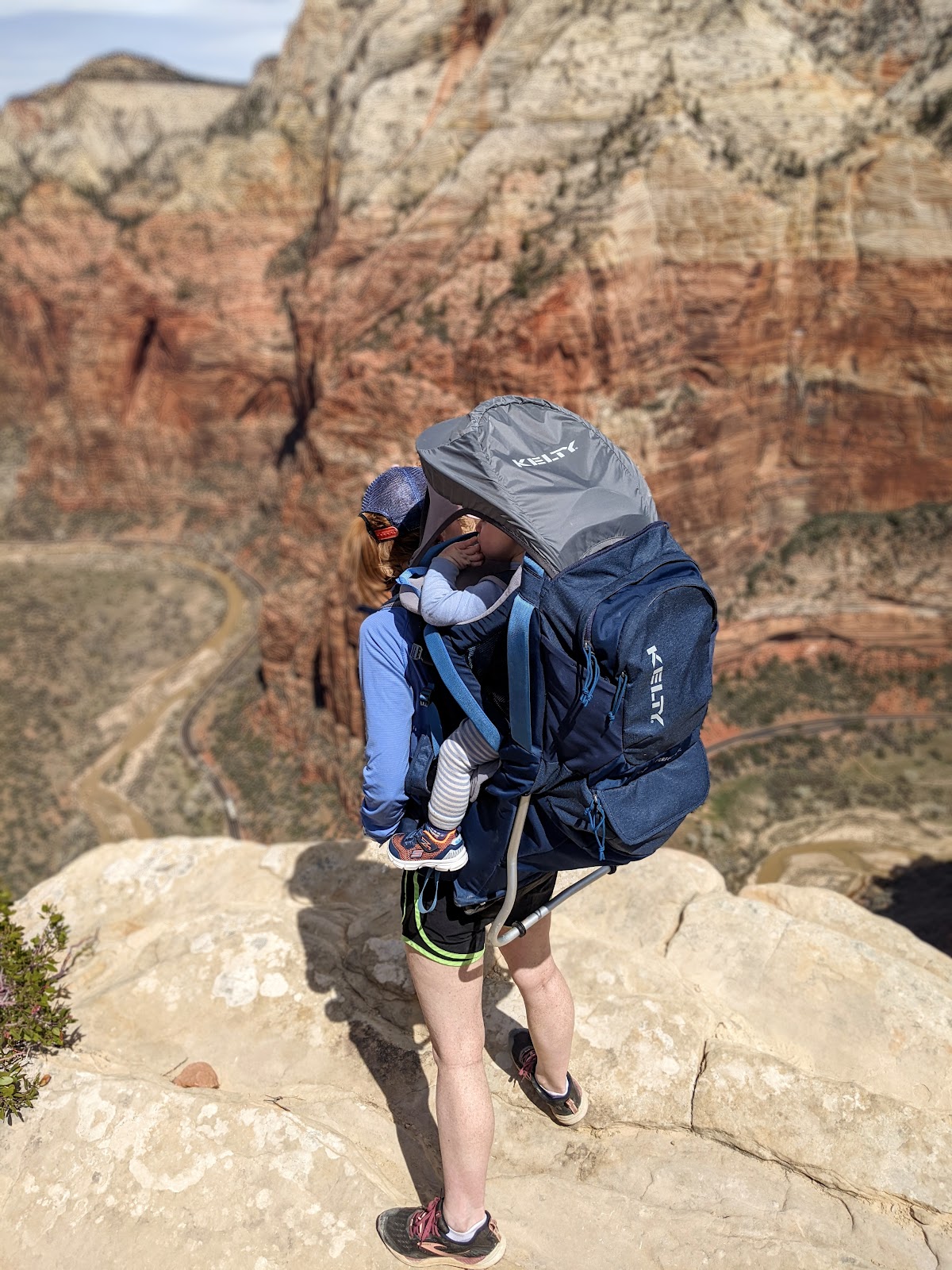
Shade
Sun Umbrella – We don’t use or have a sun umbrella, but many parents online swear by these. Give it a try and maybe you’ll become a fan too!
KidCo PeaPod Tent – We’ve only really used this when sitting on the beach along Lake Powell or the Colorado River or when backpacking.
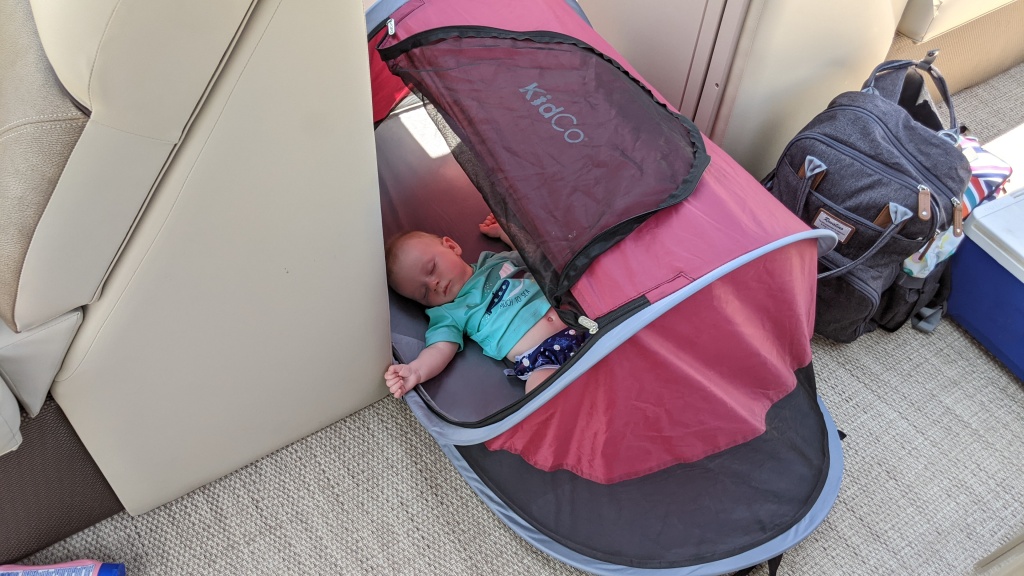
A note about the PeaPod and tents in general. During the day, tents easily become ovens. Do not think setting it up quickly will create a cool place to relax in and beat the heat. It just doesn’t work that way. Find some other shade that’s not enclosed and find the breeze. If your child must be in the tent or PeaPod, open all the flaps and create as much air flow as possible. Possibly also consider a fan. Finally, for the same reasons, do NOT cover a child in a stroller with a blanket to shield them from the sun. Again, this will turn the stroller into an oven and can be very dangerous.
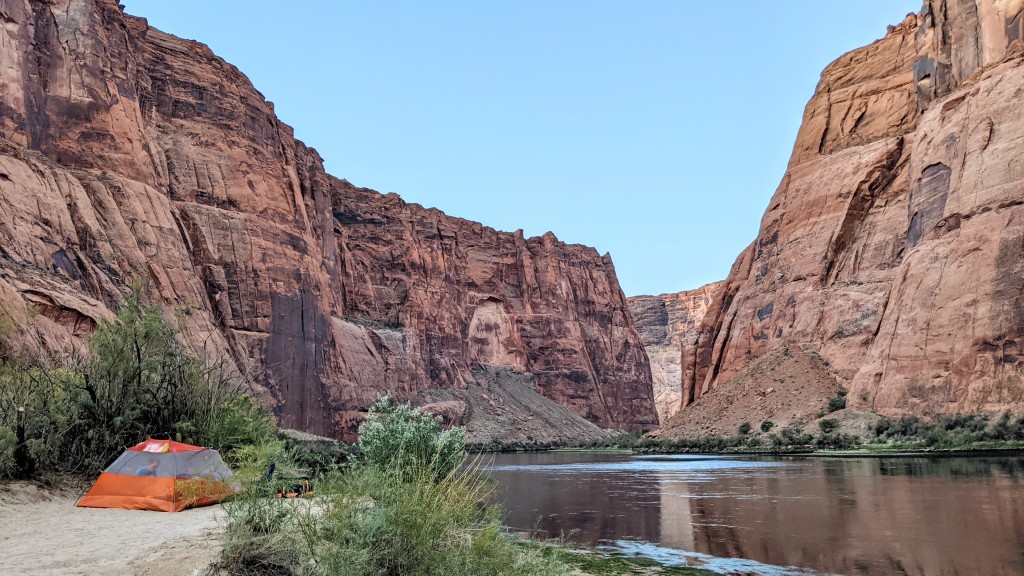
Extras
Sit Pad, Changing Pad, or Sleeping Pad – Sand is hot and babies need diaper changes. Be sure you have something to cover the ground for your child.
Good Lotion and Aquaphor for afterwards. Your child’s skin will dry out and may easily become irritated. Be sure to lotion multiple times a day and use ointment for rashes. Again, we love Tubby Todd’s lotions (affiliate link) for our son.

Cooling Towel‘s are great to help your child cool off quickly or stay cool if you’re hiking in areas with less shade.
Stroller Fan‘s are great for on the go. We don’t carry this when hiking backpacking but always have one handy for the car after a hot hike and in the stroller for more casual stroller friendly hikes.
Garmin InReach Mini – Ever since my parents and in-laws put their own minds at ease by getting us an emergency GPS, we have taken it on every single adventure. It’s just an extra bit of comfort knowing we can get help if need be, especially now with a small child in tow.
Other Desert Weather
When It’s Actually Cold
3 times to consider when temperatures will drop:
seasons
nights
canyons
Obviously, winter is cold. However, many people forget that the desert isn’t always hot. So far, this winter (’22-’23), my home has received maybe 6 or 7 inches of snow. It’s not a ton, but it’s still shocking to many.
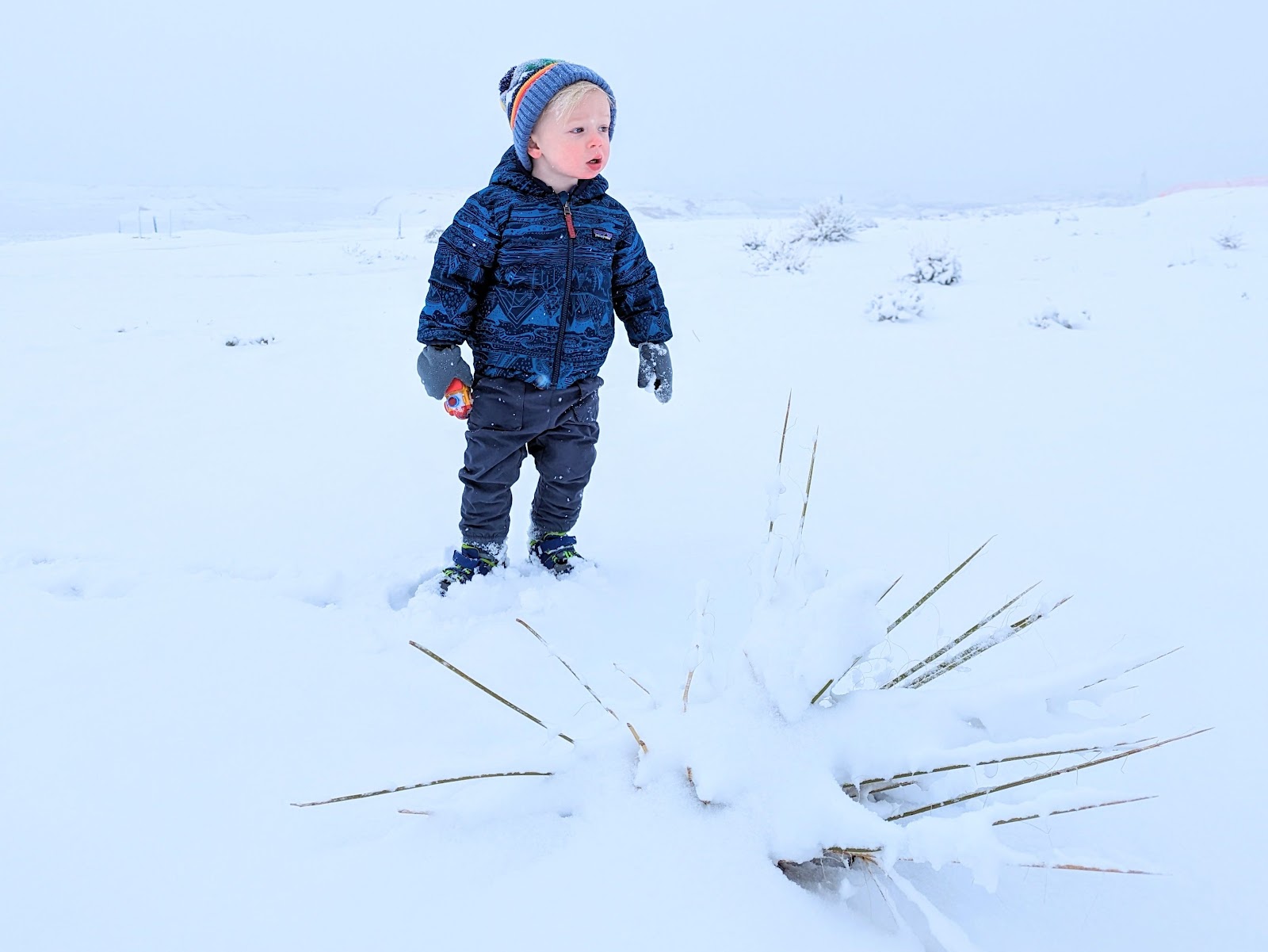
Our desert home this winter
For those spending a night out in the desert, know that sand and dry air do not retain heat well. Because of this, nights can get cool, even in the summer. Be sure to bring a good insulating sleeping pad and a couple layers to wear in the evening.
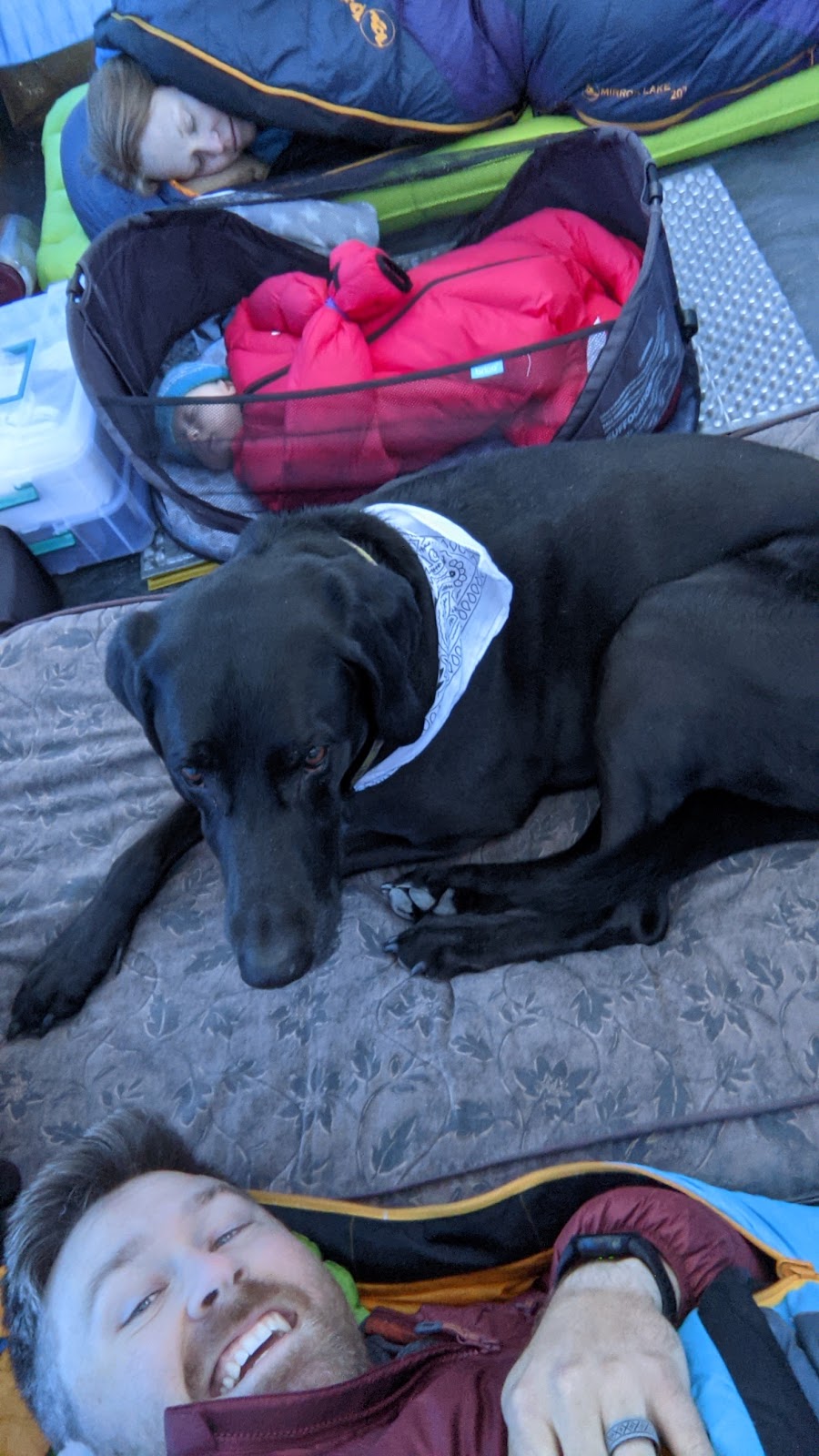
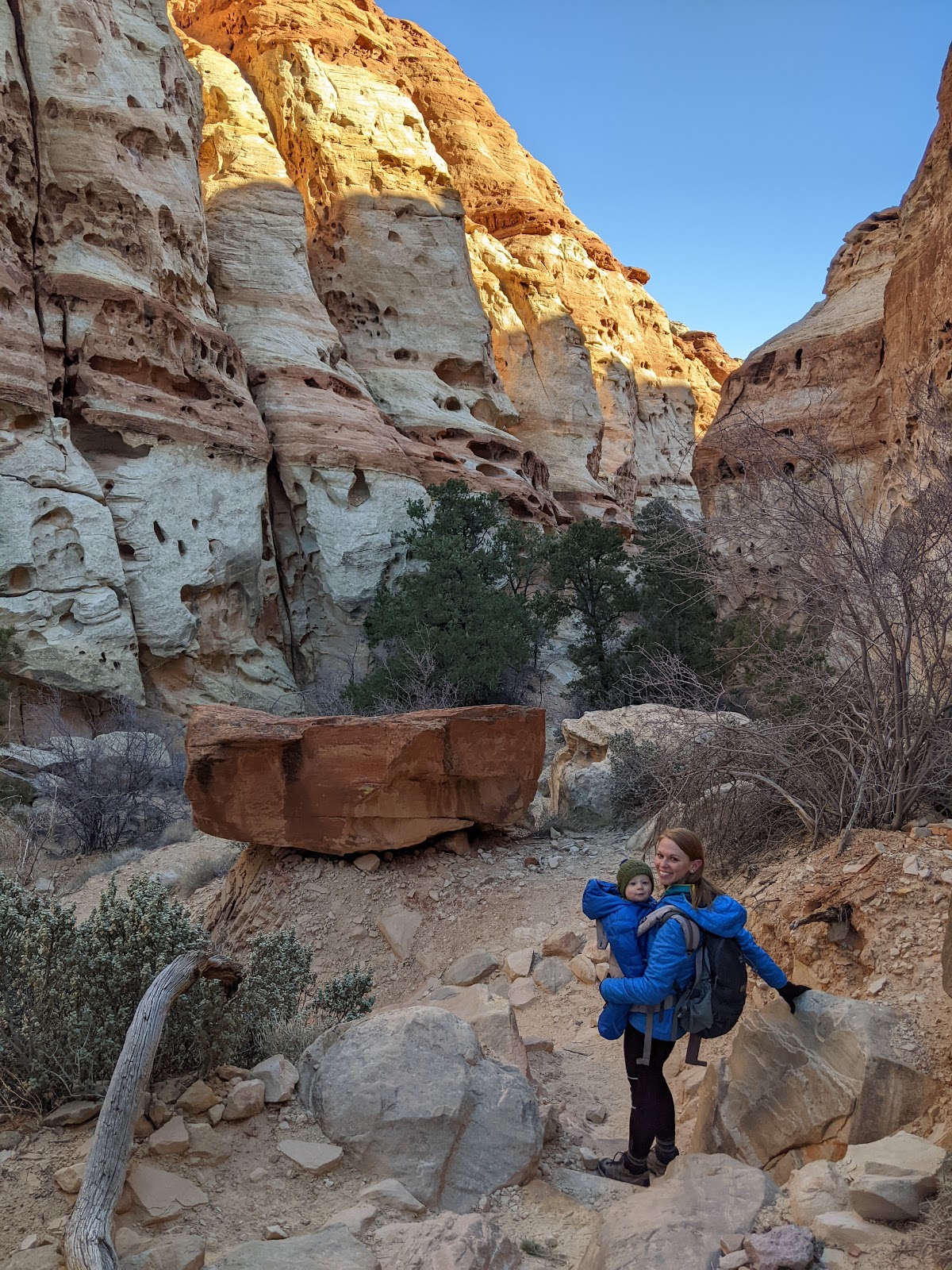
Finally, slot canyons are often way cooler than their surrounding areas. Because they receive less sunlight throughout the day, they become a bit of an oasis from the sweltering heat just above. Definitely consider bringing an extra light layer or wind breaker for your little one (and yourself) if you plan to play in the canyons!
Flash Floods
If you are entering a canyon, especially a slot canyon, pay close attention to the weather…but not necessarily where you are. Watch for rain up canyon from you. Rain many, many miles away can drain into your canyon and put you in danger of a flash flood. While in the canyon, pay close attention to the closest high grounds or places to exit the canyon. If you are not in a canyon but come upon a wash that is flashing, do not attempt to cross, either by foot or by car. Canyons and washes flash most often during the summer monsoon season, so always pay close attention to the weather, speak to rangers about current risks, and heed any warnings you receive.
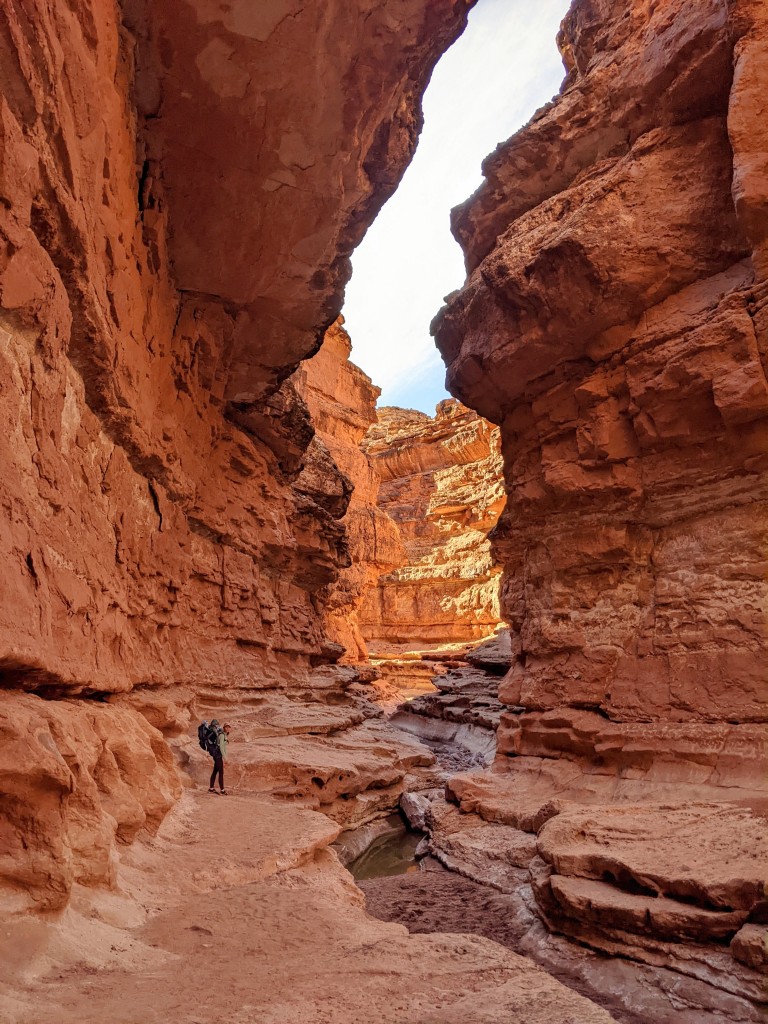
Wind
You don’t want your baby breathing in anything extra besides clean air. That being said, when it gets windy in the desert, sand and dust are picked up and tossed about. Besides breathing in these particles, you and your child can easily get sand in your eyes which can be very irritating. Also, during summer when forest fires in places like California are more prevalent, the smoke and ash are oftentimes brought all the way to the desert by the wind. If the air is too polluted by sand, dust, smoke, or ash, consider an indoor activity that day and hope the wind dies down tomorrow.
How to get outside with baby during summer-Hiking
Getting Outside With a Baby in Summer- Hiking

You might remember when I detailed what it’s like getting outside with a baby in winter several months ago. Now, my son is older, heavier, more awake, and his needs are growing. Thanks to balmy forecasts, we’re getting out more often and for longer periods.
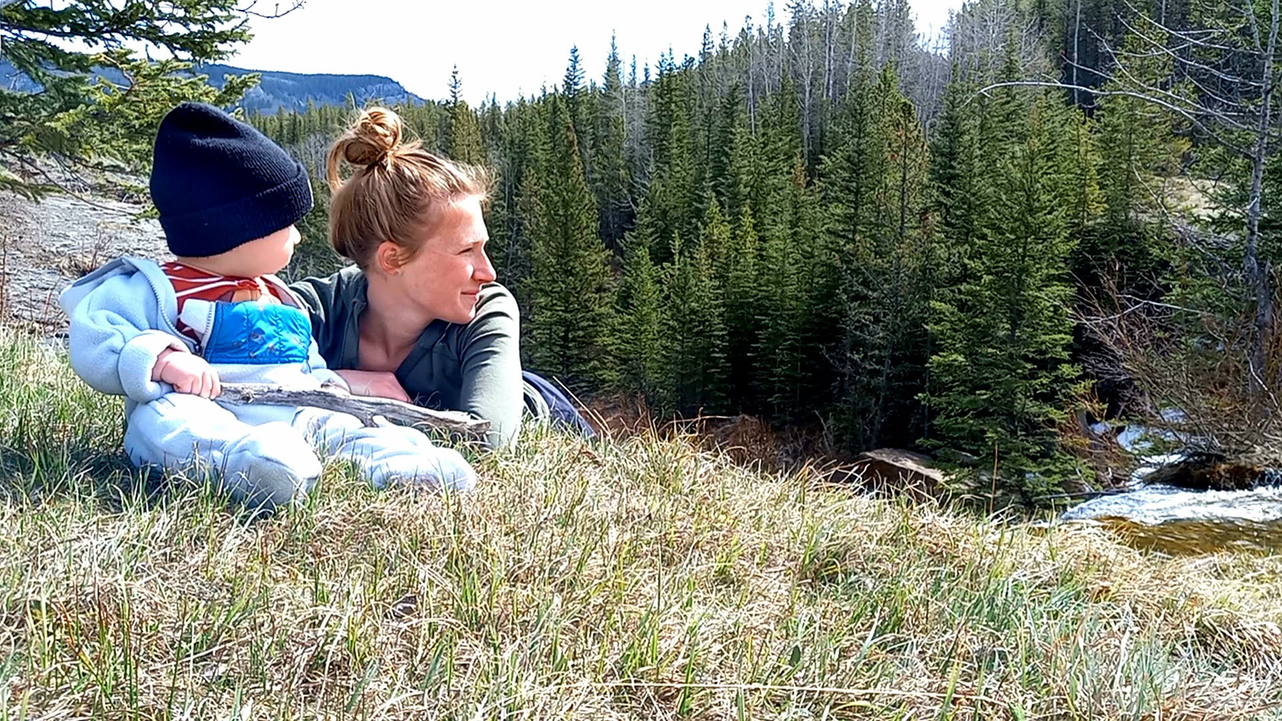
I still pack his fleece bunting (which he still fits, yay for ordering multiple sizes too big). Kiddo’s mitts and knit booties jostled for prominent space with the sunhat and sunscreen in my pack for a long time this year.
Even though spring officially beat Old Man Winter at his chilly games, we still pack a toque. Plus, we’ve added a rain suit to the mix. It works well in cutting those whipping winds and shedding the abundance of cold precipitation Alberta enjoyed this spring and early summer. At the end of June, after a hiking through hot sun and rain showers the day before, we woke up to slushy snow outside the tent.
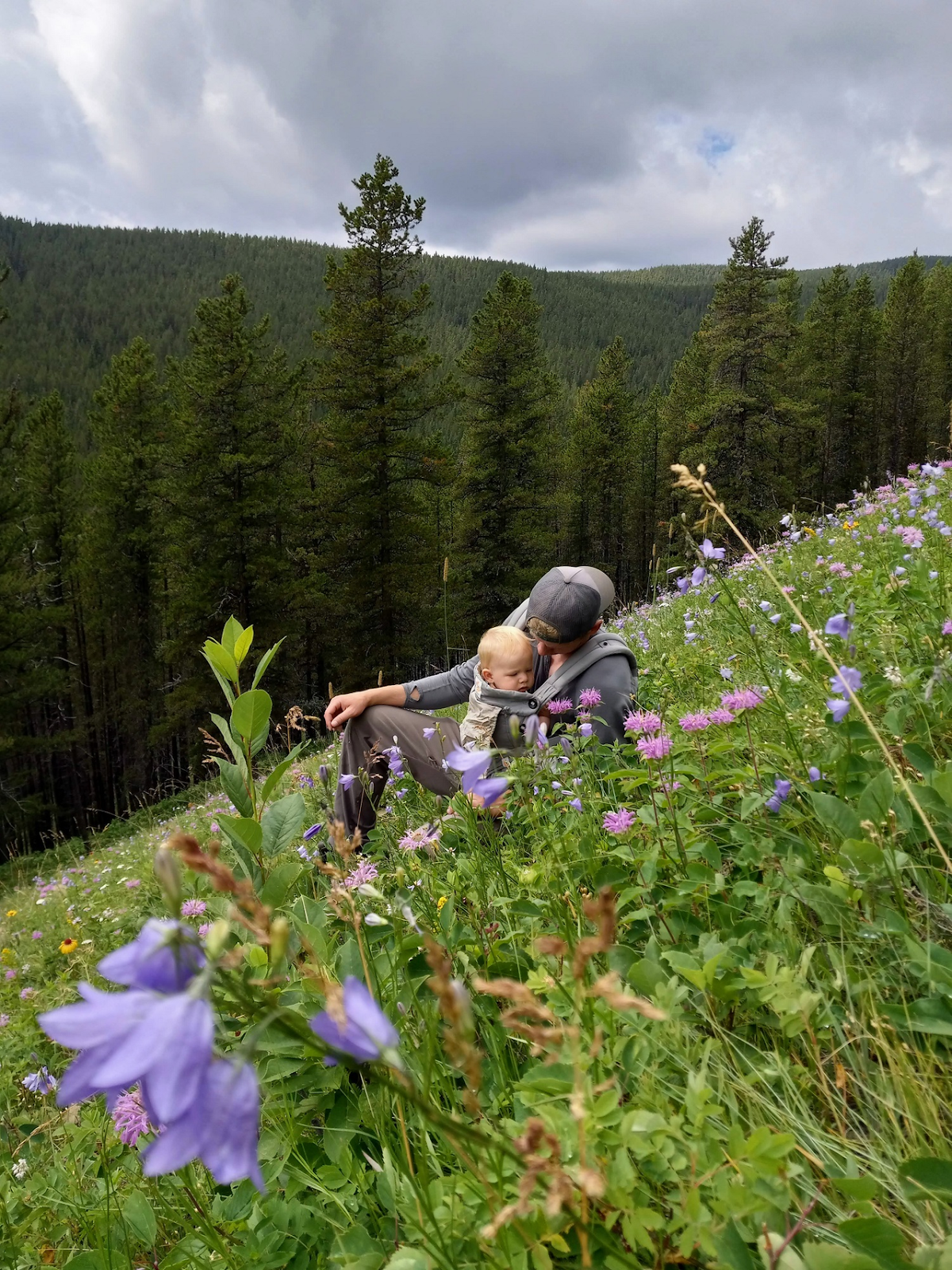
Despite the late spring, the highways into nearby Kananaskis Country are open, and the trails are finally clear of snow. The adventure potential is boundless, even when weighed down by a squirmy 20-plus pounds.
My son is still a good sport on the trail. He alternates between practicing stringing vowels and consonants together, snoozing as we stride through waving wildflowers and grinning up at my nostrils (sans drip thanks to the warm air).
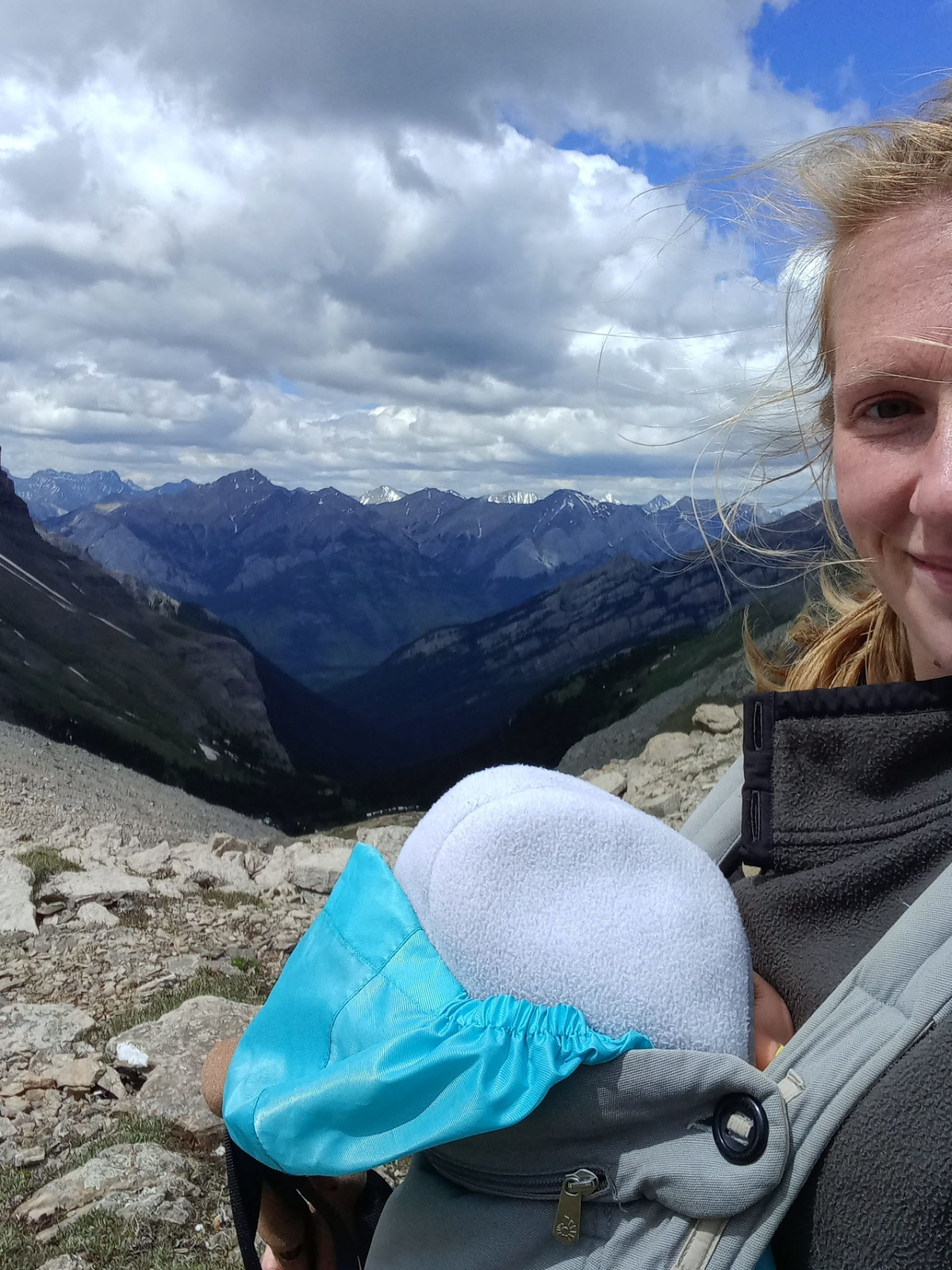
As I tote him up the mountain, my heavy breathing gives him the giggles, and I get a good view of his fresh upper teeth as he tips his head back. I’d laugh, too, if I wasn’t fighting for the air his little body pressed up against my chest is squeezing out.
The Ergobaby carrier we use has worked well so far. It’s comfortable for him and he sleeps like, well, a baby in it. However, when hiking solo, I always wear a pack for snacks, first aid, bear spray and extra layers. With the carrier hip belt and shoulder straps sitting underneath my pack straps and belt, the weight is not properly distributed and ends up riding on my shoulders.
Attempting to avoid shelling out for a backpack carrier right now, we recently purchased a carrier called the Trail Magik. Light, packable and durable, it clips to my pack itself, which, once attached and baby is in, can be adjusted for proper and more comfortable load distribution. It will be perfect for when my son learns to walk and can toddle parts of the trails himself between carry breaks.

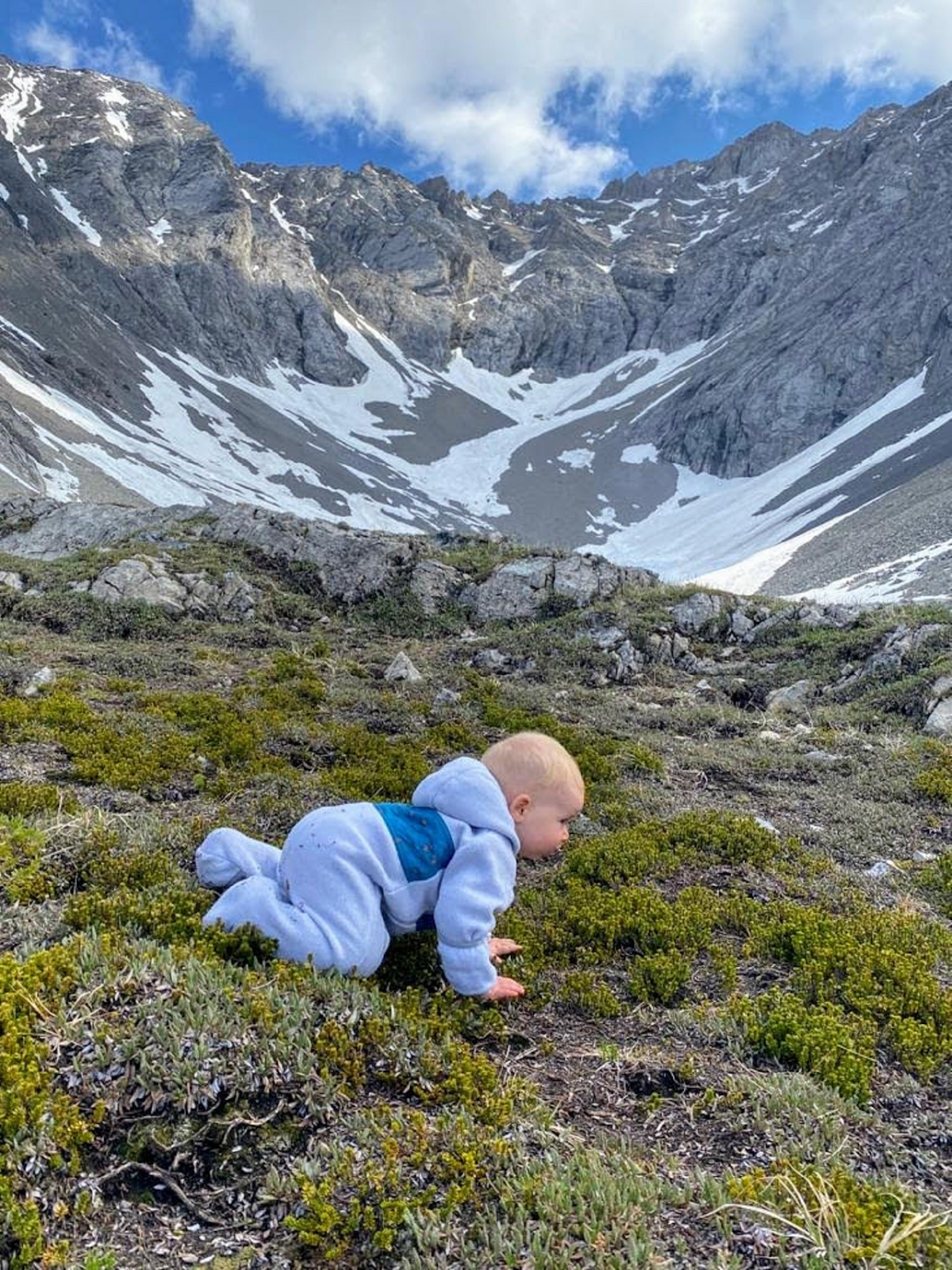
That’s on the next visible ridge, because he is growing and growing up fast. He weaned himself in the spring, so a cup he can sip from must be always accessible and full. I pack Cheerios, raisins or bits of fruit, and puree pouches or cereal, no matter how short the hike is. He’s convinced he’s always hungry and loves food. Wild strawberries are no exception.
The warm weather is ideal for getting out with a little human. At the lake, summit or during breaks he can crawl unimpeded. The world is a big, interesting place for an 11-month-old to explore, and he’s doing his fair share of experiencing it. He chews on leaves, makes mud in his mouth, nibbles rocks and uses anything he can find to stand up. Birds, butterflies, squirrels and bees get his attention, and he now looks where I point.
It’s less stressful knowing diaper changes won’t turn into hypothermia. He’s more comfortable in the carrier with less layers, and his hands are free for thumb access when he gets sleepy.
Concerns about heat and sunburn replace those about frostbite, but if I had to choose one, the warmer weather lets us get out on bigger adventures more often, so I’d take sweat over chilly ears.
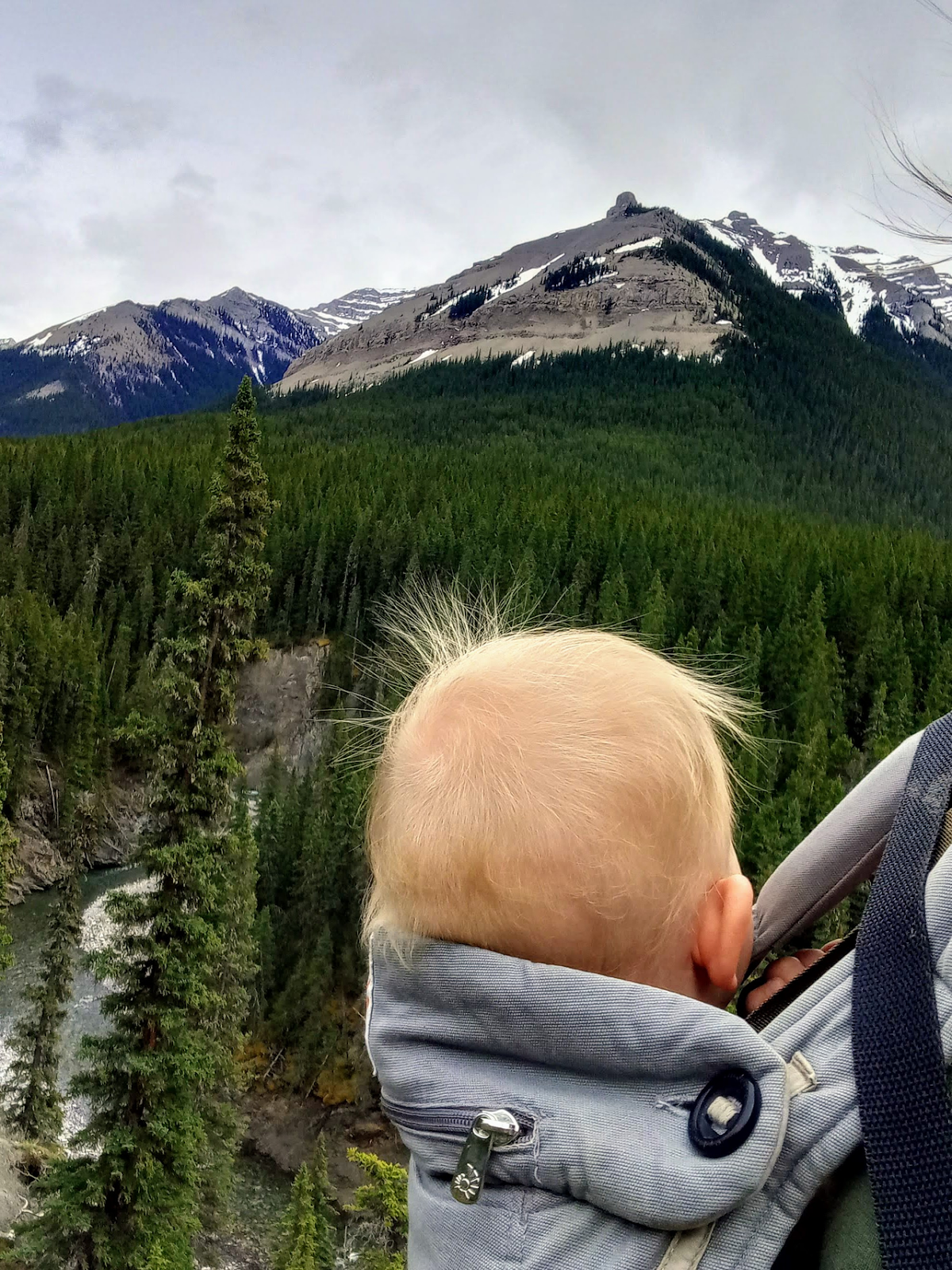

So far, his little North Face sunhat, a cap with an ear and neck cover, has been invaluable. We slather him in sunscreen before heading off if skin will be exposed and frequently offer him his water cup. There are SPF/UPF base layers for kids available (such as those from Iksplor or First Peak) that would help keep his fair skin safe from the sun, but we have yet to purchase those.
Mosquitoes and horseflies accompany warm weather, but between keeping a good eye on any exposed skin and helpful breezes typical of the Rockies, they haven’t been an issue yet.
Our backpacking and camping adventures are more frequent that the backcountry is warm and accessible as well. Even though we try to only take what’s necessary on these trips, backpacking with a baby is not a minimalistic venture. Our packs end up loaded down. His meals, snacks, sleeping arrangement, diapers, wipes and extra layers add weight and bulk little by little.
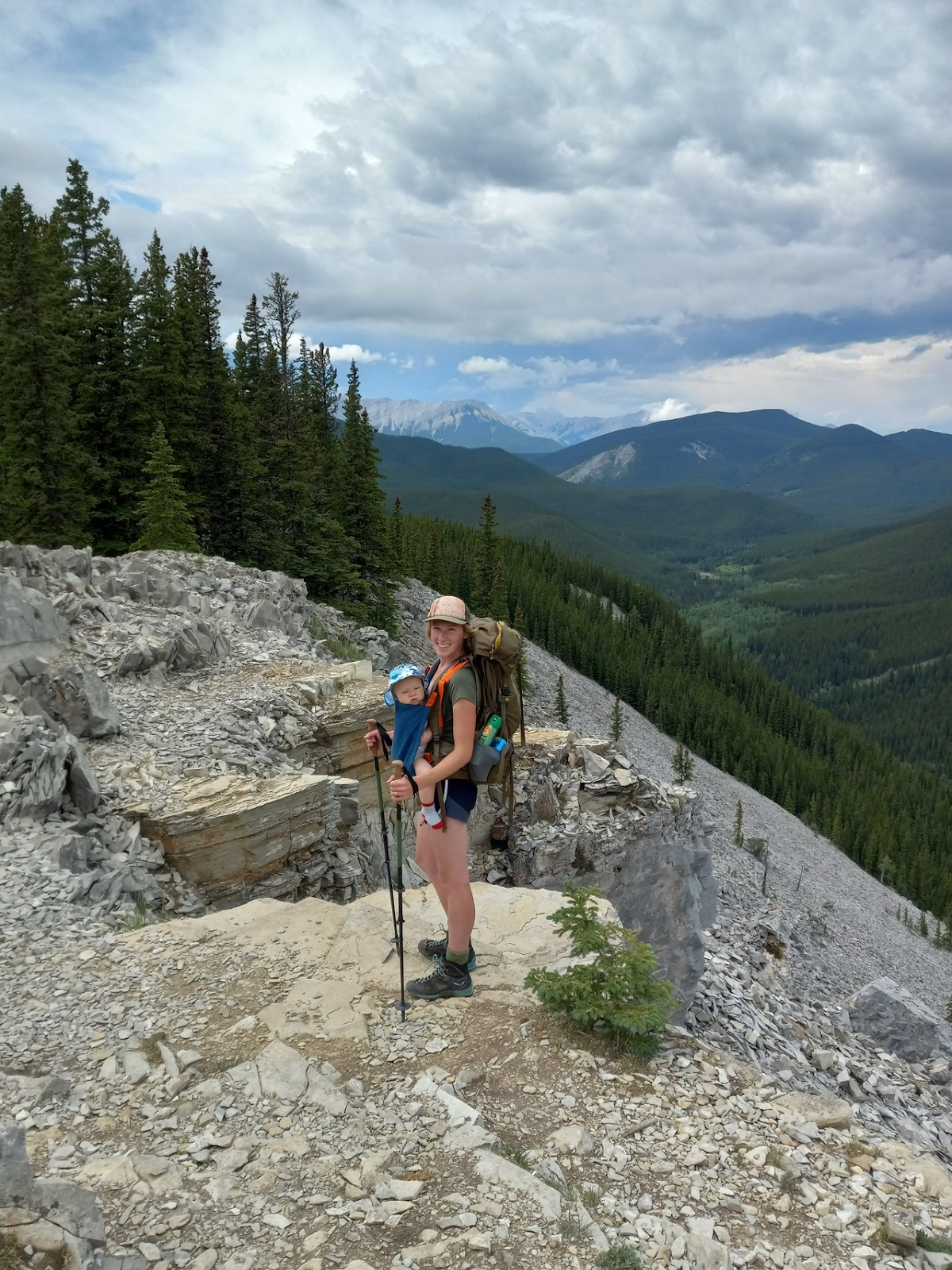
A luxury item I do sneak along is a small, light toy or two, hidden in my hip belt pocket. Usually there are enough rocks and twigs to keep him occupied and happy on the trek, but once inside the tent, a toy helps distract him from crawling over our hound dog while he works out his wiggles. Poor Blue will risk those little gripping hands to not have to spend the night out in the company of a thousand mosquitoes, but his mournful stares as he presses himself against the side of the tent ask, “why are we still bringing this kid with us?”
Why indeed?

Well, the baby seems to love hanging out (literally) with us for hours, cuddling and chatting as we hike, absorbing all the new sights and sounds.
We love the quality and quantity time gulping fresh air as a family.
And just because its hotter, heavier and a little harder, we can’t (and won’t) quit now.
Hiking safely with your baby during Winter
Hiking Safely with Your Baby in the Winter
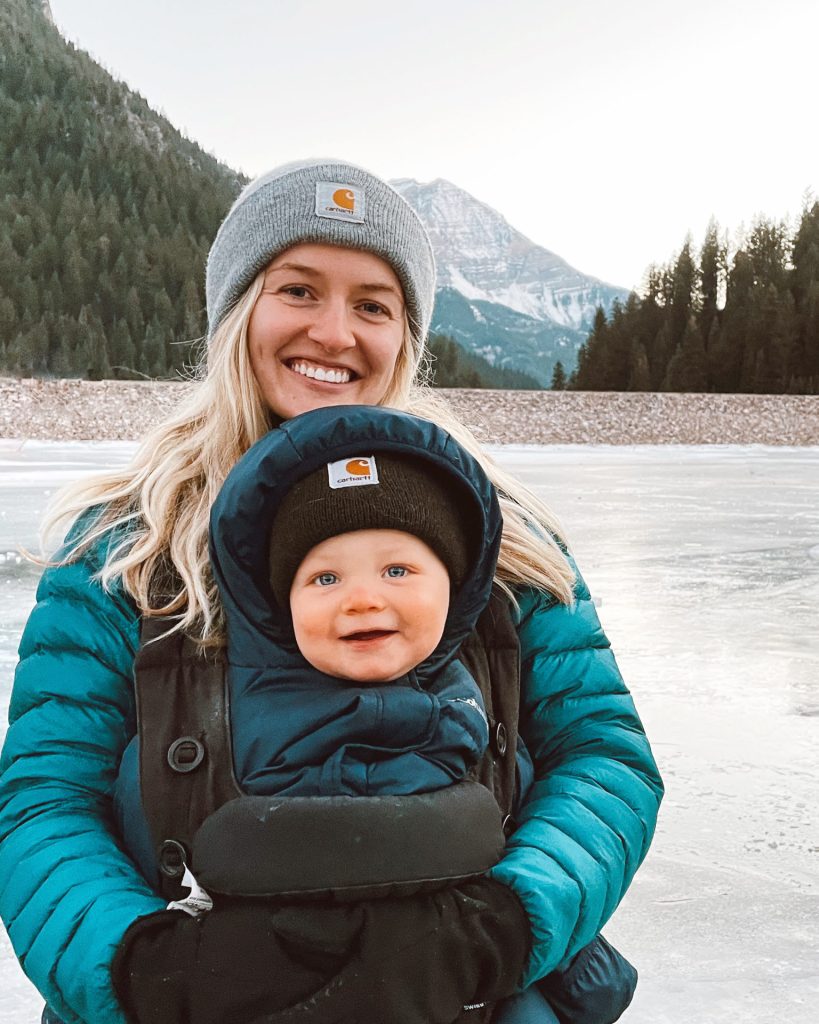
A common concern for parents is whether or not their babies can be outside when it is literally freezing. Well I’m here to tell you that if you prepare and follow some important rules of thumb, then yes! You can absolutely go hiking with your baby in the winter.
Now, I am not a doctor, medical professional, or a hypothermia expert. So make sure to use some common sense and ask your doctor if you have any concerns about your child being out in very cold weather. Always trust your mama gut and don’t feel bad for asking questions!
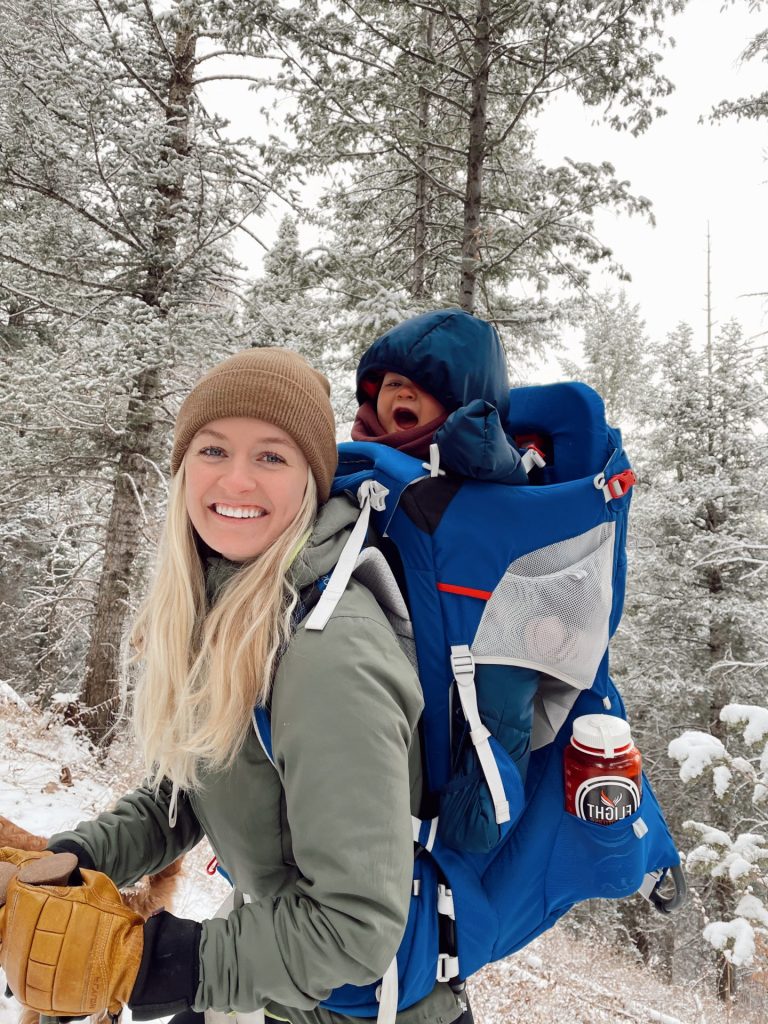
Wear the Proper Layers for Winter Hiking
The number one most important thing to do to keep your baby safe and happy on winter hikes is to dress them in the proper layers. I go over this in-depth in my post
How to Dress Your Baby for Winter Hikes.
Make sure to dress them like you would if you were sitting out in the cold, plus an extra layer.
A base layer, mid layer, and weatherproof layer are the key layers to have.
Don’t use cotton materials. Cotton holds onto moisture, won’t dry, and can lead to hypothermia.
Do not forget a head covering. Babies' heads are a large portion of their body and they can lose a lot of heat from there.
Check on Your Baby
Throughout your hike, check on them to make sure they are warm enough. It’s also important to note that you should make sure they aren’t so warm that they are sweating. If they cool down, you don’t want them to be wet as this can lead to hypothermia.
The best way to check their temperature is by feeling their chest or the top of their back. It should feel warm, not cold or hot and sweaty. Check their feet and hands as well. It’s okay if they are cool, but again, you don’t want them to be really cold or white.

Learn to Recognize Danger Signs
Hypothermia
Hypothermia is a very real danger when going into the backcountry and it’s something that you should be aware of. There are a few key indicators of hypothermia you want to look out for. (I will include the ones that are most helpful when trying to recognize it in a baby)
Shivering
Being very tired and hard to wake up
Bright red, cold skin
If you do notice these signs, take action right away. If you are close to your car, head for it immediately. Make sure to take off any wet clothing. Nurse them if you are able to, as warm fluids will help raise their temperature.
Frostbite-Frostbite is another thing you want to look out for. This most commonly affects the extremities, like the fingers, nose, ears and toes. If you see these areas turning white, do what you can to warm them right away. Hand warmers can be helpful, or just putting the cold areas on your own warm skin will help as well.
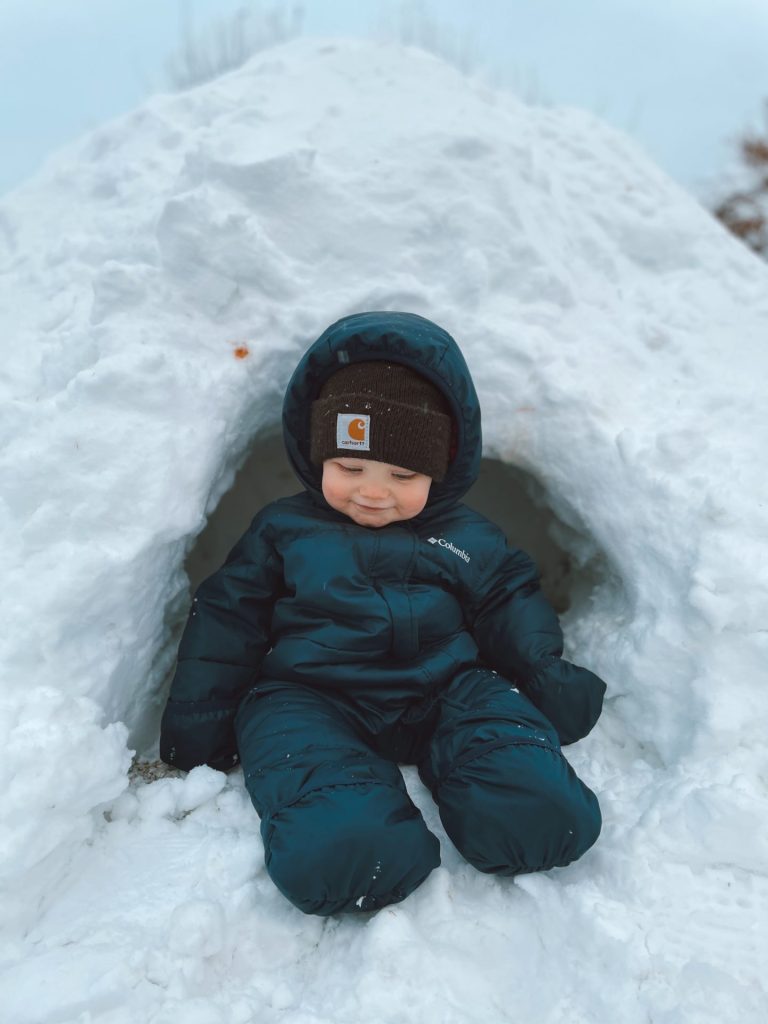
Use Trekking Poles
Since you might be carrying a heavier load than you are used to, your balance might be a little off when hiking. And with the trails being more slippery or icy, you definitely want to protect that precious cargo. I love to hike with trekking poles in the winter, especially when I am carrying my baby. They give me that extra stability and help me power up the trail while carrying the extra weight.
Be Over Prepared when Winter Hiking
When hiking in the winter with your baby, hypothermia and frostbite are real concerns. However, They are concerns you can prepare for and prevent.
Bring extra layers and keep them in your car.
Check the weather before hitting the trail.
And the most important piece of advice- Tell someone (or more!) where you will be going and how long you expect to be gone.
I always like to have extra fleece jammies in the car. Not only is it nice in case I forgot to bring them in the first place, it’s a warm layer I can change my baby into if he were to get wet for some reason. Extra socks are another great layer to bring with you on your hike. They don’t add much weight, but are a lifesaver if their first pair of socks get wet.
If you know what the weather is going to be like, you are setting yourself up for a successful hike. The weather can always be a little unpredictable in the backcountry, so make sure to bring a few things that will help you if it decides to rain or snow on you. I always have our Osprey Poco pack rain cover with us on the trail. Not only does it protect against rain and snow, but also cold winds. It is one of my favorite pieces of gear.
Don’t let fear stop you from hiking in the winter with your baby. You’ve done your research, so now it’s time to follow these tips and get out there!
If you like this post about Hiking Safely with Your Baby in the Winter, check out these posts:
Superscript
3 Reasons to Explore Wild Water with Young Kids
Tips to Keep Everyone Safe and Having Fun
I know that many of you already love exploring rivers and streams with your kids. I know because I’ve seen your pictures. But I’m writing this because if I can persuade just one person that there is something wonderful and unique about splashing around among the gentle rapids of a river, it’s worth it.
Across the river and through a small field, we came to our spot. Shallow water with plenty of rocks and small rapids to explore.

The next hour and a half was spent searching for clams, climbing on rocks, pretending to be snapping turtles, examining wildlife, and generally loving the water.
Moments of natural wonder and feelings of being so incredibly thankful for each other and the ability to appreciate God’s incredible creation.
At least, those were my feelings. They are what I hope are being passed on to my children too.
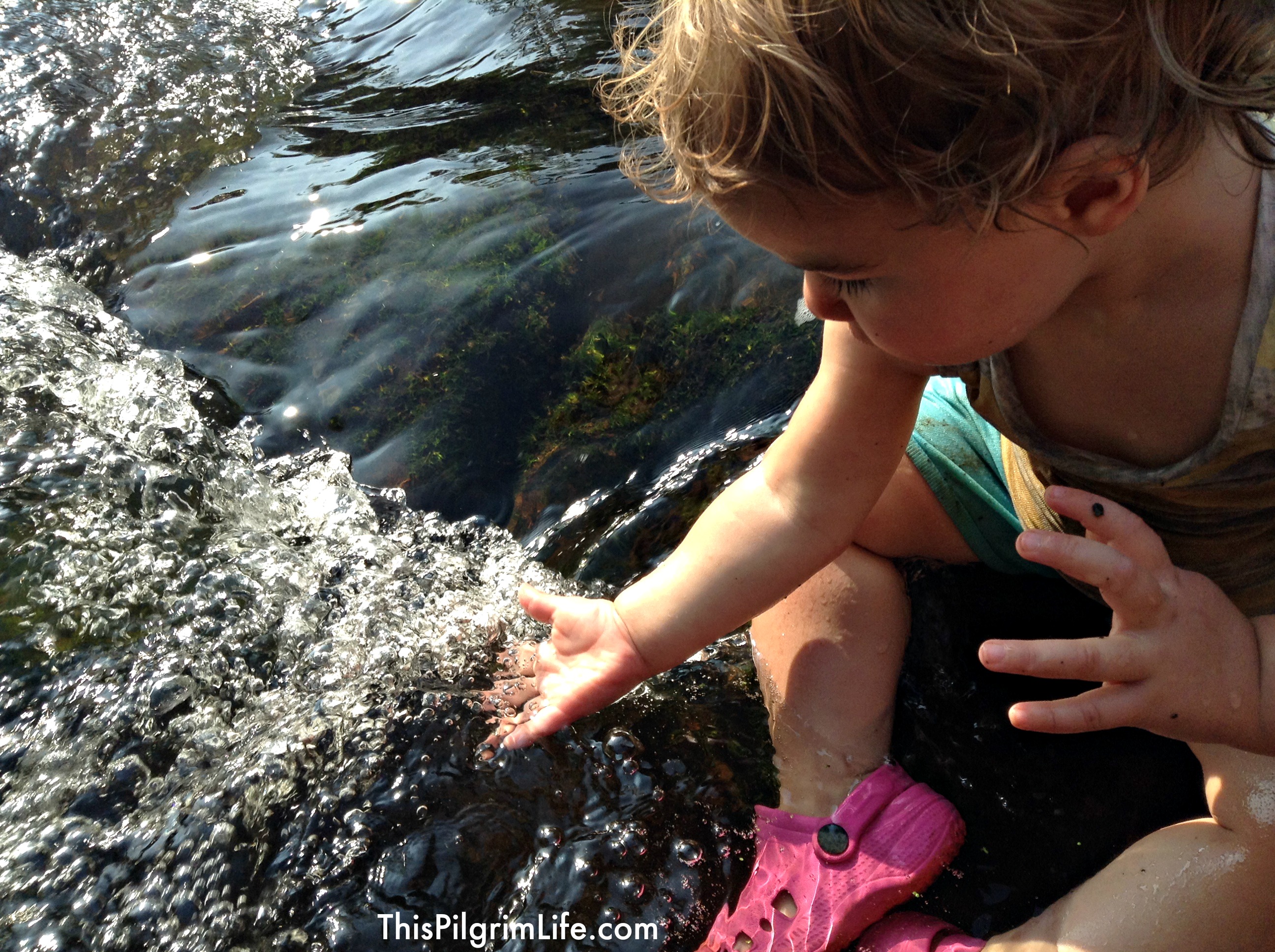
Exploring wild water with our kids is hands down one of our favorite things to do together. We enjoy doing all these things together but there is something intrinsically different about being in the wild, in nature, together.
So while I wouldn’t ever try to persuade you to give up floating around in your local pool this summer, I will encourage you to find some wild water of your own…
3 Reasons to Explore Wild Water with Kids
1. Solitude, scenery, & stress relief
When we arrived at the river yesterday evening, the contrast between wild water and swimming pools was clear. No one was around. The only sounds we heard were the sounds of the water splashing over the rocks and the sounds our children doing the same.
Along with the peaceful solitude of the river is its impressive scenery. Without fail, every.single.time I go out and explore rivers and streams, I’m in awe all over again of the beauty of God’s creation. The sun shining through the trees and reflecting on the water is enough to stop me in my tracks.
Studies have shown that being outdoors in such serenity is proven to be a stress reliever to kids and adults alike. If for no other reason, go out and enjoy the quiet in order to unwind and slow down the normal pace of life for a while.
2. Countless learning opportunities
As my eldest matter of factly stated when we left the river yesterday, there is more to learn about at the river than the pool because nature is there. There is no nature at the pool.
My soon-to-be five year old gets it. From the grasses on the banks to the creatures in the water to the herons in the air. Everywhere you look, there are things to admire and examine. You just have to look.
Start by simple playing and exploring freely, no pressure to make great discoveries, and learning opportunities will inevitably present themselves. Whether or not you do anything more at home, the simple act of looking and talking is a great boon to your child’s education.
3. Greater strength and agility
Yesterday I watched my toddler standing upright in the shallow areas of the river, bending down to dig up clam shells, wading through the water, and climbing up on the rocks around her. This is just her second or third time on her own in the river.
I saw my three year old confidently crawling across rocks and over small rapids, pretending to be a turtle and using both his hands and feet to carry him safely through the water.
My tall five year old, the most capable and confident in the water of my three children, is learning how to walk sure-footed through the water. To avoid the slick rocks and to catch his balance when he doesn’t.
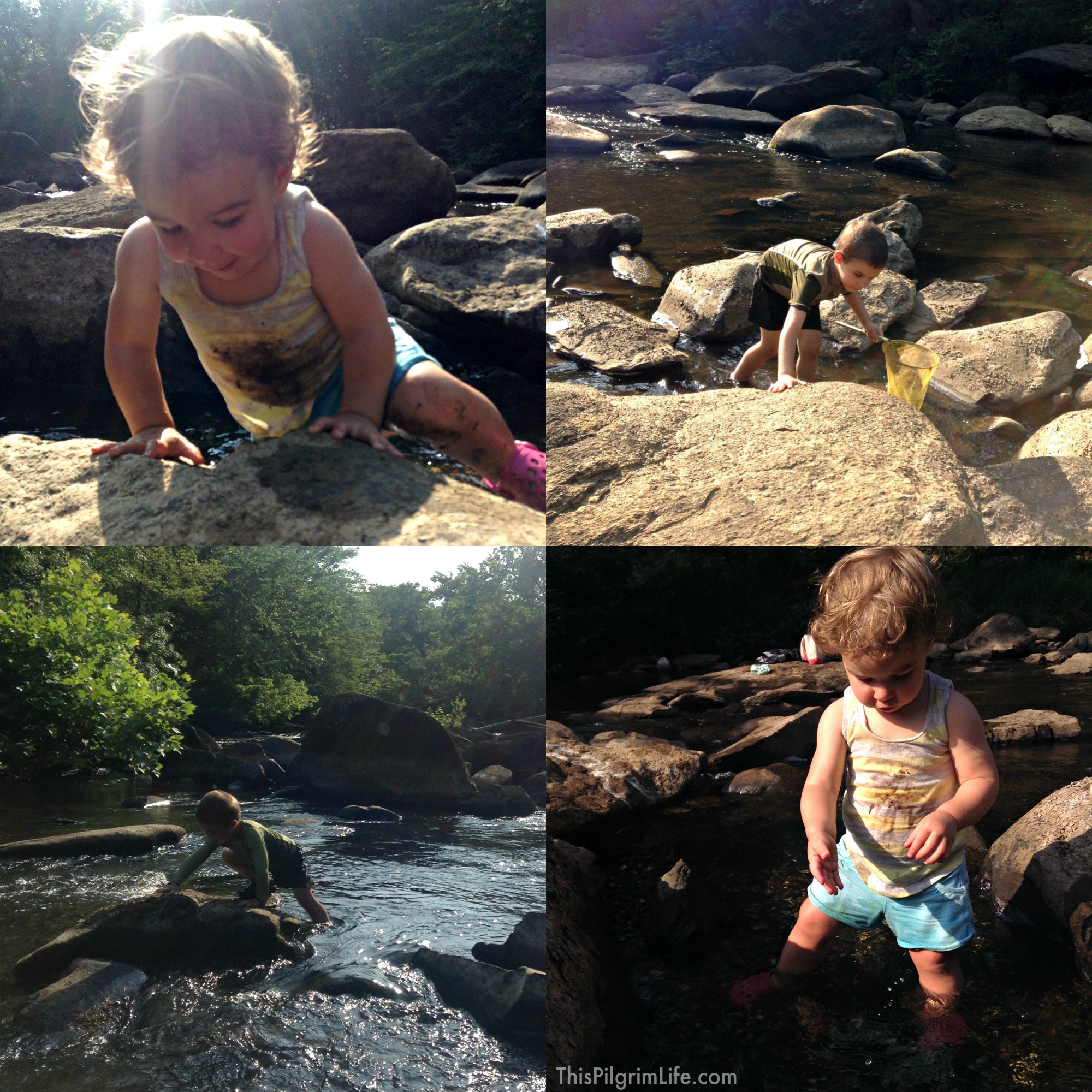
Our kids are learning from us to be safe in wild water and they are gaining more ability and confidence each time we go.
“When going on outdoor adventures, the temptation for many is to rope off hazardous areas and create a “safe” zone for their children. But never for a moment think that you can childproof the wilderness. It can’t be done. What’s more, it shouldn’t be done. Children learn to safely interact with wild places by interacting with them. Even toddlers...”
–Babes in the Woods
Tips to Keep Everyone Safe and Having Fun
Wear the right shoes.
Leave your flip flops at home and stick to shoes with toe and heel straps, as well as a good sole. Bonus points for shoes that protect your toes. Our boys live in KEEN sandals during the summer and we have never been disappointed in them.
Look for good access to avoid steep banks.
Find a spot on the bank that will be safe to get down and to climb back up when are all wet and tired.
Let an adult wade first.
If you are in an area that is new to you, wade out first before your children to check for any drop-off or especially mucky areas in which they might sink.
Drink lots of water.
Any time you are out in the sun is an important time to drink lots of water. But often being in the water makes us think we aren’t really thirsty. Be sure to drink water and encourage your kids to drink water whether or not you feel like you need to.
Wear old, fast drying clothes.
I have a stash of fast drying shorts and rash guard shirts that I have found over the past couple of years at Goodwill reserved for the times we are out in wild water. My kids can get dirty without concern, and I know that they will be comfortable for whatever activity they do.
Bring: nets and a container for treasures.
Nets aren’t really essential when hands will do just as well, but having a small bag or pail to store a few found treasures in is. Being able to bring home a few interesting finds makes the trip more special and opens up more opportunities for identification in field guides and recording memories in nature journals.
Don’t bring: valuables or anything not meant to get wet.
Leave most valuables at home or in the car. If you need to bring a phone, keep it in a safe place on the bank (not in your pocket!). You don’t want to be worried about getting it wet if you accidentally slip or be encumbered from really playing with your kids.
Be observant.
It is good to be aware of what poison ivy looks like and what potentially harmful snakes live in your area so that you can avoid both if need arises. We have seen both and have never had a problem with either. I will share more on both in an upcoming post, but for now, just remember that snakes generally do not want to be any closer to you than you want them to be. Any snakes we have seen have been quick to get away as soon as we approach.
Have a Safe but Fun Lake Trip with your Baby
How To Have A Safe Lake Trip With Your Baby

Table of Contents
Purchase an infant PFD (personal floatation device)
Safeguard against dehydration
Avoid Peak Sun Exposure
Find a location with shade
Protect their skin when in the sun
Protect their eyes
Purchase an infant PFD (personal floatation device)
A popular lake day activity is boating. While babies are able to board, they too must follow the state laws. Most states require that everyone on board have a PFD. The Stingray Infant PFD is a great choice because it is US coast guard approved and uses bright colors so your baby is easily visible. In addition to these necessary features, this life jacket is made from a durable and quick-drying Nylon fabric with quick-release buckles.
Even if you don’t have plans to boat, it’s best for a baby to wear a PFD anytime they are in the water.
Lifejackets- Babies under 35 pounds are not big enough for a baby lifejacket. They can suffocate if they slip inside the lifepreserver without you knowing.
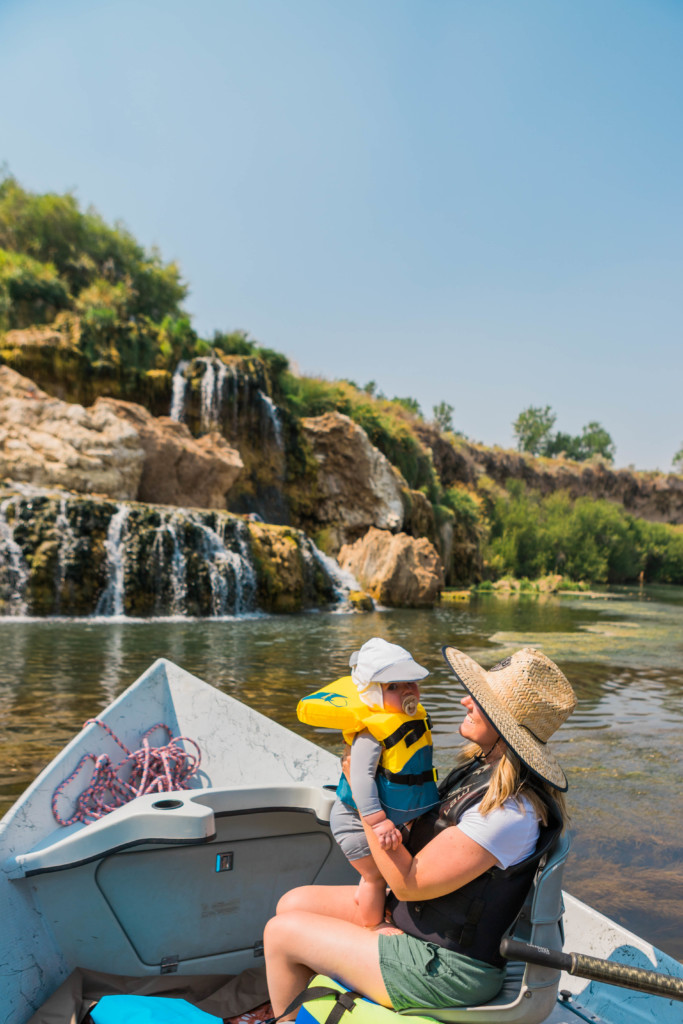
Safeguard against dehydration
During a hot day, it’s easy for adults to dehydrate quickly. This is even more true with infants. Come prepared with extra bottles or plan to nurse more frequently if currently breastfeeding.
If your baby has reached the age where they can start eating solids, consider bringing a couple of servings of food that are travel-friendly. A great example of this is fruit/veggie pouches.
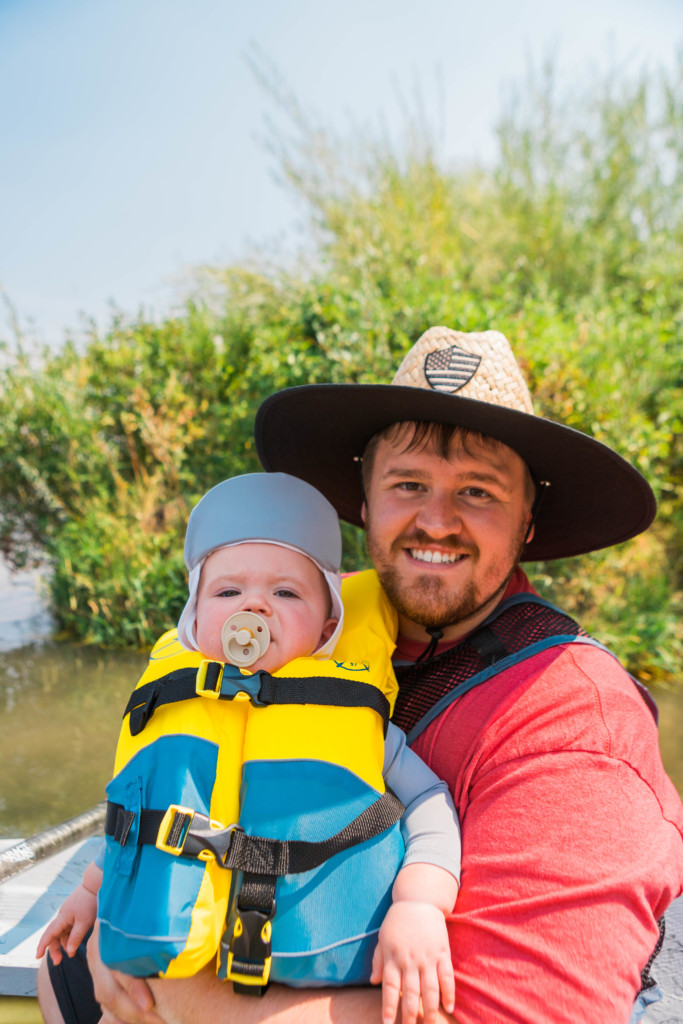

Read more- How To Successfully Vacation In Ft. Lauderdale, Florida With A Baby
Avoid Peak Sun Exposure
A lake day might look a little different with an infant because of the fact that you’ll want to avoid peak sun exposure. These hours generally fall between 11 a.m. and 4 p.m. Getting an early or late start to the day might also be a great way to beat the crowds! If you can’t avoid these harsh, daylight hours, read below for some additional tips.
Find a location with shade (or take shade tents)
One of the first things you’ll want to do when getting to the lake is finding a great spot with plenty of shade. No sunbathing for the baby! In addition to finding natural shade given by trees, feel free to bring a sun canopy or umbrella that has UPF protection. Trust us, keeping cool not only protects their delicate skin, but it will help with their mood!
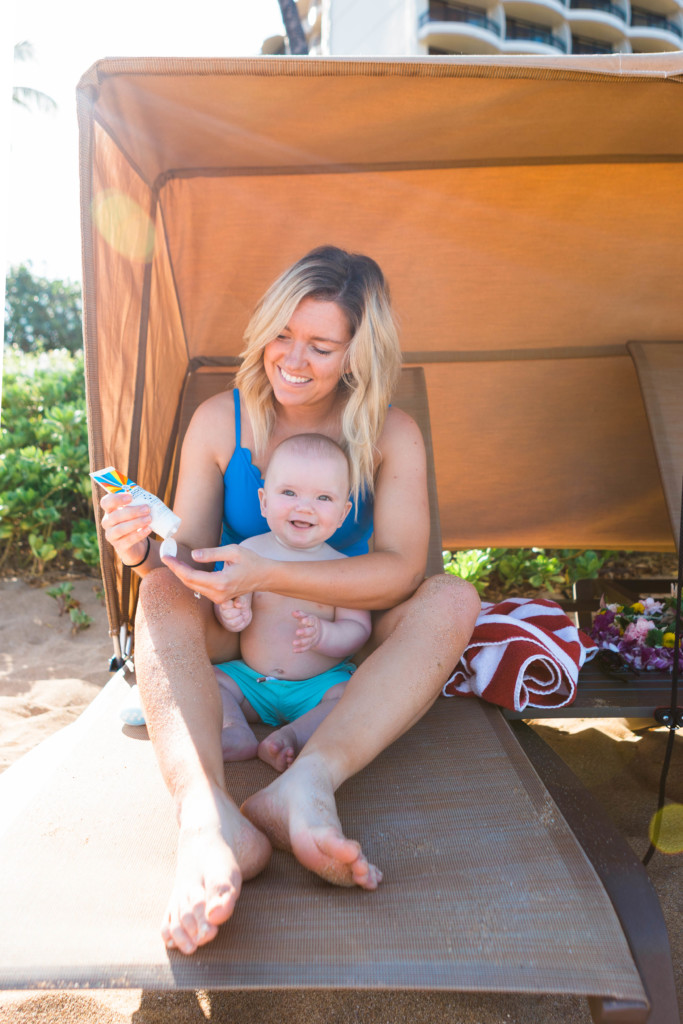
Protect their skin when in the sun
You probably don’t want to hide out in the shade all day at the lake. This is when you need to be especially careful about sun exposure. The US FDA recommends avoiding sunscreen for infants that are under the age of 6 months. Choose UPF clothing that covers them as much as possible. In addition, always keep a sun hat on your baby that protects not only the tops of their heads but the back of the neck and ears.
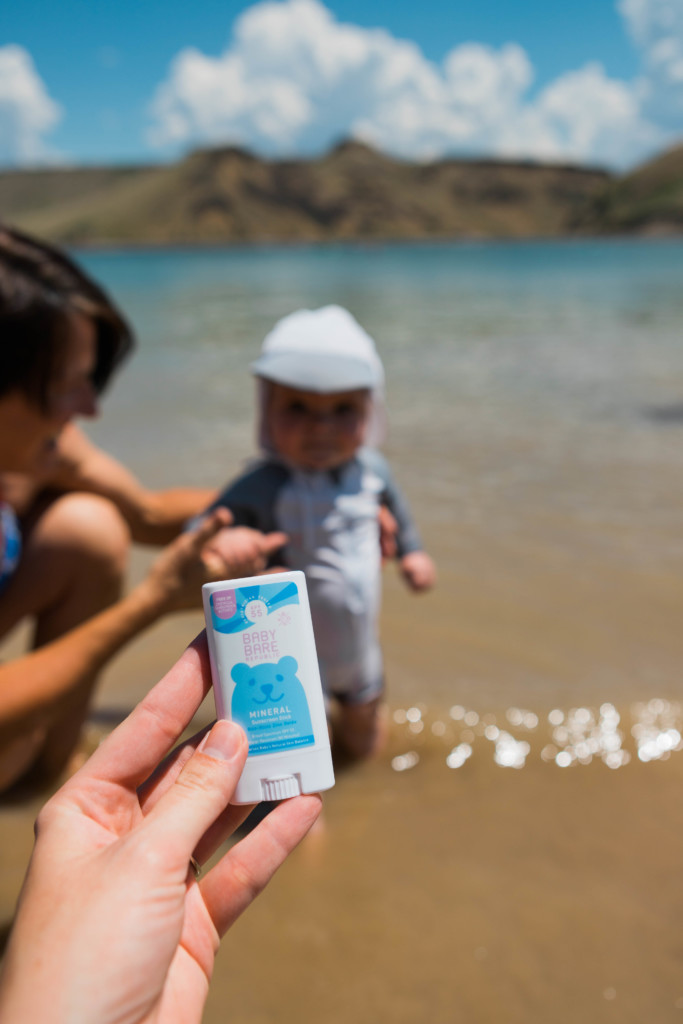
Read more- Baby Travel Essentials For 0-12 Month-Old Babies That Will Save Your Vacation
Protect their eyes
While baby sunglasses don’t seem to be the most practical item to bring to the lake, they can be very helpful! Recent reports have suggested that babies’ eyes lack the ability to block UV rays to the same degree that grown adults can. These may be foreign for a baby to wear so practice several days before getting your baby used to feeling them on.
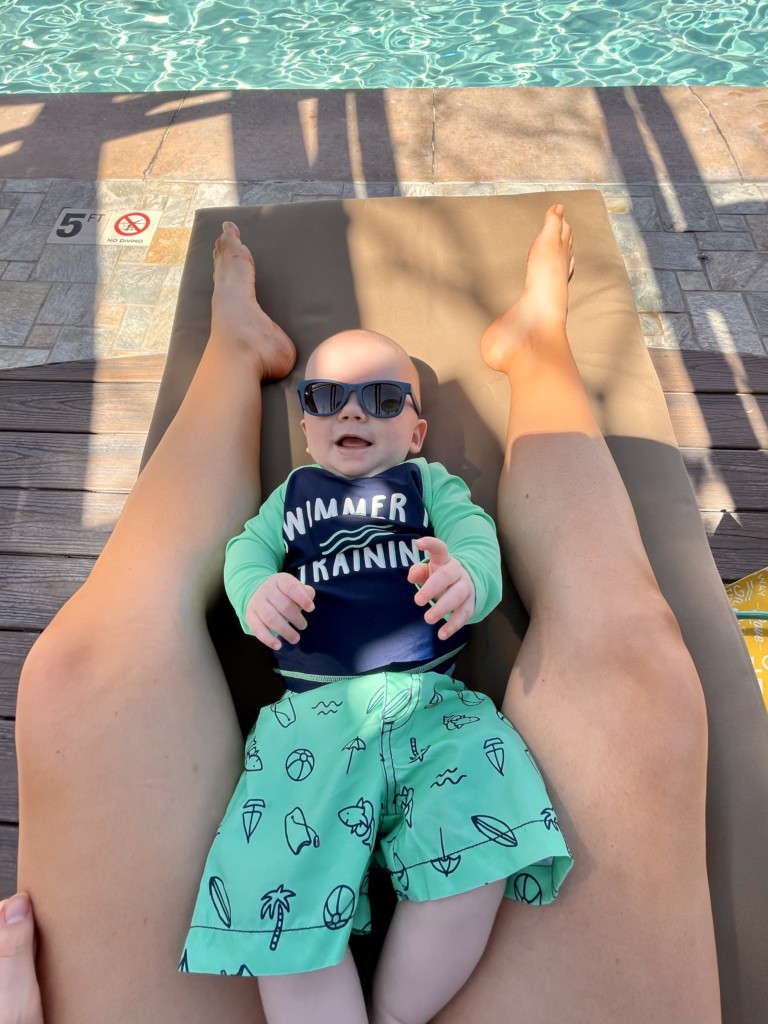
Wind Direction Watcher
Build this wind direction watcher and you'll be able to see the wind blow!
What You'll Need:
Piece of cardboard
Marker
Tape
Small mirror
Compass
Swoooosh! There goes the wind ... and now you can see it!
Step 1: Mark out north, south, east, and west on the outside edge of a piece of cardboard. Include other directions, like northeast, if you like.
Step 2: Tape a small mirror to the cardboard so that the compass directions form a circle around the mirror. Now you're ready to chase the wind!
Step 3: Place your cloud chaser on the ground so it faces north. You can do this by matching north on your cloud chaser with north on your compass.
Step 4: Lie next to your cloud chaser and watch the reflection of the clouds in the mirror. Once you see which way the clouds are moving, you'll know that's the same direction that the wind is blowing.The next activity is sure to give your imagination a workout.
Creek or Streamside Adventure for Babies
Streamside Sensory Play
This post is all about turning a visit to your local stream into a sensory experience for the kids. Creeks and streams are full of amazing opportunities for kids to get immersed (literally!) in nature. Playing in or near a stream is not only a learning experience about the natural world around them, but it’s also a chance for kids to get wet, muddy and have a lot of fun! We’ve already covered all the amazing benefits of letting your kids play in the creek. Today, we have Brooke Selb from wreckingroutine.com sharing the benefits of streamside sensory play and how her family enjoys their local creeks and streams.
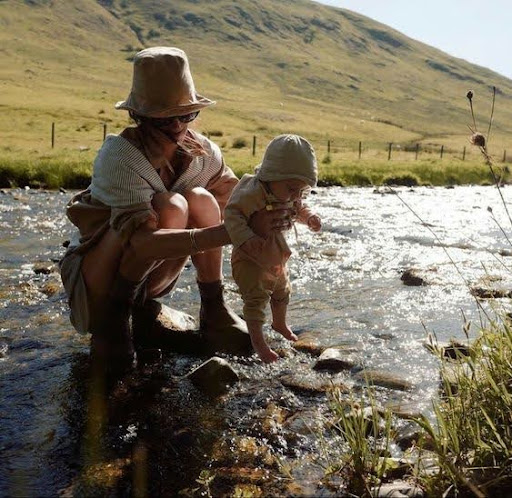
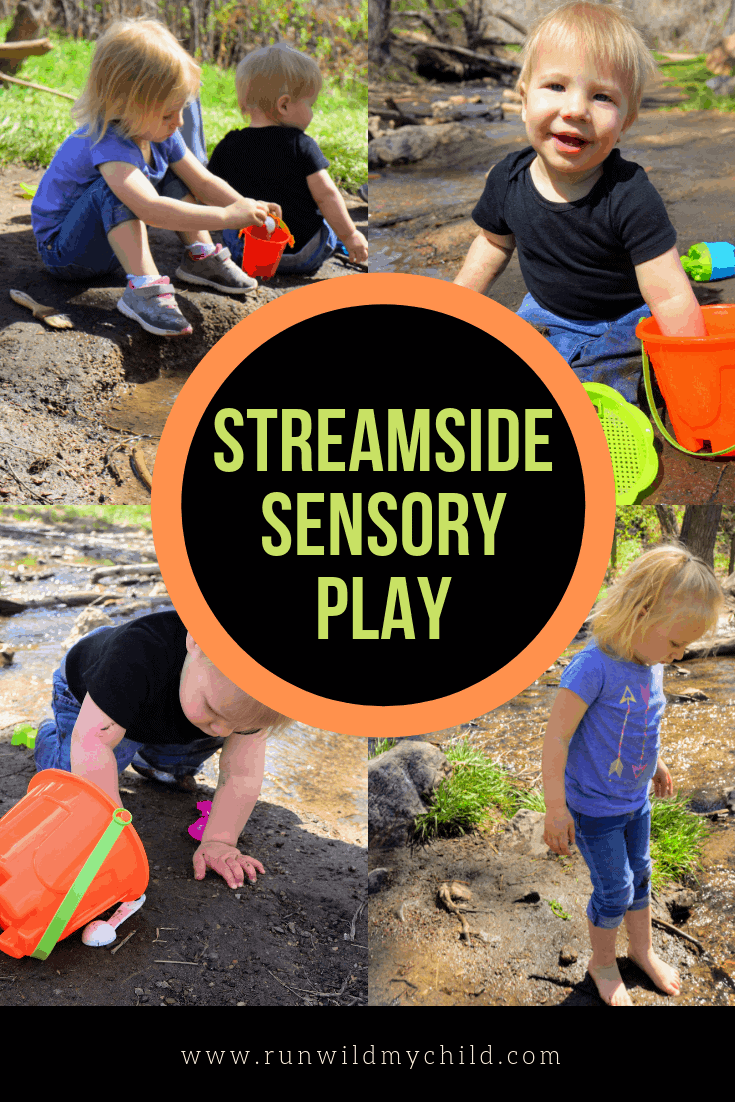

Trading the hikes for a stream
With two kids under the age of three, our days of hiking double-digit trails on a Saturday morning are no longer realistic. While our kids do pretty well on the trail, we are capping out around three miles. In fact, during our spring break staycation, we hiked two miles in mildly windy weather and both kids cried the entire time! Not the relaxing hike we envisioned.
However, both my kids (Hope and William) absolutely adore sensory bins of any kind (think rice, beans, dried pasta, and shaving cream). They also love being outdoors (just like their mom and dad). So, we combined those two things into something fun and took the arduous hikes out of our routine.
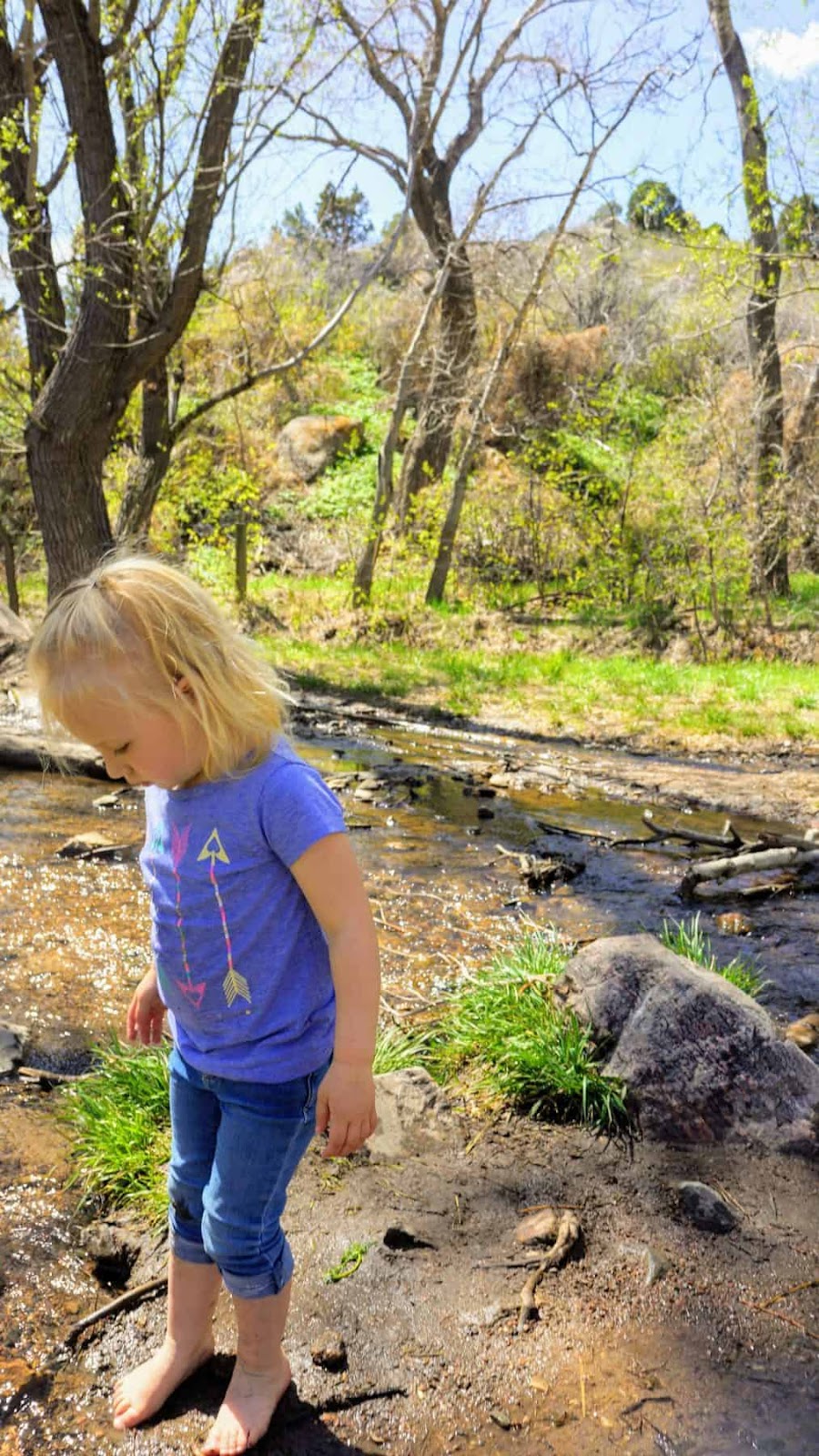

Streamside sensory play
Streamside sensory play is the perfect activity to get us all outdoors. We get to discover more about our surroundings, learn about local nature, and get messy. When I first realized how much Hope loved this type of play, we ended up venturing out to our nearby streams at least once a week. Now that the weather is warming up, we are back to it! Our girl could not be happier to share her love of outdoors and water with her younger brother.
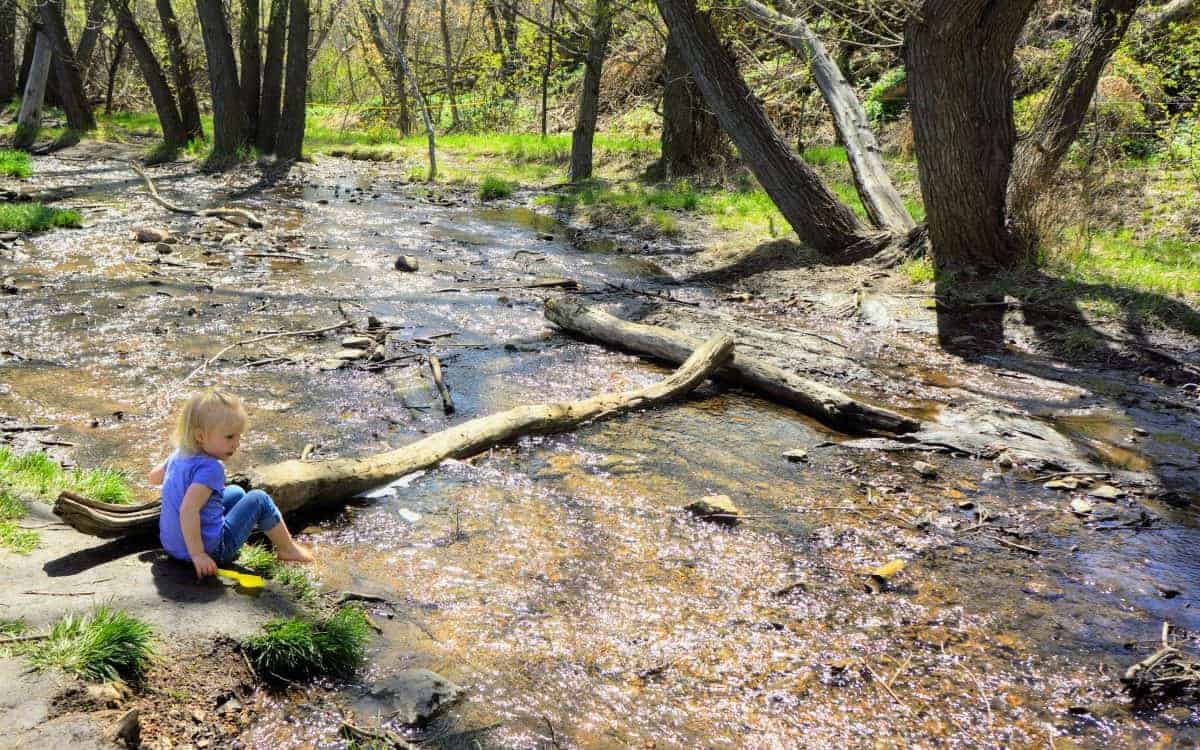
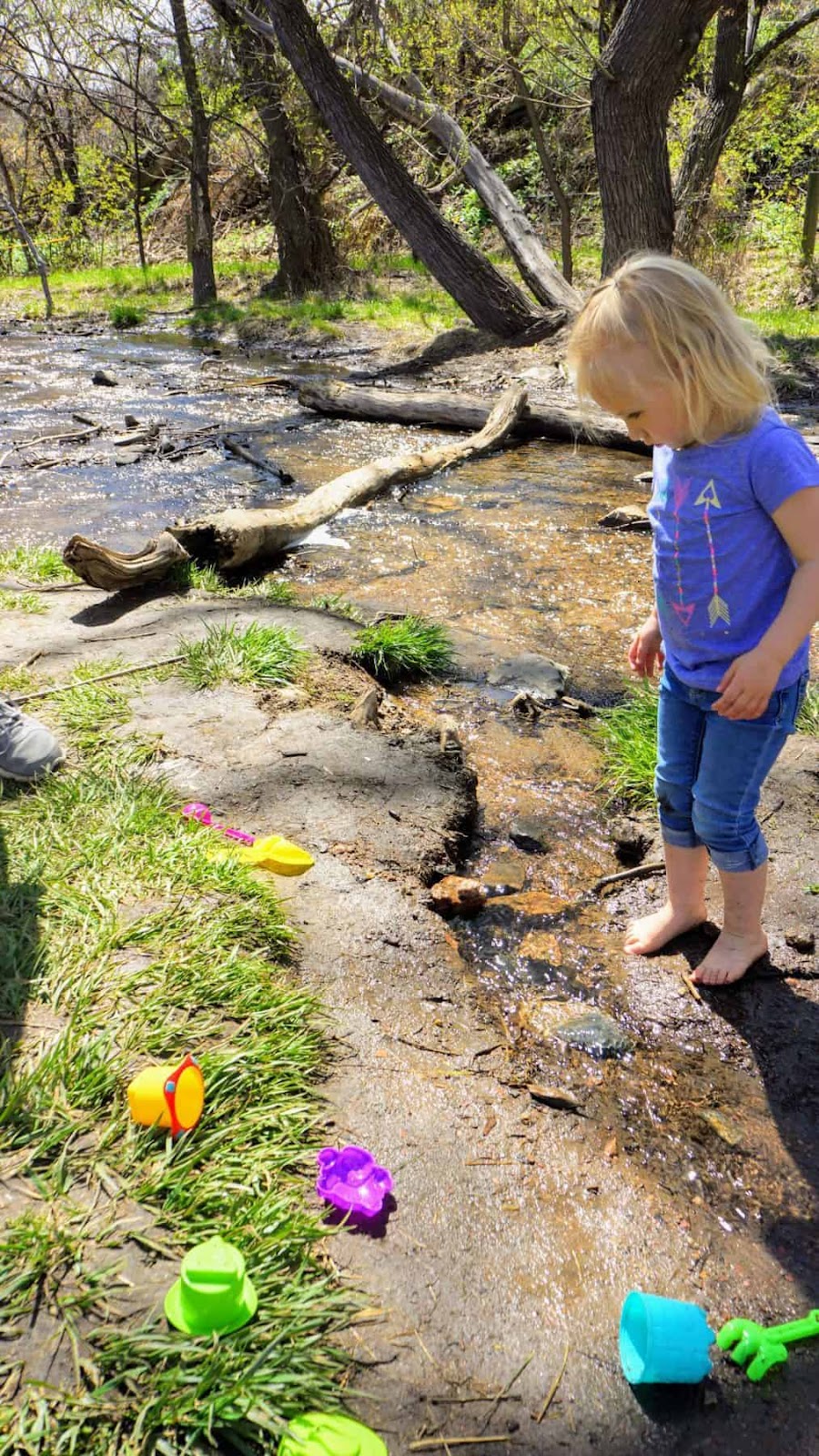
How to choose a good spot
I have found a few spots near our house in Colorado that are perfect for streamside sensory play. Some things that I look for in a good location are:
A flat and level area next to the stream. This prevents the kids from having to reach down into the water from slanted ground, which can lead to falls. We also look for flat areas so we can put out a blanket for William to sit on or as a place to rest and have a snack.
Location with a variety of textures. We like areas where the kids can get wet and muddy, with rocks or trees nearby. Gathering rocks and sticks to use in the water is all part of the fun!
Slow running water. I like the water to have a little movement. Not only does it help keep the bugs away, but it ensures that the water is not stagnant or smelly. Although, do not choose a spot with too much movement because when the toys inevitably slip out of wet hands, you want to be able to snag them before they get downstream too quickly.
Shallow water. The kids love getting in the water as much as possible, so shallow water helps me ensure they’re safe.
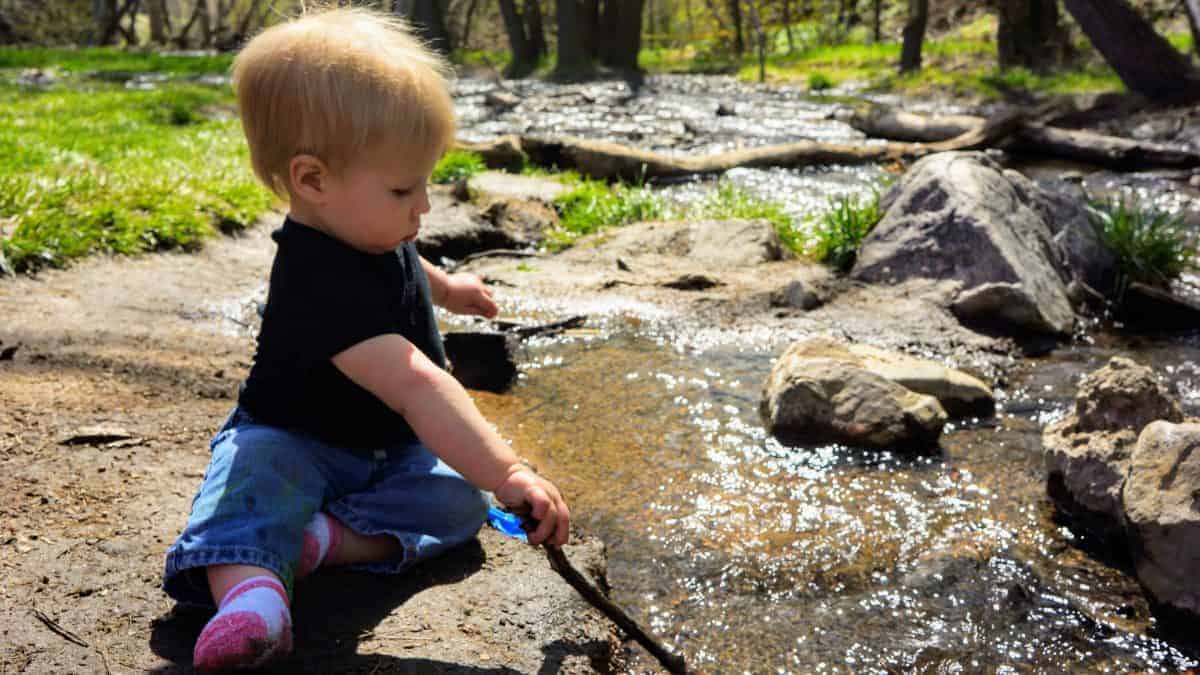
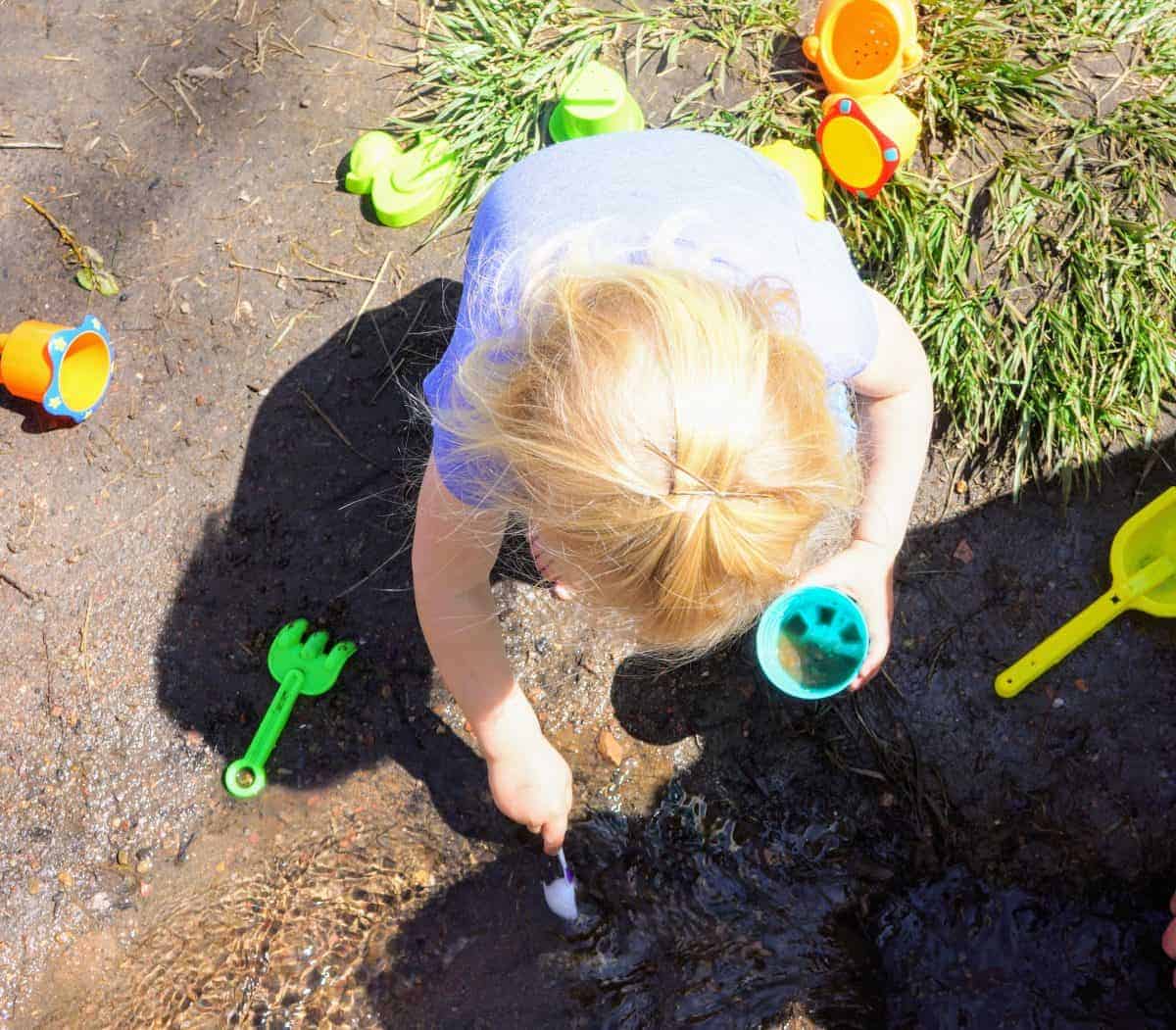
How to play streamside
This is the best part…there are no rules! Just let them at it! Hope is good at digging, scooping, and dumping. There is no end to what you can do waterside: putting pebbles in buckets, making mud pies, building sand castles, splashing in the water with her animal figurines, chasing/catching minnows, and changing colors of dry rocks once they get wet.
Getting wet is a must in the hot months and playing in a stream is a great way to cool off and immerse yourself in nature. Playing in the stream allows all your senses to be stimulated. From the smell of the surrounding woods, to the cool touch of the water and the sound of the babbling stream. I let Hope take off her shoes and socks and squish her toes around in the mud. She giggles the whole time!
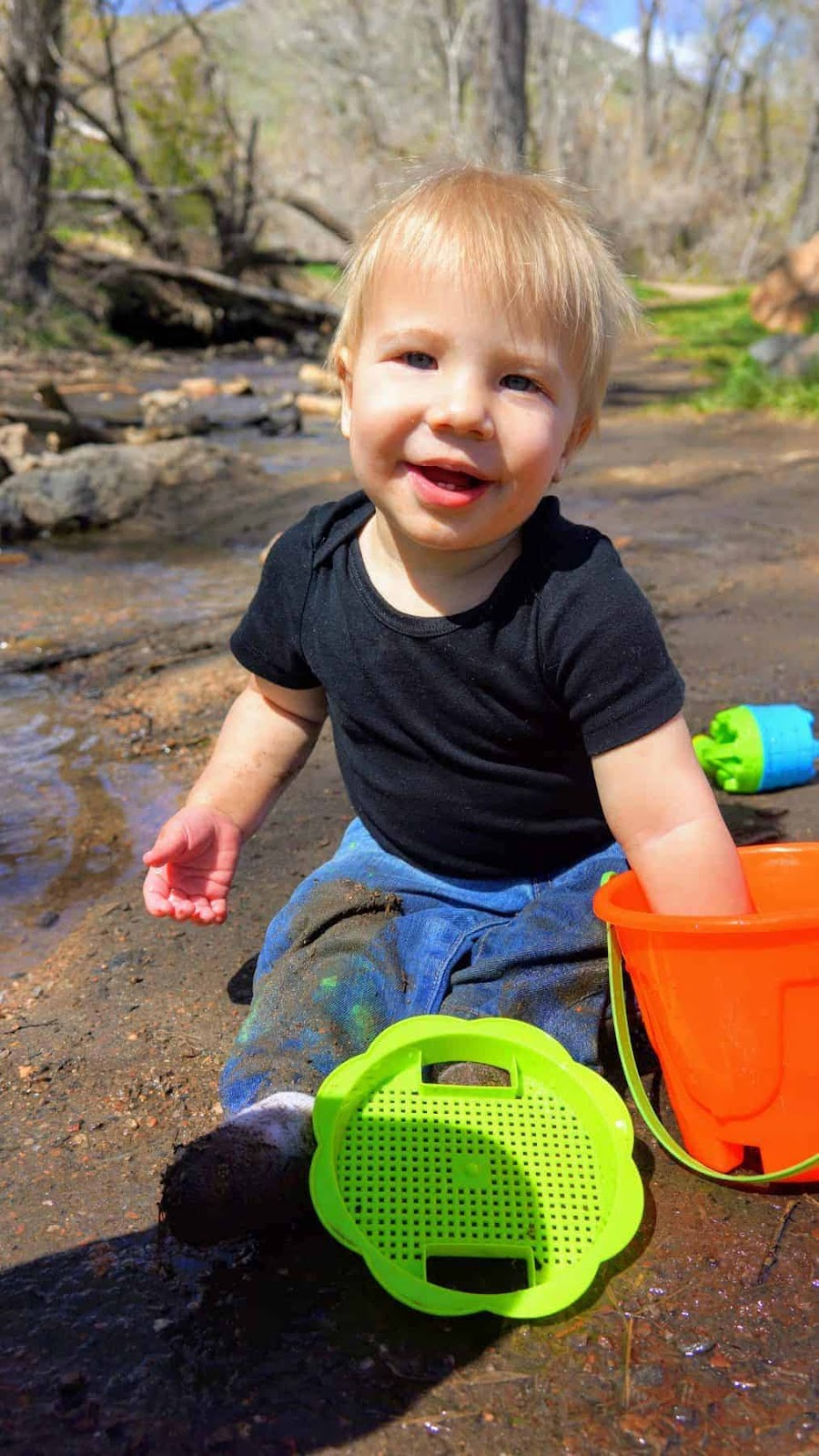
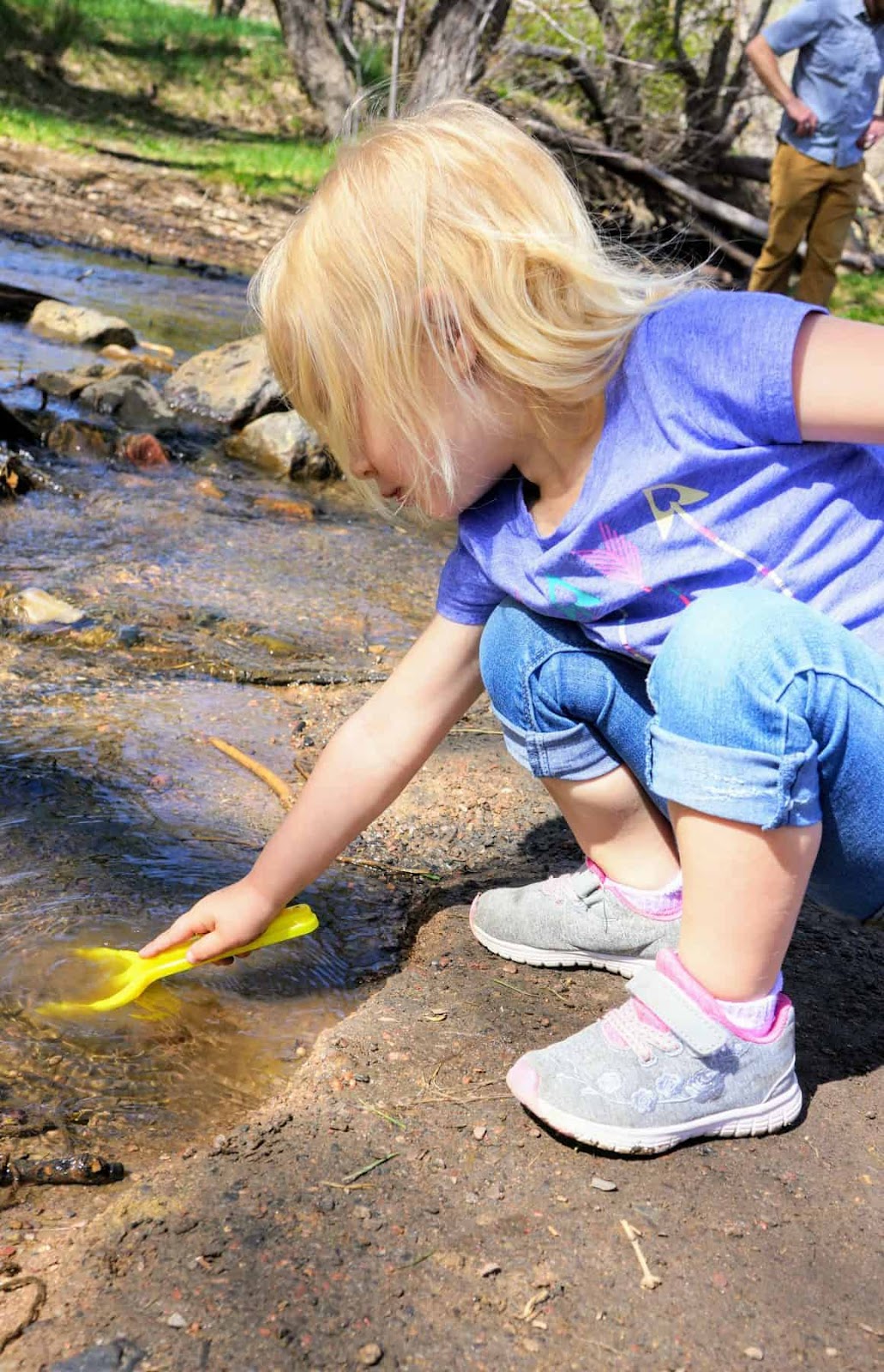
What to bring to the stream
Another good thing about playing in the stream is that you don’t need any fancy gear or equipment. Mainly, all you need is your imagination and a sense of adventure! However, there are a few things I’d recommend you bring along for your streamside outing:
A change of clothes. The most fun part of streamside sensory play is that the kids can get as wet, muddy, and generally messy as they want. While I try to time trips to the stream with bath night, a change of clothes will at least get you home with dry, happy children.
A hat. While some of the streams might be shady, often times the best spots for sensory play are in the open. Protect those little heads from that bright sun with a hat and/or sunscreen.
A sand toy set. Buckets, shovels, rakes, spoons, cups, toothbrushes all make excellent streamside toys. Essentially, anything that allows them to dig in the mud and scoop water. I’ve even brought a paintbrush along to make mud pictures on the concrete or rocky areas.
Animal figurines. We bought a cheap pack of little farm animals from the dollar store and Hope adores playing with them in the stream. She builds muddy hole homes for them, dips them in the water to clean them, and hides them in the grass or under little rocks. They certainly add an extra element of fun.
A towel. Be prepared for muddy feet and wet hands! It is also nice to be able to dry off hands before the all-important snack break.
Snacks. This should be a given because if we are being real, we never leave the house for any activity without a cache of snacks. There’s something about fresh air seems to make the kids extra hungry.
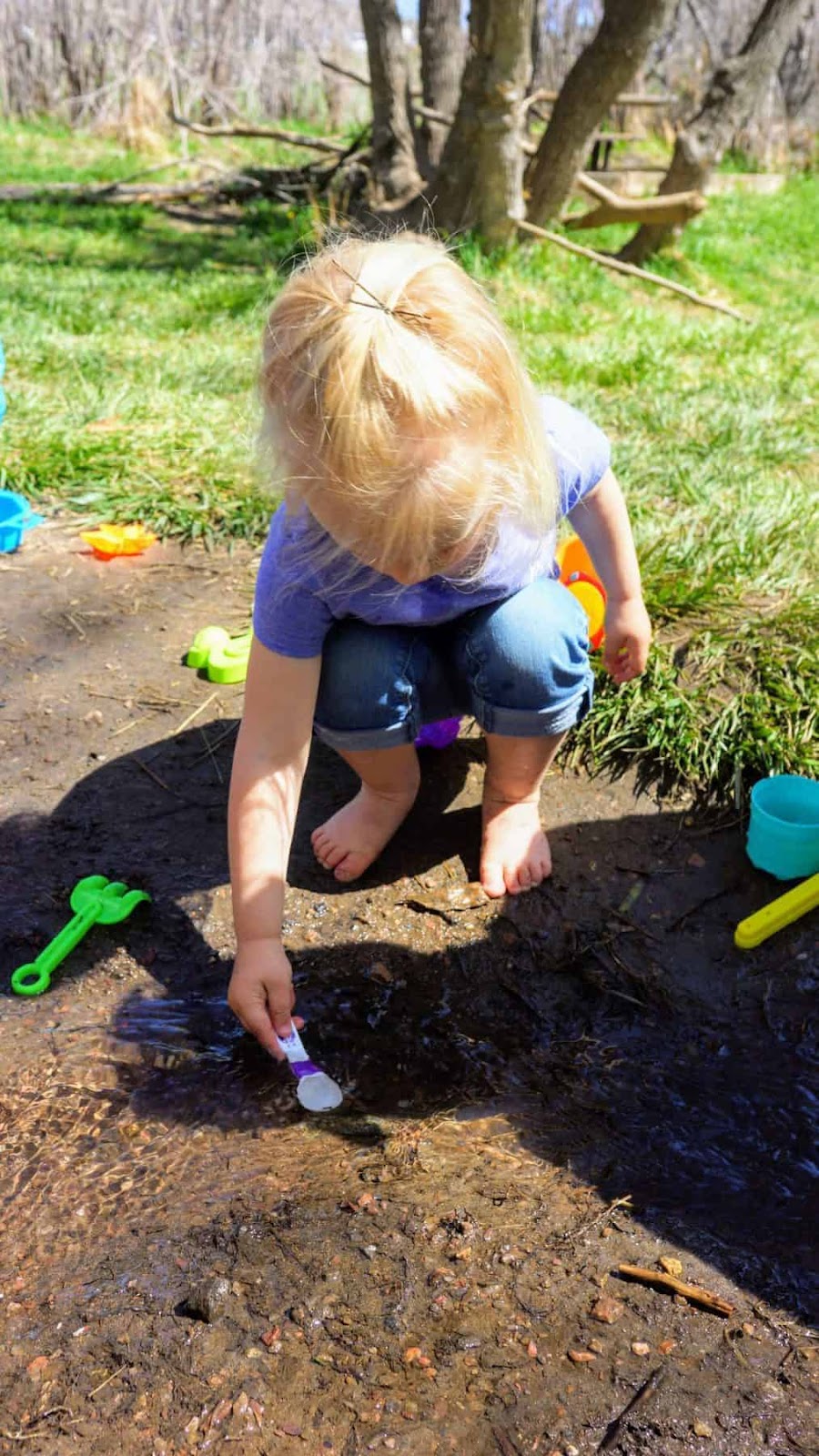
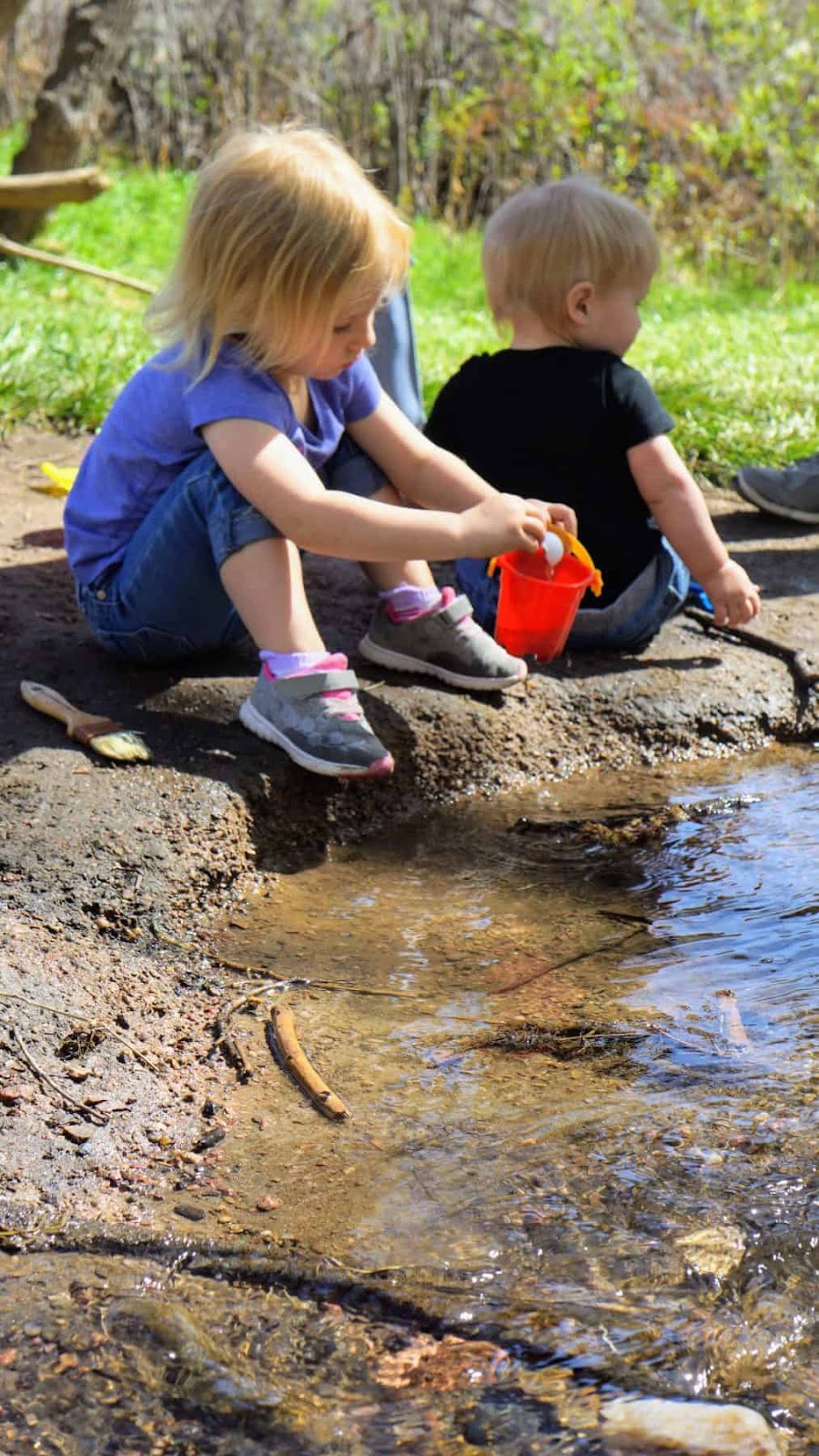
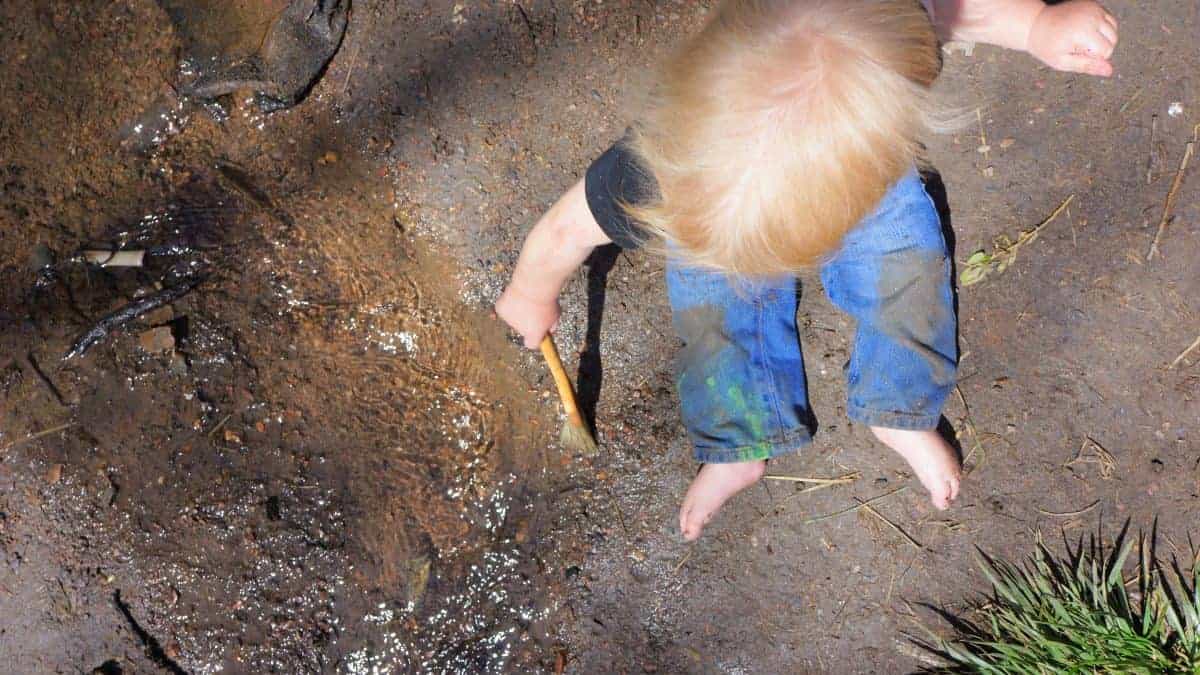
Let them play
The essential part of streamside sensory play is to really let the kids discover with all of their senses (except maybe taste, because…mud). They will get wet, muddy, and just overall dirty. Let them do it! They’re making memories! I promise they will talk about that time they were allowed to get as muddy as they wanted for years to come.
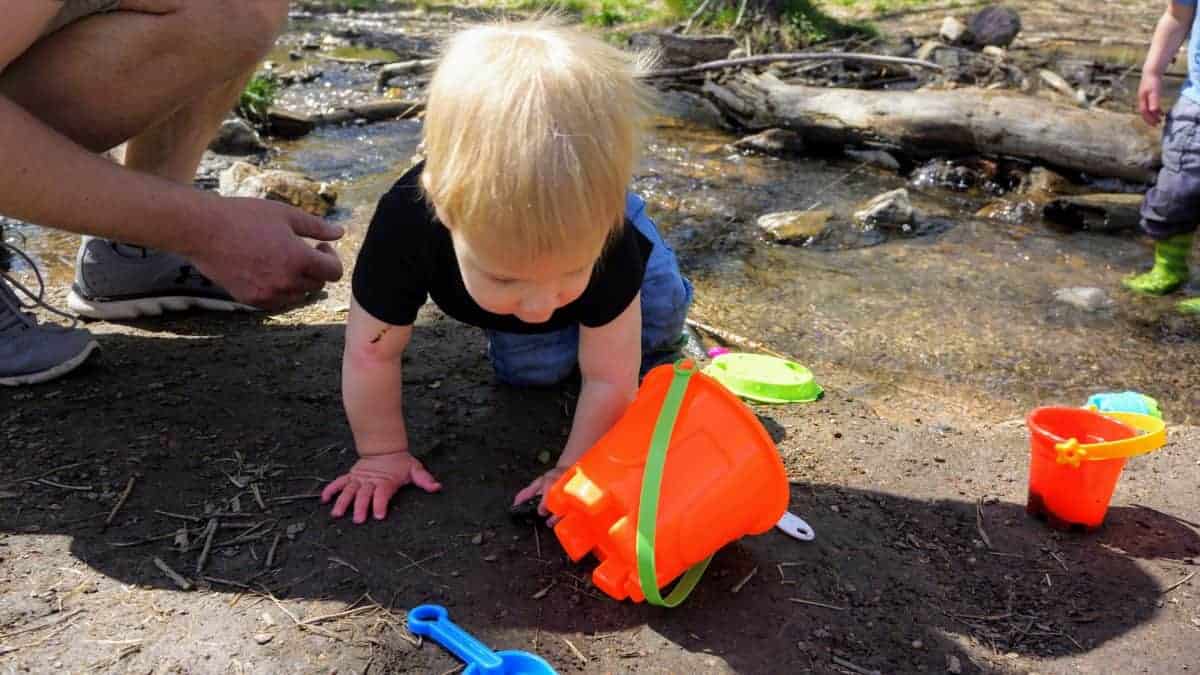
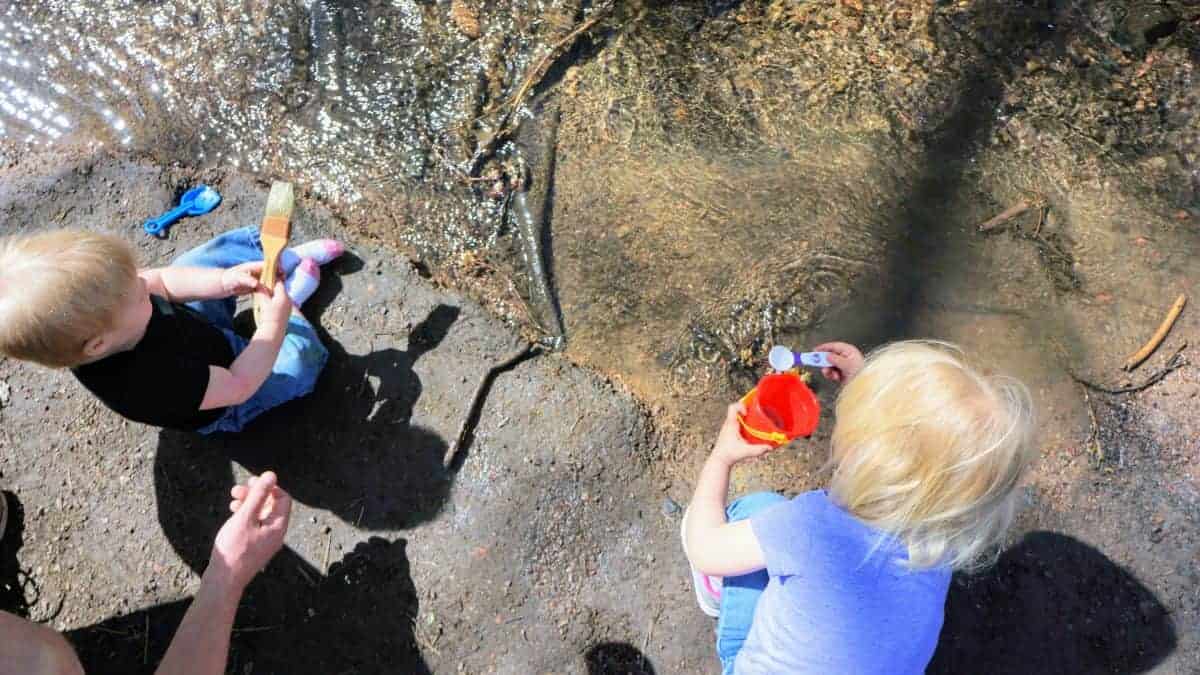
Boating & Water Sports with Babies
Learn A Paddle Sport
Any sport that requires two people to operate a single machine—like tandem bicycling or canoeing—is a fight waiting to happen if you don’t know what you’re doing. Before you push off with a baby on board, get on a local lake or river and practice paddling with your partner. Master the J-stroke, reverse stroke, and pry and draw, or consider taking an introductory course from an organization like the American Canoe Association. Once you get into the backcountry, there will be plenty of things to stress over; your J-stroke doesn’t have to be one of them.
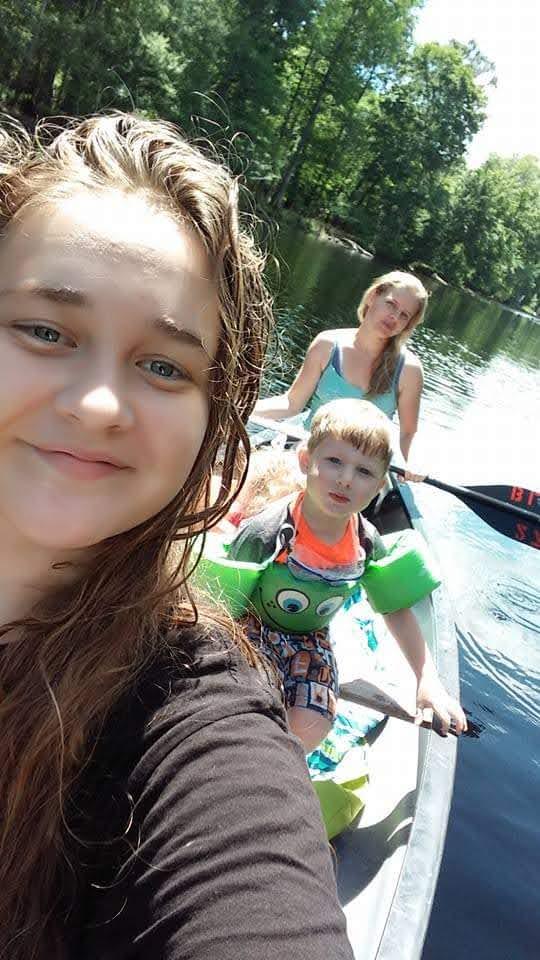
Tips for Safe and Joyful Water Bonding
Aug 17, 2023 — The rulebook doesn't set an age limit. But, here's the deal: bringing a newborn or infant (0-12 months) on a kayak ride isn't advised.
Canoeing with Babies – The Basics
May 2, 2018 — Keeping snacks, treats, and water readily at hand is vital for the success of any canoe trip with toddlers along. I love my Stohlquist life ...
Give Stand up Paddleboard a Try
PRO TIP: Introducing your baby to SUP - Pau Hana Surf Supply
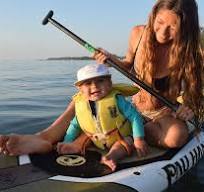
More Shore Ideas
What’s in Our Day Pack For Hikes With Babies and Toddlers?
We are often asked the question of, “What do you pack in your day pack when out hiking with your son?” This is a complex question since, as your child ages and develops the contents change. So, here’s a break down of what lies within our daypacks when out on wilderness excursions with our kiddos along from birth to toddlerhood! Download our printable day hike checklist Our 12 Essentials for Hiking Regardless of Age Water – Hydration Bladders or water bottles, just be sure to have plenty for everybody regardless of age. If you’re on a trail which has access to…
Our Top Ten Favorite Adventure Books for Babies and Toddlers
When we became parents we realized that we had many things to teach and instill in the tiny human beings that we had created together. A love for the outdoors and adventuring was clearly one thing we wanted to encourage in them from the start. Another, was a love for reading. We knew that these two passions could be combined together, and work together, to help our children grow up with senses of adventure, curiosity, and a desire to explore and learn. It has become a family tradition to get a book at every National Park/Monument/Forest that we visit as…
5 Tips for Boating With Babies + baby boating accessories
Summer is here y’all! And in Florida, we pack up our things and head to the boat ramp! Boating with babies can be a very safe and fun activity in the summer, as long as you are well prepared and follow certain safety regulations, such as always having a life vest properly sized for your babe! If you’re looking for a life vest for an infant under 30 pounds, Amazon (the place that has everything) has this one which is the most comfortable. We have a similar one, that was handed down to us but the size range is different, and we love it. I don’t consider this a tip, however, I do consider it a NECESSITY!!
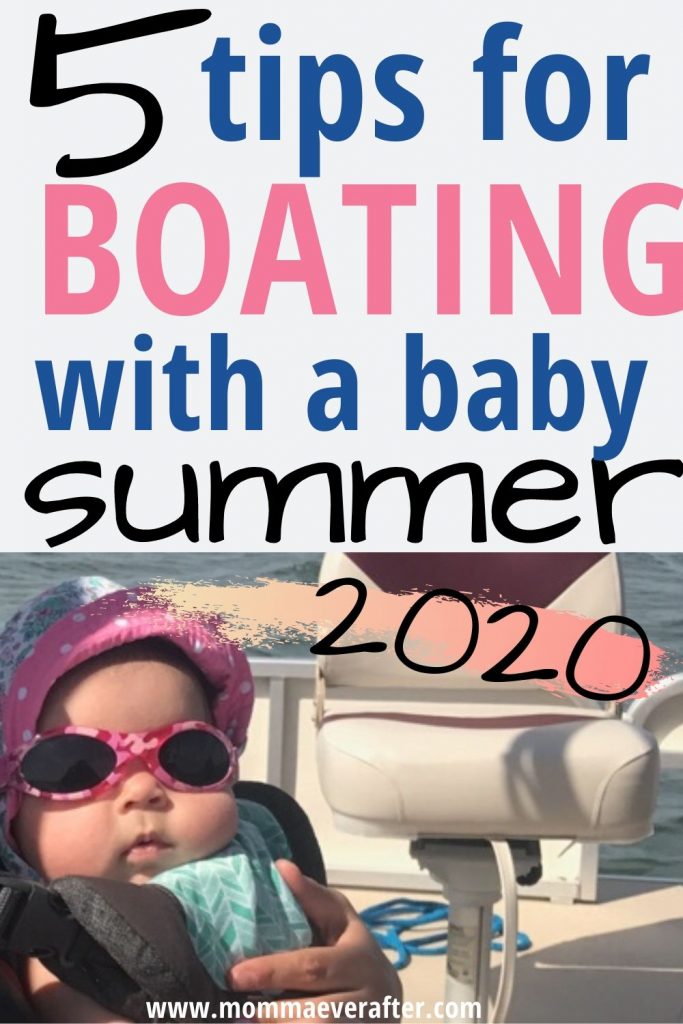
1. BE PREPARED FOR BOATING WITH BABIES
As a momma, this is basically the number one tip/rule in your life regardless of where you are going. Always be prepared! I can’t stress this enough for the boat! You are basically in the middle of the water somewhere, and the last thing you want to do is have to go back to land every so often to get whatever it is that you forgot.
When I’m packing my bag/diaper bag for boating with babies, my essentials go as follows :
Diapers (duh! BRING EXTRA!!!)
Wipes (another obvious – never go anywhere without these!)
SUNSCREEN!! (an absolute necessity! Baby skin is so sensitive, this is a must!!)
Towels (my favorite are the hooded – but anything works!)
Extra onesies (I usually bring just plain white onesies, that I’m okay with getting salty and sweaty!)
Reusable swim diaper (oh my goodness- this ones the best!! So easy for a dip, especially since the smallest size disposable swim diaper is 16 pounds!)
Jelly shoes (since infants do not walk, this provides enough feet protection, with the ability to still get wet and cool when going for a dip in the water!)
Hat (keep that babe nice and shady!)
Fan (battery operated – but nice to give the babe cool relief in the heat!)
Bouncer seat (not to be used when the boat is in motion at all! We use it when we are either anchored out and not moving, or anchored up to an island and we bring it onto the island under our pop up tent!)
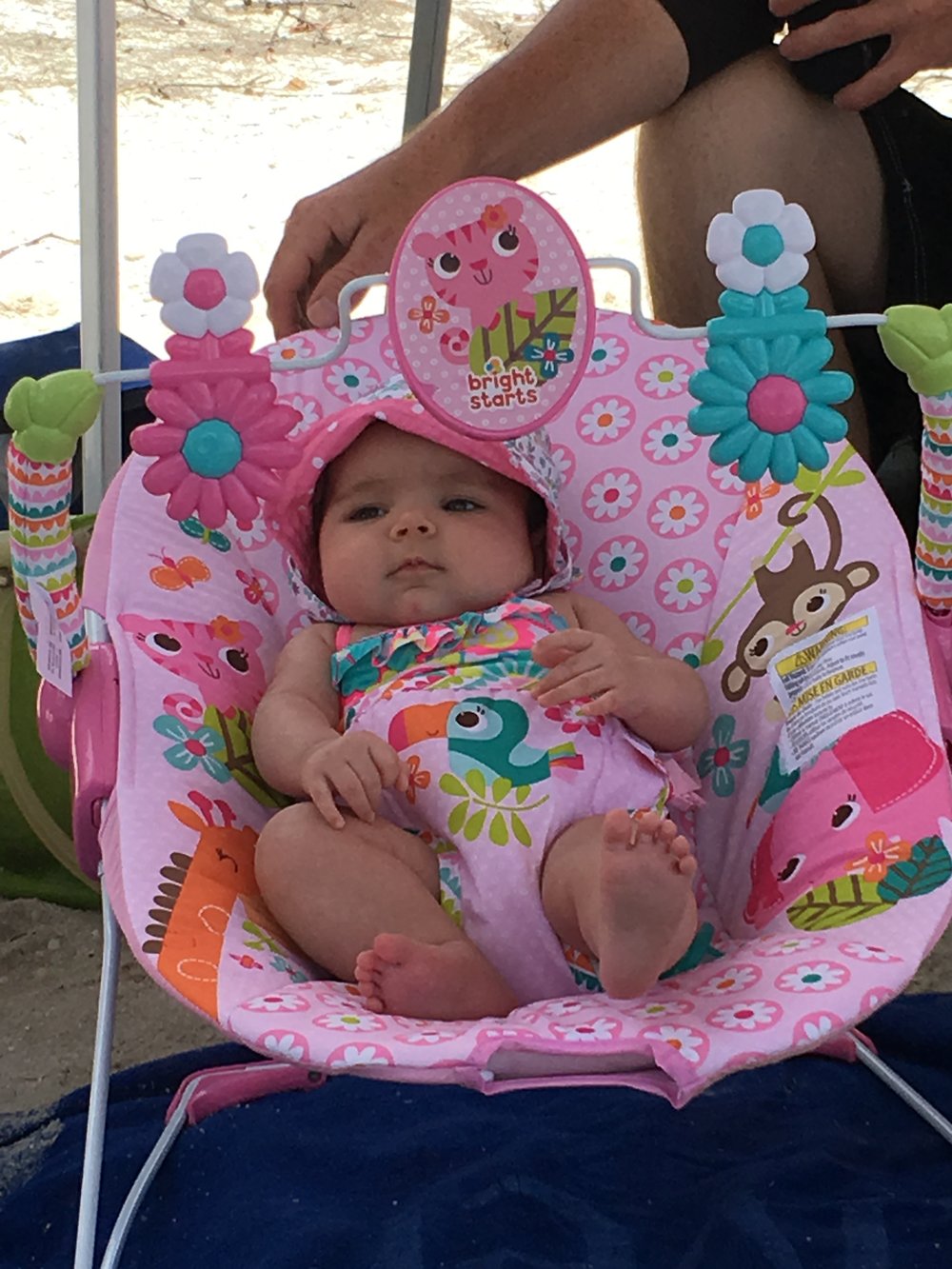
2. WEAR YOUR BABY ON THE BOAT
I love this bit of advice. Baby wearing is basically the best, for so many different reasons and this is one of the atypical reasons! When getting on, and off of the boat – wear. your. baby. It is so important that during this transition from the land to water and vice versa that they are almost literally glued to you! NEVER pass your baby from person A to person B to get onto the boat! For mom it is SO much more comforting knowing that are right on you and basically can’t move without you. Accidents can happen in a split second, so always be extra cautious even with baby wearing them onto the boat. Make sure there is somebody on the boat guiding you down, and somebody on land behind you kind of hovering you! Safety is obviously key here, so you can never have too much help! Continue to wear your baby until you get from point A to point B! NEVER pass them around during the time that the boat is in movement. You can read more about my love for baby carriers (and get a little free surprise) by clicking here!

3. FIND YOUR SAFE SPOT ON THE BOAT
If you’re like us, and have grown up on a boat/the water you probably have never really thought about sitting in the “safest” spot because to us they are all safe! Which is true! But it’s very important that you sit in a sturdy seat. Mostly for the comfort of the baby aspect, but it does also make you feel much safer and more secure! Usually, depending on the type of boat you are on, there is a seat, kind of like a captains chair, just not behind the steering wheel! Usually this seat gets splashed by water the least, and is a little higher up so you don’t feel the boat hitting the waves as hard! If you sit in those lower seats, your little babe is going to be constantly bouncing up and down, and constantly shaken, which obviously is not good for their fragile bodies/heads!
4. KEEP YOUR BABY COOL ON THE BOAT
The Florida heat is no joke, and I’m sure wherever you are located 80+ degrees, is 80+ degrees! HOT HOT HOT! A risk factor of SIDS can be overheating, so it is so important that you keep your babe as cool as possible! Depending on the degree of the water, we will put a reusable swim diaper on her, and dip her in! Make sure you change them almost immediately after a dip in the water to protect against infections caused by sitting water, such as UTI’s (yes – boys can get them too)! Most boats have some type of Bimini or covering that you can set your babe under in their seat. If the boat you are on only has a T-Top or nothing at all I highly suggest bringing an umbrella. Shade is crucial in keeping them protected from the sun (as well as sunscreen)! and in turn keeping them cool! We also bring a handy dandy 02 Cool fan with us. It is battery operated, so it’s great to face towards her when we feel like that she is getting too hot!
5. HAVE FUN WHILE BOATING WITH BABIES!
I know, such an obvious one! But really y’all! Have a blast! I know sometimes being a parent in these situations is nerve-wracking, because again, accidents happen in a split second! But enjoy these moments with your babe while they are still little! They grow up so fast, and these memories are ones you don’t want to miss! Take lots of pictures, as always! As long as you are being as safe as humanly possible, you should be just fine, and completely able to enjoy yourself!
All of these tips are based on boating with experienced boaters and passengers. If this is your first time on a boat, or your operators first time operating a boat, then leave that babe at home until you get comfortable and familiarized!
10 Tips for Boating with an Infant
If it’s your first time boating with your baby, infant, or toddler, then you might feel a little overwhelmed at all the stuff you need to prepare for both comfort and safety. So to help streamline the preparations and cover all the bases for your child and your boat, consider these baby boat gears and handy tips:
1. Have an Appropriate Life Jacket
This can’t be stressed enough. Life jackets or a persona flotation device PFD is an important piece of safety gear that can potentially save your baby’s life, especially in the unfortunate event that they fall into the water. Since that would be any parent’s nightmare, preparing for the worst can give you at least a little more peace of mind knowing that your baby has a better chance of being retrieved.
Keep in mind though that not any life jacket will do. There are life jackets and PFDs that are specifically designed for children and babies, and that’s precisely what you’d want to purchase. Size makes a big difference in how a life vest works, and wearing something too big could easily slip off and leave your baby fighting for himself if he falls into the water.
The U.S. Coast Guard states that babies can only travel on a boat if they weigh at least 18 pounds and can wear a personal flotation device. Now, newborn babies grow at varying rates depending on a number of factors. But you can expect a 4 or 11 month old baby to weigh at least 18 pounds .
The Full Throttle Infant Baby-Safe Vest is a Coast Guard approved type II PFD that was designed specifically for babies under 30lbs. It’s gained popularity for its oversized collar for improved head support which aims to keep your infant or baby’s head upright if they’re in the water for added safety.
The Stohlquist Infant PFD Life-Jacket is another Coast Guard approved choice that’s pretty popular for its bright colors and durable design. Ideal for an infant as small as 8lbs, this life jacket can provide safety for the smallest members of the family.
2. Keep an Eye on Your Baby At All Times
It’s easy to lose track of things when you’re having fun. But that shouldn’t be an excuse for you to leave your infant or baby unattended especially when the boat is underway. Even on a docked boat, there are serious threats and dangers that could potentially hurt your baby. So see to it that there are eyes on your little passenger at all times.
Better yet, try not to let them go while you're on the boat. While this can be a little demanding on your arms, it’s always better to be safe than sorry. Fortunately, you could always just get a baby carrier to take the load off of your arms. But because your baby is going to be wearing a PFD, then you might not be able to strap them into a conventional carrier.

A hip seat carrier works wonders to support your the weight of your infant or baby while you use even just a single hand to make sure they’re secure. Wearing it can also make it easier for you to get things done around the boat without having to let go of your VIP. And while they're not made for use on a boat, a baby car seat might help keep your little guy more comfortable and easier to supervise during the ride.
We really like the Baby Hip Seat Carrier by Sunnors.
3. Check the Weather
You’d probably check the weather resources anyway even without an infant or baby on your boat. But it becomes doubly important to check the forecast when there's a baby on your boat. That’s because bad weather and choppy waters can make babies and toddlers feel unsafe and scared, leading to a crying fit that might make matters all the more stressful.
See to it that you check weather conditions before you leave the dock. Avoid taking a trip into the water even at the slightest signs of potential disturbance. And aside from that, avoid areas where waves might be too frequent. Steer clear of crowded parts of water where the wake of bigger boats might cause lots of uneasy movement and stick to a cruising speed in case your child gets seasick easily.

4. Slather on the Sunscreen
No one’s skin is as sensitive as newborn babies. Harsh sunlight and UV rays that shine down on your boat can cause your baby to develop redness and burns, leading to a stinging pain that might ruin the entire trip for everyone. And because shade is scarce on a boat, make sure you’ve got sunscreen at the ready.
While any sunscreen might do, you might be better off choosing a formulation that’s intended for a baby. The ThinkBaby Sunscreen uses natural ingredients so it’s extra easy on baby’s delicate skin. The blend also incorporates SPF 50+ to provide broad spectrum protection against both UVA and UVB rays. To double up the protection, you could also get them a rashguard and a sun hat to offer extra shade against harsh sun while on your boat.

5. And the Bug Spray While You're At It

There's another danger that risks assailing your baby aside from the lack of shade on a boat. Mosquitoes abound where there’s warmth and humidity -- both of which are present in most boating locations. Unfortunately, mosquito bites are more than just unpleasant, they can also come hand in hand with disease. So aside from the sunscreen, you might also want to give your baby a layer of protective power against bug bites.
If you were looking for a mild formula for babies with extra delicate skin, you could try the Babyganics DEET-Free Bug Spray that uses plant-derived ingredients. But if you were hoping to use something a little more robust for all types of bugs, the OFF! Family Care Bug Spray might be more up your alley.
6. Organize Your Boat
You probably usually keep all sorts of stuff on your boat -- from a dirty anchor and rode, to fishing lures and tackle and other fishing and boating gear. Before you take your baby on the boat, see to it that all of that dirty stuff is properly stowed and hidden away in your boat storage. That’s especially important if you’re welcoming a rambunctious little toddler on your boat.

If you don’t want to take them off of your boat for the lack of a place to keep them elsewhere at home, you could always just cop a few storage bins to keep on board your boat. While you’re at it, try to conceal exposed equipment like batteries, fuel caddies, and other potentially hazardous items on the boat.
We find these IRIS USA Plastic Storage Organizing Containers are great!
7. Give Them Lessons
If your toddler is a little more aware of himself and his surroundings, you might be able to give them instructions on what to do in case of an emergency while on the boat. Of course, it’s still ideal to hold on to little boat guests at all times. But just in case, it would be a major help for them to know what they should do in certain situations.

Some parents go as far as enrolling their toddler in swimming pool lessons before they take them on a boat. In fact, advice and resources from the American Association of Pediatrics claims that even 12 month old infants can start to take swimming lessons. This can be a good idea to significantly increase the chances of rescue and minimize the risk of drowning in case the child falls overboard.
Whenever teaching a baby to swim, it's important that you have the right gear. Use a swimming vest to help your baby acclimate faster to the waves.
We recommend the MoKo Life Jackets for Kids.
8. Pack As If For A Road Trip
It doesn’t matter how new and exciting the sights and sounds on a boat might be. Babies and toddlers can get bored fast. And once they’ve reached their limit, they might end up all fussy and in a crying mood all while you try to enjoy the boat ride.

To curb the tantrums, see to it that you pack all of the things that keep them entertained. We’re talking coloring books, crayons, toys, and even a tablet or phone packed with all of their favorite films and TV shows. Just strap them into their car seat and offer a few activities to keep the tantrums at bay.
But more than just the toys, you might also want to consider packing along some (or a lot) of snacks. Kids tend to enjoy munching more than adults, so it’s important that you bring along non-messy treats like cereal, chips, sliced fruit and veggies, juice packets, and whatever else your kids might enjoy.
Another thing to note is that babies sleep more than the rest of us, especially if you've got a newborn child. But because there probably won't be a place on the boat for them to sleep comfortably (unless you're bringing your car seat), you might want to consider buying a portable sleeper to give them a more comfortable space to rest onboard. There are also infant or newborn seat designs that recline to give your child more comfort in case they want to snooze.

9. Never Go Alone with a Baby on a Boat
Maybe you’re hoping to spend some quality time with your little one, or you just need to get away from it all but just can’t find a baby sitter. Whatever the case, do not go boating alone with your baby. There needs to be at least one other person on board to operate the boat or to hold your little one when you’re the one at the wheel, whether he's an infant or a toddler.
A lot can happen if you turn away from your baby or infant for even just one second, even if it's a newborn that's just a few months old. And because there’s way too much happening on boats, it’s impossible to keep your eyes on your baby on the vessel at all times. If there’s no other family member or friend who can go with you on your boating trip, postpone it and schedule for another time.
10. Include Them in Your Float Plan
It’s not entirely clear why some people feel like the presence of infants and pets on board of a boat is implied. When you prepare your float plan, make sure to list down the names of all the people on board, regardless of how old or young they might be. This can be crucial for a search and rescue operation should it have to reach that point.

As you prepare your float plan and detail the course of your boat trip, make sure that all of the details are in order. List down everyone who’s on board and don't forget the littlest members of the guest list just. As one of the most important safety precautions, this one might just save their life.
Baby's Day Out
Boating with a baby, whether a newborn infant or toddler is no simple feat, but it can be loads of fun if you make the right preparations. There are loads of dangers that float around in the water, so boating with babies will require extra care and caution if you want to keep things safe for everyone. Follow our advice and tips, and cop the right gear to curb the risk of accidents and injury. Do all of that, and you could inspire a love of boats and water as you introduce your baby to life on a boat.
River Trips with Babies-Sailing
Exploring Waterfalls and Rivers
How to Take Your Baby on a River Trip
Taking a tiny human floating seems intimidating, but it doesn’t have to be.
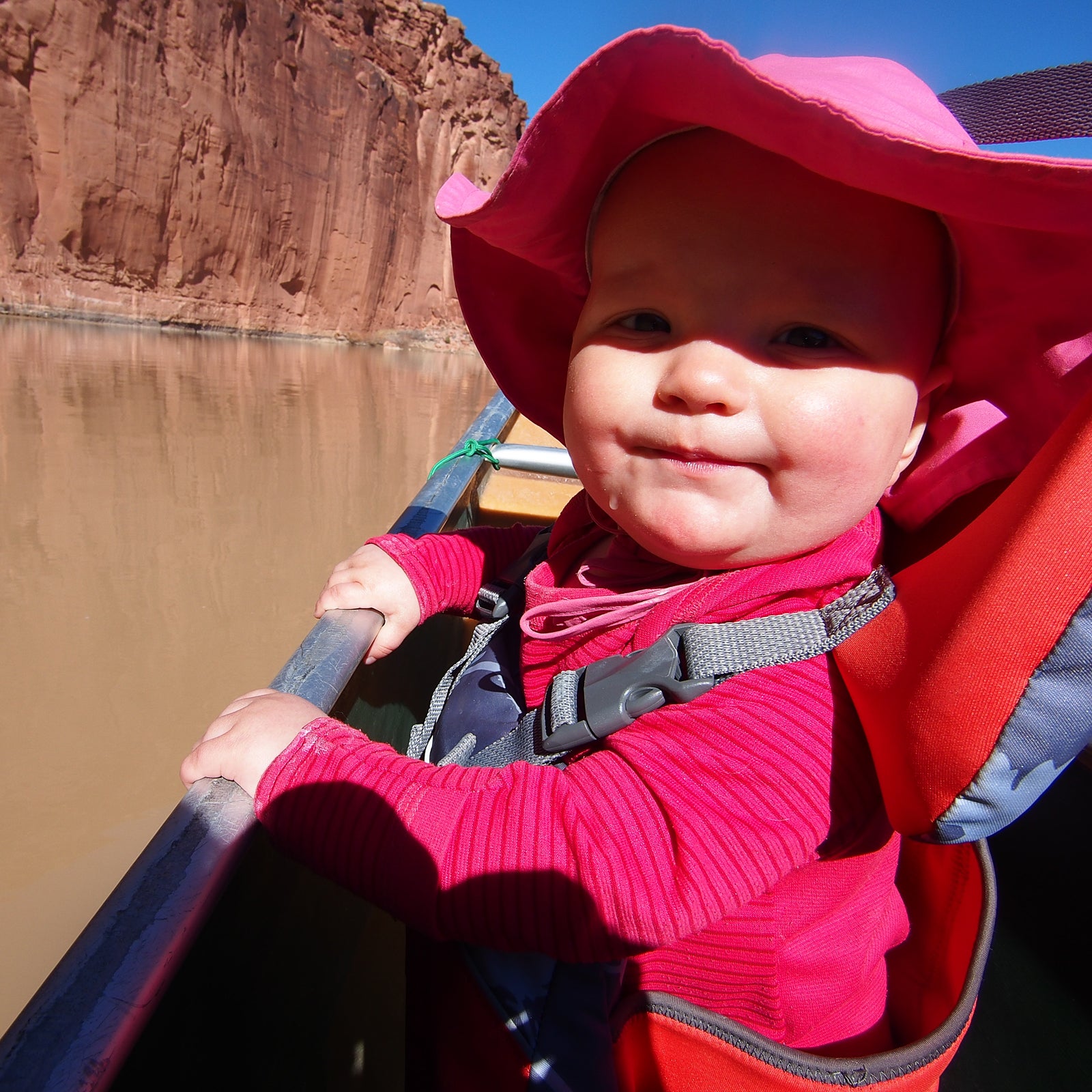
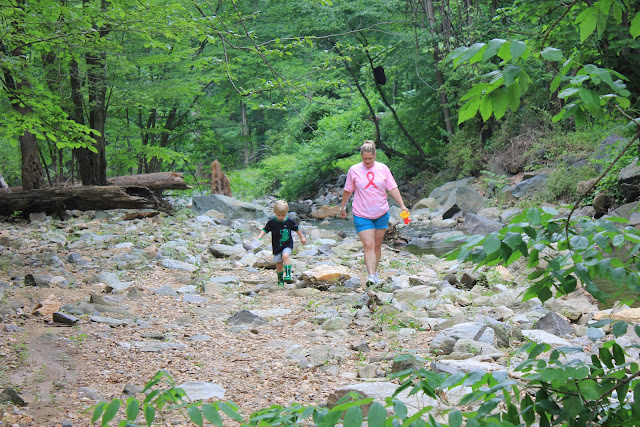
High Five
Every March, when we’re sick of winter but too impatient to wait for spring, my husband and I drive to the desert to go paddling. The rivers of the Colorado Plateau run muddy with snowmelt, and the sun feels like heaven. Weather on these trips is variable—we’ve been snowed, rained, and hailed on—but the quiet canyons and starry nights are worth the gamble.
This year, though, there was an even bigger variable: our daughter Josephine, who was 11 months old and had never been in a boat of any kind. How would she react to spending hours each day in a canoe or raft? Would she sleep when nighttime temperatures dropped into the thirties? And was it foolhardy to take her so deep into the wilderness that you couldn’t easily hike out?
Still, as the snow continued to fly at our home in Colorado, I couldn’t stop daydreaming of a 45-mile stretch of calm water that flows through Utah’s Labyrinth Canyon. I’d been reading Alan Kesselheim’s book Let Them Paddle, about canoeing with his children, and the fact that he’d taken an eight-month-old on a month-long expedition down the Yellowstone River made my idea seem tame. For additional inspiration, I reread a few chapters from Mardy Murie’s classic memoir Two in the Far North, in which she takes her six-month-old on a four-month Arctic river trip in the 1920s, long before GoreTex and disposable diapers. Clearly, I rationalized, humans have been taking babies down rivers for millennia.
Despite those two books, there’s relatively little information about how to pull off a multi-day river trip with a little one. Apart from a few tips I gleaned from Murie and Kesselheim, we were mostly winging it. As I made lists and packed meals and stuffed clothes into drybags, I was slightly terrified that the minute we were stuck in the bottom of a canyon with a wailing baby, we’d regret leaving the house.
There were indeed a few times when we were stuck in the bottom of a canyon with a wailing baby. But I never once regretted it. Here’s how we pulled it off.
Buy a Good PFD
One of the smartest things I did when pregnant was to use my baby shower to convince friends and family to buy me fancy outdoor baby gear, including this bomber PFD from Level Six. This one is comfortable, doesn’t ride up, and will fit for several years. I also made my daughter wear it around the house for a couple weeks so that she was used to it before we got on the water.
Choose Your Destination and Boat Wisely
First, your destination: You want water with easyrapids (Class I) or none at all, in an environment where you’re already comfortable with backcountry travel. Then, choose your craft. Kayaks are not practical with a baby. Rafts can haul lots of gear and people but are slow, heavy, and often have standing water on the floor, which means no dry place for an infant to hang out other than in your arms. Canoes, on the other hand, are practically made for babies. The gunwales are the perfect height for a standing baby to hold onto, the hull stays mostly dry and offers a solid surface for playing or napping on, and they’re easy enough for one person to paddle if the other needs to hold or feed the kiddo.
Learn A Paddle Sport
Any sport that requires two people to operate a single machine—like tandem bicycling or canoeing—is a fight waiting to happen if you don’t know what you’re doing. Before you push off with a baby on board, get on a local lake or river and practice paddling with your partner. Master the J-stroke, reverse stroke, and pry and draw, or consider taking an introductory course from an organization like the American Canoe Association. Once you get into the backcountry, there will be plenty of things to stress over; your J-stroke doesn’t have to be one of them.

Tips for Safe and Joyful Water Bonding
Aug 17, 2023 — The rulebook doesn't set an age limit. But, here's the deal: bringing a newborn or infant (0-12 months) on a kayak ride isn't advised.
Canoeing with Babies – The Basics
May 2, 2018 — Keeping snacks, treats, and water readily at hand is vital for the success of any canoe trip with toddlers along. I love my Stohlquist life ...
Give Stand up Paddleboard a Try
PRO TIP: Introducing your baby to SUP - Pau Hana Surf Supply

More Shore Ideas
What’s in Our Day Pack For Hikes With Babies and Toddlers?
We are often asked the question of, “What do you pack in your day pack when out hiking with your son?” This is a complex question since, as your child ages and develops the contents change. So, here’s a break down of what lies within our daypacks when out on wilderness excursions with our kiddos along from birth to toddlerhood! Download our printable day hike checklist Our 12 Essentials for Hiking Regardless of Age Water – Hydration Bladders or water bottles, just be sure to have plenty for everybody regardless of age. If you’re on a trail which has access to…
Our Top Ten Favorite Adventure Books for Babies and Toddlers
When we became parents we realized that we had many things to teach and instill in the tiny human beings that we had created together. A love for the outdoors and adventuring was clearly one thing we wanted to encourage in them from the start. Another, was a love for reading. We knew that these two passions could be combined together, and work together, to help our children grow up with senses of adventure, curiosity, and a desire to explore and learn. It has become a family tradition to get a book at every National Park/Monument/Forest that we visit as…
Pack a Day Bag
When you push off from shore, most of your gear will be hard to access, crammed into drybags and tied to the boat. Make sure you have the essentials in one easy-to-access spot. For us, this meant a 30-liter SealLine Baja drybag that I stashed under my seat, packed with a warm hat and jacket, sunscreen, snacks, diapers, wipes, and a blanket.
Ditch the Cotton Onesies
Sometimes when I dress my infant in her synthetic Patagonia base layers I feel ultra snooty, even though I got them used from the company’s Worn Wear site. On this trip, though, they proved ten thousand times better than cotton onesies: breathable but warm, quick drying, and so durable that Josephine wore them every day on sand and mud and abrasive rocks with no discernible effect.
Take a Rescue Beacon
Emergency beacons—like a SPOT Satellite Messenger or Garmin InReach—let you to call for help from remote areas with no cell coverage. They’re also not cheap. The Garmin costs $400, and the SPOT is $150 plus an annual or monthly subscriptions. But if I was ever in a sticky backcountry situation with an infant, I’d kick myself if I hadn’t invested in technology to activate a rescue with the push of a button.
Bring an Old Sleeping Pad or Car Seat
I had no faith whatsoever that Jo would nap in the canoe; she’s a fussy sleeper who struggles to drift off. But something about the quiet and the rocking motion lulled her right to sleep. I laid her on an old half-inflated Thermarest in the bow, draped a lightweight blanket over the gunwales for sun protection, and paddled in total bliss while she dozed.
For younger babies, we heard of parents who brought a car seat, put an umbrella over it, and let the baby snooze or hang out there while the parents paddled. If you go this route, make sure not to strap your child into the car seat. That way, if you accidentally flip the boat, your baby isn’t buckled to a heavy object that will sink.
Rock the Boat
The best advice we got was to bring a plastic bucket and fill it with rocks every morning. Apparently every baby on earth gets a kick out of throwing stones into the water from a canoe, keeping them distracted so you can paddle. On shore, too, they made the best play things. I brought a couple toys just in case, but Jo was way more interested in the local geology.
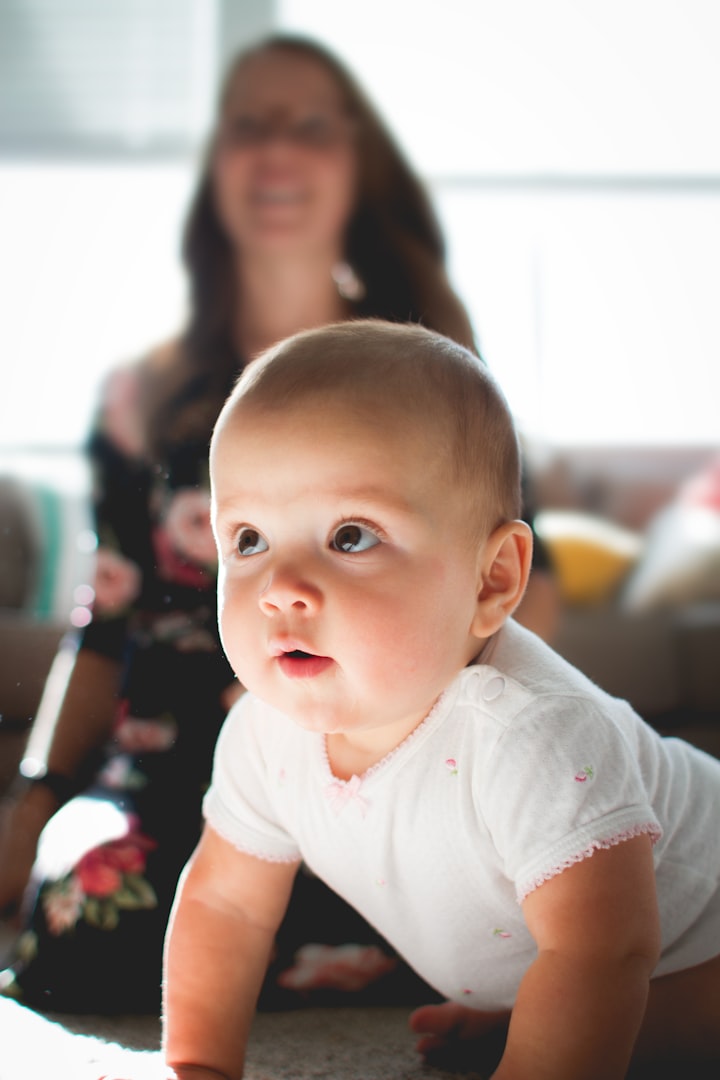
Sailing with Your Baby:
5 Tips for Getting Out on the Water
Planning for Smooth Sailing with your Infant
SpinSheet contributors have shared some good tips for sailing with your kids: start early, make it fun, provision ahead of time, and be flexible with the weather.
As a new mother and avid sailor, I definitely wanted to get a jump start on family sailing. I latched onto phrases such as, “The earlier you start sailing as a family, the easier it is.” But I found making the leap was harder than expected. I had so many questions about sailing with an infant: What is the smallest lifejacket size? Can babies use sunscreen? Where will she sleep? What about those smelly diapers? I felt overwhelmed, and the tips related to sailing with an infant, scattered throughout magazines, blogs, and forums, were blurring in my mind. I was teetering on the edge with only two hours of sleep.
My plans were stalling before I even began. A year later, I’m proud to say that we did. Sailing as a family was an amazing experience filled with priceless memories. Even though she was only a few months old, our daughter loved being on the water and feeling the wind against her face. With each gust, that little tongue would pop right out. It was as if she were tasting the wind. It must have tasted good, because those tastes were followed by a grin and a giggle. Are the logistics of sailing with an infant keeping your family on shore? If so, I hope the following tips will help your family cast off.
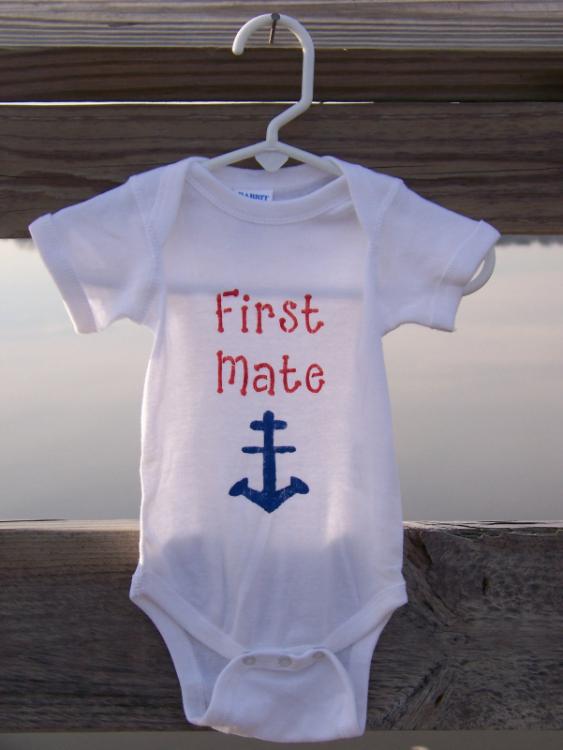
Sailing with infants and small children can be a challenge, but careful planning can help.
1. Physical Safety
Avoiding drowning is, of course, a big concern. A lifejacket is an obvious answer, but I’d never seen an infant lifejacket. Fortunately, U.S. Coast Guard-approved infant lifejackets are readily available and while bulky, wearable. That said, keeping the baby safely in the boat (and out of the Bay) was key. It was important to determine where a small baby would sit and how we could avoid dropping her. We found that a front baby carrier provided us the ability to safely go hands-free, which was essential in choppy waters. When she wasn’t being carried, a car seat or bouncer tightly lashed to the base of mast down below or secured in the cockpit provided her a place to sit.
2. Health Issues
It’s very important to prevent sunburns in infants, but children’s sunscreen labels indicate they are for infants six months and older. So, what can you do to protect your newborn while on the water? A UV sunshade, sun-protective clothing, a wide-brimmed hat, and quality baby sunglasses will help protect babies’ skin and eyes. We found that a hat with a head strap will actually stay on. Since some sun exposure is unavoidable while sailing, you may also want to use a non-chemical sunscreen. Infants are unable to regulate their body temperature effectively. To help, open cabin windows and use small, battery-operated fans to keep the air moving down below. Breathable fabrics also provide ventilation while keeping babies’ skin covered. Lastly, keep a small tub and cool water on hand. If the baby seems to overheat, a cool bath can reduce body temperature.
3. Sleeping
A car seat, bouncer, or infant hammock (rigged with a sideways preventer) can provide the baby a place to comfortably sleep while underway. For overnights, we’ve also seen families use a portable baby bed that rests between the parents or a Pack n’ Play. However, our daughter would never sleep in those types of baby beds, so we favored cordoning off the V-berth with netting and following safe co-sleeping recommendations, such as those as outlined in Sleeping with Your Baby: A Parent’s Guide to Cosleeping and other books.
4. Diapers
Believe it or not, a well-ventilated cabin and using double plastic bags or a roll-top waterproof bag kept those stinky odors at bay. For changing diapers, a foldable, contoured changing pad worked wonders for keeping the baby in place and messes off of the settee.
5. Emergencies
Perhaps one of my biggest concerns was how to handle both the boat and the baby in an emergency. Our answer was to be prepared to single-hand (lines run aft, tiller lock/ autopilot, prepped for easy reefing and sail drops); to have a safe spot for the baby (easily accessible car seat securely in the cabin); and to have a sailing competent friend along with us (to fully handle the boat if both parents needed to focus on the baby).
Click here for more articles about cruising!
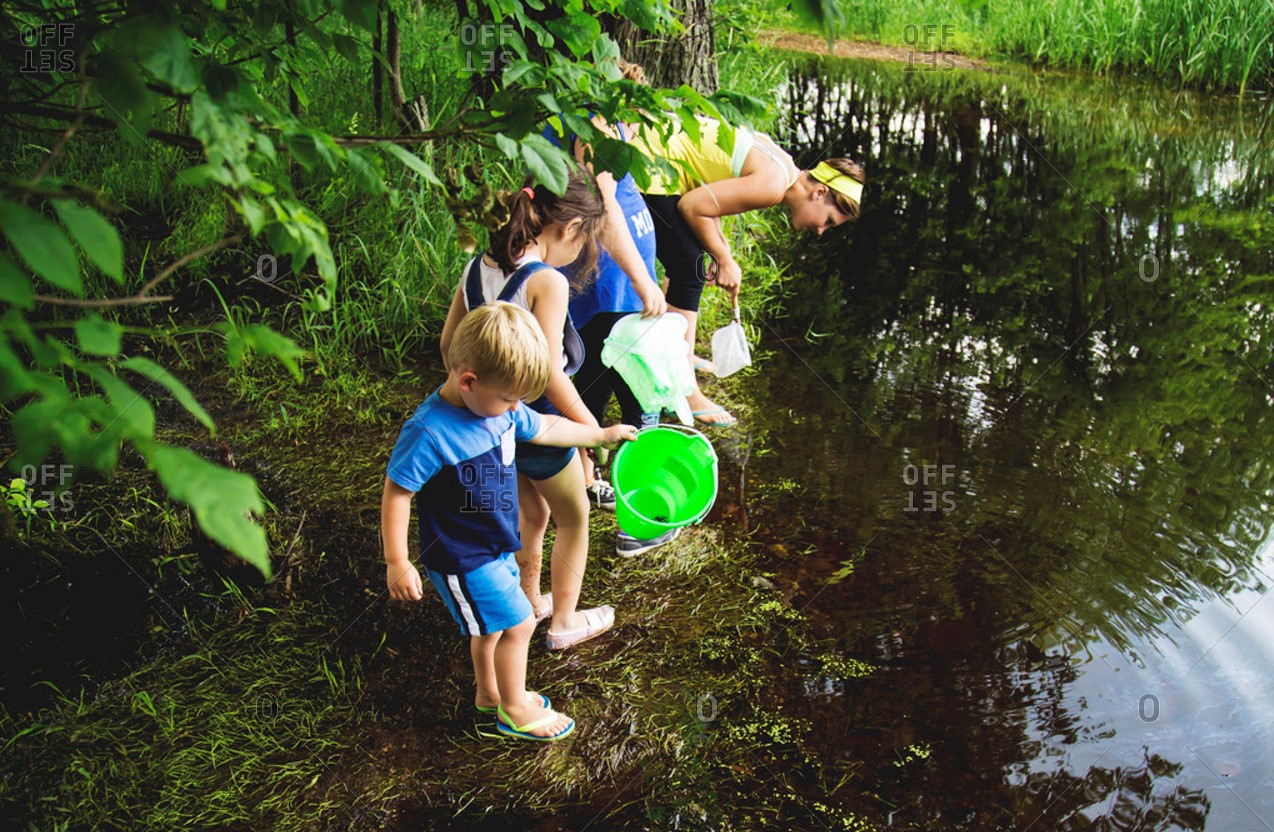
Sometimes we bring our nature toolbox, nets, and water boots so we can explore at the river’s edge. I tend to look at the ground to see if the mud is soft enough for animal tracks. I usually do not find much besides a deer or raccoon print. One time there was leaves, boot prints and a spider.

We check the water level of the river to see if it is safe enough to explore past the edge and possibly make it out to the island in the middle. My kids love going to the island to explore and feel all independent. Princess took Bayley over to the island and they both loved exploring. Bayley sniffed all around and Princess got to exercise her dog.

Resources for Camping with Baby

Tips for the Best Memorable Beach Vacation with Baby
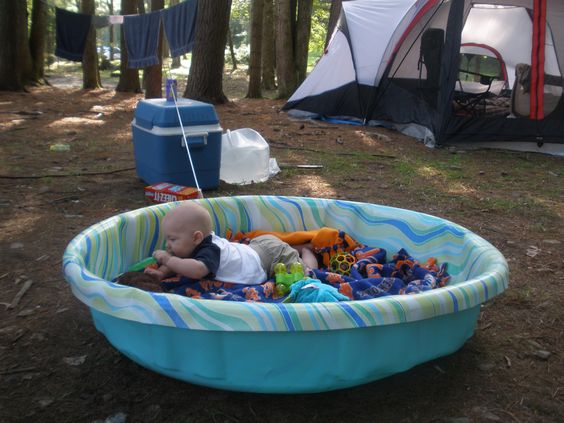
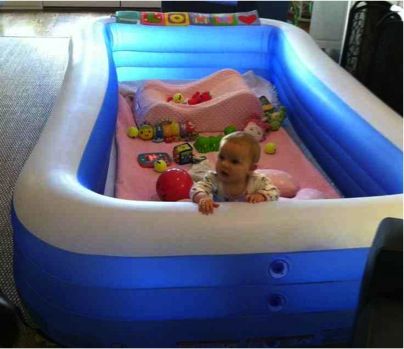
The Ultimate Guide to Camping with a Baby:
Tips and Essentials
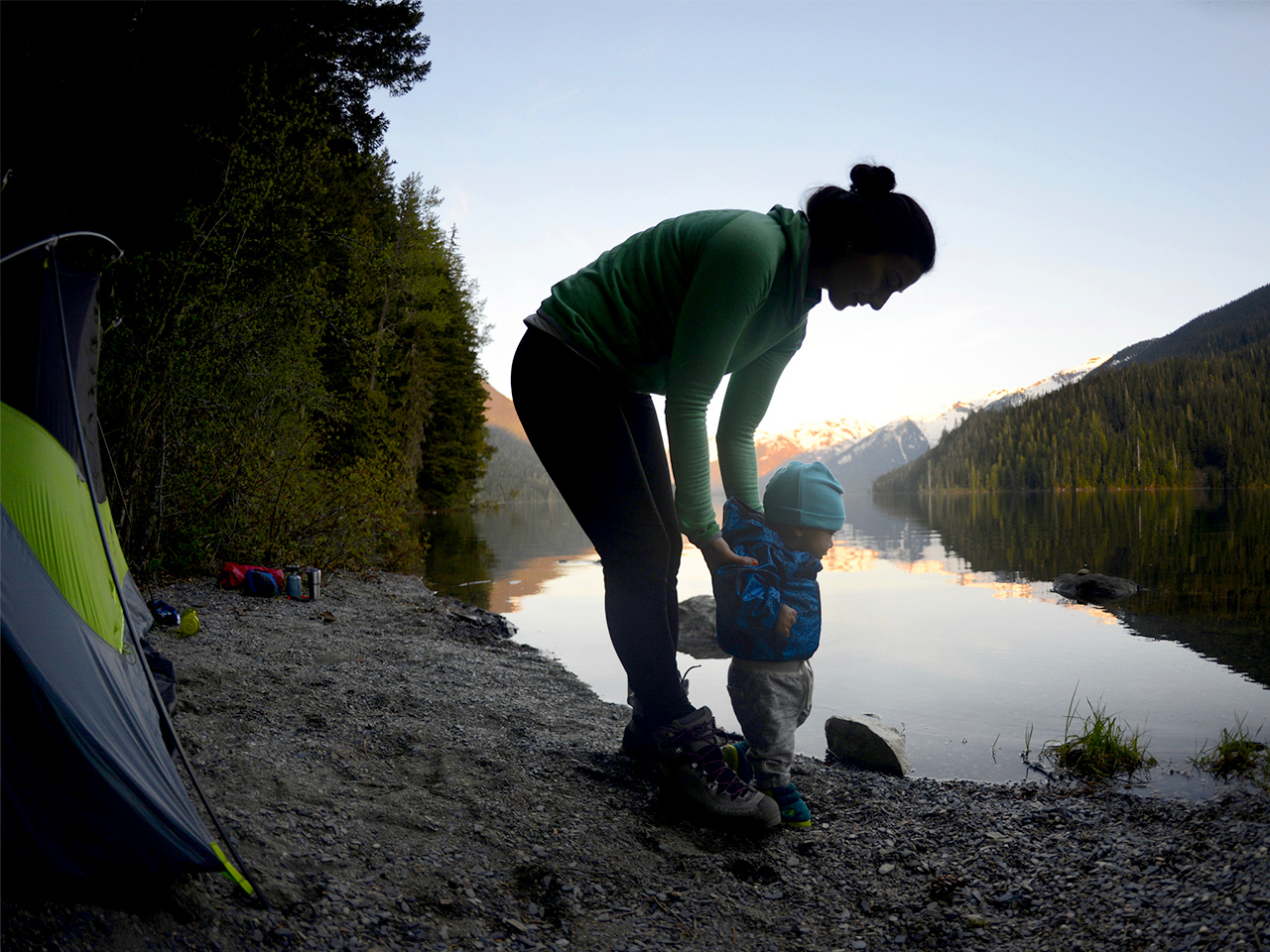
Best Baby Camping Gear and Baby Camping Checklist
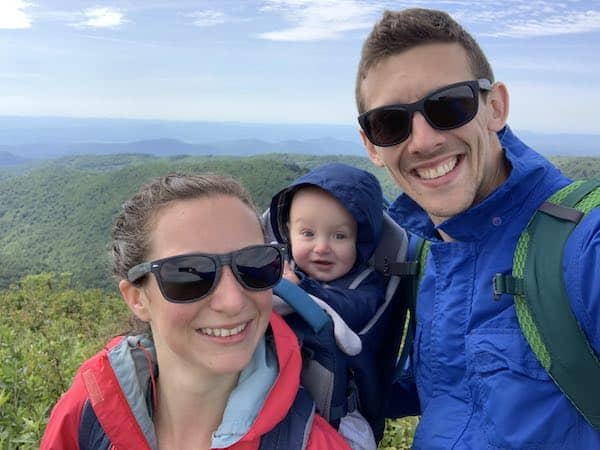
Best Activities to do Outdoors with Baby

Best Water Baby Carrier

Best Baby Gear for the Outdoors
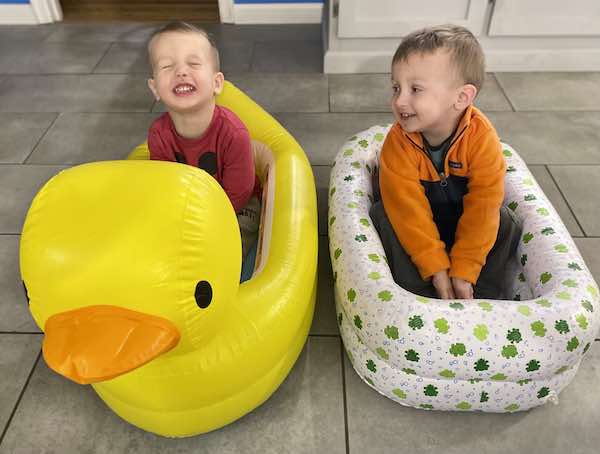
Best Travel Bathtub for Baby
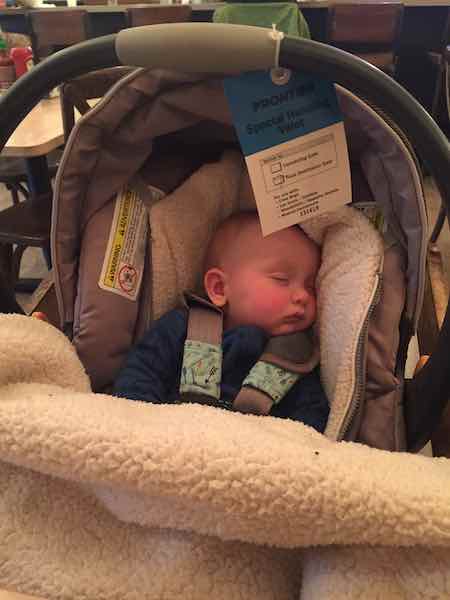
Top Baby Travel Essentials : New Mom Packing List
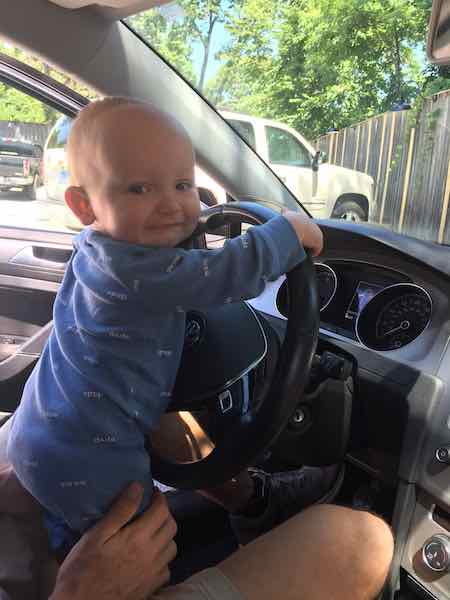
Tips for Road Trip with a Baby
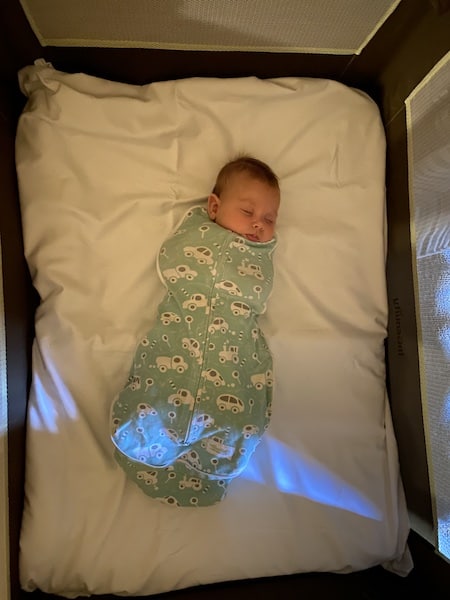
Woombie Swaddle Review
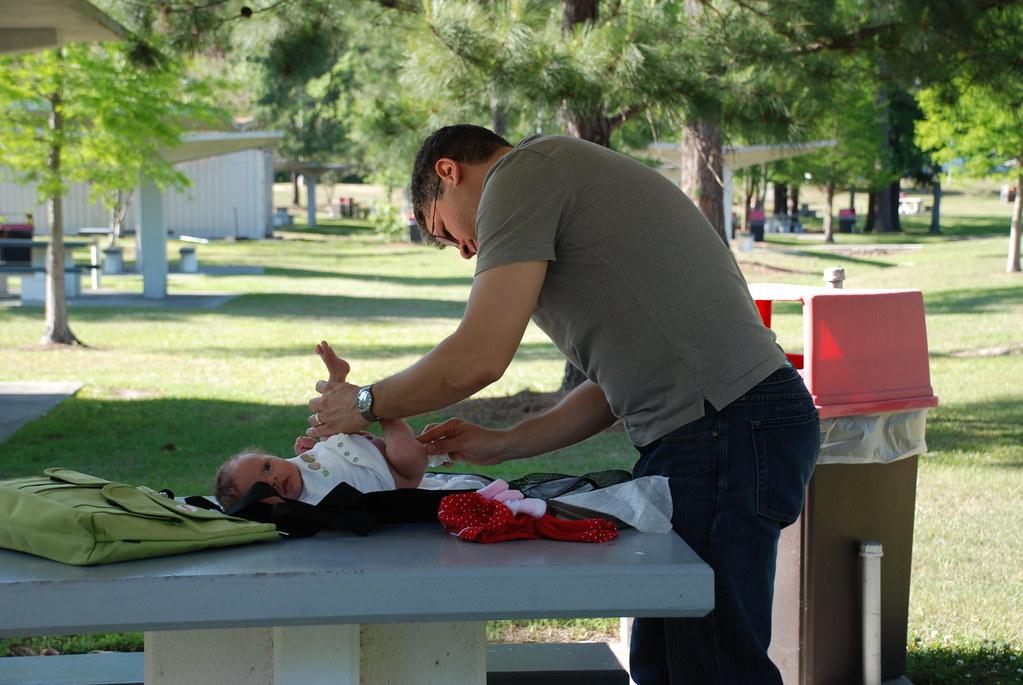
Baby Diaper Blowout: Tricks And Tips

Best Travel Crib

Best Travel High Chair
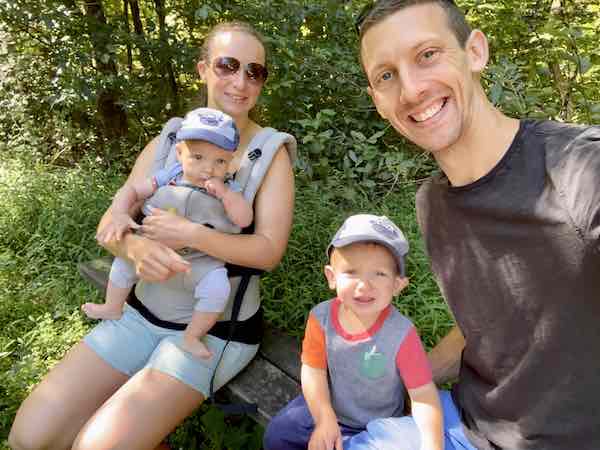
Best Soft Structured Baby Carriers

Receiving Blankets vs Swaddle Blankets: Do You Need Both for Baby?
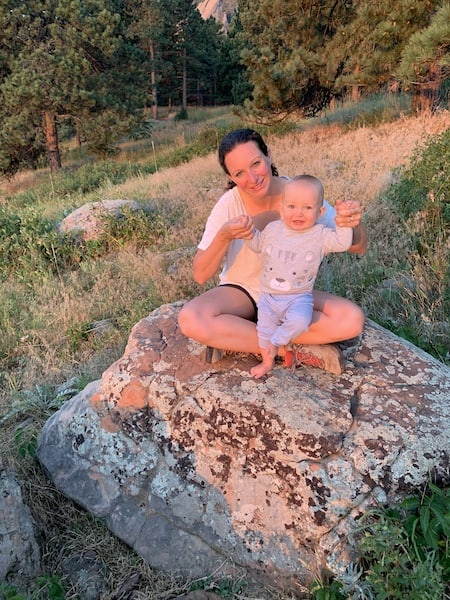
My Pumping Schedule while Breastfeeding
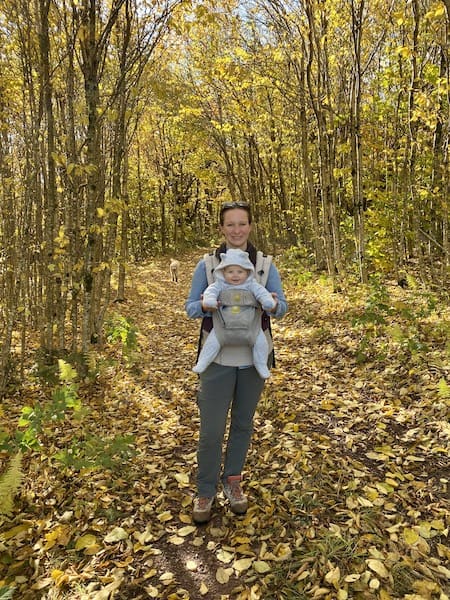
Hiking with A Baby: A Full Guide
Guide for Hiking with a baby
Hiking Trips with a Baby
Hiking has long been one of our favorite activities, so we were eager to learn how to hike with a baby when we had our first child. We have discovered that hiking with a baby is not only easy and enjoyable, but it’s the best way to share our passion for the outdoors with our children.
Whether you are exploring the green spaces around home or traveling with your family internationally, hiking with a baby is a great way to get outside.
With a little practice, a little preparation and the right baby hiking gear, you’ll be able to explore amazing mountain trails and national parks around the world with your baby.
We took our daughter on her first hike up the Grassi Lakes hike in Canmore (near Banff National Park in Canada) at around 6-8 weeks old. I’m not going to lie, our first time hiking with our newborn didn’t go well.
With our tiny newborn in our Ergo baby carrier, we were so proud to have gotten out on our first hike. We thought we were well prepared to go hiking with our baby, but Mother Nature had other plans.
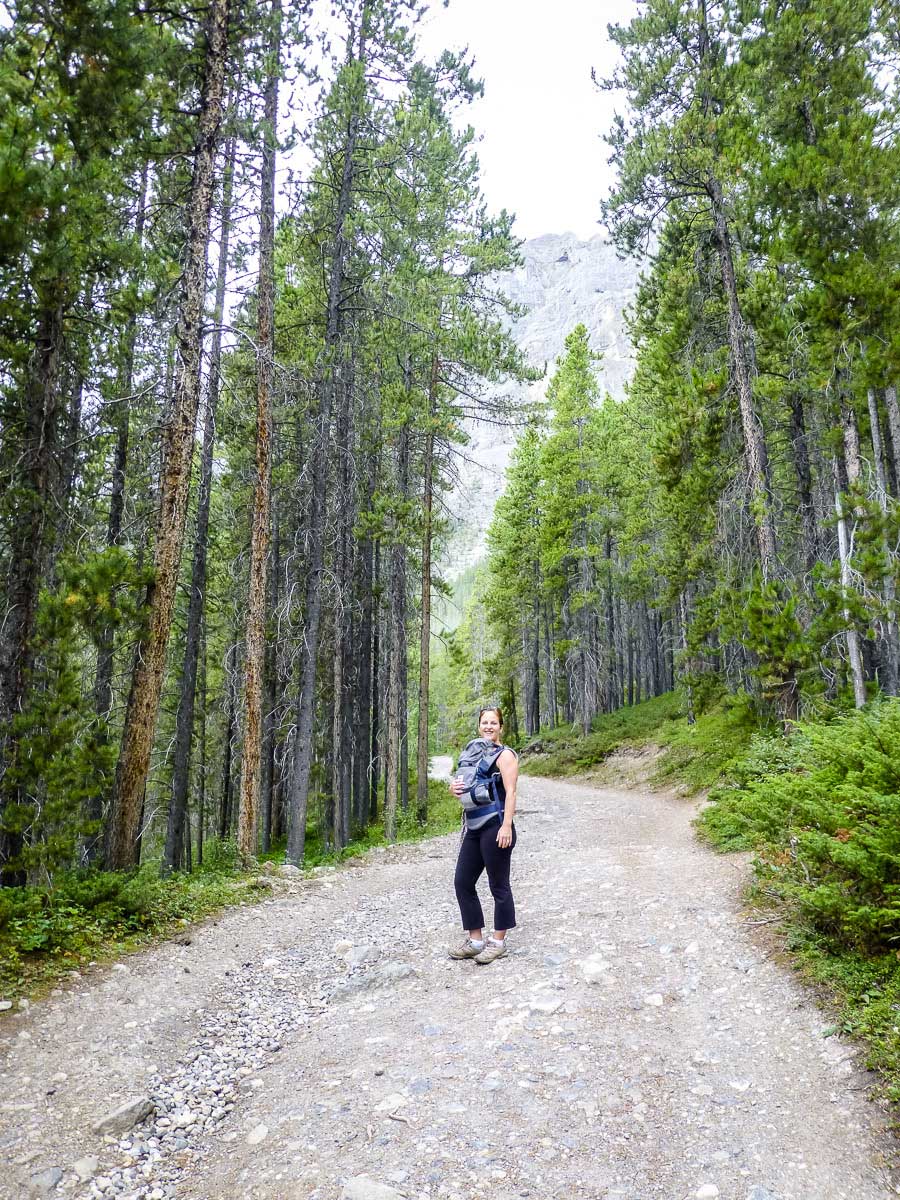
Even though it was a short, easy hike, we didn’t make it to our destination. It started to rain, and as we were hiking with an infant for the first time, it made us feel like the worst parents in the world.
Turns out this wouldn’t be the last time we’d get stuck hiking with a baby in the rain. And I can’t even count how many times we’ve had to turn back before reaching our destination. It’s something that we’ve just come to accept when hiking with babies and toddlers. Turning back early is never easy, but it’s usually the right choice to make for your family.
Despite our challenges learning how to hike with a baby, we persevered and all those struggles early on have paid off in spades. By starting early and bringing our baby hiking, our kids have learned to love outdoor activity and have developed an appreciation for nature.
Our kids are now able to hike long distances (for their ages) and we’ve even accomplished our first multi-day hike to the Lost City in Colombia with a 4 and 6 year old. We’re here to tell you that learning how to hike with a baby really pays off down the road when your kids are older and more physically capable.
WHAT YOU’LL FIND IN THIS ARTICLE ON HIKING WITH A BABY:
Benefits of Hiking with a Baby
13 Tips for Hiking with Baby
Essential Baby Hiking Gear Checklist
What About Hiking Gear for Mom?
More FAQS on Hiking with a Baby
This post contains compensated links.
BENEFITS OF HIKING WITH A BABY
What are the benefits of hiking with babies? The biggest benefit is that it gets you out of the house. It’s a perfect family activity that anyone can do. Your baby is happy to be snuggled in close to you and you get to experience a small part of your pre-baby life.
Sometimes just the accomplishment of getting out and doing something is what we need as new moms. Hiking with your baby in nature will lift your spirits. It will make you feel like you can still get out and do things. Not to mention the benefits of fresh air for everyone!
In my experience, getting outdoors and hiking with a baby is one of the best things new moms can do for their physical and mental wellbeing.
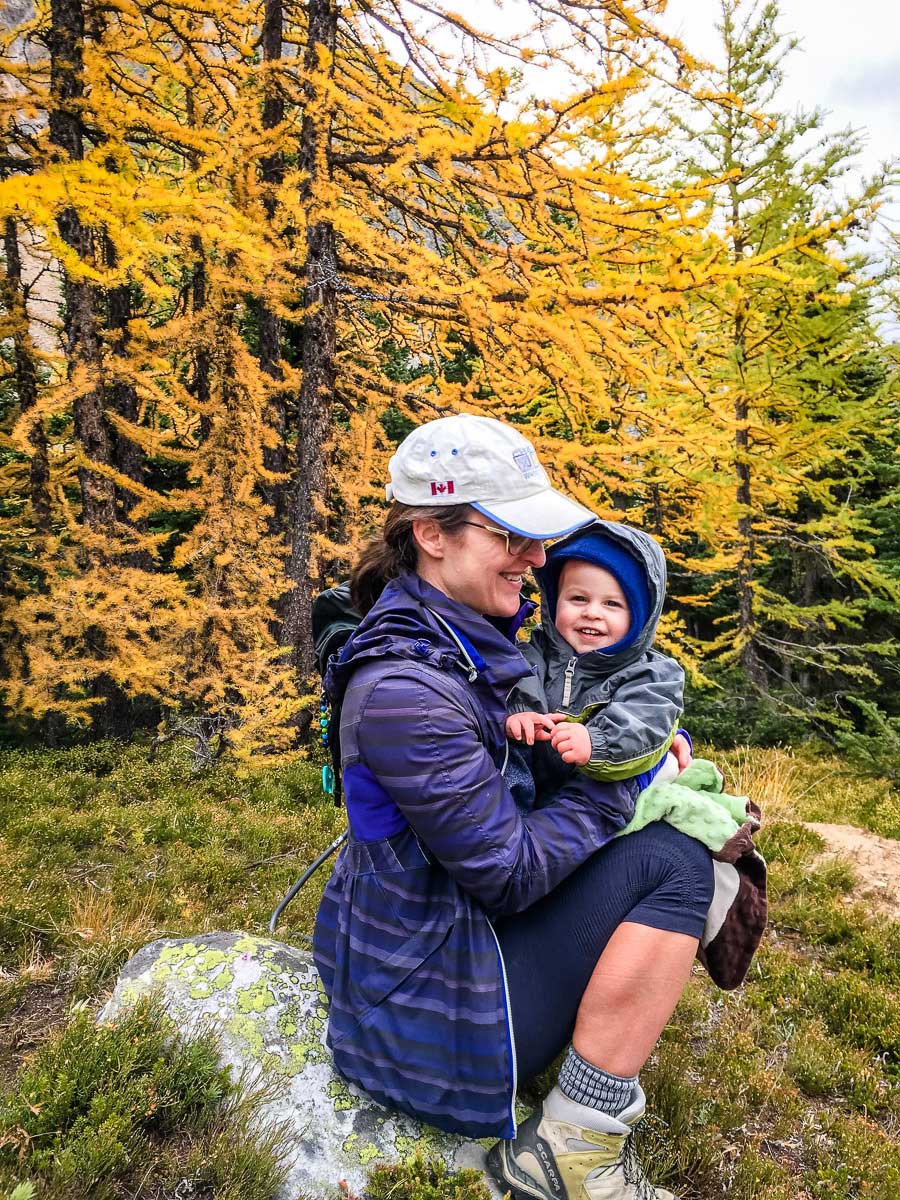
Finally, hiking with babies is something that you can do anywhere. Even when traveling internationally with a baby, it’s a great way to experience the natural beauty of your destination. And it’s the one place you don’t have to worry about your baby crying!
13 TIPS FOR HIKING WITH BABY
Based on our real-life family hiking experiences, here are our best tips on how to hike with a baby:
1. When Can You Hike with a Baby?
I don’t need to tell you that your body has been through A LOT! Give yourself the time to heal before planning your first adventure hiking with your baby.
I know you are anxious to get back out there and do the things you did before having a baby! I felt the same way. I was hiking right up to a couple of weeks before having my first baby. I was just as eager to get back out hiking. It’s just too easy to push yourself too hard, too soon, so give yourself the time you deserve to heal.
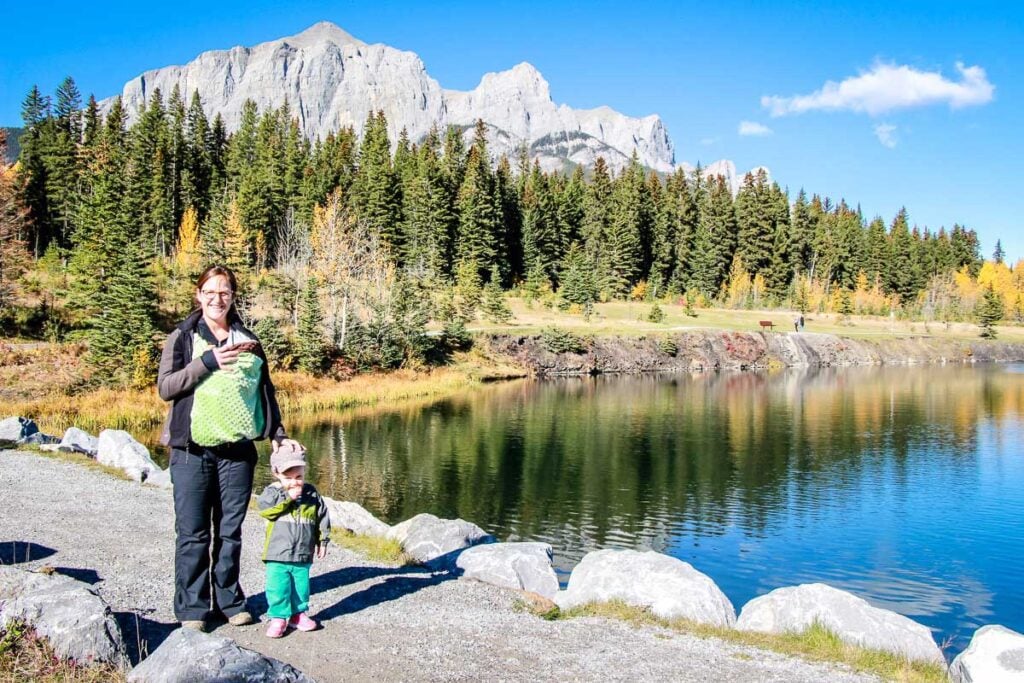
I had a C-section with both kids, so we waited until around 6-8 weeks before taking our newborn on any family hikes. And even then, we started with long walks around our neighborhood followed by easy hikes we were familiar with.
Love sharing the outdoors with your family? Read our best tips for camping with a baby.
2. Celebrate the Small Wins!
When hiking with an infant, it’s very likely you won’t get to finish every hike you start. Rather than stress about it, we believe you should celebrate your family accomplishments!
Finishing a hike with an infant is not the goal. Your family got out and enjoyed nature together. There are huge benefits in just starting a family hike, so even if it didn’t go well, you likely learned something for the next hike with your baby.
Celebrate all of that!
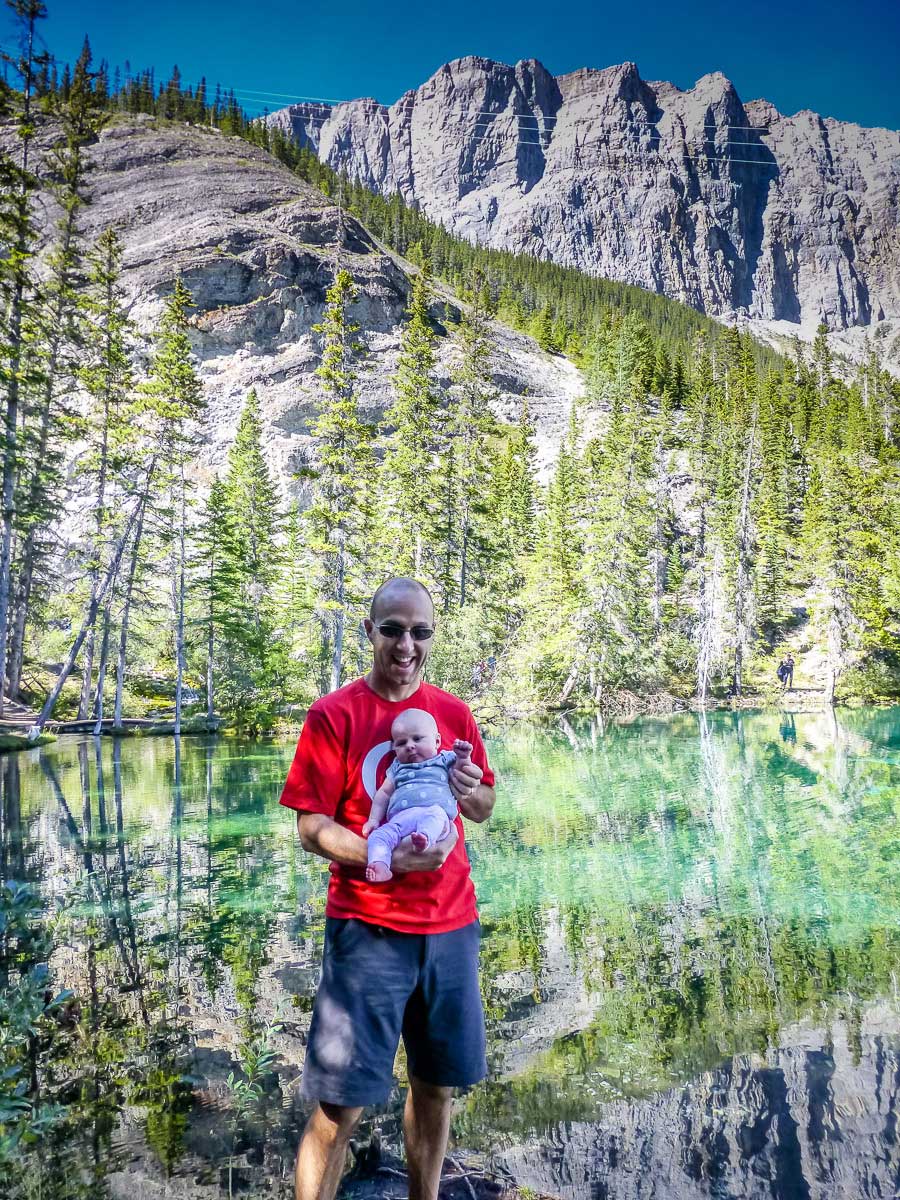
3. Plan Your Family Hikes
Before having a baby, it was easy to go where the wind took you. Now that you have children, you’ll enjoy your day much more if you have a plan. If your baby has a feeding or sleeping schedule, try to plan your baby hiking around that, taking into account the time that it will take you to get to and from the hiking trail.
You’ll also have to factor in the time on the hike to stop and feed your baby, diaper changes, etc.

More importantly, have a checklist for hiking with a baby. If you can, get as much ready the night before as possible. It’s just too easy to forget baby essentials or baby hiking gear when you are trying to get yourself and your little one ready for the hike.
4. Pick the Right Time of Day for Hiking with Your Baby
If your baby will nap on your family hike, then this is the perfect time to be on the trail. This works especially well for hiking with a newborn, who might be spending a lot of time sleeping.
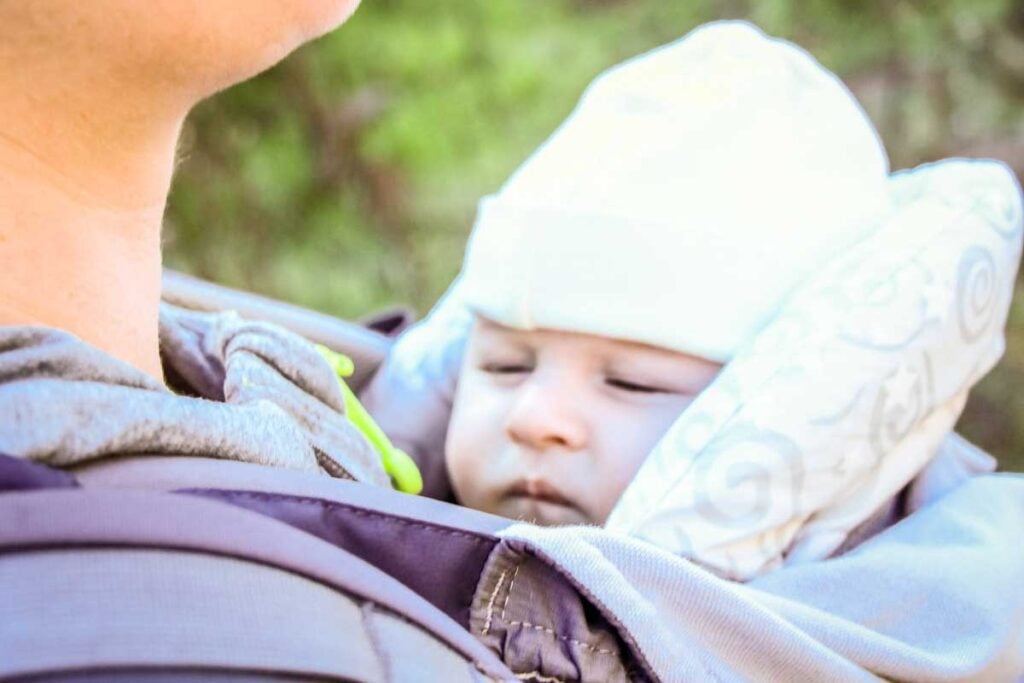
We always tried to plan our hikes with a baby so that they would be napping on the longest part of the hike. Then we’d stop and feed our baby, do a diaper change and continue on.
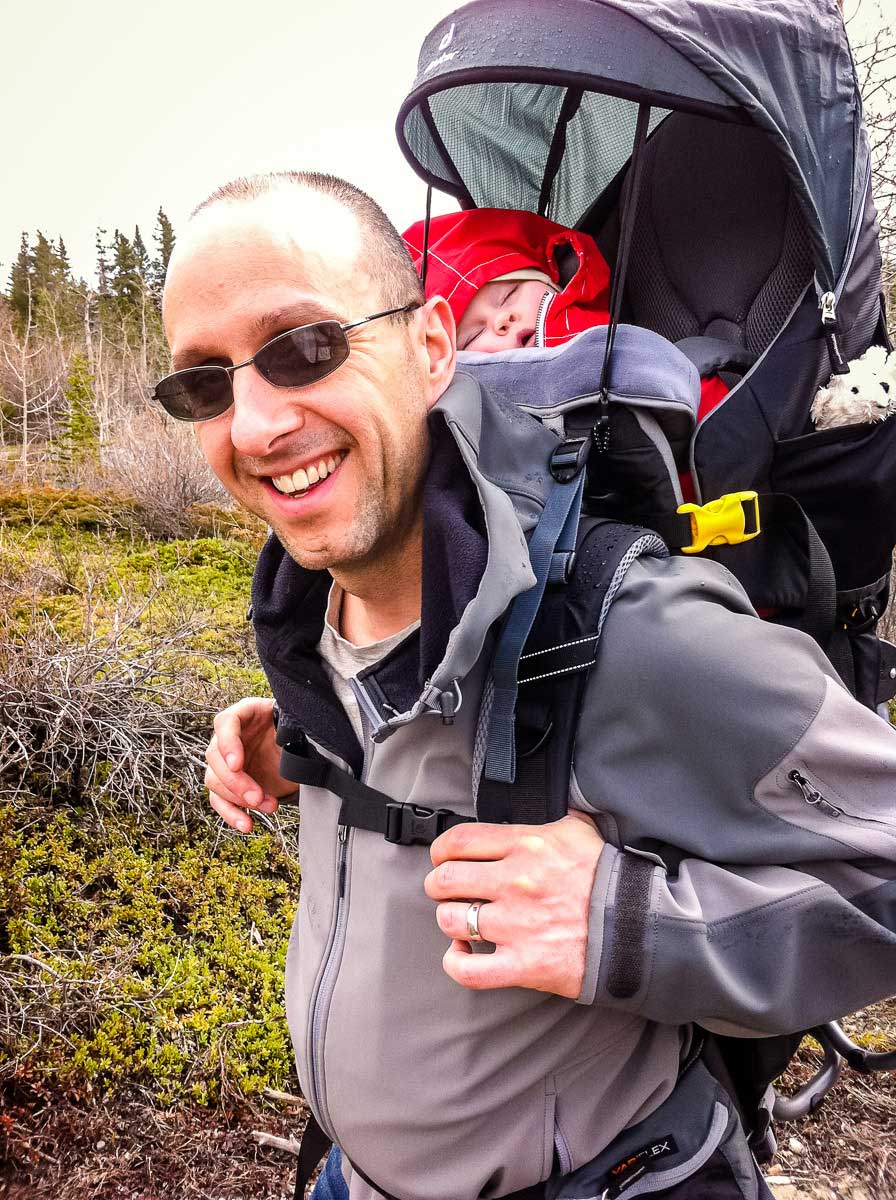
If our baby was going through a phase where she wasn’t doing well napping in the baby hiking backpack, we might opt for a shorter hike in-between her naps.
5. Finding Baby-Friendly Hikes
For your first time hiking with a baby, start with one of your favorite easy hikes you are familiar with. When you have enough experience hiking with an infant and want to find new hiking trails, we recommend you use AllTrails to help find baby-friendly hiking trails.
Find your destination and use the handy filters on AllTrails to set limits on the hike distance, elevation gain etc. You know your family’s capabilities best – just make sure your family hike is something you can do with the extra weight.
Enjoy map downloads and many more premium features with a 7-day free trial of AllTrails+!

Keep in mind that with all the extra responsibilities that come with hiking with a baby, you will hike at a slower pace than pre-kids. Take this into account when picking the best hike to take your baby on.
If you know the hike, you’ll also know if there is a good place to stop and feed your baby on the trail. Depending on the time of year or where you are hiking, you’ll always want to make sure you can hike in the shade to provide some relief from the sun. Especially if you aren’t using sunscreen on a baby under 6 months old.
Need some inspiration? We’ve got just the thing in this list of best hikes with toddlers and babies around the globe and this list of best hikes with a baby or toddler in the USA.

6. How to Dress Your Baby for Hiking
Keep your baby happy and comfortable while outdoors by dressing your baby in layers. Unlike you, your baby won’t be moving, so you’ll probably need to put an extra layer of baby clothing on your child.
You can further protect your baby by using a hiking backpack baby carrier with a good canopy and a rain cover (this will also help protect them from the wind). A backpack carrier for babies is especially good on a hike where you’ll be sweating, as a baby hiking carrier would get your baby sweaty too.
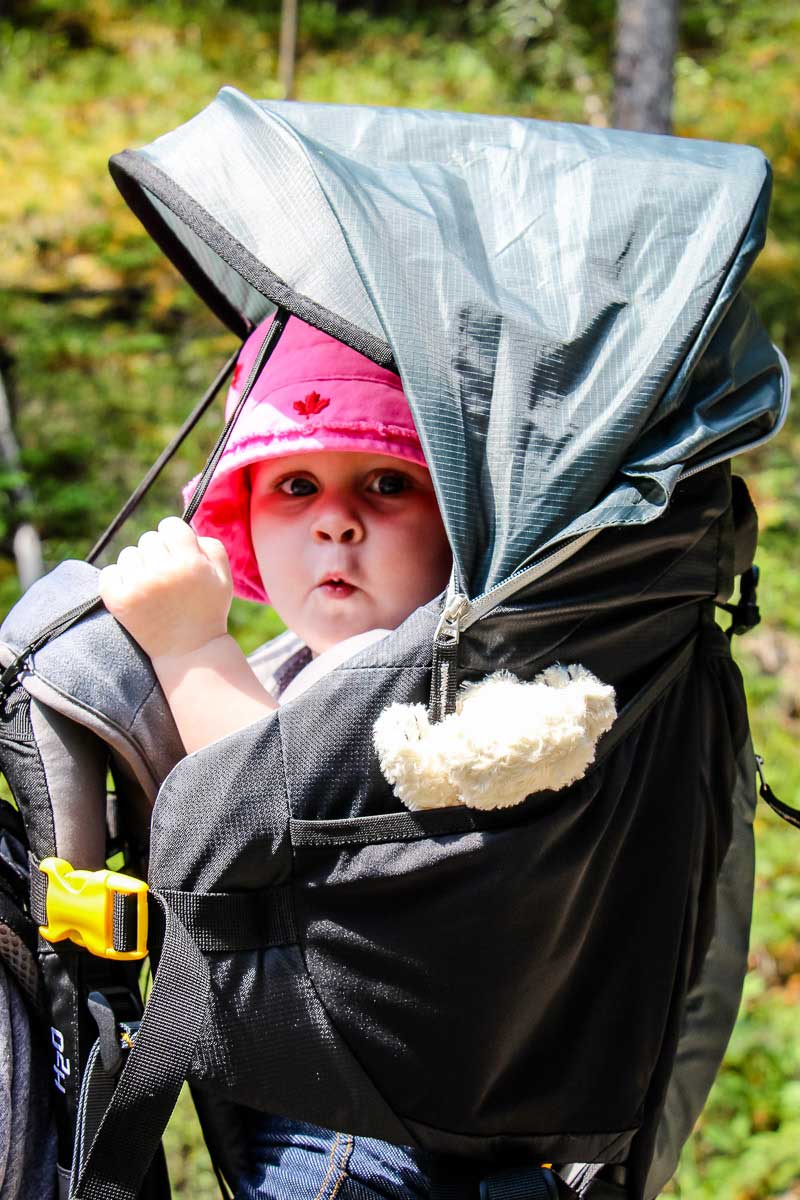
Don’t forget to bring your baby an extra set of baby hiking clothes (in case of blowouts), a sun hat with a wide brim, sunglasses and warm baby hiking booties.
See all these recommended baby sunglasses and best sun hats for babies.
7. Finding the Best Hiking Baby Carrier
The age of your baby and the hiking conditions will determine the best baby carrier for hiking. For example, if you are hiking with an infant, you’ll want a comfortable front carrying baby carrier. If you’ll be hiking in warmer temperatures, opt for a baby carrier that is breathable with mesh panels.
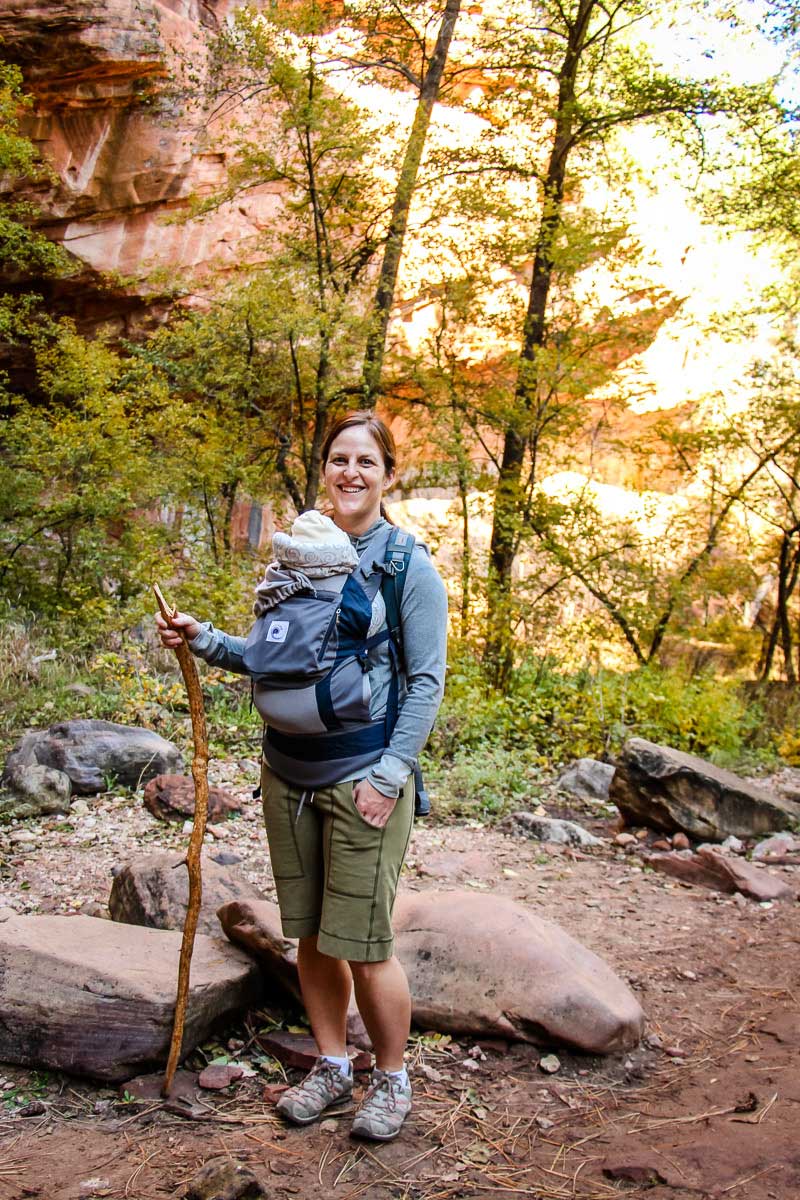
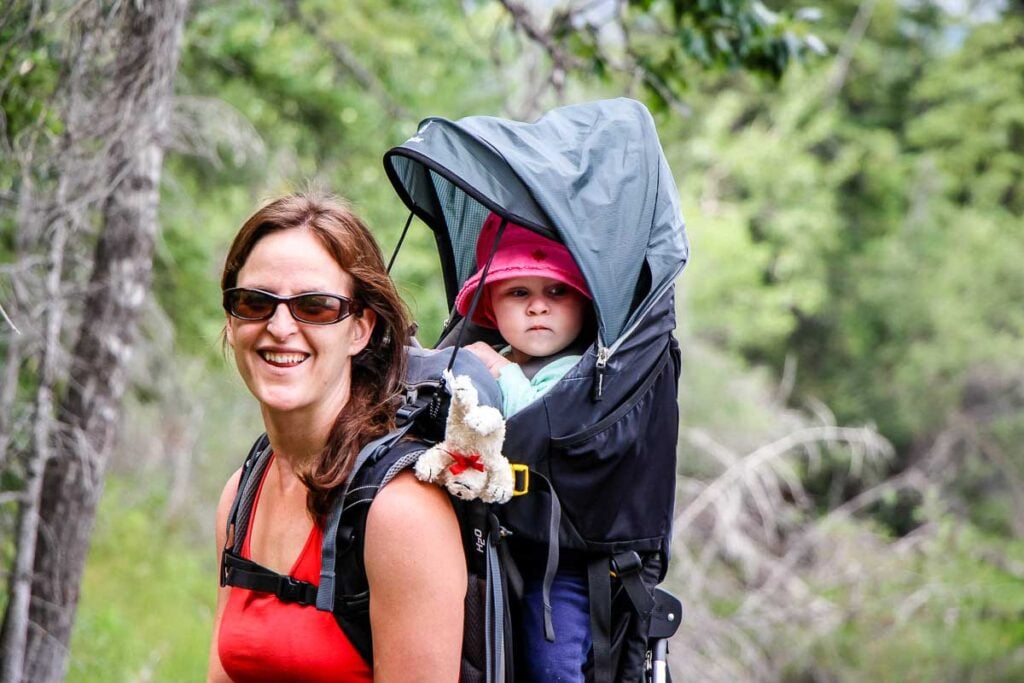
We loved using our Ergo Baby Carrier with the infant insert as our infant hiking carrier.
For older babies, you can look into other options like doing a back carry with your favorite baby hiking carrier. This will make it much easier to hike, since you’ll be able to see the hiking trail a lot easier.
For babies who are able to sit up independently (typically around 6 months), a hiking backpack carrier for babies is one of the best hiking carrier options. We owned two hiking backpack carriers and used them extensively for hiking and traveling with our kids.
As a bonus, hiking backpack carriers will often have enough compartments to carry snacks, diapers, water and all your baby essentials for hiking. It also keeps you and your baby cooler since you two will not be in direct contact with each other.
8. Hiking with a Stroller
If you prefer to hike with a stroller, it is possible to find stroller-friendly hiking trails. Though your options may be more limited, with a little research you should be able to find suitable hiking trails for a stroller.
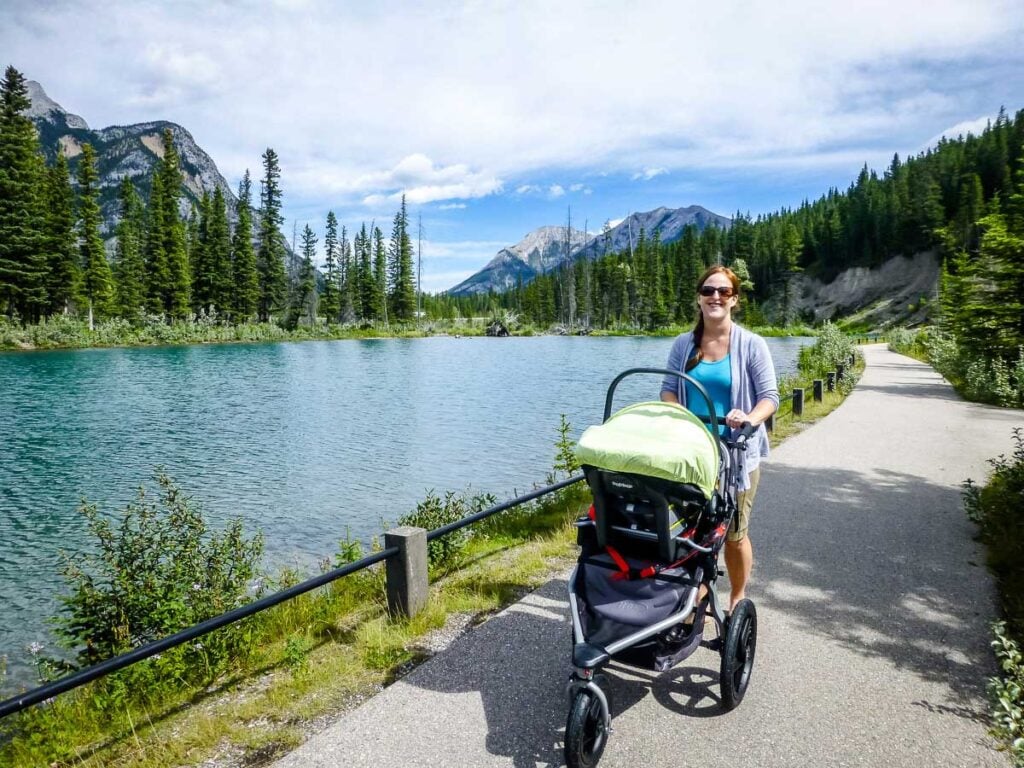
Look for walking trails that are wide and relatively flat. You’ll also want an all-terrain stroller like this one if you aren’t going on a paved trail.
9. Feeding Baby on the Hiking Trail
Be prepared for feeding your baby on the trail. If you are breastfeeding, it’s pretty easy to find a comfortable place to stop to feed your baby before continuing on your hike.
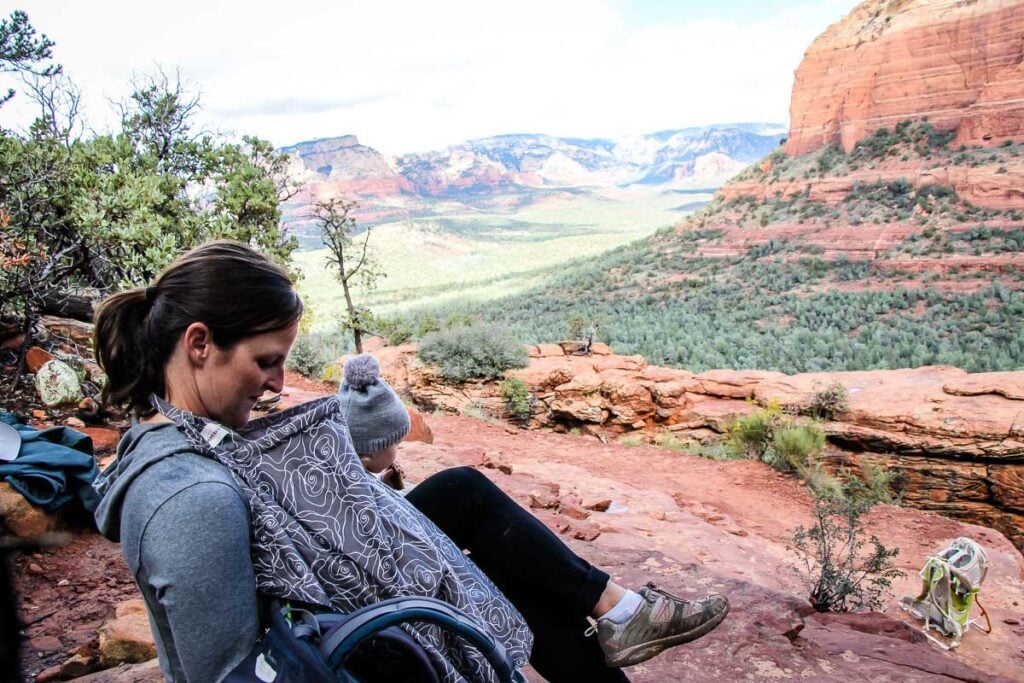
For formula fed babies, pack your formula in a measured formula dispenser, a travel bottle warmer and some extra water in a thermos to make your bottles on the go. Be prepared to make a few bottles on the go just in case the hike takes longer than anticipated.
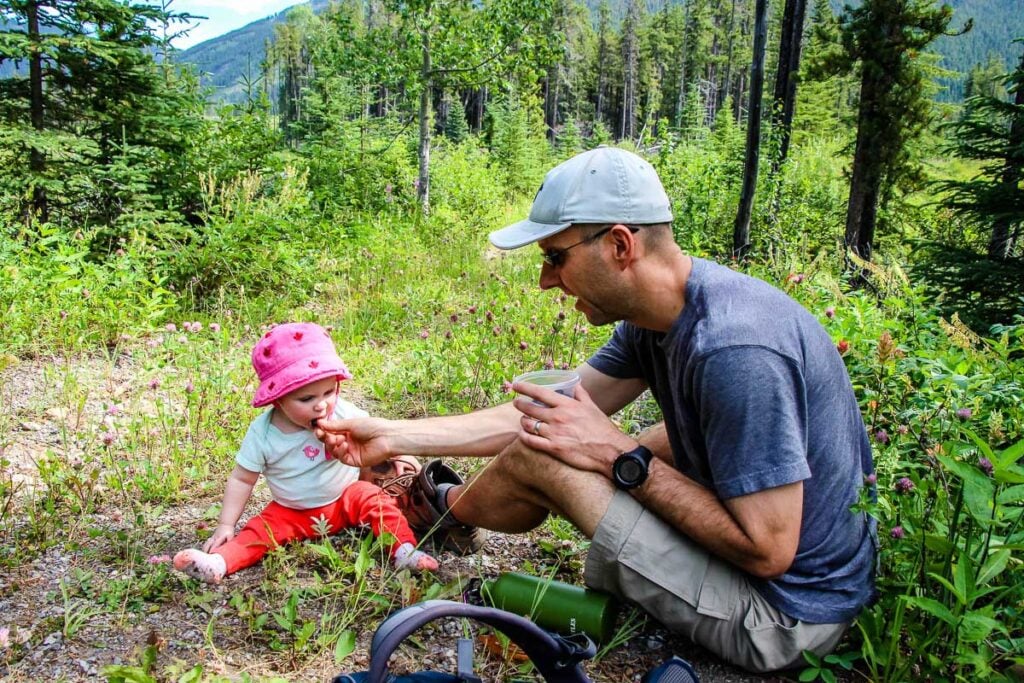
For babies who are starting on solid foods, here are some great options for hiking snacks for babies:
Easy to grasp fruit like cut up blueberries or bananas
Cooked and cut up vegetables like sweet potato
Cheerios in a snack cup
Small pieces of bread without crusts
Teething wafers or other dissolvable snacks
10. Changing Diapers on the Hiking Trail
A portable change mat is must have baby hiking gear because it’s almost a guarantee that you’ll be changing your baby on the hiking trail. Make sure to bring plenty of wipes (in a protective baby wipes travel case) and an extra outfit (or two) for those blowouts.
Out of respect for your fellow hikers and local wildlife, you’ll need to pack out all your garbage. A wet bag for your little ones dirty clothes or diapers is perfect for this purpose.
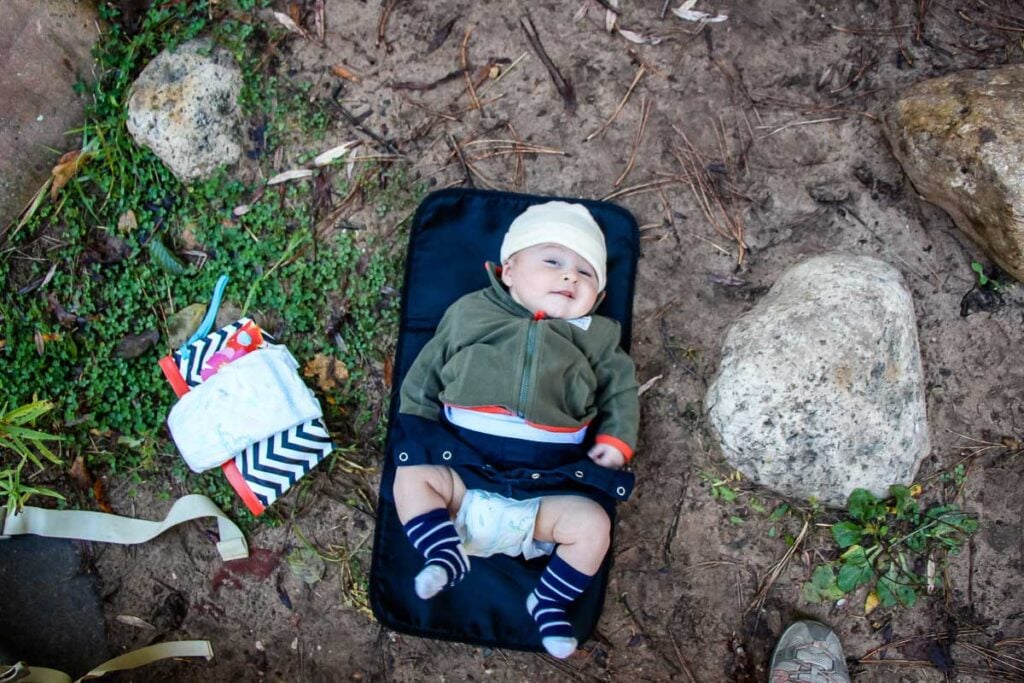
11. How to Carry all the Baby Hiking Gear
In addition to your baby, you’ll also be carrying all your baby hiking essentials. If you are hiking with someone else, you can share the load by having the other person carry the diapers, wipes, snacks and other essential baby hiking gear in their backpack.
Otherwise, a hiking backpack carrier with a storage compartment is your best option. They typically even have a spot for a water bladder which helps keep everyone hydrated while outdoors.
If you are front carrying your baby on the hike, you can carry all your hiking essentials in your own backpack.
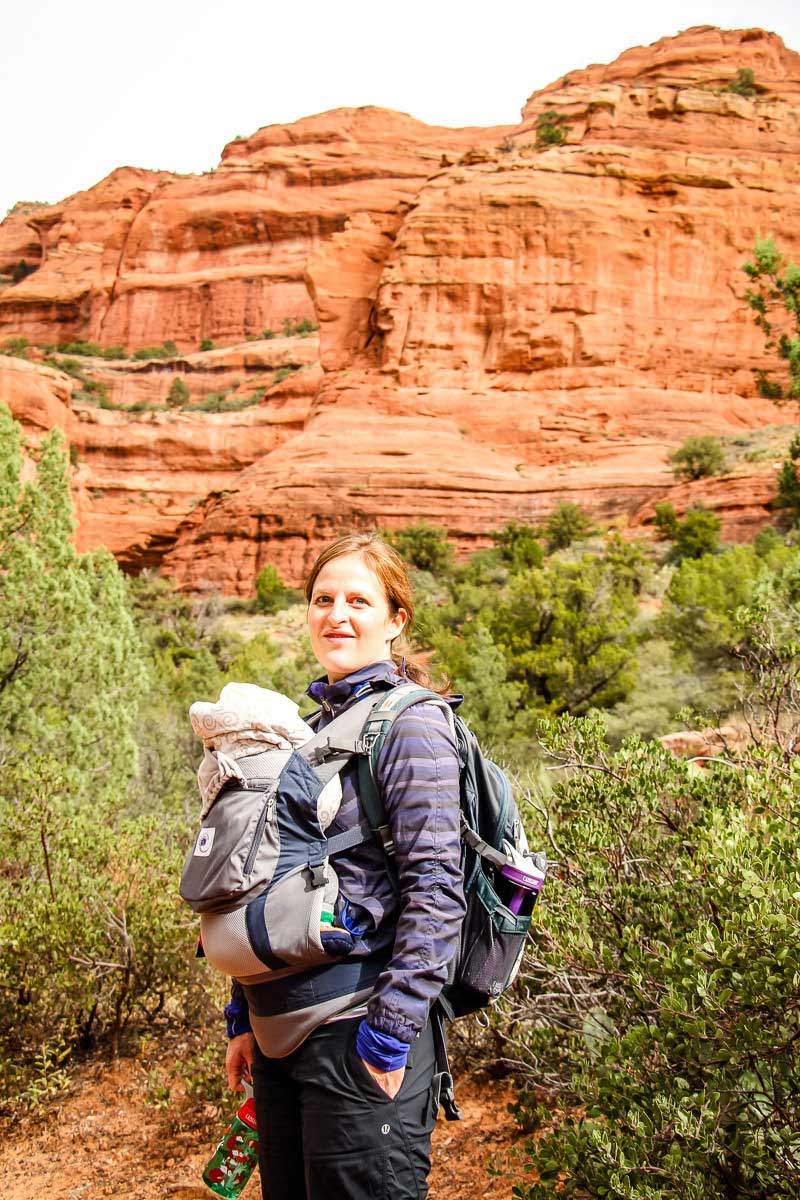
12. Hiking With a Baby in the Rain
Weather can be unpredictable in the great outdoors, so be prepared for the elements. As I mentioned earlier, our first hike with a newborn ended with us being caught unprepared in the rain. If you are hiking with a newborn and need a rain cover, get one of these rain covers for baby carriers.
Once we started to use a backpack carrier, we bought a rain cover and brought it everywhere with us. The rain cover also worked well for extra wind protection.
13. Hiking With a Baby in Winter
Hiking in the winter with a baby is one of the best outdoor winter activities with a baby. All it takes is a little preparation and the proper winter hiking gear. You’ll want to make sure to check on your baby often as your baby will be much colder than you as they are not actively moving.
Feeding and diaper changes also get more complicated, as you’ll want to keep your baby warm. We recommend picking the mildest of days for winter hiking with a baby.
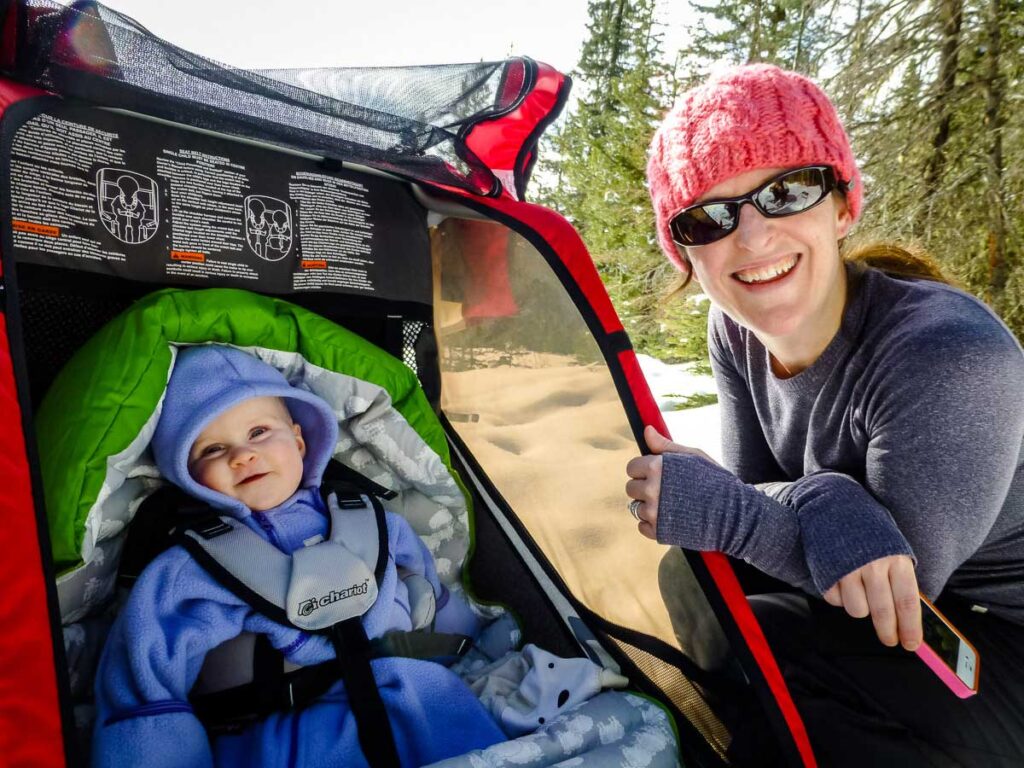
See our recommendations for winter gear for babies here.
Discovering Nature Play with Babies and Toddlers
Fun Things To Do With A Baby Outside The House
There will come a point in your baby’s early life when you will need to get out of the house. Whether for your own sanity, a change of scenery, or to encourage your baby to learn to nap outside the home.
Whatever your reason is for getting out of the house, you can do it! Leaving the house with a baby can feel overwhelming, especially if you haven’t done it alone or if you don’t leave very often. Babies seem to need a lot of stuff when they’re on the go, but we’re confident you can find your footing and enjoy time in the great outdoors with your little one.
This post shares the best things to do with a baby outside the house and our tips and tricks on how to make each of these activities stress-free, enjoyable, and memorable for you and your baby.
If you are reading this, you are probably in one of two situations. A – you are a new mom struggling with cabin fever. However, you have realized that a newborn can make venturing into the outside world an overwhelming undertaking. Or B – this is not your first rodeo, but you are looking for ways to spend quality time with your other kids and bonding as a family.
Time is Fleeting
But the newborn period is precious and fleeting, and making memories is what family time is all about. Unfortunately, with a new addition to the family, it can feel like you have less time than ever to create those cherished moments. However, families with a newborn can enjoy plenty of activities together. So keep reading for ideas on how to make the most of this wonderful time as a family.
Go for a Hike
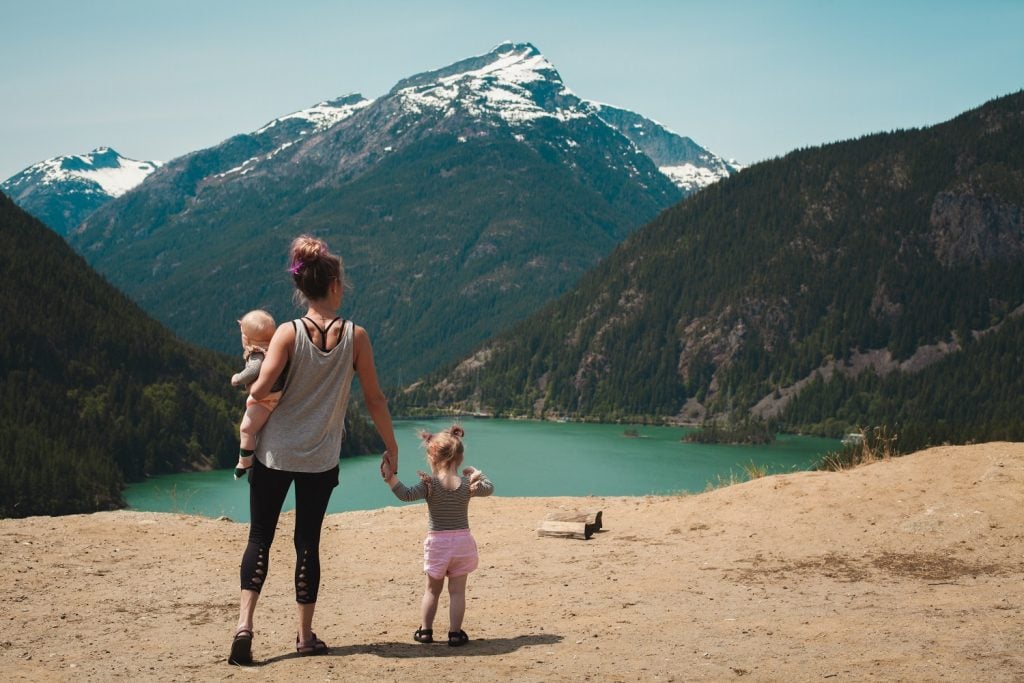
This may sound overly ambitious. When it first came to mind, I conjured images of myself trying to climb a mountain with an overloaded diaper bag and breast pump in hand. All while my husband tries to stop our toddler from seeing if his Superman cape is the real deal. But then, I realized that we had the power to tailor our adventure to suit reality.
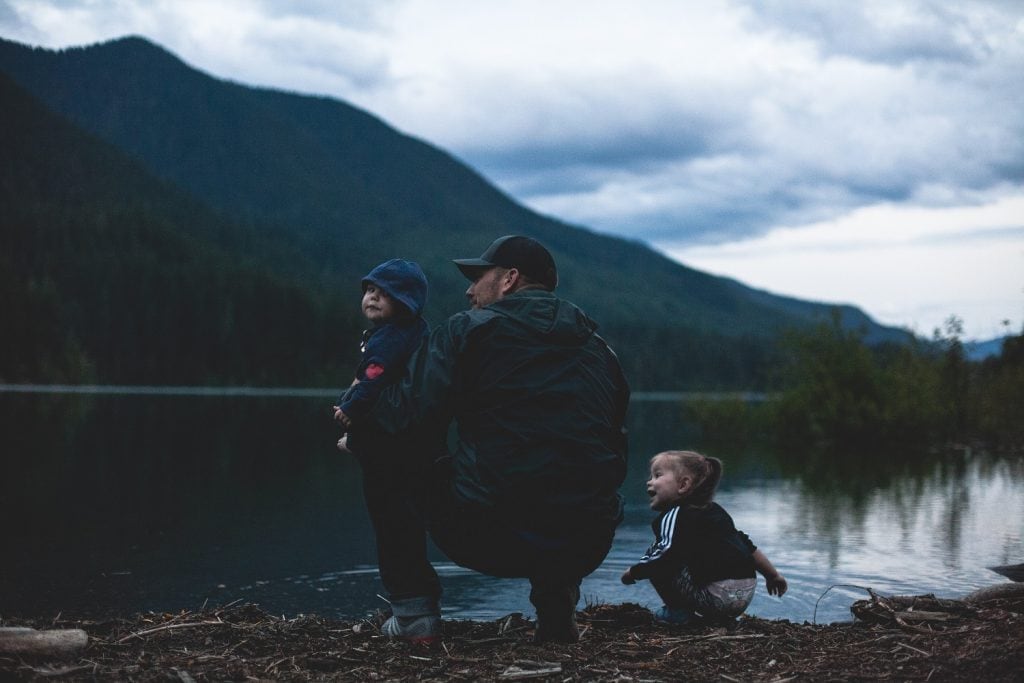
Fresh air and exercise are probably the best gifts you can give yourself. And a hike is the perfect way to do this while having some family time. And you don’t have to climb the Matterhorn. Instead, a lush forest or shoreline trail are great places to reconnect with nature. You can even use your stroller to make it easier on the little one. The great thing is that hikes are suitable for any age, and you can make it as long or short as you like.
Related post: Surviving the First Few Weeks with a Newborn and Toddler
Go to the Museum

I can just imagine you rolling your eyes, thinking ‘As if”, on this one. But our tired brains sometimes make us think inside the box too much. I am not suggesting you take your toddlers to the Met. Many museums focus on themes and exhibits that will suit small kids. Some offer special family programs, guided tours, hands-on activities, and even baby yoga. Go online to see which museums near you provide something that tickles your family’s fancy.
Going for a Swim
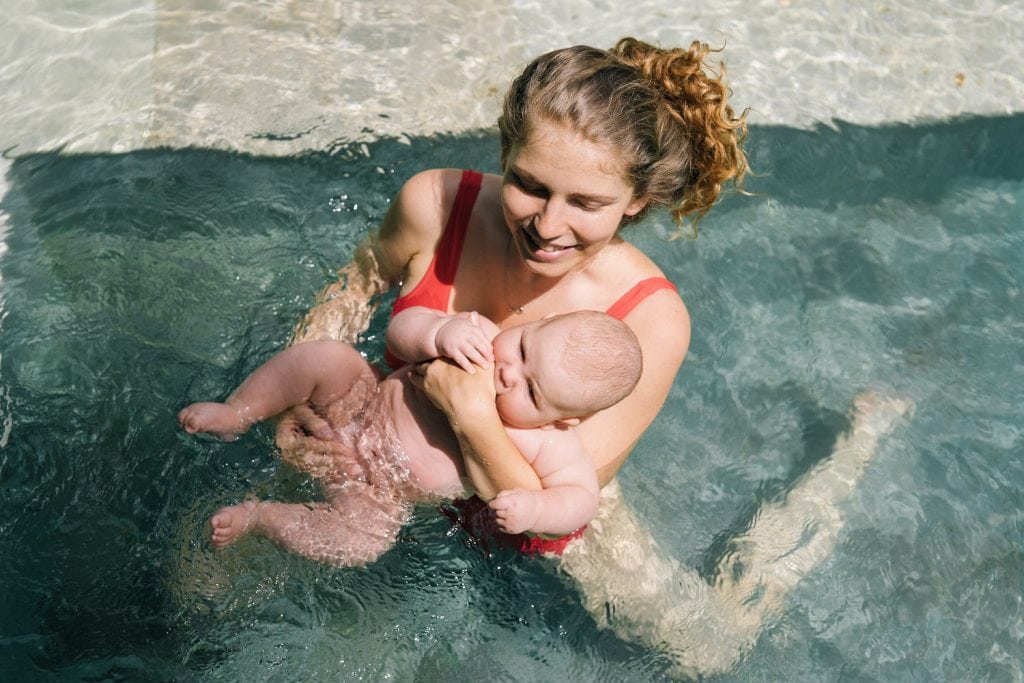
Swimming can be an excellent way to spend time together as a family and introduce your newborn to water. In addition, an outing to a pool or lake can be a great way to cool off in the summer heat, get your blood flowing nicely, and help you relax. There are, of course, some logistics to consider with this one. There is no way you can handle a newborn and small kids in the water on your own, so make sure you go as a couple or with friends and family that you can trust to be as vigilant as you are. Make sure your older kids have the appropriate flotation devices. And whatever you do, don’t forget to pack sunscreen.
Related post: Things to do with a Newborn in the Summer
Going to the Beach with a Baby: Tips and Tricks
You’ll notice that I list the beach separately from going for a swim. The reasoning is obvious. The beach with a newborn is a different animal entirely.
It is perfectly safe to take newborns to the beach. The main thing to keep in mind is keeping them out of direct sunlight and ensuring they are hydrated. Newborns can get dehydrated quickly, so it’s important to keep an eye on them and ensure they drink plenty of fluids. Also, dress your baby in light, breathable fabric, and ensure they are smothered in a good sunscreen.
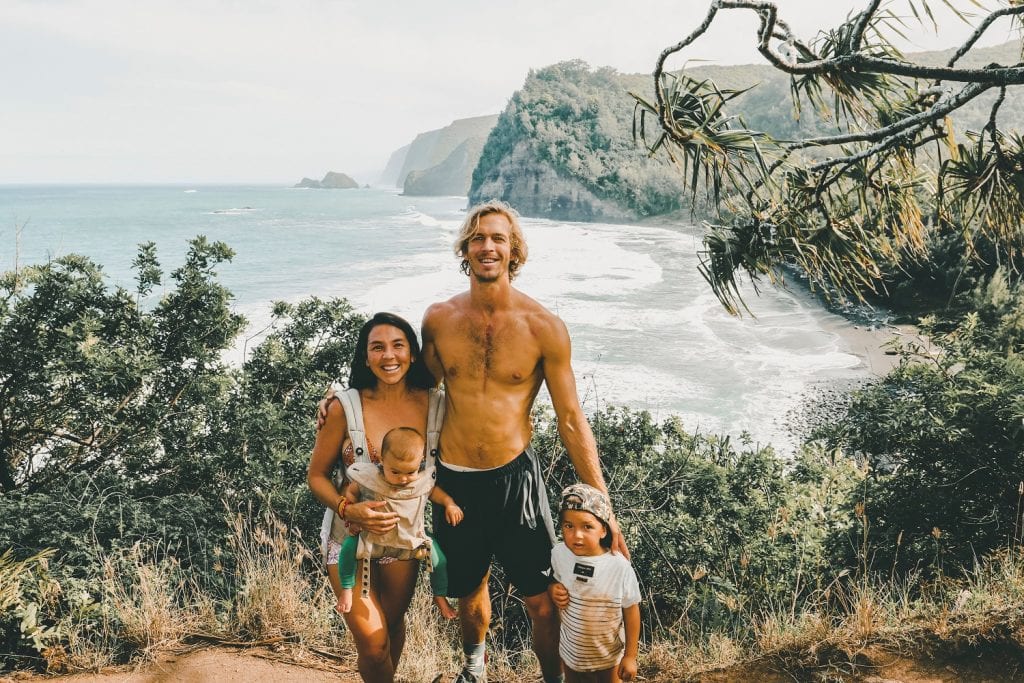
Accept that there will be sand…on everything. The good news is that sand can be washed off. The bad news is that it will most likely find its way into every single little crevice imaginable: your baby’s hair, their ears, their nose, their mouth…the list goes on. Just go with it and try to relax – If you enjoy the experience, your baby will likely be relaxed and calm. On the other hand, if you are stressed, tense, or anxious, your baby will probably pick up on that and become stressed or anxious as well.
Visiting a Zoo
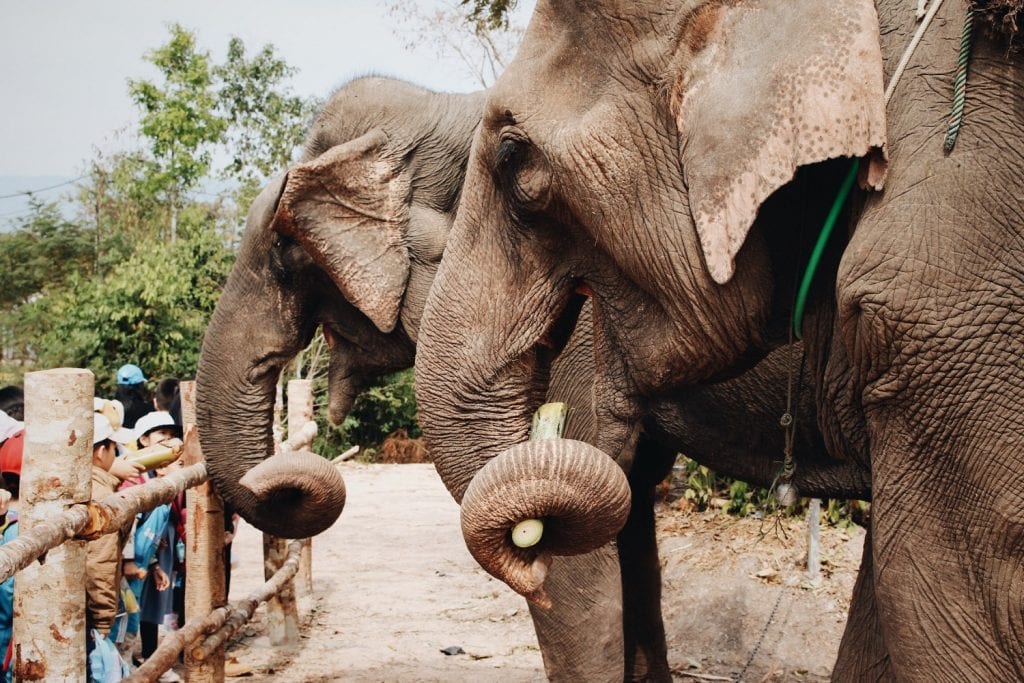
It always amazes me how kids have this natural obsession with animals. It seems to be universal, and I think it’s pretty cool. So this is an outing that would most definitely have your older children’s buy-in. And if your newborn is your first, it’s still a great place to get outdoors and not worry too much if your baby gets noisy and niggly. Who can really complain about natural behavior and instinct when they are at a zoo?
Related post: Things to do with a Newborn in the Winter
It’s not as overwhelming as you think.
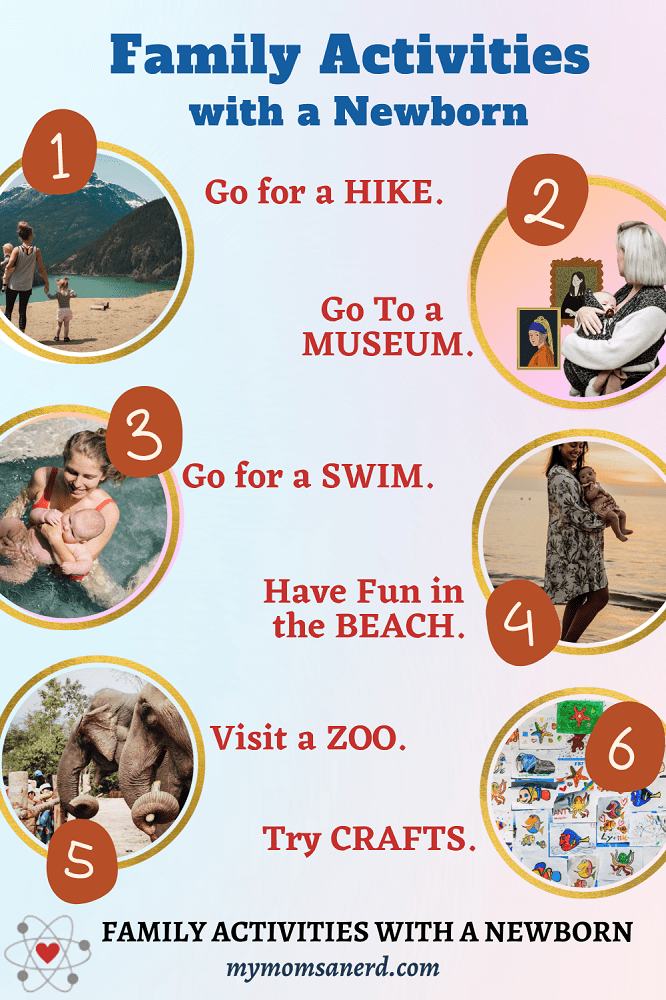
As you can see, I have tried to be as pragmatic as possible with these suggestions. And yet the very thought may seem overwhelming. I recently watched a couple of Friends reruns and had a good eye-roll. When Rachel was a new mom, newborn baby Emma popped out for scenes central to the plot, but other than that, Rachel’s life carried on uninterrupted. Her figure was back, and her skin was glowing – heck, she even went on a couple of dates. And there I was, high-fiving myself for successfully going out to clear the mailbox without bursting into tears.
But you’ve got this! Gently easing into the outside world will make a world of difference to your family and you. Take care of yourself. You matter.
Related ideas: Things to do with a baby outside the house!
Visit a park
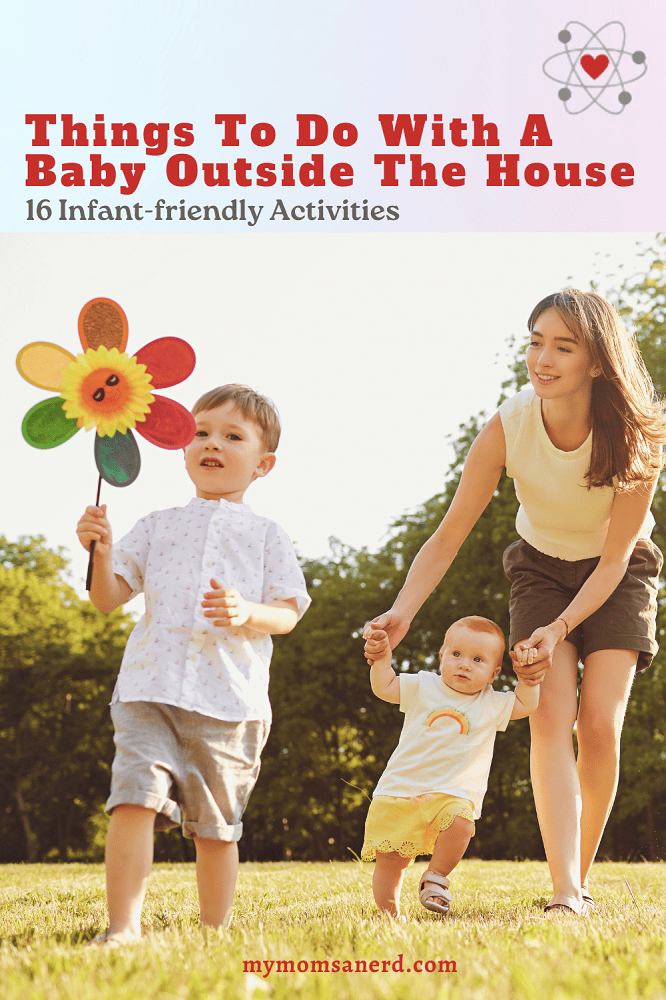
If the weather permits, pack a lunch or snack and head to a local park. Sit in the shade or find a picnic table where you can be comfortable.
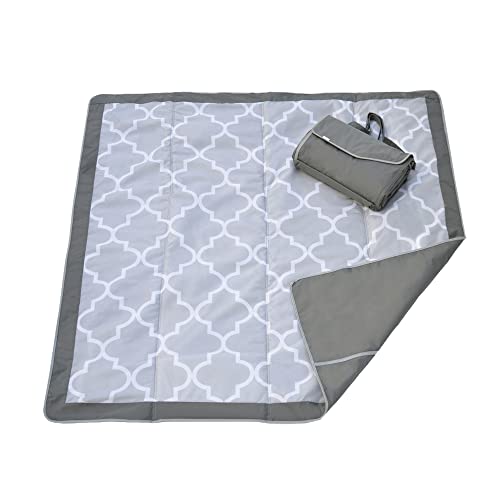
If your baby is awake, help him sit on an outdoor playmat to watch the birds and point out all the things you can see and hear. Bring his favorite toys so he can have some playtime outdoors.
If your park has walking trails, take your baby on a stroll and let him explore and people watch. An outing at the park is free and is a great way to get out of the house without making a huge commitment. If your baby gets fussy, you can pack up the car and go home.
Go to the playground
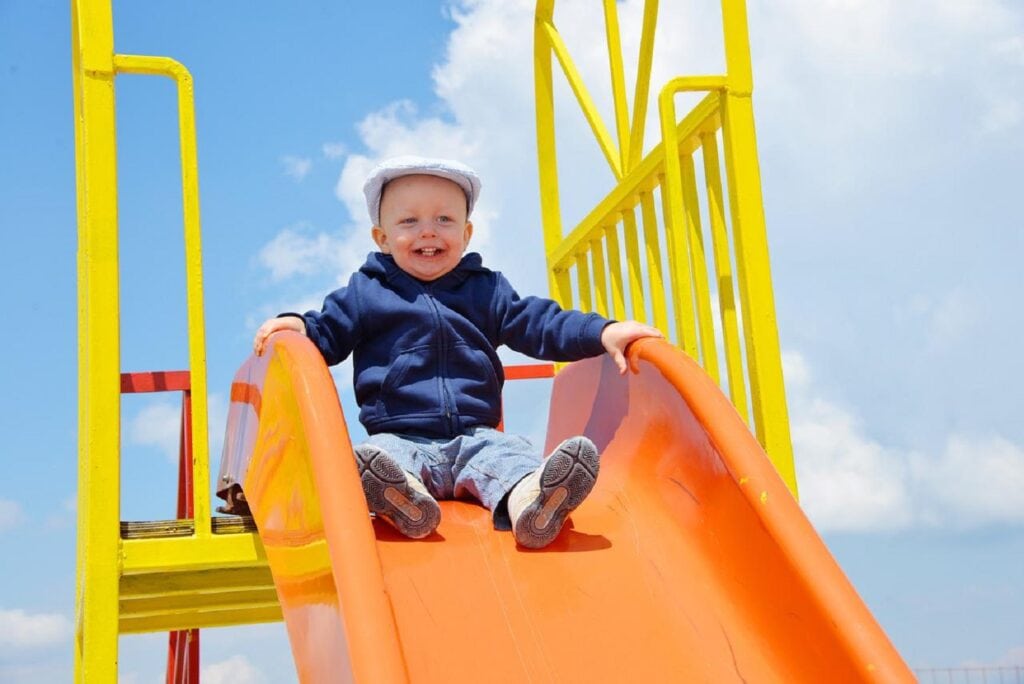
Perhaps your local park has a playground or there is one near your house that you’ve seen. On a day when your baby seems energetic and eager to play, the playground is a great place to get some energy out.
Try to plan a playground visit when kids are in school. This way, you won’t have to worry about your baby trying to play in their space. Big kids can play rough, and your baby may get overwhelmed.
If there are already kids at the playground when you arrive, try sitting on the swings with your baby or playing in an area that isn’t crowded.
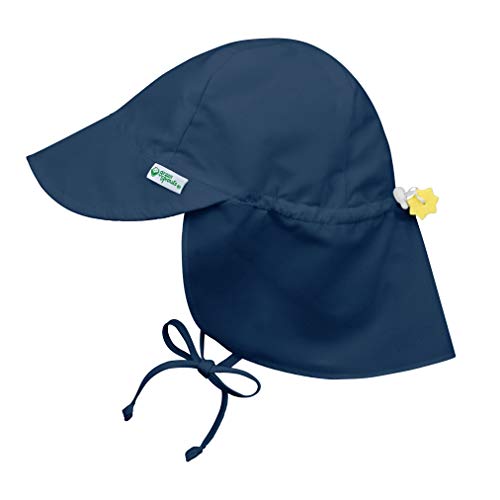
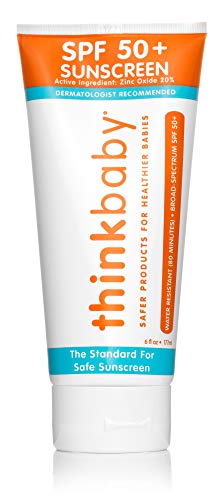
On a sunny day, don’t forget your baby’s hat and sunscreen!
Try baby gym classes
Most cities have a Little Gym or a similar indoor gym, where parents can bring their babies for a 30-minute class.
Indoor gym classes can help improve your baby’s strength, balance, and coordination. Most gyms offer classes that are Parent/Child style, so you can sit with your baby and help them climb, play, crawl, and more.
These classes usually include music, clapping and singing, and lots of playtime. The majority of classes are for babies around 4 months old, who are starting to become more aware of their surroundings and their curiosity is ignited.
Join a local mom group
Whether you’re new to the area or are just looking for friends who are in the same phase of life as you, local moms or parenting groups can provide the support and interaction you and your baby need.
Some groups are free to join and organize monthly meet-ups, while others offer fitness classes along with playgroups and outings. Make sure to check local Facebook groups or MeetUp to find the best group for you and your baby.
Go to the library
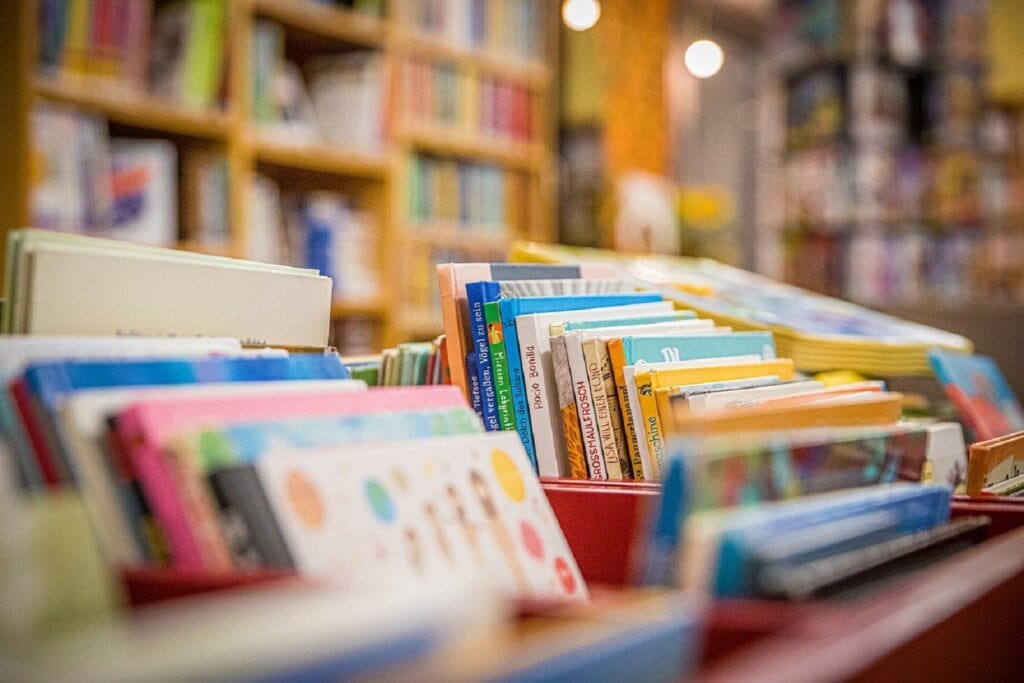
Visiting the library is one of the best things to do with a baby outside the house, because it’s free and you don’t need to pack tons of stuff. Grab your favorite portable snack container along with the usual diaper bag necessities, and you’re out the door!
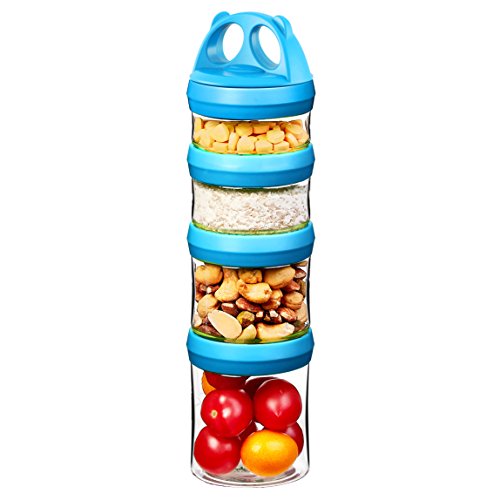
Check your local library’s website to see if they offer story hour for babies and toddlers. You may need to reserve a spot to join.
Your baby will enjoy singing songs, looking at pictures in books, and playing with other babies. You’ll meet other parents and spend time bonding with your baby.
Take a stroll
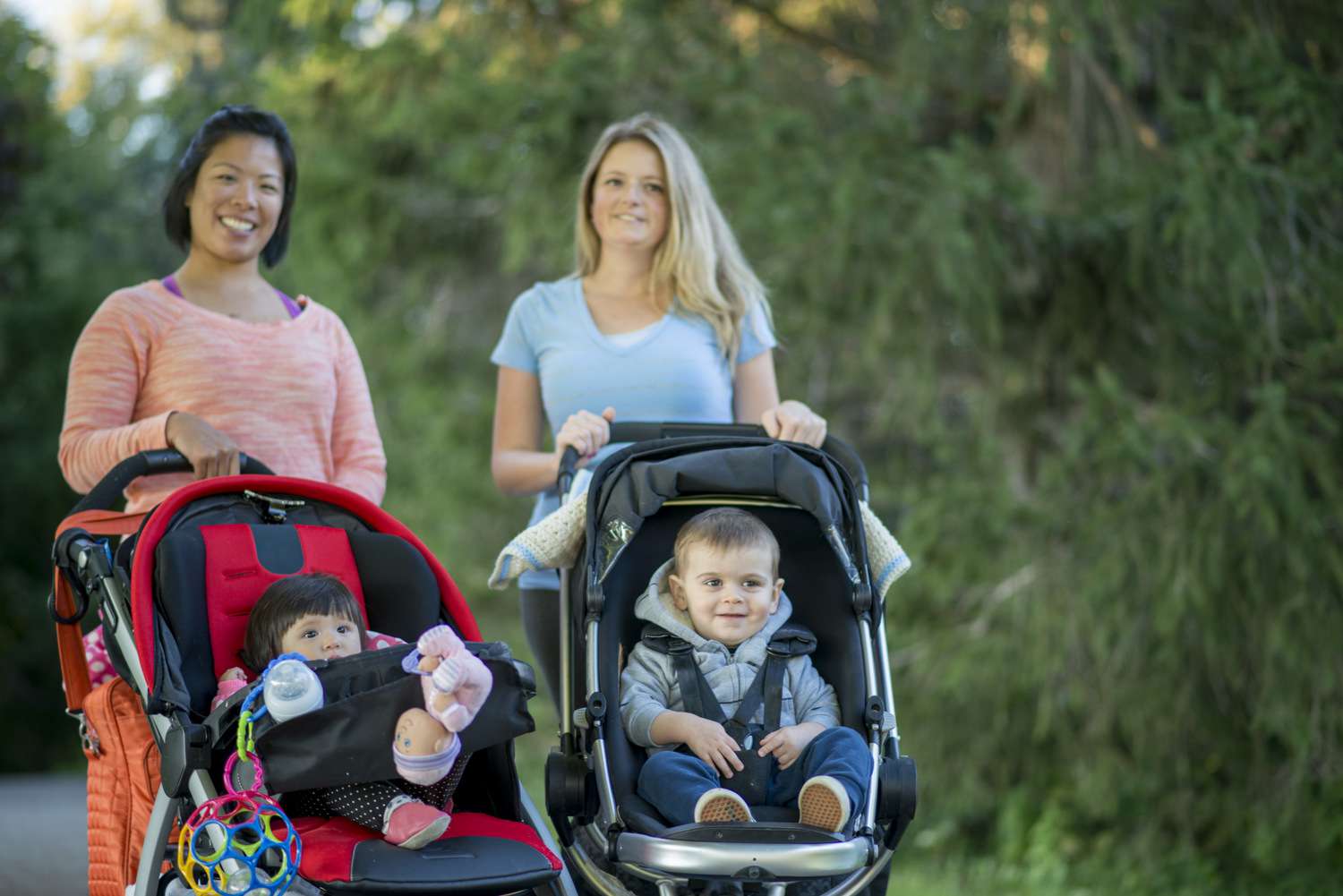
Sometimes, a healthy dose of Vitamin D is all we need to have a great day. If your baby is grumpy or fussy, grab some water and snacks and hit the pavement with the stroller.
A simple walk around the neighborhood may suffice, or head to a local park to get your steps in. Walking has great health benefits; from improving endurance and cardiovascular health to boosting energy and mood, there are many ways you can benefit from a long walk outside.
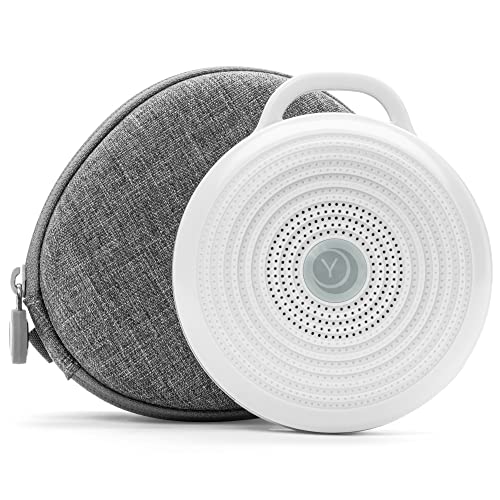
If you think your baby may fall asleep during your walk, don’t forget a portable sound machine to create the ideal sleeping environment for your little one.
Go out for a meal
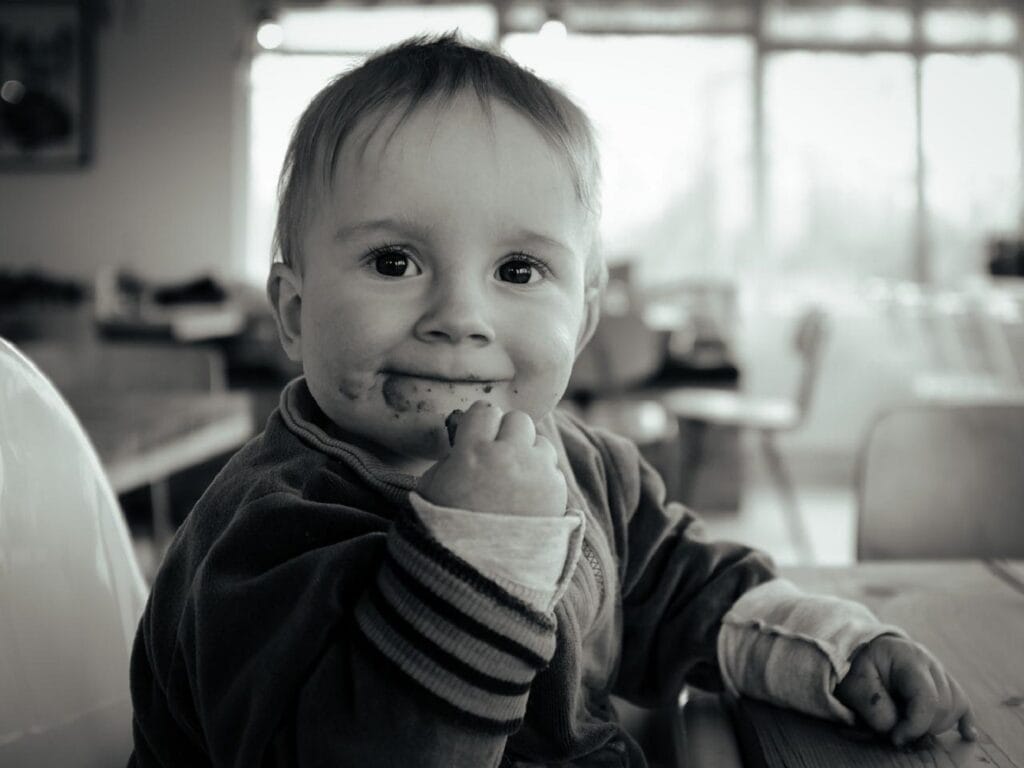
Ready to brave a meal out with your baby in tow? We say go for it!
If your baby is still young and sleeping a lot, be sure to pack a car seat cover so they won’t be startled awake in a new environment.

Most restaurants are very helpful with families who bring a baby along; they may offer you a sling for the car seat so you don’t have to disrupt your baby’s nap.
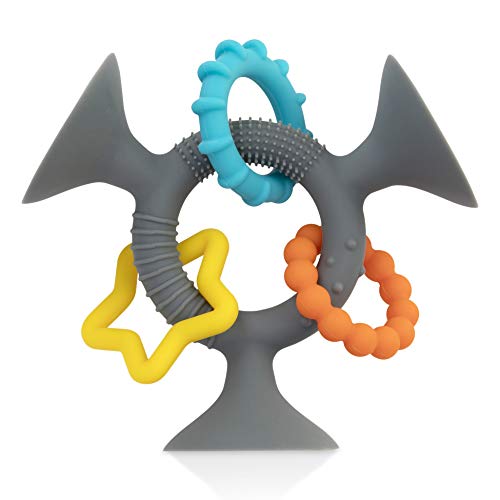
If your baby is awake, it’s a good idea to have a suction toy that attaches to the table so your baby can play while you hold them or they sit in the high chair.
For more flexibility, go out for coffee, hot chocolate, or even a fast food restaurant.
Go to the beach, the lake, or community pool
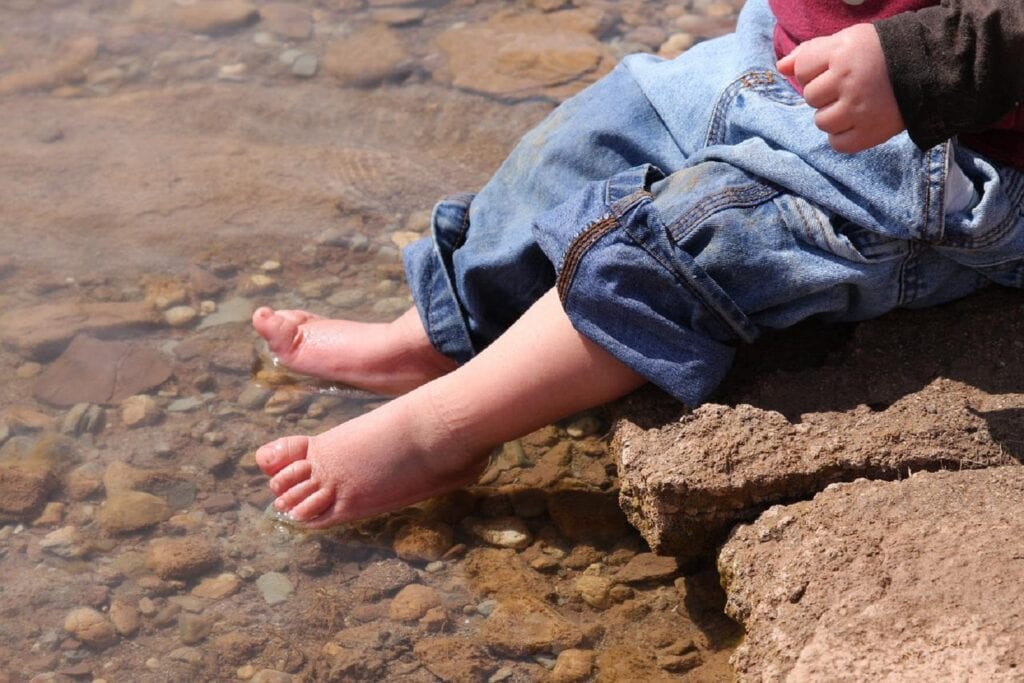
In the warmer months, getting outside means heading to the lake, pool, or beach if you’re in a coastal city.
If your baby is becoming more active, any type of water situation is a great activity for them to splash, play, and work out some energy. Water play develops sensory exploration and motor skills while building coordination and social skills for babies.
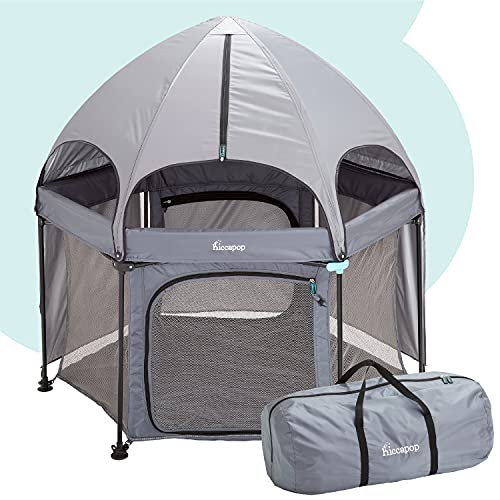
If you plan to spend the day at the pool or lake, products like this outdoor shaded playpen offer a safe space for your baby to play and nap all day long.
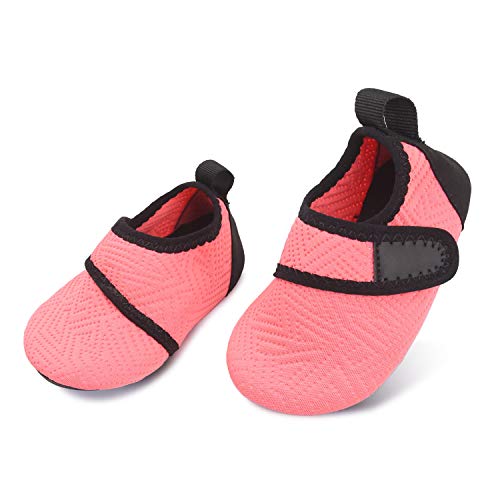
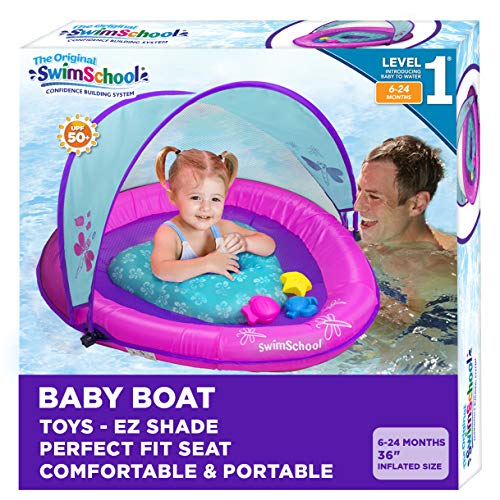
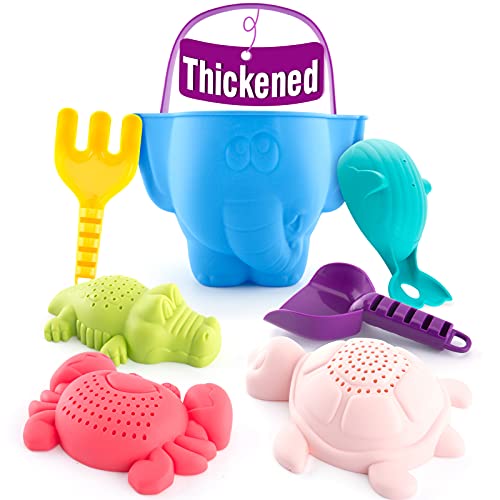
Don’t forget other important items like water shoes, a shaded float, and toys for the lake or beach!
Head to the zoo or aquarium
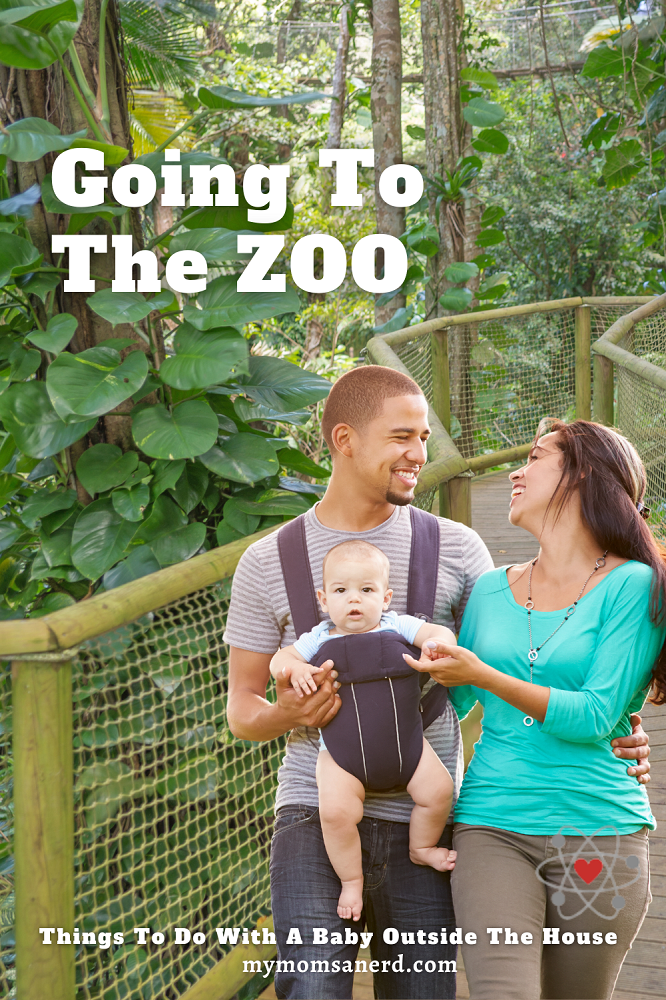
Plan a day at the zoo or aquarium with a friend or family member, or spend a few hours there just the two of you. Your baby will love all the animals, whether outdoors or underwater.
Depending on the weather and time of year, there may be a petting zoo open in the children’s area of your local zoo. Your baby can feed and pet animals including sheep, goats, ponies, alpacas, pigs, and more.
As your baby’s eyesight develops, you will notice them becoming much more observant and curious. An aquarium is a perfect place to take a baby around 3-4 months old, as they can follow fish and other marine life swimming around underwater.
Run errands
Got a mile-long To-Do list that needs to be taken care of? Pack up the diaper bag, grab the stroller, and head out into the world with your baby.
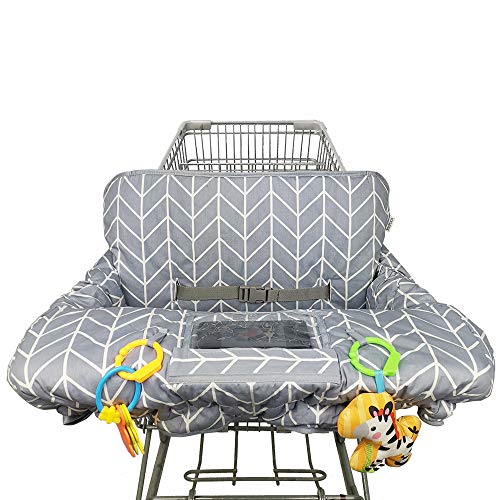
If your little one is sitting up on his own, grab a shopping cart and get him settled in the seat. Don’t forget a shopping cart cover so your baby is comfortable and protected from the metal sides of the cart. Your baby will love people watching and checking out all the colorful items on the shelves.
For babies who are too small to sit in the cart, you can bring the stroller to the store or simply set the car seat inside the shopping cart.
Parenting is all about being flexible — once you find your footing, errands with a baby in tow will be a breeze!
Go to a farmer’s market
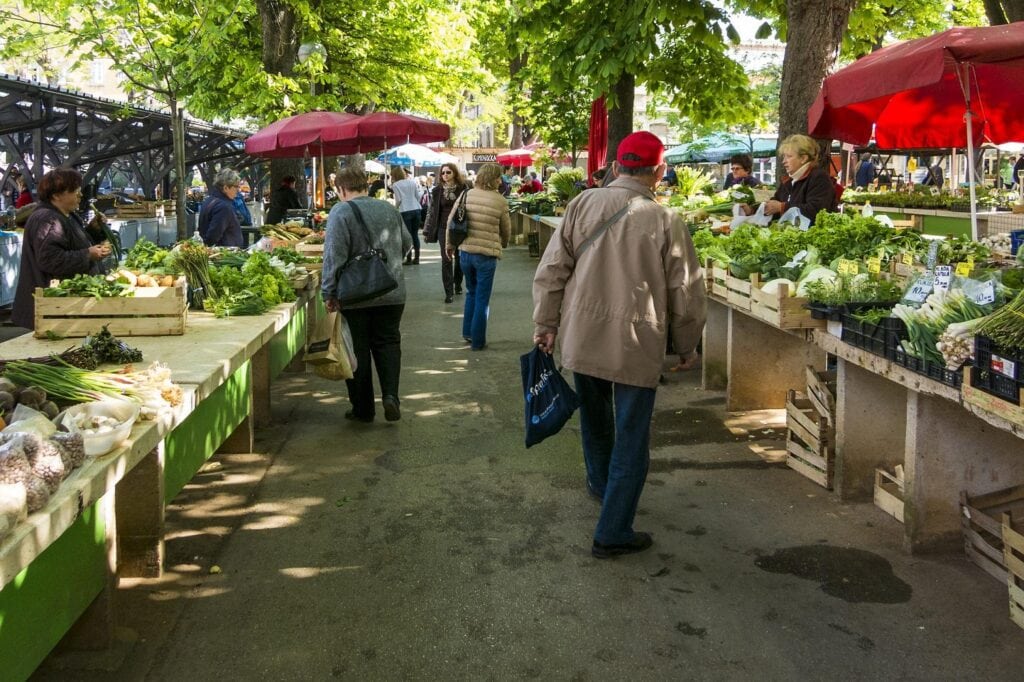
Head out the door for an early morning farmer’s market adventure in your area.
Farmer’s markets are a great place to grab fresh fruit, veggies, meat, and pastries while providing your baby with many new sounds, smells, and people to look at.
Grab a coffee and get some groceries while supporting local farmers and businesses. Sounds like a perfect start to the day!
Visit a pet store
Visiting a pet store can be a fun outing for a baby thanks to the small animals, reptiles, and other critters that are on display. Take your baby to the local pet shop and let them get nose to nose (with glass in between, of course!) with snakes, fish, lizards, hamsters, rabbits, and more!
Some pet stores also offer boarding for small dogs and cats, so you may find these animals in the enclosures as well. Wave hello, practice animal sounds, and talk to your baby about each animal they interact with.
Sign up for swimming lessons
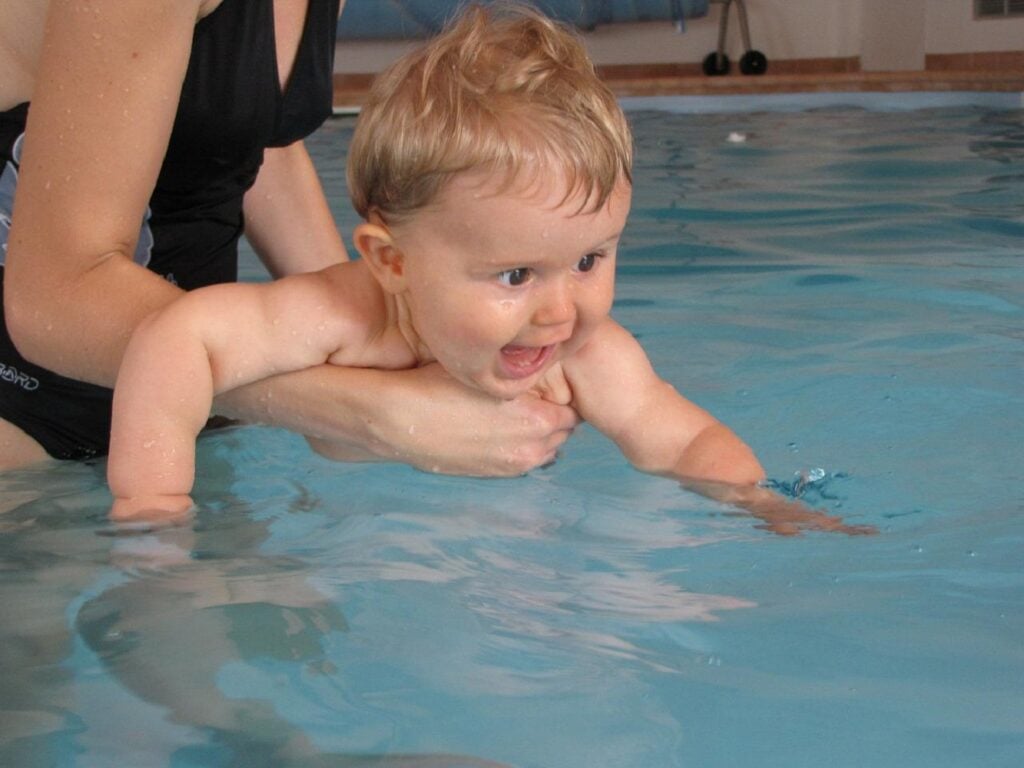
Many local pools offer Parent/Child swim classes for babies as young as four months old. You may wonder if it’s too early for swimming lessons, but your baby is learning and developing constantly. New experiences are great for a baby’s development!
Early exposure to water and swimming has many health benefits for babies; it builds muscle, improves sleep and appetite, and helps you bond with your baby through quality time.
Related: 26 activities to do with a newborn baby in the summer
Set up a play date
Make plans with a friend or family member, whether that be just going on a walk together, having lunch at a park, or going to their house to play.
Playdates are an integral piece of child development — they encourage sharing, interaction, and build social skills, even for young babies.
Socialization is just as important for adults; as a new parent, you may feel overwhelmed or alone at times. Having friends or family members who are in the same phase of life as you is a very helpful way to manage stress and expectations of life with a baby.
Related: 22 winter activities for newborns
Take a drive
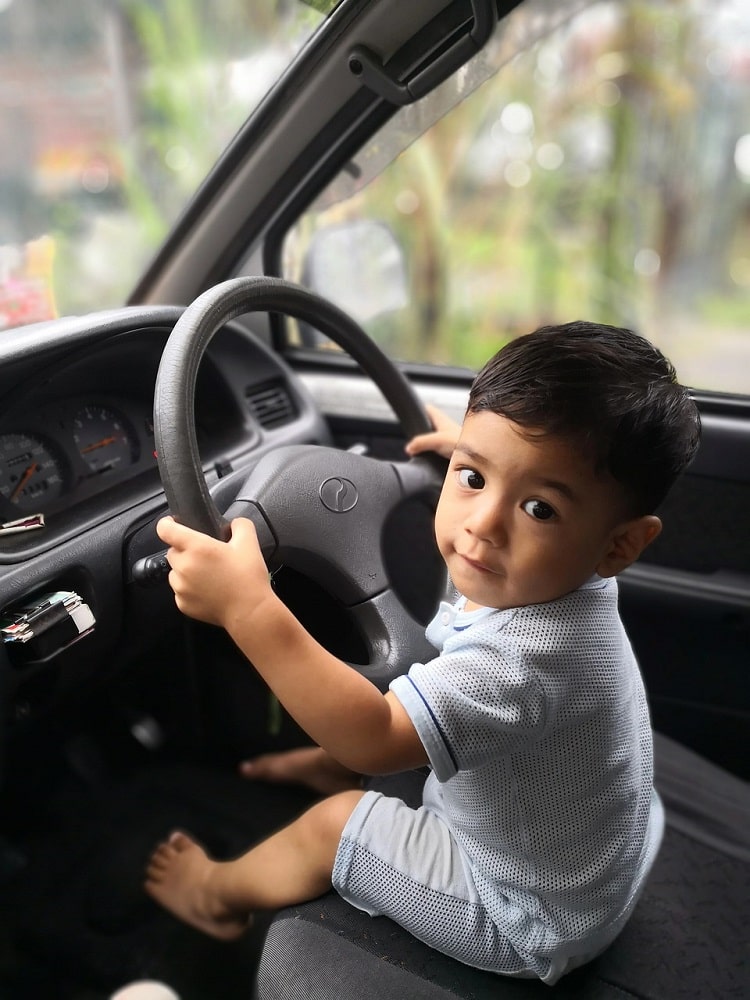
There will be days with your baby where you just need to get out of the house — we’ve all been there!
Simply getting in the car and going for a drive, playing music, and rolling the windows down can do wonders for the soul.
New parents are often advised to drive their babies around when they are fussy and won’t fall asleep, and we’ve found this tip to work wonders. The rhythm of the road and lulling sounds of a car will help your baby drift off to a peaceful sleep.
Check out other ideas for Family Activities with a Newborn!
Wrap up- Things to do with a baby outside the house
On days when you just need to get some fresh air and a change of scenery, this list is a great resource for things to do with a baby outside the house.
As a new parent, some days will feel like you’re just in survival mode. Even the smallest tasks can be daunting and seemingly impossible to complete. On other days, you’ll feel like a Super-Mom.
Parenting is a wild but beautiful ride, and you’re doing great!
Relating post: How To Childproof a Water Spigot
Discovering the World Around us with a Newborn-Daily Micro-nature
Outdoor Nature Experiences for Your nEW Baby
The other day Rubi was telling me about her daughter spending time outdoors exploring moss and then says, “I need outdoor activities.” What?! You’ve just been telling me about this fabulous sensorial, nature experience your daughter has been having and you need more ideas?
Daily walks
When A. was younger she went for walks in her bassinet style stroller so she could fully stretch out her body. A car seat places a child in a propped up position and straps the child in. In her bassinet stroller, she could stretch her arms above her head and kick her legs around. She could turn her head to look where she wanted, including looking at me as her point of reference, but mostly she slept. She also greatly loved being cuddled up close to our bodies, so for many months she went for a walk being carried in the Beco. Now that she is older she enjoys being awake for most walks and sits up in her stroller to take in all the sights. We mostly go for walks in our neighbourhood so she can enjoy many flowers but we also go to the woodland park near our house. I think this bit of daily fresh air is good for all of us as a family.

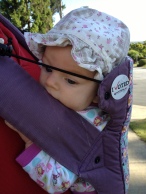
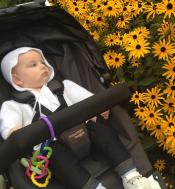
Laying outside
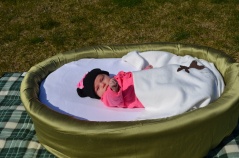
While we don’t always go outside everyday, we definitely do so multiple times a week. When A. was younger I would place her outdoors in the cestina or on her topponcino in the Moses basket. By the time she was two months, I mostly placed her on a blanket and she would listen to the birds or listen to me read her stories. She would also enjoy tummy time outside. We mostly did this in our backyard. Rubi did the same with F., often bringing a basket with a few toys outdoors. Rubi has also provided F. with a wind chime to listen to.
Rubi reminded me that blowing some bubbles for a baby to observe is also a lot of fun. Having a sprinkler for the baby to experience water would be fun too.
During the summer I would often go for picnics and I would try to place A. in the shade of a tree so that she could watch the movement of the branches and leaves in the wind. She was also able to observe the clouds, flowers, and whatever is around. I was thinking that going somewhere with a river or stream would be a lovely experience. Enjoying food outside (nursing or solid foods) is also a different experience for a baby.
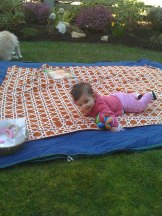
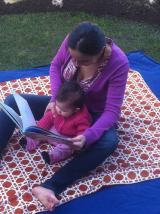

Exploring with items from Nature
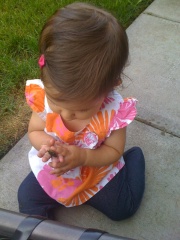
Rubi provides items from nature for her daughter to play with when outdoors. Her daughter explores with various items such as grass, sticks, and moss. F. is developing her pincer grip by picking up small pieces of moss. I am enthralled with the sensorial experiences F. is receiving as she touches the various textures and, of course as babies do, puts the items in her mouth. Rubi has also provided a bucket of rocks for F. to place rocks in and out of.
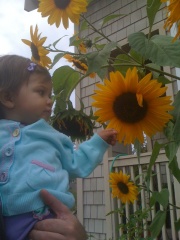
Many mornings A. and I will go for a quick “garden tour” before her morning nap to check out the plants that are growing. It has been great fun with a vegetable garden as I talk to her about the various plants we have growing and allow her to feel them. She has had the opportunity to feel smooth pea pods, prickly squash leaves, and bumpy broccoli.
Since my conversation with Rubi, I have been encouraged to let A. have time on the grass. Often this occurs prior to dinner. She has greatly been enjoying the opportunity to sit on the grass, pick grass, and experience it by eating it.
Outside of the daily experience in the backyard, I think it is great to expose your baby to sandy beaches, swimming in a warm lake, and whatever other natural places happen to be in the area that you live. As long as your baby is able to see, hear, smell, taste, and touch items of nature!
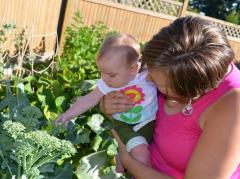
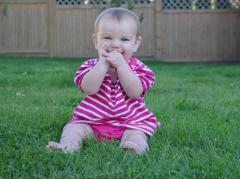
Playground
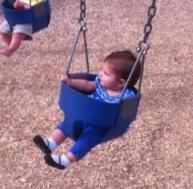
For an older baby, it is fun to go to the playground. If you can find a playground built for toddlers this is even better. Once your baby is able to sit independently, then he/she is ready to enjoy going on the swings. Carefully observe your baby for signs of enjoyment and distress as sometimes this experience is not enjoyed by babies, or the enjoyment can quickly change into distress.
F. has a lot of fun on the swings and at the playground. She crawls around on the equipment and on the wood chips, greatly enjoying exploring the wood chips. She is now pulling up, cruising along, and trying to climb up on much of the equipment. She also enjoys going down the slide. While it may seem obvious to go to the playground, often F. is the only baby at the playground! Rubi commented that it is because other parents don’t want to bring their child who is not yet walking because the child will get all dirty. Appropriate clothing meant for play is important for children of all ages, including babies.
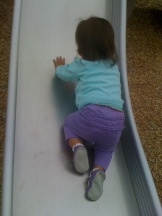
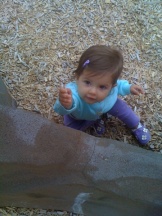
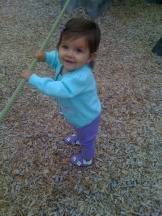
Experiencing Weather
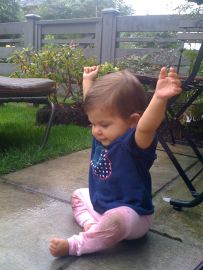
Most of us tend to be fair weather lovers. Instead, most of us live in places where it gets cold, hot, rainy, snowy, sunny, and windy. I believe that there is no bad weather, only bad clothing choices. Both A. and F. were born in the winter. We bundled up our babies and took them outside. During the summer A. was too young to wear sunscreen so we sought out shade and covered her up when spending extended periods of time in the sun. One particular rainy day, F. went outside and played in the rain and puddles.
What a delightful experience! We hope you have fun outdoors with your baby, cultivating a love of nature right from birth!
Exciting Things to Do with a Newborn

What can I do with my newborn in the summer?
You’ve spent all winter cooped up inside growing that bump, and now that your little one has arrived, you want out of the house.
I was right there with you. My maternity leave was smack in the middle of summer, and I wanted to get out with my little guy. Most days, that meant sitting on our front porch watching the world go by.
But you can’t just sit every day. So here’s the ultimate list of fun things to do with a newborn in summer that you’ll both enjoy.
Just remember to keep your little one safe while enjoying the outdoors in the summer heat. Check out the top tips for taking a newborn out in summer below all the fun summer activities.
What are fun things to do in summer with a newborn?
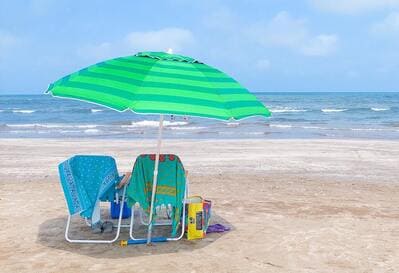
Things to Do with a Newborn in Summer:
Water Activities
1. Set up a mini water play area
Beat the heat by setting up a shallow water play area in your backyard. Then, grab some mold-free water toys for your baby to enjoy.
While a water table may be too big for your little one, something as simple as a shallow dish pan or a splash pad would be easy to set up and enjoy in the shade.
2. Find a baby-friendly splash pad
On days you want to spend some time away from home, head to a local splash pad or water park.
Splash pads are areas where water sprays out of the ground or from fountains, but the water does not collect in a pool. It’s a fun way to introduce your baby to water play while you cool off.
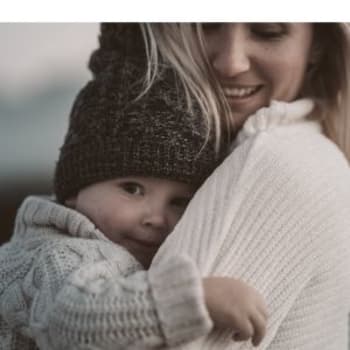
Just a precaution when visiting splash pads, older kids can be rambunctious. Some splash pads have special areas for small children, so take advantage of those spaces.
3. Take baby for a swim
Use a baby pool in your backyard or visit your local pool to cool off.
While a newborn is too little to hold up his own head, you can enjoy the water right along with him. The easiest way is to sit in the baby pool and let your little one rest his back against your chest while splashing about.
You could also head to the shallow end of your local pool if you’d rather have more space. Some pools even have a babies-only section, so you don’t have to worry about older children playing too rough.
Two things to consider when taking a newborn swimming:
Use swim diapers. A regular diaper will absorb too much water and become heavy and uncomfortable. Swim diapers also help delay the spread of bacteria, whereas a regular diaper will not.
Don’t go swimming if you are still experiencing postpartum bleeding. Rather than sit in the baby pool with your child, sit behind it and allow your baby to rest against you while he enjoys the water.
4. Visit the beach
Experience the soothing sound of waves crashing and show your little one all there is to enjoy at the beach. As a new mom with a young baby, you want to look for a beach with fewer people.
You also need to be aware that babies under 6 months of age should not wear sunscreen, so you’ll want to take extra precautions to avoid the sun’s harmful rays on your baby’s skin.
You’ll want to invest in a baby beach tent or hang out under an umbrella while relaxing in the sand.
5. Take your baby for a boat ride
Choose a calm lake or river for a relaxing experience with your newborn.
If you don’t know anyone with a boat, look for local river cruises or tours in your area that will allow you to enjoy some fresh air.
Make sure you have an infant life vest, a rash guard swimsuit, and a sun hat to keep your baby safe.

Things to Do with a Newborn in Summer:
Nature Activities
6. Take a stroll in the park or a garden
Explore the beauty of nature while enjoying some fresh air with a low-impact stroll through your favorite park or garden.
Going on a walk with baby through your favorite park can be a great pick-me-up for you and your newborn. You can choose to baby-wear or take a stroller if it’s an especially hot day.
7. Visit a local farmer’s market
Introduce your baby to a range of fruits and veggies, while supporting local farmers.
While your newborn is still too young to experience the flavors of anything but breast milk or formula, they can enjoy the colors and textures of different produce.
And all too soon, your little one will be starting to eat purees, and the farmer’s market is the best place to find fresh produce you can puree yourself.
8. Visit a local community garden
If you have a local garden, it is a great place to sit and enjoy nature without the noise of a playground. You can teach your baby about plants and enjoy the serenity of a green oasis.
Pack a lunch for you and baby. Take a book to read. Even let your newborn enjoy a nap outdoors while you get some fresh air and vitamin D.
9. Visit a local fruit orchard and pick your own fruits
Engage your baby’s senses by picking fresh fruits and enjoying the flavors of the season.
Visiting a fruit orchard is not only a fun experience for your newborn, but you can also pick up some fruits and make fresh purees for older babies.
10. Explore local botanical gardens
Immerse yourselves in vibrant colors and intriguing scents while surrounding yourself in nature.
Your newborn will enjoy the atmosphere and bright colors while you enjoy your time strolling through the gardens. Whether indoors or outside, you’re sure to find many beautiful displays and some great newborn photo opportunities.

Things to Do with a Newborn in Summer:
Playtime
11. Set up a baby sensory play area outdoors
Stimulate your baby’s senses with soft toys, textures, and nature-inspired materials.
One of my favorite things to do in the fall with my newborn was to place a blanket on the ground with the fallen leaves underneath, so he could crunch them and practice tummy time.
It also works great as a summertime activity. Grab a blanket and your kiddo’s favorite lovey, some textured blocks, and even some beach toys and work on tummy time, colors, shapes, and textures.
12. Set up a shaded outdoor play area with a baby swing and toys
Create a safe and enjoyable space for your newborn to explore and play.
Whether it’s on a covered porch or a tent in the yard, having an area outside where your baby can spend some time out of your arms is a good idea on hot summer days.
Use a swing, bouncer, or even their highchair so your little one has the support he needs.
13. Set up an outdoor painting session
Let your baby explore their creativity in an outdoor setting.
Newborns don’t do much, so you’ll be the one leading the charge on this summer activity. Start by using non-toxic paints (preferably ones that are easy to wash). And dress your baby in something you don’t mind getting a little messy or even just a diaper.
Let them explore the paints, by putting their fingers and toes in the paints. Use outdoor objects such as leaves and sticks to create your artwork.
You could also try making handprint or footprint crafts for summer while you’re enjoying the outdoors.

Things to Do with a Newborn in Summer: Learning Opportunities
14. Visit your local library for storytime sessions
Enjoy interactive storytelling activities with your newborn and meet other families.
Storytime sessions at our local library only run during the school year, but they do have outdoor activities in the summer for kids of all ages.
Connect with your local library and see what all they have to offer. (You may even find a great place for your baby’s birthday party.)
15. Attend baby-friendly outdoor music concerts or festivals
No, I’m not talking about taking your baby to a rock concert. But there are a lot of festivals going on in the summer months that usually have local musicians that would be suitable for little ears.
Our area has an outdoor stage that hosts local artists in the summer and nearby restaurants provide food. Find something fun in your area to give your little one his first introduction to different sounds and rhythms.
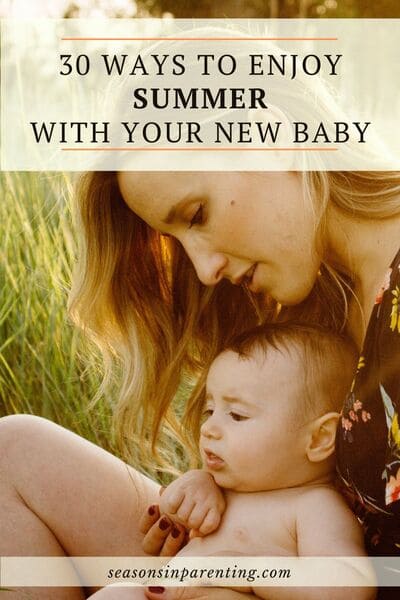
16. Attend mommy and me music classes
An outdoor music or movement class is another great way to introduce your baby to music, which is truly beneficial for their developing brains. Music helps children regulate emotions, build relationships, and strengthen language skills (source).
Singing the ABC song is what helped my son start talking.
17. Visit a petting zoo or farm
Allow your baby to learn about gentle animals and different species by visiting a petting zoo or farm.
This is the best way to see animals close up and get young babies interested in the outside world. After visiting the farm, you can teach your little one more about animals by reading books.
18. Take a trip to the zoo or wildlife sanctuary
Explore fascinating animals and teach your baby about the wonders of nature. Some zoos even offer special up-close encounters with the animals.
Use a stroller with a shade to keep baby out of direct sunlight and allow for naps on your trip through the zoo.
19. Visit a baby-friendly museum
Introduce your baby to art and culture in a child-friendly environment.
Children’s museums are great places for young children and older kids alike. Everything in a children’s museum is hands-on, so no need to worry about knocking over an expensive dinosaur skeleton.
They offer a lot of sensory experiences with indoor and even outdoor activities. It’s a great place to offer your baby a new experience with the exhibits while also watching other children play.
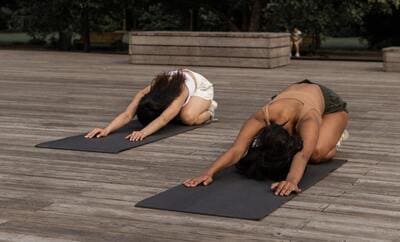
Things to Do with a Newborn in Summer:
Get Moving
20. Go on short hikes or nature walks with baby Use a carrier or stroller to explore nearby trails and connect with nature.
Walk with other moms with newborns to get some socialization. Pick rocks or leaves from your walks to create an outdoor sensory bin at home or for fun outdoor activities.
Be sure to carry plenty of water with you, so you don’t become dehydrated.
21. Attend mommy and me exercise classes held outdoors
Stay active and bond with your baby through outdoor exercise classes with other new parents and newborns.
Try using a baby carrier if the classes are not too intense. This way you can be close to your little one. Just remember to use breathable fabrics for yourself and your baby.
If the classes are more intense and your newborn baby will be jostled too much, lay out a blanket so they can practice tummy time while you exercise.
Don’t forget to mingle with other new moms while you’re there. It’s a good time to make some new mom friends and set up some future playdates.
22. Organize baby-friendly outdoor yoga classes
If you can’t find any local exercise classes, why not start your own? Focus on relaxation and connect with your baby through gentle yoga movements.
You could always practice yoga with your baby right in your own backyard. But if you’re looking to get others involved, put out flyers around your town that you will be meeting in the park once a week for mom and baby yoga classes. Of course, double-check with your local community if you need any special permits.
23. Go on a gentle bicycle ride with your newborn
Let me start this by saying that the American Academy of Pediatrics (AAP) recommends that children should not ride a bike until 12 months of age.
However, if you are an avid bicyclist and can’t wait to get back out there, or biking is your main mode of transportation, you do have some options.
I personally have problems keeping myself balanced on a bike, so I am not the expert here. But you can learn how to bike safely with baby if this is one of your favorite things to do in summer. Please remember to check any bike laws in your state before heading out.
If you want to wait until after your little one turns one, check out these bike trailers for added protection for your little cyclist. Or you can choose to push a stroller alongside the bikers in your family.
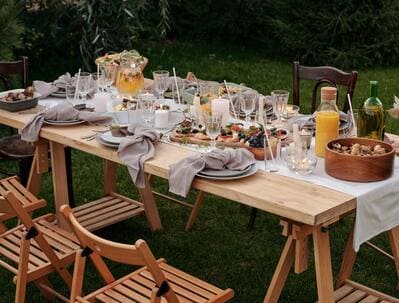
Things to Do with a Newborn in Summer:
Socialize
24. Have a picnic in the backyard or nearby park
Pack a blanket, some snacks, and a few toys, and spend some quality time together in nature.
What’s so great about a picnic is that it can be just you and your new baby in your backyard, so you don’t have to do much planning and can run in your house if you need anything. You could also make it a backyard playdate and include dad or other family members.
For a change of scenery, grab that picnic basket and head to your local park. You can enjoy your time together while meeting other families (and set up some playdates).
25. Have a family barbeque
Enjoy a delicious meal outdoors while bonding with your baby.
Whether you choose to have the barbecue at your home or just attend one, it’s a great way to introduce your newborn to family and friends.
And if you don’t want your new baby passed around, you can simply tell people you don’t want your baby to get overheated and head inside to enjoy some air conditioning.
26. Arrange playdates with other parents and newborns at the park
Socialize with other families while your little ones interact with each other. Although it may be time spent on mom’s lap, this is the easiest way to get your little one to engage with others.
Don’t know any new parents to ask to the park? Don’t worry, just start spending time at the park. You’ll start seeing familiar faces each time and can strike up a conversation.
27. Have a family photo session
Find a scenic outdoor location and create lasting family memories with a professional photographer.
The newborn phase goes by so quickly, and you really should get those newborn photos done within the first two weeks while your little one still easily folds into the fetal position.
But if you weren’t feeling up to being in photos after just having a baby, now is the time to take advantage of some precious family moments. And if you can’t book a professional photographer, you could always have a friend take a few snapshots for you in your favorite outdoor location.
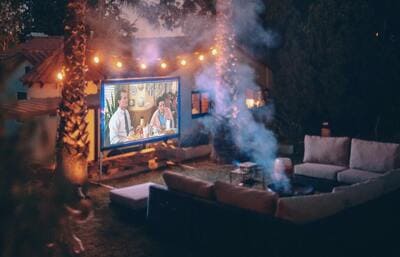
Things to Do with a Newborn in Summer:
Relax
28. Read under a shade tree
Engage your newborn with captivating stories in a tranquil outdoor setting.
You could read to your baby anywhere you like, but why not head outside for some fresh air in the hot summer months?
A personal favorite of mine when my son was a newborn was to sit on our covered porch at different times during the day watching the neighbors. I talked about the trees, the animals we heard, the cars on the street, and all our neighbors’ names and where they lived.
It was the easiest way to spend time outside without worrying about sun exposure or if my little guy was overheating.
29. Go for a scenic drive
Take a leisurely drive to enjoy the beauty of nature and explore new places.
When you can’t do anything else, but you NEED to get out of the house, pack up your baby and take a drive. I always find that going someplace green or near water helps me relax.
30. Go to a drive-in movie or outdoor movie screening
Watch family-friendly movies under the stars with your little one.
Although your newborn is too little to enjoy a movie, this is a great summer date night idea for new parents, who aren’t ready to leave their little one with a babysitter.
Pack your baby in his car seat and enjoy the movie together. And if your little one gets fussy, go for a quick walk in the night air and show him the night sky.
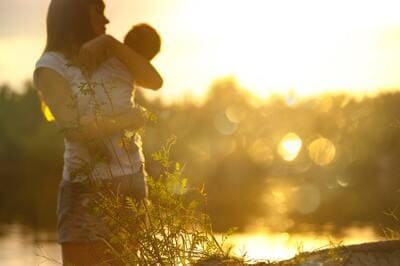
How do you take a newborn out in the summer?
Now that you have a list of all the best things to do with your newborn in summer, let’s talk about how to keep baby safe in the warmer months.
Sun Safety Tips for Newborns
Keep your baby out of direct sunlight. Stay in the shade as much as possible. Use an umbrella or baby tent at the beach. Use a stroller canopy to create shade and keep baby cool when out for walks.
Dress your baby appropriately. Opt for a light layer of clothing that covers as much of their arms and legs as possible. Wear colors that reflect the sun and watch out for signs of overheating.
Use a wide-brimmed hat. Keep the sun off your newborn’s head, back of their neck, and ears with a hat.
Use baby sunglasses. Keep the sun’s harmful rays out of baby’s eyes with a pair of newborn sunglasses.
Limit sun exposure during the day. Take your baby out in the early morning before it starts to get hot. The best times to be outside with your newborn are before 10 a.m. and after 4 p.m.
Keep your baby well hydrated. Stick to your usual milk feeds while you are out and watch for signs of dehydration, knowing you may need to offer milk or formula more often.
Keep an eye out for reflected sunlight. Surfaces such as water and sand reflect the sunlight and can unknowingly cause a sunburn.
Apply sunscreen on exposed skin for babies older than 6 months of age. The best way to keep the sun off baby’s skin is to avoid direct sunlight and keep baby covered in breathable fabrics.
As always, speak with your pediatrician if you have any questions about how to safely enjoy those hot summer months.
Conclusion
There you have it: all the fun things to do with a newborn in summer. With fun ideas for water and nature activities, playtime and learning opportunities, and ways to get moving, be sociable, and even relax, this summer with your new baby is sure to be one you won’t forget. Please just be cautious in very hot weather and keep your little one safe.
Have you tried any of these things to do with a newborn in summer? Let us know which was your favorite in the comments.
Related Articles for Things to Do with a Newborn in Summer:
Superscript
The Realities of Adventuring with a Toddler:
A Mom’s How-To Guide
Remember me? I’m the mom who packed up her 5 month old and headed out on a backcountry fishing trip in northern Colorado. I also said something to the effect of we wanted to take the attitude that ‘this baby was joining our lives and not the other way around’.
Well, it’s a year later and to be honest I am doing a slow head shake to “year-ago” Laura. Was I right? Somewhat. Hear me out.
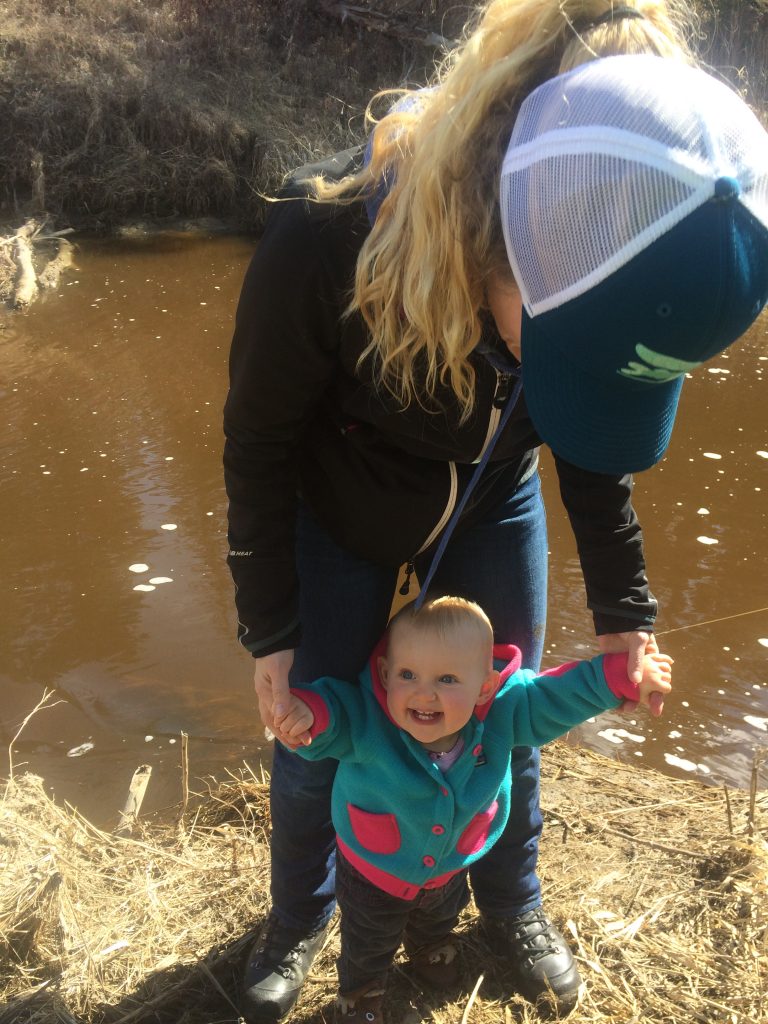
The Realities of Adventuring with a Toddler: A Mom’s How-To Guide
In 1999 I had an active, strong-willed and inquisitive 1.5 year old daughter that wanted no part in sitting still, requires one nap during the day (or hell hath no fury) and bedtime is 7 pm or you best be prepared for a cranky toddler the next day...Here is a journal entry...
Took our toddler on a boat today and she spends a good portion of her time trying to pry the life jacket off and if you turn your back she would run off the boat or end up with a treble hook in her hand in 2.5 milliseconds.
I expect this sounds familiar to most parents of toddlers, and it can make taking family adventures tedious, unpredictable and sometimes unpleasant. So you ask, what’s changed in a year? In a nutshell, sleep, baby mobility and food now dictate how we approach any trips.
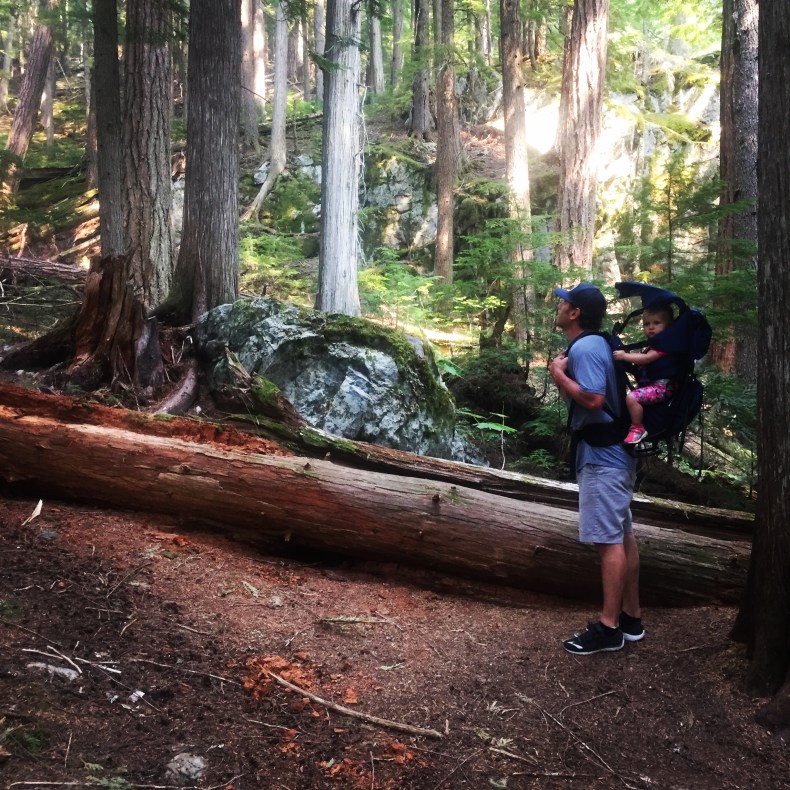
Sleep Challenges
Nowadays, our biggest hurdle to accomplishing family adventures are deviations from her normal schedules and sleeping arrangements. Honestly, sleep has always been a struggle for us since day one. Despite our best efforts, she didn’t sleep through the night until she was 13 months old. Not even once. Add alterations to our normal daily routine and it becomes a struggle.
For instance, this spring a pleasant stay at the family cabin on the lake turned ugly when she outright refused to sleep in a playpen in the corner of a room. No amount of rocking or back rubs would help and it ended in a 2 am screamfest that resulted with me finally pulling the pin and driving home while muttering expletives. Although we’ve always tented, from that night on we decided we would need to adapt future outdoor sleeping arrangements for everyone’s sanity.
We purchased a 1981 camper that required some TLC, but that kid sleeps like a rock. Worth every penny. For now, we’ve become the ‘glamping’ family I used to mock. I’m not saying we’re not willing to sacrifice naps or strict bedtimes on occasion, but if it happens too frequently our daughter’s evil, much crankier, alter ego rears its ugly head and it’s just not worth it.

Mobility Challenges
Another major shift has been getting our toddler from point A to B. These days, our active toddler wants no part in sitting in the awesome off-road worthy stroller we purchased, or being in the comfy soft structured carriers. However, she’ll happily be carried in the backpack carrier from MEC. Go figure.
When she insists on walking (more often than not), it takes about 45 minutes to get a few blocks because of all the puddles that need to be splashed in, rocks and twigs that need to be collected and raspberries that need eating. We’re more than happy to let her take her time exploring and getting dirty, but this means we’ve significantly altered our expectations on hike length or difficulty.
Food Challenges
Lastly, when we had an infant, a meal was a boob away. Now, we’re our daughter’s mobile snack pack mules. Any sort of outing, walk, or hike requires copious amount of snacks to ensure she remains happy. L’arabars, Cheerios, goldfish crackers, and cut up fruit are in our bags at all times. Snacks can usually right an adventure that looks like it’s beginning to go sideways.
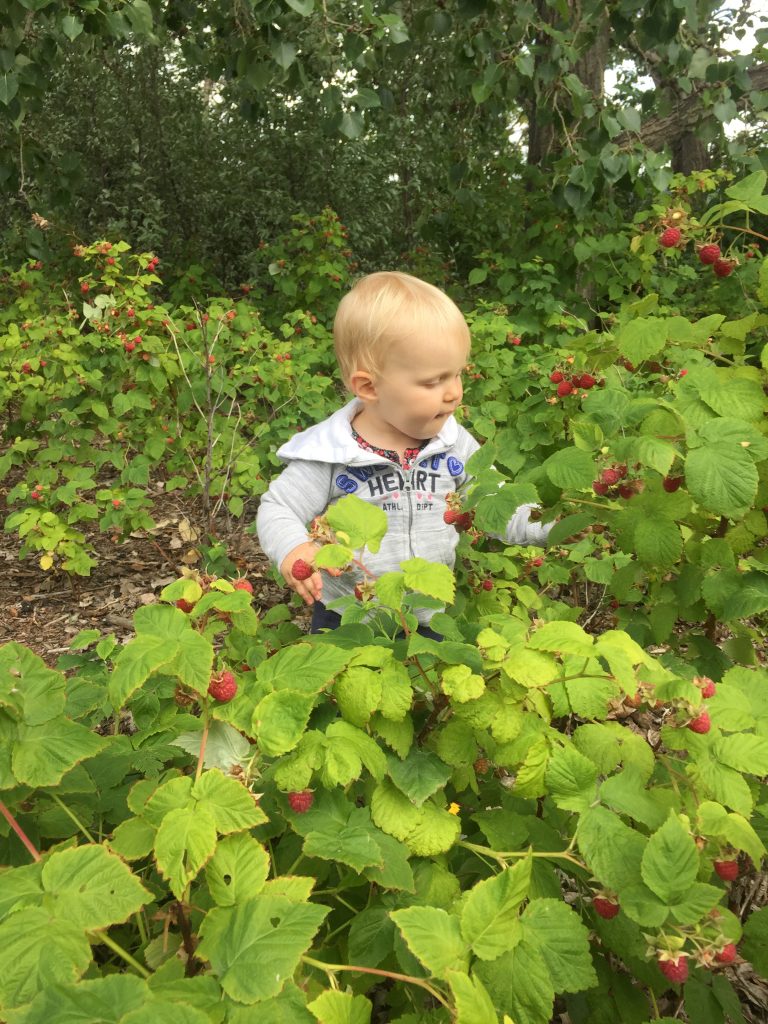
How do you deal with all these changes? To help new parents out, I’ve broken down your baby’s development into different stages and created a handy diagram.
Newborn Stage – Give or take 0-5 months. This is your window! Your baby naps on the go, doesn’t require solid food yet, and likely doesn’t crawl either. It’s essentially a cute eating, pooping and crying meat sack. Adventure away!
Semi-Mobile Stage – 6-9 months. Your baby can likely turn over and roll (and might be starting to crawl) but usually doesn’t go anywhere quick. Adventures are totally still doable but you might have to work more around naps and need to bring solid food.
The ‘Uh Oh’ They’re Mobile Stage – 9 months on- This is a fun time! BUT life as you knew it is over. Kidding! Your main job moving forward is to make sure your child stays alive by not tumbling down the stairs. Adventures will likely have to fit more around schedules and may get cut short. Still lots of fun, but keep your expectations in check.
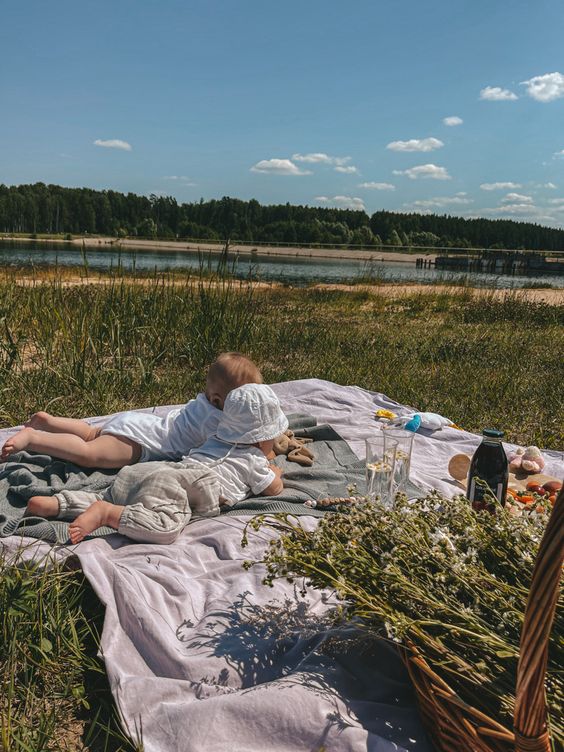
Do we still go fishing, camping and hiking? You bet! Is it an endeavor to plan and execute these trips? Yup. Are they as hardcore or as adventurous as we were envisioning? Not really, but that’s OK.
The level of our family adventures will grow with our daughter. With some adjustments and LOTS of patience we are working at nurturing her long-term love of the outdoors. That is what we believe matters the most.
Exploring a variety of greenspaces to observe nature and find recreational
Babies and toddlers outdoors
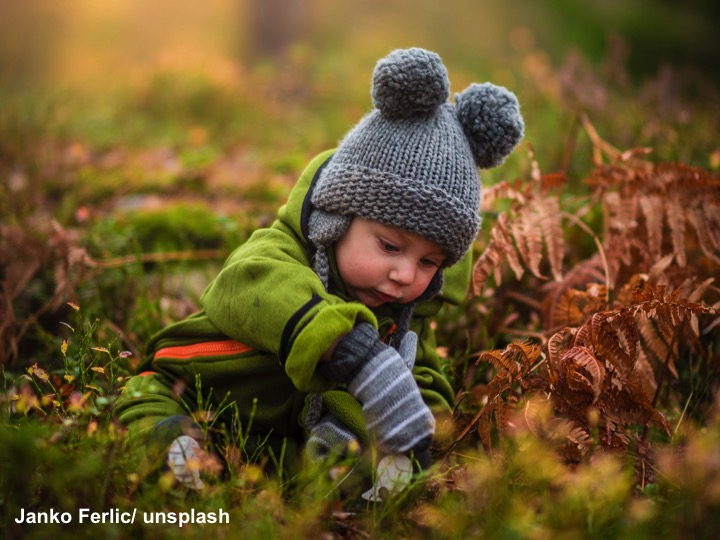
Nature Play for Babies and Toddlers
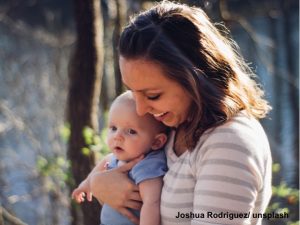
Nature Play for Babies and Toddlers by Kimberly Smith
“How about if they have to sit on the ground and get dirty?”
“What if my child falls?”
“What if they try to put sand in their mouth?”
“But my baby will get sick being outside?”
“I’m too busy in my day to get outside with my baby”
Taking babies outside offers many benefits on all areas of their development and the earlier they get used to being outside, the sooner their love for nature will develop. It is though their first hand sensory and movement experiences that they learn to make sense of the world and develop key connections in their brain. In order for us to place a greater emphasis on the outdoors in our practice with babies and toddlers, we must understand that the outdoors offers a richness that isn’t available inside. We don’t want to just take out indoor resources and put them outside – we must use the nature around us!
Yet many parents and early educators lack the confidence to make nature based play with babies work, with worries around risk, dirt and over-scheduled days being some of the key barriers.
Children experience the world with their whole being – body, spirit, energy, minds, hearts, compassion, tears, laughter, anger, pride, learning, understanding, love, and soul. Children play, grow, and feel the world around them intensely. (Rusty Keeler, 2008)
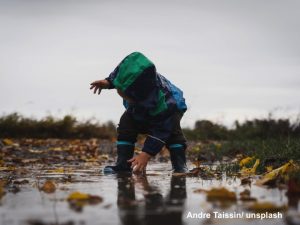
Less opportunities for movement
Many young infants are experiencing delays in key movement skills that can be caused by a number of reasons, such as global development delay, genetic disorders, autism, cerebral palsy, born pre-term, joint hypermobility, low muscle tone and Down syndrome. However, they can also be delayed by having a lack of opportunity to freely move, crawl and explore their environment and being part of what can be referred to as the ‘indoor generation’. Many babies find themselves moving from cot to highchair, to pram or car seat with few opportunities to practice and refine their early movement skills. With many adults living such fast paced lives and finding themselves rushing from one activity to the next, it can often be easier to pick the baby up and transport them to the next thing rather than encouraging them to move themselves. Even taking a toddler on a regular walk to the shops can provide so many valuable learning opportunities as well as developing muscle strength in their legs; learning about the regular places that are walked passed, the seasonal changes that happen and taking the time to stop and dawdle while noticing a natural curiosity. On a busy day when a toddler may be in a pram they are speedily moving passed all these moments to notice and learn.
Think of some ordinary, boring, everyday walk, the couple of blocks to the local 7-eleven store. Taking that same walk with a two year-old is like going to get a quart of milk with William Blake… The trip becomes a hundred times more interesting, even though, of course, it does take ten times as long. (Gopnik, Meltzoff & Kuhl, 1999: 211)
Occupational therapist Angela Hanscom writes ‘kids of all ages should get at least three hours of free play outdoors a day’ but on average most children spend 4-7 minutes a day outdoors. Lack of movement opportunities in babies can lead to low muscle tone and it can impede on the development of a strong vestibular system (balance). When babies are learning how to crawl they not only develop healthy two-sided brain development, but have a strong shoulder complex and build the foundations of basic co-ordination patterns. The impact of missing these opportunities can be seen in Primary-aged children as they move through school. Hanscom describes that, ‘children are frequently falling out of their seats in school, running into walls, tripping over their own feet, and unable to pay attention’.
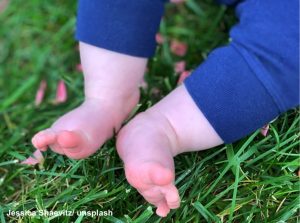
Getting into nature with babies
The child is wonderfully prepared for active learning from birth. Children approach the world with all senses open, all motors running – the world is an invitation to experience. Their job is to develop and test all their equipment, make sense of the confusing world of people and things and unseen mysterious forces and relationships, like gravity, number and love. Toddlers are furiously becoming … these restless, mobile characters have a drive to take apart the existing order and rearrange it, by force if necessary, to suit their own whimsically logical view of the universe.” (Jim Greenman, 2007)
With new babies comes the excitement from many parents to join many different types of indoor sensory classes. Many of these can be highly engaging and provide wonderful sensory opportunities to learn. However, we must not forget the richness of ‘just being outside’ and the free sensory benefits this has on a baby’s early development. Every season brings a unique opportunity for babies and infants to get outside and experience the natural elements first hand. From learning to crawl outside they have the opportunity of feeling the change of temperature on their skin, the breeze on their face, the sounds of the birds in the trees to the fluttering of the butterflies. When learning to crawl there is the naturally curiosity that spotting something in nature has to get them moving and wanting to discover more. Then there are the sensory opportunities that come with the different colours of the season; the vibrant reds and oranges of Autumn to the sea of blues and greens in the summer. As adults we can use this time to talk about what we can hear, see and feel with babies and toddlers, which is a key way of supporting language development.
Consider the weather
From a very early age in Scandinavia young children are taken outside to sleep, play and explore, learning how to live and experience the extreme climate here. If they always waited to go outside until the sun was shining then there would be very little opportunity to learn outdoors. Making sure we have the correct clothing and equipment for babies and toddlers is important. That way we don’t spoil the child’s natural curiosity to explore the outdoors.
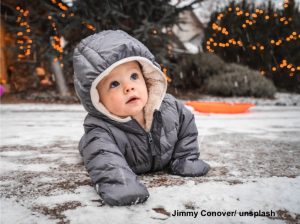
Simple activities for babies and toddlers
We don’t need to spend hundreds of pounds on fixed climbing equipment for babies and infants. Having balance beams and uneven ground (grass) creates enough challenge for them. The most importance resource when it comes to taking a baby or toddler outside is your quality interactions with them through tuning into what fascinates them, their facial expressions and babbling and offering a commentary about what’s happening when appropriate. Author Ainsley Arment reminds us that, ‘extraordinary lives are formed in the ordinary moments of a relationship-rich childhood.’
Set up a blanket for young babies to lay on outside and look up at the sky. Talk about what they can see, hear and see and the contrast of the colours.
On a walk with a baby, hold them in your arms and give them the opportunity to feel and smell the lavender you walk passed or the crunch of the Autumn leaves in the tree.
Attach mirrors to your fence at baby and toddler height to encourage them to stand up and look at themselves.
For the crawlers, set up a sensory pathway of grass and carpet tiles and a tunnel to crawl through.
Invite babies and toddlers to work with balls of different sizes.
Set up an obstacle course for toddlers to move along with balance beams, hoops to jump into, tunnels to crawl through and something to climb over.
Have a collection of ride on toys and doll’s pushchairs to practice pushing, pulling and filling up.
Set up a stage and bring the musical instruments outside, allowing children the opportunity to dance, jump and twirl to the music.
Set up a tuff tray with water, pots, pans, spoons and sponges and watch how they interact with the natural medium.
Visit a stream with a baby and listen to the sound of the water flowing over the rocks. Throw a pebble in and watch what happens to it.
Very young children have a very special way of relating to the outdoor world. It is of enormous interest to them… They have an inborn affinity, curiosity and fascination with the natural world: sky, wind, rain and shadows; plants, trees and leaves; sticks, pebbles and rocks; water, puddles and mud; dogs, birds and beetles and people. Children use their whole body and whole self to engage with, explore, dismantle and think about the world – and this is very apparent when young children are in the real, outdoor world. (Jan White, 2009)
Things to consider
How much time are the babies and infants spending outdoors each day?
Are there ways you can reduce the amount of time indoors? For example, taking baby sensory outside into nature instead of always attending a class inside?
Are any routines stopping you from getting outdoors?
Can you get out and about into nature (or even your local town) and talk to the baby about what they can see, hear and feel?
Is there a wild nature space that can be created or accessed outdoors where babies can crawl and walk barefoot on the grass?
References
Nature Play for Babies and ToddlersRead More »
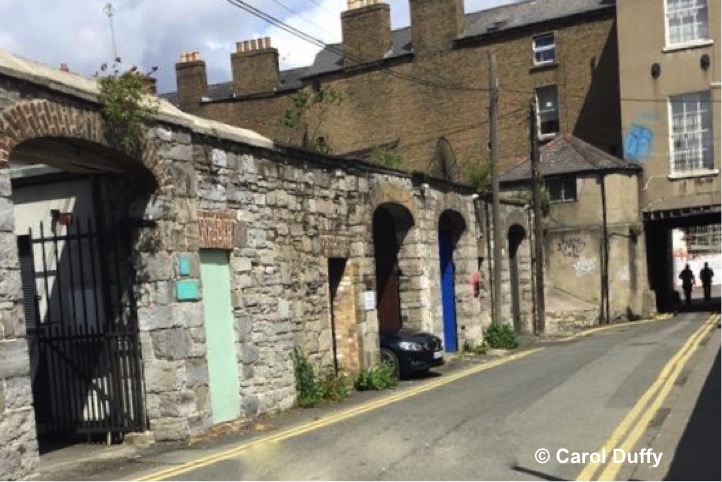
The Wondrous Walk
Our wonderfully successful collaborative research webinar Where Are the Babies, hosted by the Froebel Trust, created lots of conversation in the very active chat running alongside the presentations and panel discussions (scroll down in this link to find these recordings). Lots of people also gave their thoughts in the survey monkey sent out afterwards, in response …

Noticing Infants intra-action with the more-than-human world
Our long-postponed research seminar, hosted as an online webinar in collaboration with the Froebel Trust last Saturday, was a great success and a marvellous way to initiate a range of actions that we might take over the coming year or so. Thanks so much to Carol Duffy, Dawn Jones, Dr Nicola Kemp and Dr Jo …
Noticing Infants intra-action with the more-than-human worldRead More »
Authentic Outdoor Play and Learn
Outdoor Play
& Learn
Take Me Outside Day Ideas
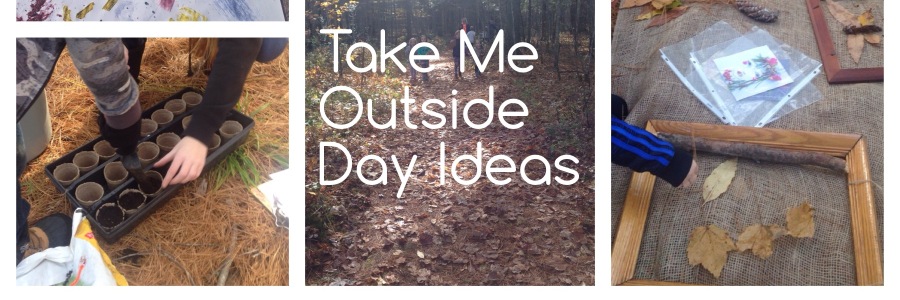
Is your school planning a Take Me Outside Day? Are you interested in providing more outdoor learning opportunities for your learners? Maybe you’re like us and constantly searching for new ideas to get your learners active and connecting with nature. Outdoor learning has become an integral component in our day. Not only do we use these provocations and activities… Read MoreTake Me Outside Day Ideas
Bring the
Indoors Out

‘Bring the outdoors in’ is a common home decorating approach, but why not ‘bring the indoors out’? There is much to gain from children have large periods of time outdoors and learning. The health benefits of outdoor play is well-researched and documented, but connecting children with nature is also of great importance. A well-known quote… Read More
Bring all the Indoor play that they love outside with you
Outdoor Stage at School
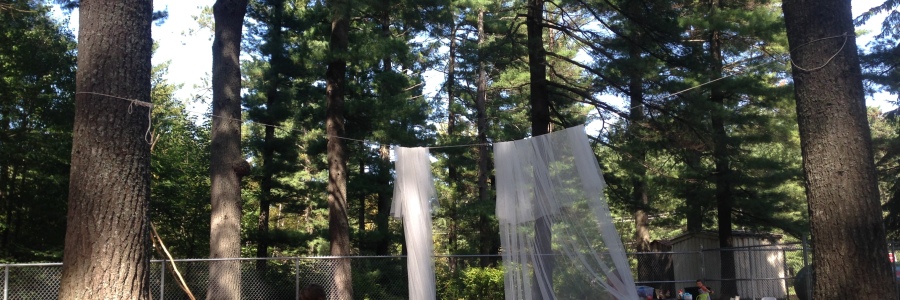
We are pleased to present Kinderland’s outdoor stage open for outdoor productions and open-ended play. It provides rich opportunities to develop oral language, imagination, resourcefulness, creativity, innovation, and expression in movement. In just a short while since we’ve had our outdoor stage we have been able to use it in all sorts of play. The list… Read MoreOutdoor Stage at School
Mud Kitchens
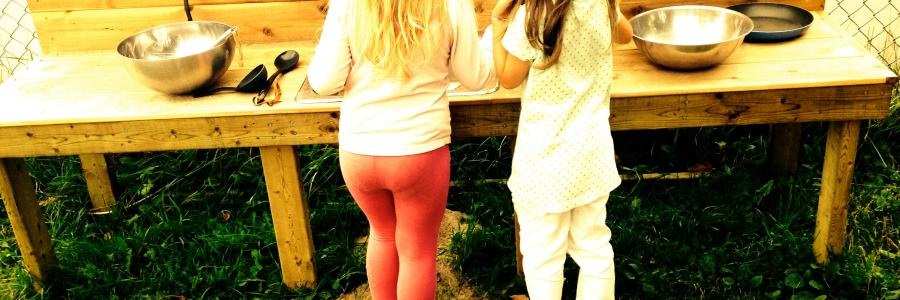
In public schools and early years programs across Ontario we, the educators, are striving more and more to provide children with learning opportunities outdoors through play. We recognize the benefits that reach the whole child through outdoor play, like the Mud Kitchen. Through providing our early learners with open-ended kitchen materials they are able to… Read MoreMud Kitchens
Tree Blocks and Shadows
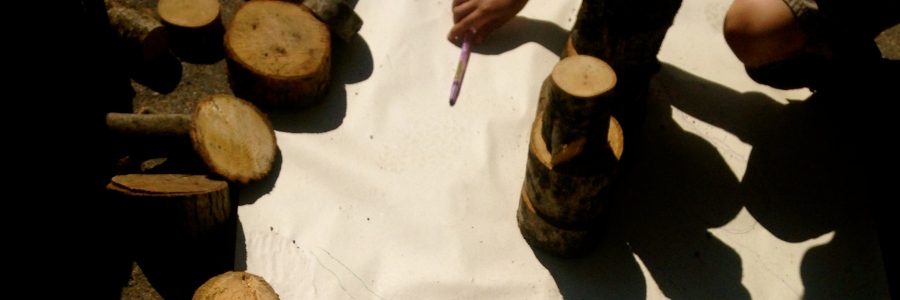
Tree blocks are all the rage right now in reggio-inspired classrooms and outdoor learning environments. Some children in our class had chosen to explore a provocation, “Can you build a structure and trace it’s shadow?”. One child sat up straight and ran to get paper to try it outside. Our early years team celebrated their thinking… Read MoreTree Blocks and Shadows
Painting with Dandelions
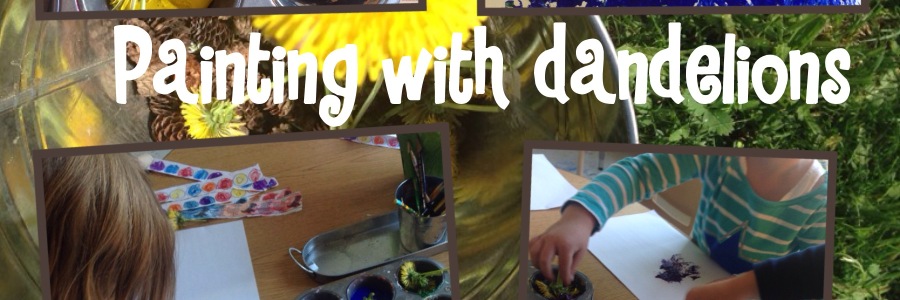
“Look, I found a flower!” It’s common place for children to pick dandelions in play, make bouquets, decorate their hair and share them to a loved-one. Before an adult has the chance to tell them it is a weed, the child innocently holds onto it’s beauty. Children often find beauty beyond what adults have been trained… Read MorePainting with Dandelions
Pool Noodle Boats and Tinfoil Rivers (STEM)
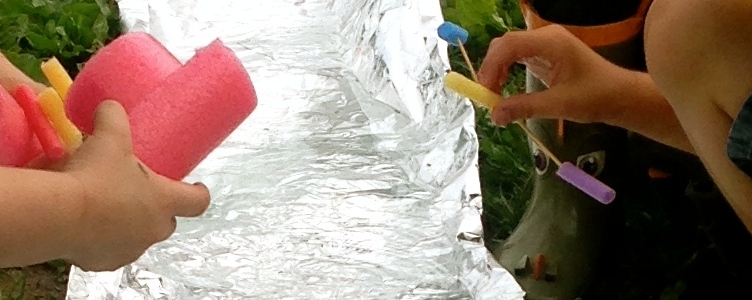
One of my very talented teacher candidates was working on a provocation for the children in math. We were deep into our learning about and working with 3D shapes. The children were loving building 3D shapes with a variety of different materials. So, my teacher candidate asked me if we could cut up the pool… Read MorePool Noodle Boats and Tinfoil Rivers (STEM)
Water Wall with Recycled Materials
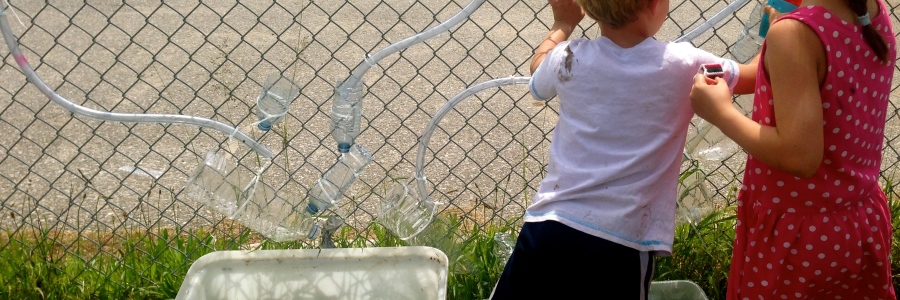
Do you have bottles that get recycled weekly? I know we sure do. Instead of heading to the dollar store like I do far too often (just like most early years educators), we headed to our recycling box. We took the lids off the tops and cut the bottoms off the water bottles and had instant FUNNELS.… Read MoreWater Wall with Recycled Materials
Pumpkin Inquiry
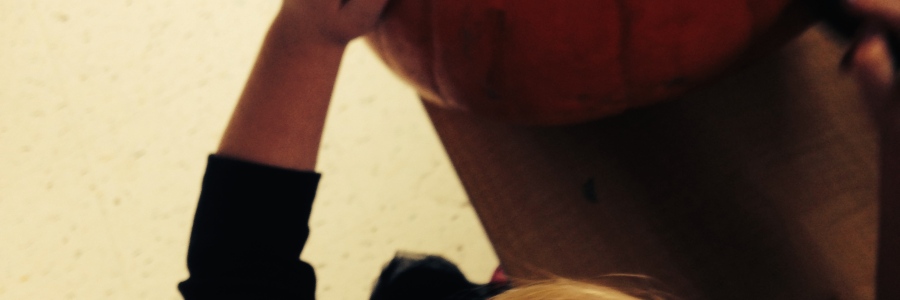
We were excited to bring home our own pumpkins from our field trip last week to Morrison Meadows Farm in Bracebridge, ON. On our bus ride home we started our wondering about pumpkins. How do they grow? Do they grow in a field of grass? Our research began by cutting apart our pumpkins and making… Read MorePumpkin Inquiry
Thanksgiving Art Fest with Learning Buddies
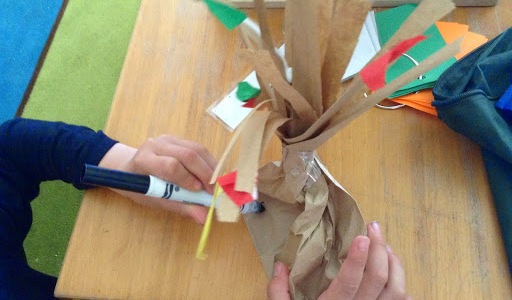
Last year we held the Turkey Olympics outside with our Learning Buddies. Unfortunately, the weather was too wet for all of those activities this year. Thanks to Pinterest for helping us easily plan a wide variety of Thanksgiving activities that assist in child development in fun and exciting ways! You can follow Mrs. Max on… Read MoreThanksgiving Art Fest with Learning Buddies
Authentic Learning at Farm Grows Inquiry
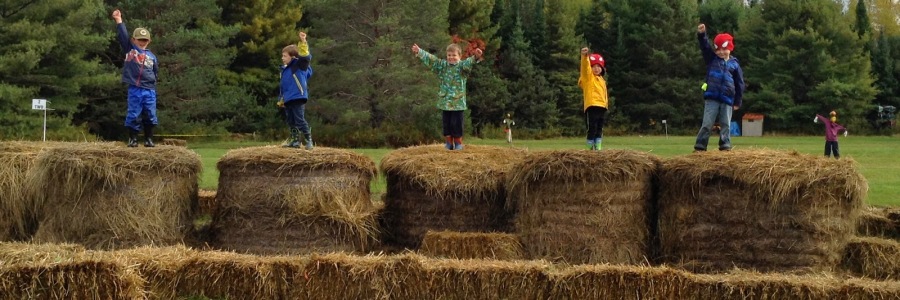
This week both JK/SK classes from Pine Glen P.S. went to a wonderful farm run by Community Living called Morrison Meadows in Bracebridge, ON. They have lots of exciting fall outdoor activities for children to engage in. The rain held off and we had a great day together outdoors. We had 8 parent volunteers from… Read MoreAuthentic Learning at Farm Grows Inquiry
Fun Friday: "Leaf Festival" with Learning Buddies
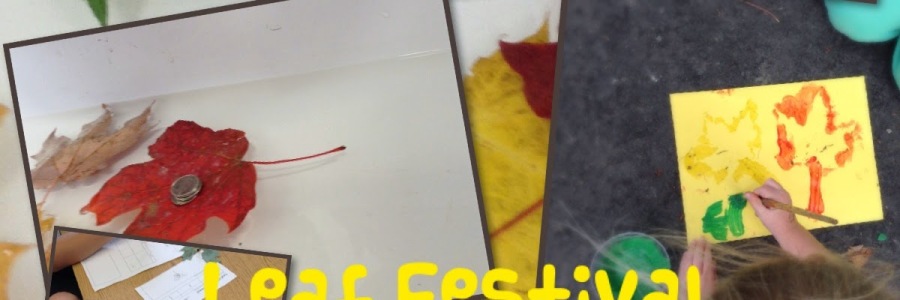
Welcome to the Leaf Festival where our kinders led exploration about leaves facilitated by their Learning Buddies. We had a fantastic afternoon filled with fun, adventure and learning. We rotated through several stations about leaves that focused on art, reading, writing, physical activity, and inquiry. This kinder’s Learning Buddy… Read MoreFun Friday: "Leaf Festival" with Learning Buddies
Fall Colours Art Provocations

Our kinders have been creating and exploring the relationship between art and nature. Our colour palette is inspired by the fall season, but not restricted in any way. Kinders have used techniques taught and then given freedom to explore techniques and colour by their own choosing. This first collection is used by… Read MoreFall Colours Art Provocations
Fun Friday – Apple Day
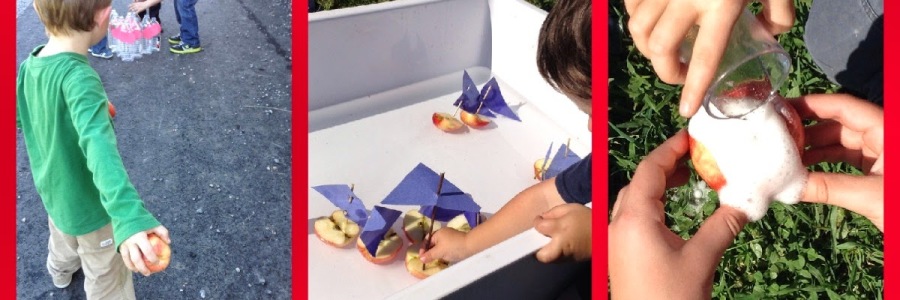
Fun Friday – Apple Day with G6/7 Learning Buddies This past week we have been using apples as a learning tool. Our poem of the week was “I’m a Little Apple”. We made patterns and prints with apples. One of our curious kinders brought in a crab apple that they found near their Judo… Read More
This is a frequently asked question?
This is a FAQ description. Add more detail about this service, such as benefits, appearance, components and value
This is a frequently asked question?
This is a FAQ description. Add more detail about this service, such as benefits, appearance, components and value
